Establishments, Employments, and Earnings by Industry in Williamson County
article posted by Headlight on March 13, 2025 (edited March 13, 2025)
Unlock data-driven insights to empower your decisions!
Welcome to the Workforce Solutions Rural Capital Area monthly newsletter.
This resource empowers leaders with the tools and data they need to make informed decisions. By analyzing workforce trends, identifying skills gaps, and understanding industry needs, leaders can effectively allocate resources, attract businesses, support workforce development, and advocate for policies that create a thriving local economy. This resource provides access to critical data sources and insights to help you navigate the complexities of the local economy and achieve your economic development goals.
This month, we delve into the latest workforce trends in Williamson County. We want this tool to be a valuable resource for you. Share your suggestions by reaching out to communications@ruralcapital.net.
This article is part of an ongoing, county-by-county, industry overview of the Rural Capital Area. This article covers establishments, employment, and earnings in Williamson County.
Establishments
As of 2023, Williamson County has an estimated population of 697,191. The County seat is Georgetown and was founded in 1848. The largest industry in Williamson County by number of establishments is Computer Systems Design and Related Services (1120 establishments) followed by Restaurants and other Eating Places (947 establishments).
Figure 1: Number of Establishments in Williamson County, 2021 to 2023

Source: Data Tactical Group, DTG 2024.Q2
To be one of the industries with the most establishments in Williamson County, it must have at least 305 establishments. Of the industries in that group, Computer Systems Design and Related Services saw the most growth in Williamson County, increasing 25% from 2021 to 2023. Offices of Other Health Practitioners also saw significant growth in the same period, increasing 13%. However, Agencies, Brokerages, and Other Insurance Related Activities experienced a decline between 2021 and 2023.
Figure 2: Percent Change in Top Establishments, Williamson County (By Number of Establishments), 2021 to 2023

Source: Data Tactical Group, DTG 2024.Q2
Employment
Restaurants and Other Eating Places are the largest industry group by number of employees in Williamson County. Professional and Commercial Equipment, and Supplies Merchant Wholesalers are the second-largest industry in Williamson County. Two of the top three industries by employment in Williamson County have seen increases in employment since 2021.
Figure 3: Number of Employees by Industry, Williamson County, 2021 to 2023

Source: Data Tactical Group, DTG 2024.Q2
By growth in employment, Computer Systems Design and Related Services saw the greatest changes from 2021 to 2023. Grocery and Convenience Retailers also saw substantial growth in employment from 2021 to 2023 while Warehouse Clubs, Supercenters, and Other General Merchandise Retailers had a major decline in employment.
Figure 4: Growth in Employment, Williamson County, 2021 to 2023

Source: Data Tactical Group, DTG 2024.Q2
Employment in Computer Systems Design and Related Services saw significant growth in Williamson County. This aligns with trends in these same industries at the state and national levels. Employment in Computer Systems Design and Related Services is a broad classification that includes businesses primarily engaged in designing and implementing computer systems and related services. Some jobs that fall under this include software development, cybersecurity solutions, cloud computing services, and IT support and maintenance.
Professional and Commercial Equipment and Supplies Merchant Wholesalers saw a small decline in Williamson County, in stark contrast to the state and national levels. Special Food Services includes businesses primarily engaged in wholesaling professional and commercial equipment and supplies. Some jobs that fall under this category include Sales Representatives, Procurement Specialists, Equipment Technicians.
General and Medical Surgical Hospitals saw a 13% growth in employment in Williamson County. This also aligns with trends in these same industries at the state and national levels. This category contains businesses primarily engaged in installing or servicing equipment that is part of a building’s essential systems. These systems include electrical, plumbing, HVAC, and other mechanical systems.
Figure 5: Decline in Employment, Williamson County, 2021 to 2023

Source: Data Tactical Group, DTG 2024.Q2
Earnings
Computer and Peripheral Equipment Manufacturing tops the list in Williamson County as the industry with the most earnings ($424 million). Professional and Commercial Equipment and Supplies Merchant Wholesalers occupies second position ($398 million).
Figure 6: Earnings, Williamson County, 2021 to 2023

Source: Data Tactical Group, DTG 2024.Q2
One way to visualize industry earnings in Williamson County is imagining all earnings from all industries as a hundred dollars. Of that hundred dollars, three of the seven industries listed comprise $30. Those seven industries produce about $40 altogether. The remaining $60 is produced by all other industries, meaning that earnings in Williamson County are spread across a wide range of other sectors.
Figure 7: Earnings Visualized, Williamson County, 2023

Source: Data Tactical Group, DTG 2024.Q2
Williamson County, Texas, is experiencing rapid economic growth, fueled by a 22.9% population surge since 2018 and the creation of over 55,000 new jobs. This growth is supported by a highly skilled workforce, evidenced by a low unemployment rate of 3.6%, a high median household income, and significant educational attainment. Major employers across technology, healthcare, and logistics, coupled with a vibrant entrepreneurial ecosystem, contribute to the county’s dynamic economy.
The county’s appeal is further enhanced by a strong quality of life, including low crime rates and a diverse community. Continued investment in workforce development, infrastructure, and public safety, alongside strategic partnerships, will be critical for sustaining this growth. With a proactive educational pipeline and ongoing migration from major metro areas, Williamson County is poised to remain a leading economic hub in Texas.
Visit Us Today!
We invite you to visit one of our Williamson County offices and discover how Workforce Solutions Rural Capital Area can help you achieve your career and business goals.
Let’s Build a Stronger Williamson County Together,
Paul Fletcher CEO Workforce Solutions Rural Capital Area
Establishments, Employments, and Earnings by Industry in Llano County
article posted by Headlight on February 28, 2025 (edited March 13, 2025)
Unlock data-driven insights to empower your decisions!
Welcome to the Workforce Solutions Rural Capital Area monthly newsletter.
This resource empowers leaders with the tools and data they need to make informed decisions. By analyzing workforce trends, identifying skills gaps, and understanding industry needs, leaders can effectively allocate resources, attract businesses, support workforce development, and advocate for policies that create a thriving local economy. This resource provides access to critical data sources and insights to help you navigate the complexities of the local economy and achieve your economic development goals.
This month, we delve into the latest workforce trends in Llano County. We want this tool to be a valuable resource for you. Share your suggestions by reaching out to communications@ruralcapital.net
Workforce Solutions Rural Capital Area Secures Grants to Bolster Growth in 9-County Region.
Great news for the 9-county region! Workforce Solutions Rural Capital Area (WSRCA) has secured two new grants from the Texas Workforce Commission (TWC) to support workforce development and training initiatives.
- Innovation Fund Grant: This $240,140 grant will fund the creation of a virtual Career Exploration and Resource Connection (CORE) Hub. The CORE Hub will provide residents across the region with easy access to career exploration tools, training resources, and job search assistance.
- Healthcare Rural Training Labs Grant: This $250,000 grant will train 100 individuals in critical healthcare fields. This investment will help address the growing demand for skilled healthcare workers in our communities and ensure residents have access to quality care.
These grants will play a vital role in WRCA's mission to equip residents with the skills and training they need to secure good-paying jobs and fuel economic growth throughout the region.
This article is part of an ongoing, county-by-county, industry overview of the Rural Capital Area. This article covers establishments, employment, and earnings in Llano County.
Establishments
As of 2023, Llano County has an estimated population of 22,011. The County seat is Llano and was founded in 1856. The largest industry in Llano County by number of establishments is Restaurants and Other Eating Places (34 establishments) followed by Residential Building Construction (26 establishments).
Figure 1: Number of Establishments in Llano County, 2021 to 2023

Source: Data Tactical Group, DTG 2024.Q2
To be one of the industries with the most establishments in Llano County, it must have at least 16 establishments. Of the industries in that group, Other Specialty Trade Contractors saw the most growth in Llano County, increasing 14% from 2021 to 2023. Building Equipment Contractors also saw significant growth in the same period, increasing 11%. However, the other industries with the most establishments experienced a decline between 2021 and 2023.
Figure 2: Percent Change in Top Establishments, Llano County (By Number of Establishments), 2021 to 2023

Source: Data Tactical Group, DTG 2024.Q2
Employment
Traveler Accommodation is the largest industry group by number of employees in Llano County. Restaurants and Other Eating Places are the second-largest industry in Llano County. Two of the top three industries by employment in Llano County have seen increases in employment since 2021.
Figure 3: Number of Employees by Industry, Llano County, 2021 to 2023

Source: Data Tactical Group, DTG 2024.Q2
By growth in employment, Other Specialty Trade Contractors saw the greatest changes from 2021 to 2023. Traveler Accommodation also saw substantial growth in employment from 2021 to 2023 while Gas Stations had a major decline in employment.
Figure 4: Growth in Employment, Llano County, 2021 to 2023

Source: Data Tactical Group, DTG 2024.Q2
Employment in Other Specialty Trade Contractors saw significant growth in Llano County. This aligns with trends in these same industries at the state and national levels. Other Specialty Trade Contractors is a broad classification that includes establishments focused on construction activities that are not classified elsewhere under specialty trade categories. Some jobs that fall under this include playground equipment installation and erecting billboards and other signs.
Special Food services saw a small decline in Llano County, in stark contrast to the state and national levels. Special Food Services includes businesses primarily engaged in providing food services at the customer’s location or at a facility such as industrial plants, business cafeterias, or mobile food services such as food trucks.
Building Equipment Contractors saw a 13% growth in employment in Llano County. This also aligns with trends in these same industries at the state and national levels. This category contains businesses primarily engaged in installing or servicing equipment that is part of a building’s essential systems. These systems include electrical, plumbing, HVAC, and other mechanical systems.
Figure 5: Decline in Employment, Llano County, 2021 to 2023

Source: Data Tactical Group, DTG 2024.Q2
Earnings
Traveler Accommodation tops the list in Llano County as the industry with the most earnings ($6.8 million). Restaurants and Other Eating Places occupies second position ($2.7 million).
Figure 6: Earnings, Llano County, 2021 to 2023

Source: Data Tactical Group, DTG 2024.Q2
One way to visualize industry earnings in Llano County is imagining all earnings from all industries as a hundred dollars. Of that hundred dollars, three of the seven industries listed comprise $24. Those seven industries produce about $35 altogether. The remaining $65 is produced by all other industries, meaning that earnings in Llano County are spread across a wide range of other sectors.
Figure 7: Earnings Visualized, Llano County, 2023

Source: Data Tactical Group, DTG 2024.Q2
WRCA Bridges the Gap Between Education and Industry
In addition to securing grant funding, WRCA is also committed to building bridges between education and industry. Through the Bridging the Gap Toolbox, WRCA equips educators and industry leaders with the tools they need to prepare students for successful careers. The toolbox includes resources on curriculum development, internship opportunities, and industry-specific skills training.
Learn More
To learn more about the Bridging the Gap Toolbox and WRCA's other workforce development initiatives, please visit the website:
https://workforcesolutionsrca.com/board/bridging-the-gap
Workforce Solutions Rural Capital Area Opens New Llano Office!
WSRCA is excited to announce the opening of our new Llano office, conveniently located at 102 W. Dallas St., Suite F.
This office serves as your one-stop shop for all your workforce needs. Whether you’re looking for employees, seeking employment, looking to advance your career, or exploring training opportunities, our team is here to assist you.
Partnering for Success:
We are proud to partner with Workforce Network Inc. to deliver high-quality training programs in high-growth fields such as Finance, IT, Skilled Trades, and Healthcare. These programs are made possible through the Good Jobs Challenge grant and are designed to equip individuals with the skills and knowledge they need to succeed in today's competitive job market.
Visit Us Today!
We invite you to visit our new Llano office and discover how Workforce Solutions Rural Capital Area can help you achieve your career and business goals.
Let's Build a Stronger Llano Together,
Paul Fletcher CEO Workforce Solutions Rural Capital Area
Establishments, Employments, and Earnings by Industry in Lee County
article posted by Headlight on December 18, 2024 (edited December 18, 2024)
This article is part of an ongoing, county-by-county, industry overview of the Rural Capital Area. This article covers establishments, employment, and earnings in Lee County.
Establishments
As of 2022, Lee County has an estimated population of 17,543. The County seat is Giddings and is named after General Robert E. Lee. The largest industry in Lee County by number of establishments is Building Equipment Contractors (27 establishments) followed by Restaurants and Other Eating Places (25 establishments).
Figure 1: Number of Establishments in Lee County, 2021 to 2023

Source: Data Tactical Group, DTG 2024.Q2
To be one of the industries with the most establishments in the area, an industry must have at least 9 establishments in Lee County. Of the industries in that group, Cattle Ranching and Farming saw the most growth in Lee County, growing 23% from 2021 to 2023. Agencies, Brokerages, and Other Insurance Related Activities also saw significant growth in the same period, increasing 21%. The industries with the most establishments all grew between 2021 and 2023.
Figure 2: Percent Change in Top Establishments, Lee County (By Number of Establishments ), 2021 to 2023

Source: Data Tactical Group, DTG 2024.Q2
Employment
Utility System Construction is the largest industry group by number of employees in Lee County. Greenhouse, Nursery, and Floriculture Production is the second-largest industry by number of employees. Two of the top three industries by employment in Lee County have seen increases in employment since 2021.
Figure 3: Number of Employees by Industry, Lee County, 2021 to 2023

Source: Data Tactical Group, DTG 2024.Q2
By growth in employment, Oil and Gas Extraction saw some of the greatest changes from 2021 to 2023. Greenhouse, Nursery, and Floriculture Production also saw substantial growth in employment from 2021 to 2023 while Highway, Street, and Bridge Construction had a major decline in employment.
Figure 4: Growth in Employment, Lee County, 2021 to 2023

Source: Data Tactical Group, DTG 2024.Q2
Employment in Skilled Nursing Care Facilities saw significant growth in Lee County. This aligns with trends in those industries seen in the state and nation. Support Activities for Mining have seen a significant increase in employment, overall. However, its growth rate is substantially greater in the state and nation than in Lee County.
Figure 5: Decline in Employment, Lee County, 2021 to 2023

Source: Data Tactical Group, DTG 2024.Q2
Earnings
Utility System Construction tops the list in Lee County as the industry with the most earnings ($23.7 million). Oil and Gas Construction appear in the second position ($4.5 million).
Figure 6: Earnings, Lee County, 2021 to 2023

Source: Data Tactical Group, DTG 2024.Q2
One way to visualize industry earnings in Lee County is imagining all earnings from all industries as a hundred dollars. Of that hundred dollars, three of the seven industries listed comprise $40. Those seven industries produce about $52 altogether. The remaining $48 is produced by all other industries, meaning that earnings in Lee County are spread across a wide range of other sectors.
Figure 7: Earnings Visualized, Lee County, 2023

Source: Data Tactical Group, DTG 2024.Q2
Establishments, Employments, and Earnings by Industry in Hays County
article posted by Headlight on November 13, 2024 (edited November 13, 2024)
This article is part of an ongoing, county-by-county, industry overview of the Rural Capital Area. This article covers establishments, employment, and earnings in Hays County.
Establishments
As of 2023, Hays County has an estimated population of 269,000. The County seat is San Marcos and in 2017, it was listed as one of the fastest growing counties nationwide with a population of at least 10,000 people. Like many areas, the largest industry in Hays County by number of establishments is Restaurants and Other Eating Places (369 establishments) followed by Management, Scientific, and Technical Consulting Services (31 establishments).
Figure 1: Number of Establishments in Hays County, 2021 to 2023

Source: Data Tactical Group, DTG 2024.Q2
Of the industries with the most establishments, Offices of Real Estate Agents and Brokers saw the most growth in Hays County, growing 32% from 2021 to 2023. Management, Scientific, and Technical Consulting Services also saw significant growth in the same period, increasing 20.5%. The industries with the most establishments all grew between 2021 and 2023.
Figure 2: Percent Change in Top Establishments, Hay County (Random Order), 2021 to 2023

Source: Data Tactical Group, DTG 2024.Q2
Employment
Restaurants and Other Eating Places are also the largest industry group by number of employees in Hays County. Warehouse and Storage are the second-largest industry by number of employees. All of the top three industries by employment in Hays have seen increases in employment since 2021.
Figure 3: Number of Employees by Industry, Hays County, 2021 to 2023

Source: Data Tactical Group, DTG 2024.Q2
By growth in employment, Building Foundation and Exterior Contractors saw some of the greatest changes from 2021 to 2023. Warehousing and Storage also saw substantial growth in employment from 2021 to 2023 while Highway, Street, and Bridge Construction have had a major decline in employment.
Figure 4: Growth in Employment, Hays County, 2021 to 2023

Source: Data Tactical Group, DTG 2024.Q2
Employment in Building Foundation and Exterior Contractors and Warehousing and Storage saw significant growth in Hays County. This is aligns with trends in those industries seen in the state and nation as a whole. Grocery and Convenience Retailers has seen a significant increase in employment overall. However, its employment increase is substantially greater in Hays County than its growth in the state and nation.
Figure 5: Decline in Employment, Hays County, 2021 to 2023

Source: Data Tactical Group, DTG 2024.Q2
Earnings
Warehousing and Storage tops the list in Hays County as the industry with the most earnings ($60.8 million). Restaurants and Other Eating Places appear in the second position ($54.4 million).
Figure 6: Earnings, Hays County, 2021 to 2023

Source: Data Tactical Group, DTG 2024.Q2
One way to visualize industry earnings in Hays County is imagining all earnings from all industries as a hundred dollars. Of that hundred dollars, the top three industries comprise $36. The top eight industries produce about $76 altogether. The remaining $24 is produced by all other industries, meaning that earnings in Hays County are spread across a wide range of industries.
Figure 7: Earnings Visualized, Hays County, 2023

Source: Data Tactical Group, DTG 2024.Q2
Establishments, Employments, and Earnings by Industry in Fayette County
article posted by Headlight on October 30, 2024 (edited October 30, 2024)
This article is part of an ongoing, county-by-county, industry overview of the Rural Capital Area. This article covers establishments, employment, and earnings in Fayette County.
Establishments
Like many areas, the largest industry in Fayette County by number of establishments is Restaurants and Other Eating Places (63 establishments) followed by Cattle Ranching and Farming (31 establishments).
Figure 1: Number of Establishments in Fayette County, 2021 to 2023

Source: Data Tactical Group, DTG 2024.Q2
Of the industries with the most establishments, Offices of Real Estate Agents and Brokers saw the most growth in Fayette County, growing 22% from 2021 to 2023. Accounting, Tax Preparation, Bookkeeping, and Payroll Services also saw significant growth in the same period, increasing 15.9%. On the other hand, Building Equipment Contractors decreased in establishments from 2021 to 2023.
Figure 2: Percent Change in Top Establishments, Fayette County, 2021 to 2023

Source: Data Tactical Group, DTG 2024.Q2
Employment
Restaurants and Other Eating Places are also the largest industry group by number of employees in Fayette County. Nursing Care Facilities (Skilled Nursing Facilities) are the second-largest industry by number of employees. All of the top three industries by employment in Fayette have seen increases in employment since 2021.
Figure 3: Number of Employees by Industry, Fayette County, 2021 to 2023

Source: Data Tactical Group, DTG 2024.Q2
By growth in employment, Machinery, Equipment, and Supplies Merchant Wholesalers saw some of the greatest changes from 2021 to 2023. Grocery and Convenience Retailers also saw substantial growth in employment from 2021 to 2023 while Department Stores have had a major decline in employment.
Figure 4: Growth in Employment, Fayette County, 2021 to 2023

Source: Data Tactical Group, DTG 2024.Q2
However, employment in Nondepository Credit Intermediation and Business Support Services saw significant growth in Fayette County. This is contrary to the contraction trends in those industries seen in the state and nation as a whole. General Freight Trucking has seen a significant increase in employment overall. However, its employment increase is substantially greater in Fayette County than its growth in the state and nation.
Figure 5: Decline in Employment, Fayette County, 2021 to 2023

Source: Data Tactical Group, DTG 2024.Q2
Earnings
Machinery, Equipment, and Supplies Merchant Wholesalers tops the list in Fayette County as the industry with the most earnings ($6.2 million). Restaurants and Other Eating Places appear in the second position ($4.8 million).
Figure 6: Earnings, Fayette County, 2021 to 2023

Source: Data Tactical Group, DTG 2024.Q2
One way to visualize industry earnings in Fayette County is imagining all earnings from all industries as a hundred dollars. Of that hundred dollars, the top three industries comprise $17. The top eight industries produce about $31 altogether. The remaining $69 is produced by all other industries, meaning that earnings in Fayette County are spread across a wide range of industries.
Figure 7: Earnings Visualized, Fayette County, 2023

Source: Data Tactical Group, DTG 2024.Q2
Establishments, Employments, and Earnings by Industry in Caldwell County
article posted by Headlight on October 17, 2024 (edited October 17, 2024)
This article is part of an ongoing, county-by-county, industry overview of the Rural Capital Area. This article covers establishments, employment, and earnings in Caldwell County.
Establishments
Like many areas, the largest industry in Caldwell County by number of establishments is Restaurants and Other Eating Places (65 establishments) followed by Individual and Family Services (29 establishments).
Figure 1: Number of Establishments in Caldwell County, 2021 to 2023

Source: Data Tactical Group, DTG 2024.Q2
Of the industries with the most establishments, Individual and Family Services saw the most growth in Caldwell County, growing 19% from 2021 to 2023. Building Equipment Contractors also saw significant growth in the same period, increasing 13%. On the other hand, Accounting, Tax Preparation, Bookkeeping, and Payroll Services decreased in establishments from 2021 to 2023.
Figure 2: Percent Change in Top Establishments, Caldwell County, 2021 to 2023

Source: Data Tactical Group, DTG 2024.Q2
Employment
Restaurants and Other Eating Places is also the largest industry group by number of employees in Caldwell County. Gas Stations are the second-largest industry by number of employees. All of the top three industries by employment in Caldwell have seen increases in employment since 2021.
Figure 3: Number of Employees by Industry, Caldwell County, 2021 to 2023

Source: Data Tactical Group, DTG 2024.Q2
By growth in employment, Other Specialty Trade Contractors saw some of the greatest changes from 2021 to 2023. Support Activities for Mining also saw substantial growth in employment from 2021 to 2023 while Residential Intellectual and Developmental Disability, Mental Health, and Substance Abuse Facilities has had a major decline in employment.
Figure 4: Growth in Employment, Caldwell County, 2021 to 2023

Source: Data Tactical Group, DTG 2024.Q2
However, Child Care Services, Beverage Manufacturing, and Automotive Repair and Maintenance all declined in employment, contrary to the growth trends in those industries seen in the state and nation as a whole.
Figure 5: Decline in Employment, Caldwell County, 2021 to 2023

Source: Data Tactical Group, DTG 2024.Q2
Earnings
Restaurants and Other Eating Places tops the list in Caldwell County as the industry with the most earnings ($7.4 million). General Medical and Surgical Hospitals appear in the second position ($6 million).
Figure 6: Earnings, Caldwell County, 2021 to 2023

Source: Data Tactical Group, DTG 2024.Q2
One way to visualize industry earnings in Caldwell County is imagining all earnings from all industries as a hundred dollars. Of that hundred dollars, the top three industries comprise $14. The top seven industries produce about $30 altogether. The remaining $70 is produced by all other industries, meaning that earnings in Caldwell County are spread across a wide range of industries.
Figure 7: Earnings Visualized, Caldwell County, 2023

Source: Data Tactical Group, DTG 2024.Q2
Establishments, Employments, and Earnings by Industry in Burnet County
article posted by Headlight on September 18, 2024 (edited September 18, 2024)
Establishments, Employments, and Earnings by Industry in Burnet County
This article is part of an ongoing, county-by-county, industry overview of the Rural Capital Area. This article covers establishments, employment, and earnings in Burnet County.
Establishments
Like many areas, the largest industry in Burnet County by number of establishments is Restaurants and Other Eating Places (98 establishments) followed by Building Equipment Contractors (85 establishments).
Figure 1: Number of Establishments in Burnet County, 2021 to 2023

Source: Data Tactical Group, DTG 2024.Q2
Of the industries with the most establishments, Residential Building Construction saw the most growth in Burnet County, growing 30% from 2021 to 2023. Other Specialty Trade Contractors also saw significant growth in the same period, increasing 30%. Excluding, Restaurants and Other Eating Places, every other industry grew at a faster rate in Burnet County than Texas and the U.S.
Figure 2: Percent Change in Top Establishments, Burnet County, 2021 to 2023

Source: Data Tactical Group, DTG 2024.Q2
Employment
Restaurants and Other Eating Places is also the largest industry group by number of employees in Burnet County. Building Equipment Contractors is the second-largest industry by number of employees. All of the top industries by employment in Burnet County have seen increases in employment since 2021 except General Merchandise Stores.
Figure 3: Number of Employees by Industry, Burnet County, 2021 to 2023

Source: Data Tactical Group, DTG 2024.Q2
By growth in employment, Building Equipment Contractors saw some of the greatest changes from 2021 to 2023. The Utility System Construction and Grocery/Convenience stores also saw substantial growth in employment from 2021 to 2023.
Figure 4: Growth in Employment, Burnet County, 2021 to 2023

Source: Data Tactical Group, DTG 2024.Q2
However, Big Box Stores/General Stores and Home Health Care Services both declined in employment. This is interesting because for the state of Texas and U.S as a whole, employment in Home Health Care Services have increased between 2021 and 2023, but employment in Big Box Stores / General Stores have decreased like in Burnett County.
Figure 5: Decline in Employment, Burnet County, 2021 to 2023

Source: Data Tactical Group, DTG 2024.Q2
Earnings
General Medical and Surgical Hospitals top the list in Burnet County as the industry with the most earnings ($17.1 million). Restaurants and Other Eating Places appear in the second position ($8.6 million).
Figure 6: Earnings, Burnet County, 2021 to 2023

Source: Data Tactical Group, DTG 2024.Q2
One way to visualize industry earnings in Burnet County is imagining all earnings from all industries as a hundred dollars. Of that hundred dollars, the top two industries comprise $13. The top ten industries produce about $33 altogether. The remaining $64 is produced by all other industries, meaning that earnings in Burnet County are diversified, spread across a wide range of industries.
Figure 7: Earnings Visualized, Burnet County, 2023

Source: Data Tactical Group, DTG 2024.Q2
Establishments, Employments, and Earnings by Industry in Blanco County
article posted by Headlight on July 24, 2024 (edited July 24, 2024)
This article is part of an ongoing, county-by-county, industry overview of the Rural Capital Area. This article covers establishments, employment, and earnings in Blanco County.
Establishments
Like many areas, the largest industry in Blanco County by number of establishments is Restaurants and Other Eating Places (28 establishments) followed by Beverage Manufacturing (21 establishments).
Figure 1: Number of Establishments in Blanco County, 2021 to 2023

Source: Data Tactical Group, DTG 2024.Q2
Of the industries with the most establishments, Agencies, Brokerages, and Other Insurance Related Activities saw the most growth in Blanco County, growing 115% from 2021 to 2023. Computer Systems Design and Related Services also saw significant growth in the same period, increasing 71%. On the other hand, Individual and Family Services, and Cattle Ranching both saw decreases in establishments from 2021 to 2023.
Figure 2: Percent Change in Top Establishments, Blanco County, 2021 to 2023

Source: Data Tactical Group, DTG 2024.Q2
Employment
Restaurants and Other Eating Places is also the largest industry group by number of employees in Blanco County. Once again, Beverage Manufacturing is the second-largest industry by number of employees. All of the top three industries by employment in Blanco County have seen increases in employment since 2021.
Figure 3: Number of Employees by Industry, Blanco County, 2021 to 2023

Source: Data Tactical Group, DTG 2024.Q2
By growth in employment, Offices of Dentists saw some of the greatest changes from 2021 to 2023. The Services to Buildings and Dwellings and Home Health Care Services industries also saw substantial growth in employment from 2021 to 2023.
Figure 4: Growth in Employment, Blanco County, 2021 to 2023

Source: Data Tactical Group, DTG 2024.Q2
However, Utility System Construction, Highway, Street and Bridge Construction, and Health and Personal Care Workers industries all declined in employment, contrary to the growth trends in those industries seen in the state and nation as a whole.
Figure 5: Decline in Employment, Blanco County, 2021 to 2023

Source: Data Tactical Group, DTG 2024.Q2
Earnings
Diverting from the pattern, Building Equipment Contractors tops the list in Blanco County as the industry with the most earnings ($7.5 million). Management of Companies and Enterprises appears in the second position ($5.3 million).
Figure 6: Earnings, Blanco County, 2021 to 2023

One way to visualize industry earnings in Blanco County is imagining all earnings from all industries as a hundred dollars. Of that hundred dollars, the top two industries comprise $23. The top ten industries produce about $54 altogether. The remaining $46 is produced by all other industries, meaning that earnings in Blanco County are diversified, spread across a wide range of industries.
Figure 7: Earnings Visualized, Blanco County, 2023

Source: Data Tactical Group, DTG 2024.Q2
Earnings by Industry in Bastrop County
article posted by Headlight on June 25, 2024 (edited June 25, 2024)
This article is part two of an industry overview of Bastrop County, covering industry earnings.
Earnings
Once again, Restaurants and Other Eating Places tops the list in Bastrop County as the industry with the most earnings ($14.5 million). Building and Equipment Contractors also appears again in the second position ($10.5 million).
Figure 6: Earnings, Bastrop County, 2021 to 2023

Source: Data Tactical Group, DTG 2024.Q2
One way to visualize industry earnings in Bastrop County is imagining all earnings from all industries as a hundred dollars. Of that hundred dollars, the top two industries only comprise $12.50. In fact, that top ten industries only produce about $40 altogether. The remaining $60 is produced by all other industries, meaning that earnings in Bastrop County are diversified, spread across a wide range of industries.
Figure 7: Earnings Visualized, Bastrop County, 2023

Source: Data Tactical Group, DTG 2024.Q2
Establishments and Employment by Industry in Bastrop County
article posted by Headlight on May 13, 2024 (edited May 14, 2024)
The North American Industry Classification System (NAICS) is a system used by United States government agencies to collect and display business economy data. Each business establishment is classified by NAICS code. There are five levels of NAICS codes, with 2-6 digits, that increase in specificity as the codes get longer (as shown below).
- Sector: 2-digit code
- Subsector: 3-digit code
- Industry Group: 4-digit code
- NAICS Industry: 5-digit code
- National Industry: 6-digit code
For example, an establishment that sells boats has NAICS codes in each of the five levels. Most generally, it is classified under retail trade, and most specifically, as a boat dealer. NAICS codes are a useful tool for analysts to examine economic trends for business in specific areas.
Table 1: NAICS Levels for Boat Dealers
|
Level
|
NAICS Code
|
Title
|
|
Sector
|
44-45
|
Retail Trade
|
|
Subsector
|
441
|
Motor Vehicle and Parts Dealer
|
|
Industry Group
|
4412
|
Other Motor Vehicle Dealers
|
|
NAICS Industry
|
44122
|
Motorcycle, Boat, and Other Motor Vehicle Dealers
|
|
National Industry
|
441222
|
Boat Dealers
|
Source: “Economic Census: NAICS Codes & Understanding Industry Classification Systems”, US Census, https://www.census.gov/programs-surveys/economic-census/year/2022/guidance/understanding-naics.html
The next series of articles will focus on the Industry Group level (4-digit) NAICS codes for each county in the Rural Capital Area, and examine three areas at the industry level, establishments, employment, and earnings.
Establishments
Like many areas, the largest industry in Bastrop County by number of establishments is Restaurants and Other Eating Places, with 119 establishments as of 2023. The restaurant industry in Bastrop County hasn’t added many establishments since 2021, however, it still far exceeds other industries in terms of sheer numbers. Most of the top ten industries, in terms of establishments, in Bastrop County are service-providing industries, with two exceptions, namely, Building Equipment Contractors, and Residential Building Construction, which are goods-producing industries.
Figure 1: Number of Establishments in Bastrop County, 2021 to 2023

Source: Data Tactical Group, DTG 2024.Q2
The industry with the highest growth in establishments from 2021 to 2023 is Other Miscellaneous Retailers, which includes establishments “primarily engaged in retailing specialized lines of merchandise.” (US Census) Though seemingly an obscure industry title, this group encompasses the type of boutique shops that often line Main Streets across the Country, as well as other specialized retailers (e.g.: collector’s items, homebrew supplies, swimming/hot tub stores, etc). Office Administrative Services and Other Amusement and Recreation Industries also saw a large growth in establishments, outpacing Texas and national trends.
However, some industries in Bastrop County saw significant declines in establishments. Particularly, Agencies, Brokerages, and Other Insurance Related Activities, Grocery and Convenience Retailers, and Cattle Ranching and Farming.
Figure 2: Percent Change in Establishments by Select Industry, Bastrop County, 2021 to 2023

Source: Data Tactical Group, DTG 2024.Q2
Employment
Restaurants and Other Eating Places is also the largest industry group by number of employees in Bastrop County. Other service-providing industries also rank highly, including Grocery and Convenience Retailers, and Traveler Accommodation. Building and Equipment Contractors ranks 4th in employment and is the only goods-producing industry in the top ten employers.
Figure 3: Number of Employees by Industry, Bastrop County, 2021 to 2023

Source: Data Tactical Group, DTG 2024.Q2
By growth in employment, Household and Institutional Furniture and Kitchen Cabinet Manufacturing saw some of the biggest change from 2021 to 2023. The industry grew from around sixteen employees in 2021, to just over 100 employees in 2023. The Medical and Diagnostic Laboratories and Investigation and Security Services industries also saw substantial growth in employment from 2021 to 2023.
Figure 4: Growth in Employment, Bastrop County, 2021 to 2023

Source: Data Tactical Group, DTG 2024.Q2
However, the Motion Picture and Video Industries, Home Health Care Services, and Building Finishing Contractors industries all lost between 50-100 employees each, contrary to the growth trends in those industries seen in the state and nation as a whole.
Figure 5: Decline in Employment, Bastrop County, 2021 to 2023

Source: Data Tactical Group, DTG 2024.Q2
Williamson County Economic Profile
article posted by Headlight on April 16, 2024 (edited April 16, 2024)
Introduction
Williamson County is situated to the north of Austin. The county seat is Georgetown. In 2022, the population of Williamson County was 672,273.
Demographic Profile
The population of Williamson County has increased by around 216,000 in the past ten years, nearly doubling over the decade. Every year in the past ten has seen population growth well above the national average. In 2021, the county experienced the greatest growth year of the decade (4.7%). Not only does Williamson County have positive natural growth (more births than deaths), but it has also seen high levels of domestic migration, which has driven most of the growth of the past decade.
Figure 1: Population Growth, 2012-2022, Williamson County

Source: American Community Survey, 2022, 5-Year Estimate Williamson County
Figure 2: Population Change Components, 2012-2022, Williamson County

Source: American Community Survey, 2022, 5-Year Estimate Williamson County
Employment Trends
The unemployment rate in Williamson County in 2022 was 4.4%. This is lower than the state and national unemployment rate (5.2% and 5.3%, respectively). The rate of non-participation in the labor force is also much lower; 29.3% of the adult population in Williamson County is not in the labor force. In the US, 36.5% of adults are not in the labor force, and 34.9% in Texas.
Table 1: Employment Status of Williamson County
|
Subject
|
Estimate
|
Percent
|
|
Population 16 years and over
|
482,339
|
---
|
|
In labor force
|
341,012
|
70.7%
|
|
Civilian Labor Force
|
339,813
|
70.5%
|
|
Employed
|
325,008
|
67.4%
|
|
Unemployed
|
14,805
|
3.1%
|
|
Not in labor force
|
141,327
|
29.3%
|
|
Unemployment rate
|
---
|
4.4%
|
Source: American Community Survey, 2022, 5-Year Estimate Williamson County
Educational Attainment
In Williamson County, 94.1% of the population (over 25 years-old) holds at least a high school degree. This is higher than state and national averages (88.4% and 89.1%, respectively). Also, 46.3% of the population has a bachelor’s degree or higher. Once again, this is higher than state and national averages (33.4% and 34.3%, respectively).
Figure 3: Educational Attainment in Williamson County

Source: American Community Survey, 2022, 5-Year Estimate Williamson County
Wage Trends
Median Household Income (MHI) growth trends in Williamson County have been turbulent. However, MHI in Williamson County has only declined in two years out of the past decade, 2017 and 2020.
Figure 4: Median Household Income Growth, 2012-2022, Williamson County vs. US

Source: Census Small Area Income and Poverty Estimates (SAIPE)
Interestingly, there was per capita income growth shows a more stable upward trend, with no years in the past decade experiencing per capita income decline.
Per capita income trends in Williamson County are more in line with national trends. Only 2016 saw a decline in per capita income.
Figure 5: Per Capita Income Growth, 2012-2022, Williamson County vs. US

Source: BEA Regional Economic Accounts
Industry and Occupation Snapshots
Hospitality, Back Office, and Personal Services rank the highest in Williamson County’s occupation clusters. Overall, employment in Williamson County is weighted more heavily towards services occupations.
Figure 6: Occupation Cluster Employment, 2022, Williamson County

Source: Headlight Data cluster calculations using data from DTG
Gross Regional Product
With the notable exception of 2015 (30.5%, driven by growth in Utilities), Williamson County’s growth in Gross Regional Product (GRP) has not been subject to major fluctuations. Every year in the past decade has seen some growth in GRP. Additionally, 2018 onward shows a promising upward trend in percentage point growth for GRP.
Figure 7: Growth in Gross Regional Product, 2012-2022, Williamson County vs. US

Source: BEA Regional Economic Accounts
In Williamson County, the industry that generates the most GRP is Real estate and rental and leasing, followed by Manufacturing, and Wholesale trade.
Figure 8: Gross Regional Product by Industry ($1Ms), Williamson County

Source: BEA Regional Economic Accounts
One way to visualize this is by thinking of the GRP for Williamson County as a $100 bill. Of that $100, Real estate-related revenue contributed $17, Manufacturing $14, and Wholesale Trade $13. The other $56 was brought in by all other industries.
Figure 9: Gross Regional Product Visualization, Williamson County

Source: BEA Regional Economic Accounts
Llano County Economic Profile
article posted by Headlight on March 5, 2024 (edited March 5, 2024)
Introduction
Llano County is situated to the northwest of Austin. The county seat is Llano. In 2022, the population of Llano County was 22,540.
Demographic Profile
The population of Llano County has increased by around 3,000 over the past decade. Every year in the past ten has seen population growth, except 2020. Like many areas around the country, Llano County saw a drop in population in 2020 (-2.4%). However, Llano County recovered more quickly than most areas which saw population decline due to Covid. In 2021, the county experienced the greatest growth year of the decade (3.4%). Because of negative natural growth (more deaths than births), most of Llano County’s growth is due to domestic migration.
Figure 1: Population Growth, 2012-2022, Llano County

Source: American Community Survey, 2022, 5-Year Estimate Llano County
Figure 2: Population Change Components, 2012-2022, Llano County

Source: American Community Survey, 2022, 5-Year Estimate Llano County
Employment Trends
The unemployment rate in Llano County in 2022 was 6.0%. This is somewhat higher than the state and national unemployment rate (5.2% and 5.3%, respectively). The rate of non-participation in the labor force is also higher; 52.8% of the adult population in Llano County is not in the labor force. In the US, 36.5% of adults are not in the labor force, and 34.9% in Texas.
Table 1: Employment Status of Llano County
|
Subject
|
Estimate
|
Percent
|
|
Population 16 years and over
|
18,537
|
---
|
|
In labor force
|
8,746
|
47.2%
|
|
Civilian Labor Force
|
8,735
|
47.1%
|
|
Employed
|
8,211
|
44.3%
|
|
Unemployed
|
524
|
2.8%
|
|
Not in labor force
|
9,791
|
52.8%
|
|
Unemployment rate
|
---
|
6.0%
|
Source: American Community Survey, 2022, 5-Year Estimate Llano County
Educational Attainment
In Llano County, 91.5% of the population (over 25 years-old) holds at least a high school degree, and 31.8% of the population has a bachelor’s degree or higher. While a larger proportion of Llano County has a high school degree than state and national averages (88.4% and 89.1%, respectively), those holding at least a four-year degree make up a smaller percentage of the population when compared to the state and nation (33.4% and 34.3%, respectively).
Figure 3: Educational Attainment in Llano County

Source: American Community Survey, 2022, 5-Year Estimate Llano County
Wage Trends
Interestingly, Median Household Income (MHI) growth trends in Llano County seem to contrast with national trends, experiencing peaks and valleys in contradiction to each other. Despite running mostly contrarily to national trends, MHI in Llano County has only declined in two years out of the past decade, 2014 and 2022.
Figure 4: Median Household Income Growth, 2012-2022, Llano County vs. US

Source: Census Small Area Income and Poverty Estimates (SAIPE)
Per capita income trends in Llano County are more in line with national trends. Only 2016 saw a decline in per capita income.
Figure 5: Per Capita Income Growth, 2012-2022, Llano County vs. US

Source: BEA Regional Economic Accounts
Industry and Occupation Snapshots
Hospitality, Back Office, and Personal Services rank the highest in Llano County’s occupation clusters. Overall, employment in Llano County is weighted more heavily towards services occupations.
Figure 6: Occupation Cluster Employment, 2022, Llano County

Source: Headlight Data cluster calculations using data from DTG
Gross Regional Product
With the notable exception of 2015 (30.5%, driven by growth in Utilities), Llano County’s growth in Gross Regional Product (GRP) has not been subject to major fluctuations. Every year in the past decade has seen some growth in GRP. Additionally, 2018 onward shows a promising upward trend in percentage point growth for GRP.
Figure 7: Growth in Gross Regional Product, 2012-2022, Llano County vs. US

Source: BEA Regional Economic Accounts
In Llano County, the industry that generates the most GRP is Real estate and rental and leasing, followed by Utilities, and Arts, entertainment, and recreation.
Figure 8: Gross Regional Product by Industry ($1Ms), Llano County

Source: BEA Regional Economic Accounts
One way to visualize this is by thinking of the GRP for Llano County as a $100 bill. Of that $100, Real estate-related revenue contributed $30, Utilities $22, and Arts, entertainment, and recreation $13. The other $35 was brought in by all other industries.
Figure 9: Gross Regional Product Visualization, Llano County

Source: BEA Regional Economic Accounts
Lee County Economic Profile
article posted by Headlight on February 6, 2024 (edited February 6, 2024)
Introduction
Lee County is situated to the east of Austin. The county seat is Giddings. In 2022, the population of Lee County was 17,954.
Demographic Profile
While the population of Lee County has not grown significantly in the past decade, it has increased slightly nine years out of the past ten. Most of that growth is attributable to domestic migration. From 2012-2020, there were more births than deaths in Lee County. However, in 2021 and 2022 the population experienced more deaths than births.
Figure 1: Population Growth, 2012-2022, Lee County

Source: American Community Survey, 2022, 5-Year Estimate Lee County
Figure 2: Population Change Components, 2012-2022, Lee County

Source: American Community Survey, 2022, 5-Year Estimate Lee County
Employment Trends
The unemployment rate in Lee County in 2022 was 2.8%. This is significantly lower than the state and national unemployment rate (5.2% and 5.3%, respectively). Conversely, the rate of participation in the labor force is lower; 41.7% of the adult population in Lee County is not in the labor force. In the US, 36.5% of adults are not in the labor force, and 34.9% in Texas. So while a lower percentage of Lee County adults are in the lower force, a higher rate of those that are in the labor force are employed.
Table 1: Employment Status of Lee County
|
Subject
|
Estimate
|
Percent
|
|
Population 16 years and over
|
14,207
|
---
|
|
In labor force
|
8,288
|
58.3%
|
|
Civilian Labor Force
|
8,288
|
58.3%
|
|
Employed
|
8,058
|
56.7%
|
|
Unemployed
|
230
|
1.6%
|
|
Not in labor force
|
5,919
|
41.7%
|
|
Unemployment rate
|
---
|
2.8%
|
Source: American Community Survey, 2022, 5-Year Estimate Lee County
Educational Attainment
In Lee County, 86.5% of the population (over 25 years-old) holds at least a high school degree, and 16.6% of the population has a bachelor’s degree or higher. Both statistics are lower than state and national averages. The rate of those who have at least a four-year degree is particularly low. In Texas, 88.4% have at least a high school diploma and 33.4% have at least a four-year degree. While in the United States as a whole, those figures are 89.1% and 34.3% respectively.
Figure 3: Educational Attainment in Lee County

Source: American Community Survey, 2022, 5-Year Estimate Lee County
Wage Trends
Median Household Income (MHI) growth in Lee County has been at or below US rates of growth for most of the past decade. However, 2012 and 2022 bookend the decade with much higher rates of growth. Most of the steep increases in the MHI growth are proceeded by years of MHI decline.
Figure 4: Median Household Income Growth, 2012-2022, Lee County vs. US

Source: Census Small Area Income and Poverty Estimates (SAIPE)
Per capita income grew eight years out of the past decade in Lee County. Both 2015 and 2022 saw a decline in per capita income.
Figure 5: Per Capita Income Growth, 2012-2022, Lee County vs. US

Source: BEA Regional Economic Accounts
Industry and Occupation Snapshots
Lee County shows a mix of production and services occupations. Construction, Back Office, and Hospitality rank the highest in Lee County’s occupation clusters.
Figure 6: Occupation Cluster Employment, 2022, Lee County

Source: Headlight Data cluster calculations using data from DTG
Gross Regional Product
Lee County’s growth in Gross Regional Product (GRP) has been unstable over the past decade. In the past ten years, four have seen a decline in gross regional product. Some of those years saw a quite significant decline, such as 2015 (9.9%), 2016 (8.8.%), and 2020 (12.5%). In contrast, the US only saw a decline in GRP in one year in the same time period, 2020 (0.9%).
Figure 7: Growth in Gross Regional Product, 2012-2022, Lee County vs. US

Source: BEA Regional Economic Accounts
In Lee County, the industry that generates the most GRP is Construction, followed by Real estate and rental and leasing, and Mining.
Figure 8: Gross Regional Product by Industry ($1Ms), Lee County

Source: BEA Regional Economic Accounts
One way to visualize this is by thinking of the GRP for Lee County as a $100 bill. Of that $100, Construction contributed $29, Real estate-related revenue $20, and Mining $19. The other $32 was brought in by all other industries.
Figure 9: Gross Regional Product Visualization, Lee County

Source: BEA Regional Economic Accounts
Hays County Economic Profile
article posted by Headlight on February 6, 2024 (edited February 6, 2024)
Introduction
Hays County is situated to the southwest of Austin. The county seat is San Marcos. In 2021, the population of Hays County was 255,397.
Demographic Profile
Hays County has grown every year in the past decade. Far and away, the growth is due to domestic migration, people moving in from other parts of the US. However, natural increase, more births than deaths, also contributed to its steady growth.
Figure 1: Population Growth, 2011-2021, Hays County

Source: Census Population Estimates Program
Figure 2: Population Change Components, 2011-2021, Hays County
Source: Census Population Estimates Program
Employment Trends
The unemployment rate in Hays County in 2021 was 5.6%, slightly higher than the national and state rates of 5.5% and 5.4%, respectively. However, a somewhat lower than usual percentage of the adult population is not in the labor force: 32.3%. For comparison, 36.4% of the adult population in the nation and 34.9% in the state are not in the labor force. There may be a higher unemployment rate in Hays County simply because there are more workers in the labor force.
Table 1: Employment Status of Hays County
|
Subject
|
Estimate
|
Percent
|
|
Population 16 years and over
|
185,763
|
---
|
|
In labor force
|
125,783
|
67.7%
|
|
Civilian Labor Force
|
125,476
|
67.5%
|
|
Employed
|
118,438
|
63.8%
|
|
Unemployed
|
7,038
|
3.8%
|
|
Not in labor force
|
59,980
|
32.3%
|
|
Unemployment rate
|
---
|
5.6%
|
Source: American Community Survey, 2021, 5-Year Estimate Hays County
Educational Attainment
In Hays County, 90.5% of the population (over 25 years-old) holds at least a high school degree, and 38.7% of the population has a bachelor’s degree or higher. Both of these statistics are higher than state and national averages. In Texas, 84.8% have at least a high school diploma and 31.5% have at least a four-year degree. While in the United States as a whole, those figures are 88.9% and 33.7% respectively. Overall, Hays County has a higher-than-average rate of education compared to its peers in the RCA, the state, and the nation. Hays County is home to two higher education institutions, Austin Community College (full time enrollment of approximately 34,500 undergraduate students[1]) and Texas State University (full time enrollment of approximately 38,000 undergraduate and graduate students). This may account for the high educational attainment rate.
Figure 3: Educational Attainment in Hays County
Source: American Community Survey, 2021, 5-Year Estimate Hays County
Wage Trends
Median Household Income (MHI) growth in Hays County fluctuates more dramatically than US trends. However, Hays County is on average trending upward more quickly in MHI growth than the US. Furthermore, Hays County has not decreased in year-to-year MHI growth since 2012.
Figure 4: Median Household Income, 2011-2021, Hays County vs. US
Source: Census Small Area Income and Poverty Estimates (SAIPE)
Similarly, per capita income income growth in Hays County has not decreased in the past decade. However, there was a notable decline in percentage point growth in 2022. This shift was not contained in Hays County, as national growth similarly declined.
Figure 5: Per Capita Income Growth, 2012-2022, Hays County vs. US
Source: BEA Regional Economic Accounts
Industry and Occupation Snapshots
Hays County is more services than production oriented. Hospitality, Logistics, and Back Office rank the highest in Hays County’s occupation clusters. Fortunately, the next tier of occupational clusters tends to be on the higher end of the scale among services in terms of income and skills.
Figure 6: Occupation Cluster Employment, 2022, Hays County
Source: Headlight Data cluster calculations using data from DTG
Gross Regional Product
Interestingly, unlike the nation as a whole, Hays County’s growth in Gross Regional Product (GRP) did not decrease in 2020. In fact, the county has seen a growth in GRP for the past decade.
Figure 7: Growth in Gross Regional Product, 2011-2021, Hays County vs. US
Source: BEA Regional Economic Accounts
In Hays County, the industry that generates the most GRP is Real estate and rental and leasing, followed by Retail trade.
Figure 8: Gross Regional Product by Industry ($1Ms), Hays County
Source: BEA Regional Economic Accounts
One way to visualize this is by thinking of the GRP for Hays County as a $100 bill. Of that $100, real estate-related revenue contributed $25, retail trade $11, construction $10, and manufacturing $9. The other $45 was brought in by all other industries.
Figure 9: Gross Regional Product Visualization, Hays County
Source: BEA Regional Economic Accounts
Fayette County Economic Profile
article posted by Headlight on December 12, 2023 (edited December 12, 2023)
Introduction
Fayette County is situated to the southeast of Austin. The county seat is La Grange. In 2021, the population of Fayette County was 24,687.
Demographic Profile
Population growth in Fayette County has been modest in the past decade, with no large fluctuations. The notable exception is 2021, which saw a 3.4% decrease. Migration data has not been released for 2021. However, it is unlikely that such a significant departure from trends is due to natural causes (more deaths than births), and more likely due to out-migration from the county.
Figure 1: Population Growth, 2011-2021, Fayette County
Source: Census Population Estimates Program
Figure 2: Population Change Components, 2011-2021, Fayette County
Source: Census Population Estimates Program
Employment Trends
The unemployment rate in Fayette County in 2021 was 3.5%, well below the national and state rates of 5.5% and 5.4%, respectively. Notably, a somewhat higher than usual percentage of the adult population is not in the labor force: 45.0%. For comparison, 36.4% of the adult population in the nation and 34.9% in the state are not in the labor force. A sizable portion of the population of Fayette County is over the age of 60 and has reached or is nearing retirement age, which may account for the larger percentage of the population not in the labor force.
Table 1: Employment Status of Fayette County, 2021
|
Subject
|
Estimate
|
Percent
|
|
Population 16 years and over
|
20,113
|
---
|
|
In labor force
|
11,064
|
55.0%
|
|
Civilian Labor Force
|
11,064
|
55.0%
|
|
Employed
|
10,678
|
53.1%
|
|
Unemployed
|
386
|
1.9%
|
|
Not in labor force
|
9,049
|
45.0%
|
|
Unemployment rate
|
---
|
3.5%
|
Source: American Community Survey, 2021, 5-Year Estimate Fayette County
Educational Attainment
In Fayette County, 88.5% of the population (over 25 years-old) holds at least a high school degree, and 23% of the population has a bachelor’s degree or higher. While Fayette has a higher percentage of high school graduates than the state as a whole (84.8%), it is comparable to the US average (88.9%). However, the percentage of people with at least a bachelor’s degree is lower than both Texas (31.5%) and the US (33.7%).
Figure 3: Educational Attainment in Fayette County
Source: American Community Survey, 2021, 5-Year Estimate Fayette County
Wage Trends
Given the smaller population, growth in median household income (MHI) in Fayette County fluctuates more than the US. However, it is interesting to note that in 2019, the last pre-Covid year, MHI in Fayette County had significantly increased by 11.5%. In both 2020 and 2021, MHI increased, but by a smaller percentage point growth than in 2019 (3.5% and 1.6%, respectively).
Figure 4: Median Household Income, 2011-2021, Fayette County vs. US
Source: Census Small Area Income and Poverty Estimates (SAIPE)
Per capita income growth in Fayette County spiked later, in 2021 (11.3%). Per capita income growth did not grow as substantially in 2022 as in 2021. However, it did grow by 1.5%, comparable to the national growth. The difference in trends between MHI and per capita income growth could be due to income growth from sources such as government transfer payments (such as SNAP, and Social Security), which the MHI from the Census Bureau does not track.
Figure 5: Per Capita Income Growth, 2012-2022, Fayette County vs. US
Source: BEA Regional Economic Accounts
Industry and Occupation Snapshots
The top five occupational clusters represent an favorable mix of service and production jobs. Hospitality, Back Office, and Personal Services rank the highest in Fayette County’s occupation clusters, followed by Logistics and Production
Figure 6: Occupation Cluster Employment, 2022, Fayette County
Source: Headlight Data cluster calculations using data from DTG
Gross Regional Product
Like the rest of the nation, Fayette County’s growth in Gross Regional Product (GRP) decreased in 2020 -6.3%. However, the county’s GRP made a rapid recovery in 2021, with a 31.6 percentage point increase from the previous year.
Figure 7: Growth in Gross Regional Product, 2011-2021, Fayette County vs. US
Source: BEA Regional Economic Accounts
In Fayette County, the industry that generates the most GRP is Utilities, followed by Mining.
Figure 8: Gross Regional Product by Industry ($1Ms), Fayette County
Source: BEA Regional Economic Accounts
One way to visualize this is by thinking of the GRP for Fayette County as a $100 bill. Of that $100, utilities-related revenue contributed $33, mining $18, manufacturing $16, and retail $7. The other $26 was brought in by all other industries.
Figure 9: Gross Regional Product Visualization, Fayette County
Source: BEA Regional Economic Accounts
Caldwell County Economic Profile
article posted by Headlight on October 27, 2023 (edited October 27, 2023)
Introduction
Caldwell County is situated to the southeast of Austin. The county seat is Lockhart. In 2022, the population of Caldwell County was 47,848. Notably, it is home to the annual Watermelon Thump celebration.
Demographic Profile
While Caldwell County has grown every year in the past decade, there was a substantial population increase in 2021. Migration data has yet to be released for 2021. However, based on past trends, domestic migration likely accounts for much of the growth (more so than natural population increases).
Figure 1: Population Growth, 2012-2021, Caldwell County

Source: Census Population Estimates Program
Figure 2: Population Change Components, 2011-2021, Caldwell County

Source: Census Population Estimates Program
Employment Trends
The unemployment rate in Caldwell County in 2021 was 2.4%, well below the national and state rates of 5.5% and 5.4%, respectively. Notably, a somewhat higher than usual percentage of the adult population is not in the labor force: 42.5%. For comparison, 36.4% of the adult population in the nation and 34.9% in the state are not in the labor force.
People who are counted as “not in the labor force” are simply those who are “neither working nor looking for work”[1], whereas the unemployment rate counts those who are not employed but looking for work. People could not be in the labor force due to health reasons, age, home responsibilities, school, or inability to find suitable work. Given that Caldwell County has a relatively young population compared to national averages, retirement does not account for the higher percentage of the population opting out of the labor force.
[1] “People who are not in the labor force: why aren’t they working?”, Steven F. Hipple, Beyond the Numbers, BLS, vol. 4 / No.15
Table 1: Employment Status of Caldwell County
|
Subject
|
Estimate
|
Percent
|
|
Population 16 years and over
|
36,139
|
---
|
|
In labor force
|
20,788
|
57.5%
|
|
Civilian Labor Force
|
20,788
|
57.5%
|
|
Employed
|
20,293
|
56.2%
|
|
Unemployed
|
495
|
1.4%
|
|
Not in labor force
|
15,351
|
42.5%
|
|
Unemployment rate
|
---
|
2.4%
|
Source: American Community Survey, 2021, 5-Year Estimate Caldwell County
Educational Attainment
In Caldwell County, 80.1% of the population (over 25 years-old) holds at least a high school degree, and 16% of the population has a bachelor’s degree or higher. Both of these statistics are lower than state and national averages. In Texas, 84.8% have at least a high school diploma and 31.5% have at least a four-year degree. While in the United States as a whole, those figures are 88.9% and 33.7% respectively. Particularly, Caldwell County has a significantly lower percentage of the population with at least a four-year college degree.
Figure 3: Educational Attainment in Caldwell County

Source: American Community Survey, 2021, 5-Year Estimate Caldwell County
Wage Trends
Median Household Income (MHI) growth fluctuates more than US trends. While some of this is due to sample size, it is interesting to note when the big jumps and dips occur. For instance, MHI saw a 19.6% growth in 2020, followed by 9.2% decline in 2021, corresponding to national trends post-Covid.
Figure 4: Median Household Income, 2011-2021, Caldwell County vs. US

Source: Census Small Area Income and Poverty Estimates (SAIPE)
Notable, however, income growth per capita continued to grow into 2021 in Caldwell County. This could perhaps be accounted for by income growth from sources such as government transfer payments (such as SNAP, and Social Security), which the MHI from the Census Bureau does not track.
Figure 5: Per Capita Income Growth, 2011-2021, Caldwell County vs. US

Source: BEA Regional Economic Accounts
Industry and Occupation Snapshots
Hospitality, Personal Services, and Back Office rank the highest in Caldwell County’s occupation clusters. The largest industry employment clusters are Healthcare, Entertainment, and Construction.
Figure 6: Occupation Cluster Employment, 2023, Caldwell County

Source: Headlight Data cluster calculations using data from DTG
Gross Regional Product
Interestingly, unlike the nation as a whole, Caldwell County’s growth in Gross Regional Product (GRP) did not decrease in 2020. In fact, the county has seen a growth in GRP for the past five years.
Figure 7: Growth in Gross Regional Product, 2011-2021, Caldwell County vs. US

Source: BEA Regional Economic Accounts
In Caldwell County, the industry that generates the most GRP is Real estate and rental and leasing, followed by Construction.
Figure 8: Gross Regional Product by Industry ($1,000,000s), 2021, Caldwell County

Source: BEA Regional Economic Accounts
One way to visualize this is by thinking of the GRP for Caldwell County as a $100 bill. Of that $100, real estate-related revenue contributed $23, construction $13, retail $12, and health care $10. The other $40 was brought in by all other industries.

Burnet County Economic Profile
article posted by Headlight on September 29, 2023 (edited September 29, 2023)
Introduction
This article is the third in a series of economic and social profiles of each county in the Rural Capital Area (RCA). These profiles are intended to provide a high-level overview of various aspects of each county in the RCA. Burnet County is located to the northwest of Austin. The county seat is in the city of Burnet.
Demographic Profile
As of 2022, the population of Burnet County was 52,502. Burnet County has steadily gained population every year in the last decade, mainly due to domestic migration. Overall, Burnet County has maintained a higher percentage of population growth than the United States as a whole since 2014.
Figure 1: Population Growth, 2012-2022, Burnet County vs. US
Source: Census Population Estimates Program
Figure 2: Population Change Components, 2012-2022, Burnet County
Source: Census Population Estimates Program
Compared to the rest of Texas, Burnet County has a slightly older population. The median age is 44.7 years in Burnet County compared to 35.0 in Texas and 38.4 years in the US. This can be seen in the population of children in the respective areas: 25.8% of Texas’ population is composed of people under 18 years, whereas that proportion is 21.0% in Burnet County. In most respects, Burnet County is less racially diverse than Texas; 72.6% of the population identifies as White (compared to 52.9% in Texas). However, the County is higher in Hispanic or Latino populations than the United States (23.0% in Burnet County as compared to 14.3% in the USA).
Employment Trends
The unemployment rate in Burnet County (3.7%) is lower than both Texas (5.4%) and US (5.5%). However, 57.2% of the population (16+) is not in the labor force, more than either the average in Texas or the US as a whole.
Table 1: Employment Status of Burnet County
|
Subject
|
Estimate
|
Percent
|
|
Population 16 years and over
|
39,487
|
---
|
|
In labor force
|
22,602
|
57.2%
|
|
Employed
|
21,749
|
55.1%
|
|
Unemployed
|
826
|
2.1%
|
|
Not in labor force
|
16,885
|
42.8%
|
|
Unemployment rate
|
---
|
3.7%
|
Source: American Community Survey, 2021, 5-Year Estimate Burnet County
Educational Attainment
Of the population 25 years old and over, 88.6% have at least a high school degree. With 34% of people (25+) in the US holding at least a bachelor’s degree and 31% in Texas, Burnet County’s 27.8% is slightly lower.
Figure 3: Educational Attainment in Burnet County
Source: American Community Survey, 2021, 5-Year Estimate Burnet County
Wage Trends
The Median Household (MHI) in Burnet County in 2021 was $72,510, slightly higher than the US’s $69,717. However, Burnet County’s MHI in the past decade has largely been in line with US trends, surpassing the average in 2021.
Figure 4: Median Household Income, 2011-2021, Burnet County vs. US

Source: Census Small Area Income and Poverty Estimates (SAIPE)
Figure 5: Per Capita Income Growth, 2011-2021, Burnet County vs. US
Source: BEA Regional Economic Accounts
Industry and Occupation Snapshots
Total employment by occupation in Burnet County is 18,326. Trade, transportation, and utilities employ the most workers of any industry in Burnet County, followed by Government. Health Services & and Private Education, Leisure and Hospitality, and Construction are also in the top five industrial employers. The largest employment by occupation in Burnet County is in Hospitality.
Figure 6: Occupation Cluster Employment, 2022, Burnet County
Source: Headlight Data cluster calculations using data from DTG
Gross Regional Product
Gross regional product (GRP) is the same as gross domestic product (GDP), but for areas smaller than the United States. GRP simply measures the monetary market value of all final goods and services produced in a region, in this case, Burnet County. In Burnet County, the industry that generates the most GRP is Real estate and rental and leasing, followed by Construction.
Figure 7: Growth in Gross Regional Product, 2011-2021, Burnet County vs. US
Source: BEA Regional Economic Accounts
Figure 8: Gross Regional Product by Industry ($1,000,000s), 2021, Burnet County
Source: BEA Regional Economic Accounts
Blanco County Economic Profile
article posted by Headlight on September 21, 2023 (edited September 21, 2023)
Introduction
This article is the second in a series of economic and social profiles of each county in the Rural Capital Area (RCA). These profiles are intended to provide a high-level overview of various aspects of each county in the RCA. Blanco County is located to the west of Austin. The county seat is in Johnson City.
Demographic Profile
As of 2022, the population of Blanco County was 12,418. Blanco County gained population in 2021 and 2022, primarily due to domestic migration. Notably, there was a decrease in population in 2020. Data shows that this was due to natural decrease (more deaths than births) and not migration out of the area.
Figure 1: Population Growth, 2012-2022, Blanco County vs. US
Source: Census Population Estimates Program
Figure 2: Population Change Components, 2012-2022, Blanco County
Source: Census Population Estimates Program
Compared to the rest of Texas, Blanco County has a much older population. The median age is 50.5 years in Blanco County compared to 35.0 in Texas and 38.4 years in the US. This can be seen in the population of children in the respective areas: 25.8% of Texas’ population is composed of people under 18 years, whereas that proportion is 17.6% in Blanco County. In most respects, Blanco County is less racially diverse than Texas; 75.6% of the population identifies as White (compared to 52.9% in Texas). However, the County is higher in Hispanic or Latino populations than the United States (20.4% in Blanco County as compared to 14.3% in the USA).
Employment Trends
While 4.3% of the labor force in Blanco County is unemployed, 40.4% of the population (16+) is not in the labor force, more than either the average in Texas or the US as a whole. Given the older population of the area, there are likely a large number of retirees in Blanco County.
Table 1: Employment Status of Blanco County
|
Subject
|
Estimate
|
Percent
|
|
Population 16 years and over
|
9,549
|
---
|
|
In labor force
|
5,691
|
59.6%
|
|
Employed
|
5,449
|
57.1%
|
|
Unemployed
|
242
|
2.5%
|
|
Not in labor force
|
3,858
|
40.4%
|
|
Unemployment rate
|
---
|
4.3%
|
Source: American Community Survey, 2021, 5-Year Estimate Blanco County
Educational Attainment
Of the population 25 years old and over, 90.2% have at least a high school degree. With 34% of people (25+) in the US holding at least a bachelor’s degree and 31% in Texas, Blanco County’s 25.7% is substantially lower.
Figure 3: Educational Attainment in Blanco County
Source: American Community Survey, 2021, 5-Year Estimate Blanco County
Wage Trends
The Median Household (MHI) in Blanco County in 2021 was $69,247, slightly lower than the US’s $69,717. However, Blanco County’s MHI in the past decade has largely been in line with US trends.
Figure 4: Median Household Income, 2011-2021, Blanco County vs. US

Source: Census Small Area Income and Poverty Estimates (SAIPE)
Figure 5: Per Capita Income Growth, 2011-2021, Blanco County vs. US
Source: BEA Regional Economic Accounts
Industry and Occupation Snapshots
Total employment by occupation in Blanco County is 3,725. Trade, transportation, and utilities employ the most workers of any industry in Blanco County, followed by Construction. Professional and business services, Leisure and hospitality, and Manufacturing are also in the top five industrial employers. The largest employment by occupation in Blanco County is in Hospitality.
Figure 6: Occupation Cluster Employment, 2022, Blanco County
Source: Headlight Data cluster calculations using data from DTG
Gross Regional Product
Gross regional product (GRP) is the same as gross domestic product (GDP), but for areas smaller than the United States. GRP simply measures the monetary market value of all final goods and services produced in a region, in this case, Blanco County. In Blanco County, the industry that generates the most GRP is Real estate and rental and leasing, followed by Construction.
Figure 7: Growth in Gross Regional Product, 2011-2021, Blanco County vs. US
Source: BEA Regional Economic Accounts
Figure 8: Gross Regional Product by Industry ($1,000,000s), 2021, Blanco County
Source: BEA Regional Economic Accounts
Bastrop County Economic Profile
article posted by Headlight on August 10, 2023 (edited August 10, 2023)
Introduction
This article is the first in a series of economic and social profiles of each county in the Rural Capital Area (RCA), beginning with Bastrop County. These profiles are intended to provide a high-level overview of various aspects of each county in the RCA. Bastrop County is located to the southeast of Austin and is included in the Austin metropolitan statistical area. The county seat is in the City of Bastrop.
Demographic Profile
As of 2022, the population of Bastrop County was 106,188. Like many counties within commutable distance from metropolitan areas, Bastrop County gained population in 2020 and 2021 due to domestic migration. This was likely caused by people leaving large and densely populated areas (in this case, Austin).
Figure 1: Population Growth, 2012-2022, Bastrop County vs. US

Source: Census Population Estimates Program
Figure 2: Population Change Components, 2012-2022, Bastrop County

Source: Census Population Estimates Program
As compared to the rest of Texas, Bastrop County is older and more in-line with the United States average (40.6 years in Bastrop compared to 38.8 years in the USA). The difference is apparent at younger age groups where 9.6% of Texas’ population is composed of people under 18 years, whereas that proportion is just 5.8% in Bastrop County. In most respects, Bastrop County is less racially diverse than Texas; 65.6% of the population identifies as White (compared to 52.9% in Texas). However, the County is considerably higher in Hispanic or Latino populations than the United States (28.5% in Bastrop as compared to 14.3% in the USA).
Employment Trends
While only 2.5% of the labor force in Bastrop County is unemployed, almost 38% of the population (16+) is not in the labor force, more than either the average in Texas or the US as a whole. Given the relative youth of the area (the median age is 40.6 years old), it is likely that Bastrop County contains a substantial number of stay-at-home parents and/or caretakers.
Table 1: Employment Status of Bastrop County
|
Subject
|
Estimate
|
Percent
|
|
Population 16 years and over
|
73,281
|
---
|
|
In labor force
|
45l,707
|
62.4%
|
|
Employed
|
43,866
|
59.9%
|
|
Unemployed
|
1,841
|
2.5%
|
|
Not in labor force
|
27,574
|
37.6%
|
|
Unemployment rate
|
---
|
4.0%
|
Source: American Community Survey, 2021, 5-Year Estimate Bastrop County
Educational Attainment
Of the population 25 years old and over, 84% have at least a high school degree. With 34% of people (25+) in the US holding at least a bachelor’s degree and 31% in Texas, Bastrop County’s 23% is substantially lower.
Figure 3: Educational Attainment in Bastrop County

Source: American Community Survey, 2021, 5-Year Estimate Bastrop County
Wage Trends
The Median Household (MHI) in Bastrop County in 2021 was $72,809, higher than the US’s $69,717. Furthermore, Bastrop County has exceeded the US in annual per capita income growth every year over the past five years, including a very noteworthy bump of 19.1% in 2021.
Figure 4: Median Household Income, 2011-2021, Bastrop County vs. US

Source: Census Small Area Income and Poverty Estimates (SAIPE)
Figure 5: Per Capita Income Growth, 2011-2021, Bastrop County vs. US

Source: BEA Regional Economic Accounts
Industry and Occupation Snapshots
Total industry employment in Bastrop County is 19,553. Local government employs the most workers of any industry in Bastrop County, closely followed by retail trade. Accommodation and food services, Health care and social assistance, and Construction are also in the top five industrial employers. The largest employment by occupation in Bastrop County is in Hospitality.
Figure 6: Occupation Cluster Employment, 2022, Bastrop County

Source: Headlight Data cluster calculations using data from DTG
Gross Regional Product
Gross regional product (GRP) is the same as gross domestic product (GDP), but for areas smaller than the United States. GRP simply measures the monetary market value of all final goods and services produced in a region, in this case, Bastrop County. In Bastrop County, the industry that generates the most GRP is real estate and rental and leasing, followed by retail trade.
Figure 7: Growth in Gross Regional Product, 2011-2021, Bastrop County vs. US

Source: BEA Regional Economic Accounts
Figure 8: Gross Regional Product by Industry ($000s), 2021, Bastrop County

Source: BEA Regional Economic Accounts
Population Growth in the Rural Capital Area
article posted by Headlight on June 23, 2023 (edited June 23, 2023)
The Rural Capital Area (RCA) has grown substantially in population in the past decade. Impressively, the population growth rate in the RCA was on average 3% higher than the US between 2012 and 2022.
Figure 1: Rural Capital Area vs. U.S., Population Growth, 2012-2022

Unsurprisingly, the growth in new persons per year follows the trend of overall population growth. However, Figure 2 serves to highlight RCA’s boom in growth in the past three years. The years 2020-2022 all have significantly more new people per year than the previous years of the decade.
Figure 2: Rural Capital Area, New Persons Per Year, 2012-2022

What is the source of this growth? First, births have always exceeded deaths in the past decade. While this is not the largest source of growth, it has been steady over the past ten years. However, most of the population growth stems from migration into the area, specifically domestic migration. While these data do not separate in and out of state migration, the spike over the pandemic, peaking in 2021, is consistent with migration patterns seen across the nation. In many cities across the US, including Houston, people moved out of the most densely populated areas into suburbs or smaller surrounding cities. Given the proximity of the RCA to Austin, it’s not surprising that the area saw an increase in migration over that time period.
Figure 3: Rural Capital Area, Population Change Components, 2012-2022

All told, the population in the RCA is about 373K greater in 2022 than in 2012, and the growth shows no signs of stopping or slowing down. The increased population will naturally affect housing, employment, job growth, and many other areas of the economy in the future.
Figure 4: Rural Capital Area, Population, 2012-2022

Building Permits in the RCA Rose Dramatically in 2021
article posted by Headlight on May 23, 2023 (edited May 23, 2023)
Building permits are the formal approval for construction, issued by local government. They are an indicator of future construction and are used by analysts to track the housing market and local economies. Typically, a dip in housing permit trends means that the economy is struggling. For example, Figure 1 below shows residential housing permits for single-family and multi-family units, with multi-family units broken into categories by size. The chart shows a decrease in residential housing permits that started in 2009 and ended in 2011, directly after the 2008 housing crash and recession.
Contrast the 2009 post-crash decrease with the dramatic spike in housing permits that started in 2019. This growth is dramatic and shows no signs of declining, despite the 2020 pandemic. The chart also shows the building permits issued per every 1,000 persons in the RCA, meaning that the increase in building permits accounts for the increased population. Building activity has increased overall in the RCA. This is the opposite of what one might expect, given the economic impact of the pandemic. However, it is a very positive economic sign for the RCA.
Figure 1: Building Permits per Capita by Type, RCA, 2007-2021

Table 1 shows this information in more detail. Again, even accounting for population change, the number of building permits issued overall increased by 36.7% from 2020 to 2021. This is very similar to the increase from 2019 to 2020 (36.9%) but deviates significantly from 2019’s 3.7% decrease and 2018’s 2.2% increase. Single-family units are the main driver of the growth here, as multi-family permits ticked up, but not at the same rate.
Table 1: All Building Permits Issued in the RCA, 2012-2021
|
Year
|
Permits per Thousand
|
Housing Permits (all)
|
Percent Change
|
Percent Change (adjusted for population growth)
|
|
2021
|
19.73
|
23,175
|
42.4%
|
36.7%
|
|
2020
|
14.43
|
16,269
|
43.0%
|
36.9%
|
|
2019
|
10.54
|
11,380
|
(0.4%)
|
(3.7%)
|
|
2018
|
10.95
|
11,427
|
5.5%
|
2.2%
|
|
2017
|
10.72
|
10,827
|
19.1%
|
15.2%
|
|
2016
|
9.31
|
9,087
|
1.5%
|
(2.2%)
|
|
2015
|
9.52
|
8,955
|
15.1%
|
10.9%
|
|
2014
|
8.59
|
7,783
|
5.8%
|
2.3%
|
|
2013
|
8.40
|
7,359
|
(0.4%)
|
(3.2%)
|
|
2012
|
8.67
|
7,391
|
54.6%
|
51.1%
|
High population counties and counties containing the Austin Metro area led much of the growth. Williamson, Travis, and Hays all exceeded the average number of building permits issued in the RCA as a whole. Notably, five counties in the RCA (Williamson, Hays, Burnet, Llano, and Caldwell) exceed the Texas average of 8.87 permits issued per thousand.
Figure 2: Building Permits per Capita, 2021

Most permits issued are for single-family homes. Some counties like Blanco, Burnett, Fayette, and Lee issued no permits for multi-family homes in 2021. Furthermore, of the multi-family permits issued across the RCA, almost all were issued for 5+ unit buildings, likely apartments as opposed to multiplexes or townhomes. Despite the increase in building in the RCA, the area is not immune to the problem of “missing middle” housing in the United States. However, increased building activity in the RCA is overall a positive sign.
Figure 3: Single vs. Multi-Family Building Permits per Thousand, RCA Counties, 2021

Poverty Rates in the Rural Capital Area Have Decreased Over the Past Decade
article posted by Headlight on April 20, 2023 (edited April 20, 2023)
The number of persons in poverty has increased in the past decade in the Rural Capital Area (RCA). While 2021’s 99,900 people in poverty did not reach 2014’s decade high of 101,000, it was the highest number the area has seen in many years. This is likely due to the effects of the pandemic on region’s population.
Figure 1: Persons in Poverty, 2011-2021, Rural Capital Area

However, the percentages tell a more encouraging story. Although the number of persons in poverty has increased, so has the overall population of the RCA. Excluding the pandemic years, the percentage of those in poverty in the RCA has steadily decreased, both in minors (those 18 and under) and the general population. Furthermore, the RCA has consistently lower percentages of the population in poverty than the US as a whole.
Figure 2: Percent in Poverty, 2011-2021

Even more encouraging is that, although the overall percentage of the general population in poverty has increased by 10.5% in the RCA in the past decade, the percentage of minors in poverty has decreased by 10.1%. This means that there are fewer children living in poverty in the RCA than there were ten years ago, despite population growth.
Figure 3: Growth of Population in Poverty, 2011-2021

So, what were the effects of the pandemic on poverty? The chart below shows the year-to-year percentage growth of the population in poverty. While most years in the RCA showed negative numbers, despite some significant jumps in 2012, 2014, and 2018, the year-to-year percentage growth in poverty had been trending downwards. However, 2021 changed all that. As the chart shows, poverty in the general population increased by 18.7% and 21.7% in minors in the RCA. The pandemic also affected poverty in the RCA more drastically than the US as a whole. The general population in poverty only increased by 7.9% while the population of minors in poverty increased by 9.3%. Despite these grim statistics, the pre-pandemic trendline is encouraging. While we don’t yet fully know the long-term effects of the pandemic on poverty, hopefully the pandemic years will be a blip in the long-term decline of poverty in the RCA.
Median Household Income in the Rural Capital Area
article posted by Headlight on March 27, 2023 (edited March 27, 2023)
Median household income is higher in the Rural Capital Area than Texas and the United States. However, Williamson County is responsible for most of the comparative wealth of the RCA. Williamson County (Wilco) has a greater population than the rest of the RCA put together; 55% of the population in the RCA resides in Wilco. Its location north of Austin makes it the most urban, populated, and wealthy county in the RCA. Economic trends in the RCA tend to be led by trends in Wilco. This is shown in Figure 1 below. The RCA’s median household incomes trends over the last decade are similar to Wilco’s, but slightly lower.
Figure 1: Median Household Income in Select Geographies, 2011-2021

Figure 2 shows a similar story when it comes to growth of median household income. The RCA follows the growth trends of Wilco, albeit with less dramatic variation, while Texas is more consistent with US trends.
Figure 2: Median Household Income Growth in Select Geographies, 2012-2021

However, this does not mean that Wilco is the only county in the RCA with robust household income statistics. In 2021, five of the nine RCA counties had a median household income above the state’s benchmark. Furthermore, the range of household incomes in RCA counties is revealing. While the highest point of the range extends almost 30K above the Texas median, the point is less than 10K below the state median. Overall, household income in the RCA is healthy, a sign of economic prosperity for the region.
Table 1: Median Household Income Growth in Select Geographies, 2017-2021
|
Region
|
2017
|
2018
|
2019
|
2020
|
2021
|
|
Williamson County
|
$82,131
|
$87,817
|
$92,661
|
$91,507
|
$96,653
|
|
RCA
|
$72,961
|
$76,427
|
$80,954
|
$83,015
|
$86,249
|
|
Hays County
|
$66,525
|
$68,180
|
$72,890
|
$77,511
|
$79,336
|
|
Bastrop County
|
$62,992
|
$61,883
|
$62,627
|
$74,612
|
$72,809
|
|
Burnet County
|
$59,009
|
$56,696
|
$62,827
|
$63,813
|
$72,510
|
|
Blanco County
|
$62,115
|
$64,832
|
$68,404
|
$66,383
|
$69,247
|
|
Texas
|
$60,097
|
$61,902
|
$65,651
|
$67,277
|
$68,439
|
|
Fayette County
|
$56,230
|
$55,776
|
$62,195
|
$63,713
|
$64,711
|
|
Llano County
|
$51,078
|
$54,019
|
$55,617
|
$60,706
|
$61,037
|
|
Caldwell County
|
$51,895
|
$52,588
|
$55,301
|
$66,128
|
$60,063
|
|
Lee County
|
$54,164
|
$55,834
|
$59,250
|
$61,444
|
$59,469
|
Employment and Unemployment in the Rural Capital Area Region
article posted by Headlight on February 22, 2023 (edited February 22, 2023)
With tech companies from Alphabet to Zoom announcing combined layoffs of around 60,000 workers, unemployment is on the mind of many Americans. We reported on unemployment in the Rural Capital Area in October of last year. As a reminder, low unemployment is positively correlated with inflation. When unemployment is low, employers need to pay higher wages to attract workers. The increased cost of wages are generally passed on to consumers, resulting in higher costs for goods and services. At some point, if inflation gets too high, it can spiral into decreased demand and trigger employment layoffs, such as those recently demonstrated by tech companies in Silicon Valley. The question is, have these trends started to affect other industries and businesses outside of the tech scene?
While the RCA has historically had lower unemployment rates than the US, we predicted in October that the region would experience some uptick in unemployment due to the oncoming recession. So, has that prediction come true? The simple answer, not yet. As of November 2022, the unemployment rate was at 3.4, not far from the September low of 3.3. The line chart below shows that the unemployment rate has been largely stable since the beginning of 2022.
Figure 1: Unemployment Rate, RCA as Compared to United States

Furthermore, the total number of employed workers continues to rise, as shown in Figure 2. From January to November, the number of workers in the RCA grew 3.3%. At over 607K workers, the current employed workforce is larger than in was pre-pandemic. In a reassuring end to a turbulent 2022, so far employment in the RCA seems not only to be holding steady but also growing.
Figure 2: Total Employment in the RCA

New Jobless Claims in the State of Texas were Down 25% From the Previous Week
article posted by Headlight on January 20, 2023 (edited January 20, 2023)
As talk of recession looms, economists are keeping a close eye on jobless claims. Jobless claims are a leading indicator in the economy, heralding forthcoming economic shifts. If a recession is indeed on the horizon, we would expect to see an increase in jobless claims in the coming weeks and months as recessions tend to bring layoffs.
Jobless claims are a count of people applying for unemployment. These data come from the Bureau of Labor Statistics (BLS) and are sorted into two categories: new claims and continuous claims. New claims are simply the number of new people filing for unemployment, while continuous claims are those still on unemployment from previous weeks. Both are important signals of economics health, as an increase in total jobless claims can forewarn downturns in disposable income and other factors that weaken the economy. In this post, we examine these metrics for the last week of 2022 and we will reexamine the topic again in subsequent months as we head into the first quarter of 2023.
The last week of 2022 ended strong in Texas. New jobless claims were down 25% from the previous week. However, winter saw a rise in total jobless claims and 2022 ended much where it began, despite a dip in continued claims in the summer. During the first week of 2022 there were around 114,000 continued jobless claims; while in the last week, there were around 117,00. But the winter doesn’t look entirely bleak. With a jobless rate of 0.9%, Texas ranks 29th in the Unites States from highest to lowest in terms of jobless claims (New Jersey being the highest).

Click here to view interactive dashboards and to see industry growth trends by county: https://www.ruralcapitalheadlight.com/jobless-claim.
The Rural Capital Area has a Positive Impact on Employment Growth for Every Industry
article posted by Headlight on January 3, 2023 (edited January 3, 2023)
Currently, there is an abundance of data on industry growth in the Rural Capital Area (RCA) during 2021. Regional dashboards show that employment grew by more than six percent in 2021, bouncing back from a decline in 2020. A quick click through the RCA Headlight dashboard reveals that many industries rebounded from 2020 with huge growth rates; for example, employment in the leisure and hospitality industry grew 14 percent while financial activities grew 11 percent. Recently compiled data now uncovers the elements contributing to that growth. It is possible to isolate the components of employment change to understand what caused certain industries to grow so quickly using a technique called shift share analysis.
Shift share analysis is a methodology that helps regional analysts understand how much job growth is due to local competitiveness as opposed to general employment gains across the country. There are three main components.
- The national effect: This explains how much industry growth is due to the health of the overall economy. If the nation’s economy grows, there will likely be changes at the industry level for every region.
- Industry shifts: This represents the amount of employment change that is due to industry trends. If an industry is declining nationally, as leisure and hospitality did during the pandemic, then there will also be corresponding changes at the local level.
- The regional effect: This change represents a region’s competitiveness. Employment changes that cannot be attributed to national trends or industry trends are attributed to unique factors at the regional level.
Combined, these three factors represent total industry growth. These components may create negative or positive changes. For example, an industry that is in decline overall may still increase locally if many new residents in a region boost demand, and therefore employment.
In the RCA, total employment grew by roughly 21,000 jobs in 2021. Half of this growth can be attributed to the national effect and half can be attributed to the regional effect. (There are no industry shifts at the regionally aggregated level). This means that, based on national trends, the RCA should only have gained 10,600 new jobs in 2021. Instead, an additional 10,300 jobs were added because of the RCA’s own competitiveness and advantages during the 2021 economic recovery.
A similar story unfolds at the industry level.
National trends show that in 2021 every local industry gained jobs due to the general economic recovery. Manufacturing grew the most, with the national effect accounting for 135 percent of total industry growth in 2021 (791 jobs). Note that contributions of components can be greater than 100 percent if another component has a negative effect. See the chart below. For the chart below and all others, the industries are listed in order of highest, net employment growth to the least.

In fact, some components did have a negative industry effect. Not every industry is trending towards growth in the United States. Manufacturing, overall, is on the decline. Industry shifts caused total manufacturing employment in the RCA to decline by 63 percent (368 jobs). Natural resources and mining took the largest hit from industry trends, accounting for a job loss worth 136 percent (187 jobs) of the total change in employment.
Industries that grew more than 40 percent in the RCA due to industry shifts included leisure and hospitality (2,649 jobs) and jobs in unclassified industries (67 jobs). Interestingly, according to EMSI, unclassified businesses are “mostly newer businesses who have not yet determined their proper NAICS code” (i.e., classification). This finding coincides with previous analysis showing the number of new businesses in the RCA increased during the pandemic. See the chart below.

Lastly, with national and industry trends accounted for any remaining change in employment is due to unique regional traits. The RCA had a positive effect on every industry during 2021, even entirely making up for the industry losses in national resources and mining. Financial activities saw the next largest increase from regional effects, with local competitiveness accounting for 83 percent of total industry growth (1,370 jobs). See the chart below.

This consistent regional effect may be due to the fact that in the last two years (2020 and 2021) the RCA has experienced population increases larger than at any other point in the last decade. Population growth would certainly be a regional advantage capable of overcoming general industry trends. Even if an industry is declining nationally, more people moving into the RCA boosts both demand for goods and services and also, generally, increases workforce supply.
The chart below combines these three components, showing the employment change for each industry.

Soon, annual data will be available for 2022, and it will be possible to see how 2021 trends carried over for the most recent year.
College enrollment continues to fall in the RCA, keeping with the national trends.
article posted by Headlight on December 8, 2022 (edited December 8, 2022)
Previous analysis from June 2022 showed that college enrollment, both in the Rural Capital Area and across the United States, consistently fell from 2012 to 2020. Every year enrollment at institutions serving the RCA (from here forward, referred to as local colleges) shrank by anywhere from 4.3 to 0.5 percent.
There was hope the 2021 would bring a reversal of this trend. Typically, during economic downtowns college enrollment increases as many individuals put off searching for jobs and head back to school. For example, after the Great Recession of 2007-2009, there was a 33 percent increase in enrollment at two-year colleges from 2006 to 2011. It was possible that the Covid-19 induced recession would similarly inspire people to return to school during a time of extreme labor market uncertainty.
However, recently updated dashboards with 2021 data show that instead, the Covid-19 pandemic only accelerated the drop in college enrollment rates. From 2020 to 2021, RCA college enrollment saw the second largest decline in a decade, falling 2.8 percent. United States enrollment shrank by 3.1 percent, the sharpest drop in the same time period. It appears that, rather than waiting out economic instability by investing in education, individuals across the country took advantage of the high demand for workers and ability to demand higher wages from employers. The chart below shows the most recent data on college enrollment rates.

Similar to trends reported in June 2022, some local colleges managed to buck the trend and increase enrollment in the current environment. Enrollment at Temple College grew +8.7 percent (612 students more students enrolling in 2021 than 2020) and Blinn College grew enrollment +1.5 percent (430 more students). Outside of these two institutions, the picture was fairly grim. The chart below shows these values and the shortfall in enrollment for other institutions such as the Austin Community College District (the largest college in the region by total enrollment).

Finally, as demographics across the country shift, especially among younger generation, enrollments by race suggest that schools bucking the trend are those that specifically increased enrollment for students of color. For the two colleges that increased enrollment, Hispanic and Black enrollment rates increased greatly. For the two schools that saw the greatest declines in enrollment, the Austin Community College District and Central Texas College, enrollment fell across almost all demographic groups. See the chart below.

Preliminary, national level findings suggest the overall declines continued during fall enrollment in 2022. NPR reported that, according to preliminary data, “U.S. colleges and universities saw a drop of just 1.1% of undergraduate students between the fall of 2021 and 2022. This follows a historic decline that began in the fall of 2020; over two years, more than 1 million fewer students enrolled in college.” It is too soon to know how this data will shake out for local colleges, but if the last decade is any indication, higher education institutions across the country are having to reevaluate their value proposition and expand accessibility beyond traditional first-time college enrollees straight out of high school.
Low unemployment influences inflation. The RCA is experiencing unemployment slightly higher than pre-pandemic levels, but not for expected reasons.
article posted by Headlight on October 26, 2022 (edited October 26, 2022)
The low unemployment rate across the United States is one of the oft-cited metrics explaining why inflation has been on the rise in the past year. The annual U.S. inflation rate was 8.2 percent in September, meaning prices of goods and services have increased more than eight percent since September 2021. Low unemployment contributes to inflation as employers are pushed to pay higher wages to attract workers and then pass those higher labor costs on to their customers as price increases. Supply chain issues, Russia’s war in Ukraine, and a tight labor market (economist-speak for low unemployment rates) are all factors influencing the current increase in prices.
In the Rural Capital Area (RCA), unemployment rates are just above their 2019, pre-pandemic levels, but are still low in comparison to the US and historical data. Analysis reveals that these slightly higher unemployment rates are not caused by continuous pandemic effects, but rather as a result of many people entering the labor market.
Currently, the RCA is experiencing an unemployment rate of 3.1 percent, up from a low of 2.6 percent in March and just higher than pre-pandemic values of 3.0 percent in the same month of 2019. The RCA consistently sees lower unemployment rates than the US, a positive thing when economic shocks send unemployment skyrocketing as they did in March of 2020. In today’s context, low unemployment rates may mean local employers are having a harder time finding available workers to fill roles than other places in the US. The chart below shows the unemployment rates for the RCA and US over the past five years.

By individual county Llano, Caldwell, Fayette, Bastrop, and Lee counties currently have unemployment rates higher than the regional average. Hays, Williamson, Burnet, and Blanco Counties have unemployment rates even lower than the regional 3.1 percent benchmark. See the chart below.

Comparing local unemployment rates and change in employment (two metrics discussed below) to their August 2019 values reveals a paradoxical trend. While unemployment rates are still slightly higher than pre-pandemic levels, the number of jobs in the region has increased greatly. This suggests that (for most counties) the region is past recovering jobs lost during the pandemic and higher unemployment rates are due to an increased number of individuals entering the labor force. Put another way, there is no remaining pandemic slack in the labor market. See the table below.
|
County
|
Change in Unemployment Rate, Aug. 2019-2022 (percentage points)
|
Change in Employment, Aug. 2019-2022 (percent)
|
|
RCA
|
0.1
|
10.4%
|
|
Bastrop
|
0.4
|
8.4%
|
|
Blanco
|
0.2
|
9.5%
|
|
Burnet
|
0.0
|
5.8%
|
|
Caldwell
|
0.1
|
4.7%
|
|
Fayette
|
0.7
|
-5.9%
|
|
Hays
|
0.2
|
11.8%
|
|
Lee
|
0.7
|
-12.8%
|
|
Llano
|
0.1
|
3.1%
|
|
Williamson
|
0.0
|
12.4%
|
For example, the unemployment rate in Bastrop County is 0.4 percentage points higher than it was in August of 2019, meaning there are more unemployed individuals in the county than there were before the pandemic. However, total employment has also gone up more than eight percent in that same time frame. This suggests that it is not the same people who lost their jobs in 2020 that are still sitting on the sidelines of the economy. Instead, more people have entered the labor market to search for jobs, and the unemployment rate is slightly higher simply because there are more people in the region. Recent analysis supports this conclusion, showing that many new individuals have moved into the RCA since the pandemic began.
Only Fayette and Lee County have not fully recovered employment counts, suggesting there are still factors from the pandemic impacting the labor market in these locations.
Taken together, this all means that the RCA (as a whole) is beyond recovering pandemic-related job losses and has instead entered the same tight labor market being felt across the country.
Looking ahead, economists expect the labor market across the country to be impacted by the Federal Reserve Bank’s recent rate hikes in an effort to lessen inflation. A survey of 66 economists conducted by the Wall Street Journal found that the unemployment rate is expected to rise to 4.7 percent by the end of 2023, as the chances of the US entering a recession in the next year increase. According to the Wall Street Journal, “while a 4.7 percent unemployment rate is low by historical comparison and indicative of the current worker shortage, it suggests that the Fed’s efforts to bring down inflation will inflict some pain on workers.” Given the RCA’s historical data shown in the line graph above, local unemployment rates will likely not be as high as the rest of the US, but unemployment would certainly tick back up if the US officially enters a recession in 2023.
New Residents Moving to the RCA Will Drive Population Growth Now and Into the Future
article posted by Headlight on September 21, 2022 (edited September 21, 2022)
Over the last two years (2020 and 2021), the Rural Capital Area (RCA) has experienced population increases larger than any other point in the last decade. Now adding more than 40,000 new residents a year, the Covid-19 pandemic re-ignited a trend of people moving to the RCA that waned in the mid-to-late 2000s. The following analysis explores this trend in more detail, outlining how the components of the RCA’s population growth have changed over the last decade and which specific counties contributed the most to that growth.
The data analyzed here is from the US Census Population Estimate program and can be found on the RCA Headlight dashboard, Components of Population Growth. Recently updated with 2021 figures, the dashboard shows the different components that make up population change. First, there is natural change, which is simply a measure of the number of babies born minus the number of deaths. The other source of population change is people moving in or out of the area, or net migration. The Census breaks this into two measures by capturing domestic migration and international migration. Domestic migration includes anyone moving from elsewhere in the US and its territories into the RCA. International migration captures the total number of people moving from another country. Together, these components paint a picture of the changing demographic landscape.
Overall, the RCA has added at least 20,000 new residents to its population every year since 2011. And every year, most of that change is driven more by domestic migration than by births. In 2011, 70 percent of population change was caused by new residents moving in from a domestic location and 26 percent of the population change was due to natural increase (with the remainder due to international migration). In 2021, this split was even more drastic, with 92 percent of total population change coming from domestic migration and only seven percent of growth due to natural increase.
The chart below breaks down the components of RCA population growth in more detail.

Note the closing gap between the number of births and deaths in the chart above. Births shrank while the number of deaths rose in 2021. While natural change remained steady in the RCA from 2011 to 2020, ranging somewhere between 5,000 and 6,000, it took a sharp dip in 2021 to a net change of only 3,200. See the chart below. This could be due to a combination of factors including individuals choosing to wait to start families during the height of the Covid-19 pandemic. More broadly, this closing gap between births and deaths has been expected in the United States for some time, as the Baby Boomer generation ages and current birth rates shrink. In fact, 2021 was the first year since 1937 that the total United States population added fewer than one million people.

With this broader context in mind, moving forward domestic migration and international migration will continue to be the main, if not only, source of population growth, for regions. More broadly speaking, certain metros are proving major winners in this equation, while others are greatly declining. Texas is a state with an upward net migration trajectory, hosting four of the nation’s top ten metros for population increase. At the county level, Williamson County gained the most new residents (either from natural increase or movers) in the last two years, followed by Hays County. The map below shows the total population change in both 2020 and 2021 for each county.

While Williamson County added the most new people in absolute numbers, Hays County added the most new residents relative to population size. The map below shows the number of new residents added in each county in 2020 and 2021 as a percentage of that county’s total population. For example, roughly nine percent of Hays County’s total population either moved to or was born in the county in the last two years. Analyzing new residents as a percent of the total population accounts for counties that may be smaller overall but still added a relatively large number of new residents. The map below shows that counties bordering Austin added the most new residents (the darkest on the map) while counties to the northwest also captured a large percentage of pandemic movers as individuals left major urban centers. RCA counties to the southeast did not see this same influx of new residents (the lightest colors on the map).

Overall, the RCA experienced a sharp increase in domestic migration in 2020 and 2021 as the pandemic accelerated a trend that was already in the works. More than 28 percent of all people who moved to the region in the last 10 years, did so in just 2020 or 2021. Put another way, if you pick out four random people who live in the RCA, chances are at least one of them will have moved to the region in only the last two years. As far as specific counties go, many of these new residents are moving into Hays and Williamson County, potentially leaving Austin proper in search of more affordable housing. Large contingents are also moving to Bastrop, Blanco, and Burnet County which also share a border with Travis County.
The Number of New Businesses Increased During the Pandemic in the Rural Capital Area
article posted by Headlight on July 27, 2022 (edited July 27, 2022)
When it comes to measuring regional economies, go-to statistics typically include employment and earnings. Released monthly, industry employment counts can be the first signs of economic growth or decline. This was certainly the case in Spring 2020 when monthly job counts showed sharp declines in the leisure and hospitality industry. These were some of the oft-cited early indicators of Covid-19’s impact on the economy. There are, however, other revealing categories within labor market data. Tabluting the number and variety of business establishments reveals another wrinkle in the story. Data on the number of businesses show that as individuals were laid off or left their jobs, they started new businesses in a variety of industries.
Available on the Rural Capital Headlight website, recently updated numbers from the Census Bureau’s County Business Patterns (CBP) survey show that while employment fell in the RCA over the course of 2020, the number of businesses increased. On average, employment fell 1.1% over the course of the year, but the number of businesses increased 5.4%. See the chart below, with businesses represented as “establishments.”

Note: Employment change is measured from Q4 2019 to Q4 2020. The information industry is blank because no employment data were available in Q4 2019. From Q3 2019 to Q4 2020 however, information employment shrank by 22.7% (916 jobs).
In fact, the number of businesses grew in every major industry in the RCA in 2020, despite the fact that employment fell in all but three sectors: professional services, finance, and transportation. This 5.4% growth equates to more than 1,200 new businesses opening in the RCA from 2019 to 2020. A quarter of these new businesses (310) were in professional and business services, and the second highest number of new operations were in the construction industry (176).
Initially, this phenomenon of falling employment but increasing businesses may seem counterintuitive. However, it comes together after accounting for the fact that during recessions, large businesses are more likely to enact layoffs and hiring freezes than small to medium-sized businesses. A large business can lay off multiple people, greatly impacting the employment rate, while having no impact on the number of businesses in the economy. It is likely that some of those individuals who were laid off or left their jobs as early participants of the great resignation started their own ventures. This bears out in the local data as well. Of the new businesses created in the RCA in 2020, the majority were micro-firms, classified as having one to nine employees. See the chart below.

Note: The total number of new businesses shown in this chart does not add up to 1,200 based on the use of a separate data source to show new firms by size, rather than industry alone.
A look one level deeper reveals a silver lining. Similar to the industry distribution for all sized businesses, the industry with the largest increase of new micro-firms in the RCA was professional and technical services (187 new micro-firms). Professional and technical services is a high-propensity industry, meaning new ventures in this space are likely to grow and create more jobs. Legal services and architectural and engineering services are sub-industries within this category that count as high propensity businesses.
The industry creating the second highest number of new micro-firms in 2020 was construction (119 new micro-firms), highlighting another dynamic of new business starts, the independent contractor. While some construction businesses, such as heavy and civil engineering firms, are likely to employ many people as they grow, it is probable that these new business owners are individual contractors, focused on residential remodeling, who became entrepreneurs out of necessity.
At the county level, construction, professional services, and manufacturing were some of the top industries for new business growth. The table below lists the total number of new businesses created in each county and the industry adding the most establishments.
|
County
|
New Business
Growth
2019-2020
|
Net New
Businesses
2019-2020
|
Top Industry (number of new businesses)
|
|
Bastrop
|
3.7%
|
58
|
Construction (22)
|
|
Blanco
|
3.6%
|
15
|
SLeisure and Hospitality (8)
|
|
Burnet
|
4.0%
|
55
|
Construction (17)
|
|
Caldwell
|
4.1%
|
31
|
Professional and Business Services (8)
|
|
Fayette
|
0.6%
|
5
|
Natural Resources and Mining (4)
|
|
Hays
|
5.8%
|
278
|
Professional and Business Services (68)
|
|
Lee
|
0.2%
|
1
|
Other Services (3)
|
|
Llano
|
0.0%
|
-
|
Financial Activities (4)
|
|
Williamson
|
6.5%
|
768
|
Professional and Business Services (204)
|
Overall, new business establishments failed to make up for the total number of jobs lost. But the establishment data reveal the resiliency of businesses and individuals in the RCA. The number of businesses grew in the RCA during 2020 as entrepreneurs took advantage of a rapidly changing economy.
Real Estate and Finance and Insurance were the RCA’s Fastest Growing Industries in 2020
article posted by Headlight on June 20, 2022 (edited June 20, 2022)
Newly released data reveals which industries struggled and which succeeded in the Rural Capital Area (RCA) during the first year of the COVID-19 pandemic. While some employment data were available soon after the initial shutdowns, these mainly focused on layoffs and unemployment but did not highlight employment by industry. Analysts expected that it would take years to fully quantify the impacts of the brief, but deep, recession in the wake of COVID. This recently released data roughly two years after the events does just that. It shows what many suspected, that the pandemic created winners and losers in regional economies.
Specifically, the data analyzed here represent Gross Regional Product (GRP). GRP is the regionalized version of Gross Domestic Product (GDP), which captures all formal and value-added economic activity occurring within a country’s borders. The value of goods and services produced within a country are rolled up to create a single number representing the size of that country’s economic output. The same idea applies to GRP, which can be broken down to the county and industry level. This breakdown reveals which industries represent the largest net contributors to regional economies and how fast the economy is growing or shrinking.
From 2019 to 2020, the RCA economy grew while the broader US economy shrank. GRP in the RCA increased 1.5 percent compared to a GDP decrease of 3.4 percent across the United States. This stark difference is mainly due to the industries in the RCA that performed well during the pandemic, compensating for the large losses in the leisure and hospitality industries. While industries such as food service and drinking places (food service) and accommodation experienced decreases of over 20 percent at the regional and national level, the RCA industries of finance and insurance, and real estate (the largest in the region by employment size) took off, growing by 15 and 17 percent compared to zero or negative growth in the US overall. The chart below shows the growth rates for each industry in the RCA from 2019 to 2020.

This trend generally holds at the individual county level, with a few deviations. As anticipated, food service saw the greatest declines in six of the eight counties where data is available (some data is not available depending on the size of that industry in each county) and accommodation closely followed. Real estate was the fastest growing industry in four of nine counties, while mining, information, and agriculture also grew quickly depending on the location. The table below shows the overall growth rate for each county and the industries with the fastest growth and declines in 2020. Blanco County was the fastest growing in the region, while Lee County endured the greatest declines.
|
County
|
Total Growth
2019-2020
|
Fastest Growing Industry (Rate)
|
Fastest Declining Industry (Rate)
|
|
Bastrop
|
2.9%
|
Real Estate (13.7%)
|
Food Service (-42.5%)
|
|
Blanco
|
4.3%
|
Mining (476.8%) *
|
Social Assistance (-28.3%)
|
|
Burnet
|
1.4%
|
Real Estate (17.0%)
|
Food Service (-54.9%)
|
|
Caldwell
|
1.3%
|
Real Estate (14.9%)
|
Food Service (-29.9%)
|
|
Fayette
|
-4.0%
|
Wholesale Trade (12.3%)
|
Food Service (-59.0%)
|
|
Hays
|
0.5%
|
Agriculture (28.3%)
|
Mining (-50.2%)
|
|
Lee
|
-14.6%
|
Information (20.4%)
|
Computer Design (-37.4%)
|
|
Llano
|
3.4%
|
Mining (38.2%)
|
Food Service (-27.2%)
|
|
Williamson
|
2.7%
|
Real Estate (17.2%)
|
Food Service (-36.5%)
|
*In 2019, mining activities (which include mining, quarrying, and oil and gas extraction) accounted for less than one percent of total GRP in Blanco County. In 2020, they accounted for more than two percent of total activity. While this was a huge jump percentage-wise, keep in mind that Blanco County is the smallest in the region.
As the note above mentions, growth rates on their own do not give an indication of size. Blanco County grew the fastest in the region, but it is also the smallest in terms of total GRP. A single dollar goes farther percentage-wise in Blanco County than it would in a large county. Lee County, which saw total economic activity decrease by almost 15 percent, is also one of the smaller counties in the region. One dollar removed from Lee County represents a larger percentage drop than it would in Williamson or Hays County. GRP itself is also an imperfect measure, failing to capture everything that happens in an economy. For example, the economic contributions of a stay-at-home parent are not included in measures of GRP, even though this category of work undoubtedly contributes to productivity and increased across the country during 2020.
Despite its shortcomings, the data solidify the takeaway that the pandemic impacted all industries differently. Restaurants, bars, and hotels saw the greatest declines in 2020. Meanwhile, the real estate industry, and the financing and legal services associated with buying a new home, surged as people took advantage of low rates and moved outside of dense urban centers. View the Gross Regional Product Dashboard to explore more of these trends over a longer time frame for the RCA.
A Few Texas Institutions Grow Their Student Bodies While Enrollment Falls Across the Country
article posted by Headlight on June 1, 2022 (edited June 1, 2022)
A recent analysis of college graduate data from the Rural Capital Area revealed that the total number of graduates entering the workforce has declined in the last five years. The number of graduates decreased in programs such as business, finance, education, hospitality, healthcare, mechanics, etc., leading to questions about how college enrollment more generally has played into this emerging trend. Could shrinking enrollment numbers from the last decade be impacting the number of graduates today?
The answer appears the be yes. The data reveals that, on average, institutions serving the RCA (from here forward, referred to as local colleges) have seen their student populations decline in the last decade, consistent with national trends. From 2010 to 2020, enrollment at local colleges decreased by more than 30,000 students, roughly 12 percent. Nationally, enrollment decreased by a similar 10 percent. The chart below shows that this has been an ongoing trend since 2011, the last time local and national schools saw their enrollment numbers increase from the prior year. Every year since 2011 college and university enrollments have declined. Explore these data in greater detail here.

There has been speculation that the onset of the COVID-19 pandemic and resulting recession would reverse this decade-long trend. Research shows that historically college enrollment grows as the unemployment rate grows, especially for younger workers aged 16-24. Typically, during a recession, the lack of employment opportunities and depressed wages decreases the opportunity cost of going to college and individuals enroll in school to delay entering a job market with fewer prospects.
However, while 2021 and 2022 enrollment data are not yet available for local colleges, emerging data suggests that nationally, the pandemic “turbo charged the declines at the undergraduate level”. With the growing demand for workers and recent pay increases for service jobs to attract talent, colleges’ traditional audience, young adults, are forgoing college enrollment at greater numbers. In March 2022, the unemployment rate for people aged 15-24 in the U.S. was 8.2%, the lowest it has been since 1969 (excluding a February 2020 rate of 7.9%).
Turning back to the RCA, there are some local colleges that managed to buck the trend over the last decade and grow their student populations while enrollment in the rest of the country declined. Texas State University, Blinn College, and Southwestern University (a private institution) grew enrollment rates by between 14% to 21% since 2010. The University of Texas at Austin retained stable enrollment. The table below highlights these changes.
|
Institution
|
% Enrollment Change, 2010-2020
|
Enrollment Change 2010-2020
|
2020 Enrollment
|
|
Texas State University
|
20.8%
|
7,279
|
42,292
|
|
Blinn College
|
15.7%
|
3,940
|
29,010
|
|
Southwestern University
|
13.5%
|
186
|
1,562
|
|
The University of Texas at Austin
|
0.0%
|
(21)
|
54,243
|
|
Austin Community College District
|
-9.6%
|
(6,757)
|
63,569
|
|
Temple College
|
-13.5%
|
(1,096)
|
7,008
|
|
Victoria College
|
-17.2%
|
(974)
|
4,687
|
|
Central Texas College
|
-52.1%
|
(24,863)
|
22,886
|
One reason for the different institutional enrollment rates may be each school’s ability to attract and retain a diverse student body. Across the RCA, White and Black student enrollment declined from 2010 to 2020, while Hispanic and Asian student enrollment increased. The only three institutions that grew enrollment are also the only three institutions that managed to grow Black student enrollment rates in the same time frame. These three schools’ Hispanic and Asian growth rates also outpaced the regional average. For comparison, Central Texas college saw declines across each demographic group. See the chart below.

Absolute numbers, as opposed to percentages, would be needed to calculate just how much of each schools’ growth can be attributed to demographic differences. However, the data tell and clear and consistent story overall. Declining enrollment in higher education stands to impact graduation rates, and therefore talent availability, for years to come in the RCA and across the country. Higher education providers need solutions to diversify their student bodies, not only in terms of race and ethnicity but also in age and previous experience, i.e., adult learners and non-traditional college students, to continue to train the talent of tomorrow.
Construction, Logistics, and Agriculture Emerge as Sectors Facing Labor Market Frictions
article posted by Headlight on April 21, 2022 (edited April 21, 2022)
In a perfect world where higher education institutions’, employers’, and job seekers’ needs all align, there would be harmony between the types of degrees granted, jobs in demand, and the desires of individual job seekers. Higher education institutions would nimbly pivot to meet the needs of industry and technology while individuals have multiple options for meaningful employment.
Of course, there are numerous barriers standing in the way of this realization. Economists call these “labor market frictions”. This simply means that the system is not perfect: people change their minds, it takes time to build new education programs - even more time to recruit and graduate participants, people shift careers outside of their area of education, and technology can alter the demands of a role before the employer has time to write a job description.
Signs of these frictions appear in an analysis of graduation data from colleges and universities serving the RCA. When comparing new graduates over the last five years to the top areas of local job growth, there are mismatches between the number of graduates and the number of new jobs available to them, especially in high growth areas such as construction and logistics.

The data shows that while most occupation clusters in the RCA grew over the last five years (see the yellow bars), the number of graduates from their corresponding degree clusters mostly declined (see the green bars). Occupation clusters such as logistics, business, construction, and computers were some of the fastest growing, increasing employment by more than 20 percent. However, the number of graduates prepared to enter these roles did not increase at the same rates, or in the case of business and construction, declined. Meanwhile, agriculture was the only occupation cluster to lose jobs in the RCA, but it is clearly the fastest growing degree program in the surrounding region.
Breaking agriculture programs down into specific sub-clusters shows that agriculture science programs were the fastest growing. Agriculture science programs grew graduation rates by 96 percent in five years, almost doubling the size of the graduating classes. This is a broad discipline that tends to expose students to multiple aspects of the industry, ranging from economics to soil quality, rather than focus on one specific topic. For comparison, ag business and conservation programs grew enrollment by 28 and 29 percent. There are no ag production (crops and farming) programs producing graduates in the region.
Of course, growth rates alone can be misleading. A degree cluster may not have grown as quickly but still produce far more talent than the local job market can absorb. The figure below addresses this understanding, showing the difference between net new graduates in the region and net new jobs created. Where the number is negative, there were more jobs created than graduates. Where the number is positive, there were more graduates than new jobs for them to fill.

There were far more graduates in business, finance, economics, science & engineering, and health care from surrounding institutions than the RCA generated jobs for. This has positive implications for company attraction and expansion, proving a strong talent pipeline for employers in these fields who may not have to compete as hard for new hires. And, also indicates the fact that urban areas, such as Charlotte, tend to produce talent for broader geography than its immediately surrounding counties.
However, logistics and construction were some of the fastest growing occupation clusters in the region and the number of new graduates from these programs did not keep up with demand. Between these two sectors, there were roughly 8,500 more jobs created than new graduates in related fields of study.
Once again, the agriculture field is worth mentioning. There were roughly 2,200 more graduates in the last five years from regional institutions than there were new jobs for these individuals. Data from the National Center for Education Statistics shows that many new graduates in the region came from Blinn College in Brenham, TX. In 2020 the college graduated 156 individuals with associate degrees in agriculture science. As the only occupation cluster to lose jobs in the last five years but the fastest growing degree cluster, the labor market frictions in this sector are high.
Obviously, not every graduate goes on to find employment in their chosen field of study and not every job requires a degree in that specific field. Individuals change paths and careers; employers are increasingly embracing tactics such as skills-based hiring to find talent, which lessens the focus on very specific degree requirements. Overall, this data shows that the RCA, like any region, is not without labor market frictions. In some instances, this provides a steady flow of potential talent. In other sectors, such as construction and logistics, the focus should be on finding ways to increase the pipeline of qualified workers in order to match demand.
Two Examples of Upward Mobility Career Paths in the Rural Capital Area
article posted by Headlight on March 21, 2022 (edited March 21, 2022)
Two Examples of Upward Mobility Career Paths in the Rural Capital Area
No two people have the same exact career. In an increasingly diverse world the idea of rigid career ladders, where people move from entry-level to mid-manager to CEO positions, is quickly becoming outdated. Instead, Workforce Solutions Rural Capital Area promotes the idea of a career lattice. Workers take individual pathways in their careers, sometimes moving up or down a lattice of options depending on life milestones or barriers, training interventions, and personal desire.
The Skill-Based Career Progression Lattice tool visualizes 20 lattices beginning with an anchor or entry-level occupation in the RCA. With four or five job options shown for each of the five career steps, there are easily 8,000 separate paths outlined by the tool.
The examples below outline a few possible career trajectories, highlighting options for residents to fill in-demand roles in the RCA based on transferable skills or increasing educational attainment. Analysis of Rural Capital Area Headlight data shows that logistics and business are two of the fastest growing occupation clusters in the region. The career paths shown begin with typical entry-level occupations in the logistics and business occupation clusters, a Light Truck Driver and an Administrative Assistant.
Example one outlines the possible career progression of a Light Truck Driver, with a median salary of $37,900. Each job in the progression represents a step upward based on salary and requires little additional education beyond a high school diploma. As an RCA target occupation, training funds are available for the certification required to become a Tractor-Trailer Truck Driver.
Example One: A Career in Logistics Based on Transferable Skills

While the jobs in example one are shown in increasing pay order, career pathways are not typically a rigid progression where individuals must move up in exact order. In part, this is due to the fact that there is a band of wages for any given position. Cases may exist where a high-skilled worker in a prior position earns more than an entry-level person in a subsequent position. Additionally, workers are not motivated exclusively by income. Knowledge, interests, and passions also play a part in the career paths that individuals select. The arrows included in Example One provide some indication on how those interests may create transferable experience across the positions listed. In this case, transportation, customer service, and administration and management are some of the top knowledge areas required in these logistics occupations.
Example two below shows how upward mobility may be achieved through increasing educational attainment.
Example Two: Increasing Educational Attainment Opens New Opportunities in Business

Administrative Assistants have a median salary of $33,500 in the RCA. Pursuing an associate degree in human resources is one avenue to gain the knowledge and skills necessary to become a Human Resources Assistant, which opens a variety of higher paying pathways based on transferable skills. Individuals may also choose to continue their education to gain skills missing from their resume. Business Operations Specialists require knowledge of computers and electronics while Management Analysts require a knowledge of psychology.
These are only two of thousands of pathways available in the tool. Visualizing a personalized career pathway can be the first step towards upward mobility and a higher wage, higher skill job. For each of the examples above, the highlighted jobs are projected to grow in demand and have hundreds of job openings in the next five years. For more information on the starting pay rates for these roles, growth projections, and industries of employment see the Skills-Based Career Progression Lattice tool.
Changing Occupation Clusters Reveal Jobs of the Future
article posted by Headlight on February 22, 2022 (edited February 22, 2022)
In economic development, the concept of industry clusters is widely understood and measured. Companies tend to group together based on a region’s talent pool, infrastructure, and geographic location to form clusters of similar business activity. Businesses within the same industry cluster form an economic ecosystem that simultaneously boosts employment for the region and brings in fresh dollars from outside of a region. A similar but less discussed concept, however, exists with occupational clusters.
While industry clusters describe the industries and companies present in a region, occupation clusters go a level further to help define the actual work being performed. Occupation clusters reveal the skills of local talent and hint at trends impacting the future of work.
The chart below shows the change in job growth for the RCAs largest occupation clusters (clusters where total employment represents more than one percent of all jobs). Almost every occupation group expanded between 2016 and 2021. Logistics was the fastest growing cluster, expanding 22 percent (+5,500 jobs) in the five-year period to reach employment levels of 30,500. Agriculture was the only group to lose jobs (-130) to reach employment levels of 7,300.

Similar trends played out in individual RCA counties. The table below shows the fastest growing and declining clusters from 2016-2021. Clusters must make up at least one percent of total county employment to be included in the table.
|
Geography
|
Top (Fastest Growing) Cluster
|
Percent Growth
|
Bottom (Fastest Declining) Cluster
|
Percent Loss
|
|
Rural Capital Area
|
Logistics
|
22.2%
|
Agriculture
|
-1.8%
|
|
Bastrop County
|
Computer
|
29.8%
|
Agriculture
|
-4.7%
|
|
Blanco County
|
Construction
|
25.6%
|
Medical
|
-10.6%
|
|
Burnet County
|
Computer
|
16.6%
|
Agriculture
|
-5.5%
|
|
Caldwell County
|
Construction
|
31.6%
|
Agriculture
|
-2.9%
|
|
Fayette County
|
Geology
|
74.8%
|
Agriculture
|
-6.5%
|
|
Hays County
|
Logistics
|
37.1%
|
N/A
|
N/A
|
|
Lee County
|
Construction
|
19.5%
|
Social Service
|
-6.6%
|
|
Llano County
|
Computer
|
15.9%
|
Agriculture
|
-5.7%
|
|
Williamson County
|
Construction
|
25.8%
|
N/A
|
N/A
|
Five of the seven counties with at least one declining cluster experienced significant decreases in agriculture jobs. This is consistent with broader national trends. The Bureau of Labor Statistics
Logistics and Computer jobs were often the fastest growing, a sign that these types of positions have become important across industries as businesses transition to more e-commerce sales and consumers demand faster delivery times.
Overall, the Rural Capital Area experienced broad occupation growth in the last five years, consistent with national trends considering where the future of work is headed. As shown above, changes in occupation clusters can be a signal of corporate consolidation, national demographic shifts, and trends in consumer demand that might be missed analyzing industry clusters alone.
Overall Employment in the Rural Capital Area During the Pandemic
article posted by Headlight on December 20, 2021 (edited December 20, 2021)
Reaping the impact of the pandemic, the Rural Capital Area (RCA) and Travis County experienced detrimental changes in employment over the course of 2020. Counties in the RCA, apart from Blanco County, recorded the worst numbers in the past 10-years in terms of employment change and employment growth rate. The table below displays the change between 2019 and 2020 for each county.
|
County
|
2019-2020 % Change
|
2019-2020 Employment Change
|
|
Lee County
|
(14.0%)
|
(1,115)
|
|
Fayette County
|
(6.1%)
|
(566)
|
|
Llano County
|
(4.9%)
|
(236)
|
|
Hays County
|
(2.3%)
|
(1,686)
|
|
Caldwell County
|
(2.0%)
|
(174)
|
|
Bastrop County
|
(1.7%)
|
(313)
|
|
Williamson County
|
(1.0%)
|
(1,880)
|
|
Burnet County
|
(0.3%)
|
(45)
|
|
Blanco County
|
2.7%
|
92
|
|
RCA Region (without Travis County)
|
(1.8%)
|
(5,923)
|
|
Travis County
|
(3.4%)
|
(26,351)
|
Both Hays and Williamson County has the most significant net decrease in employment (-1,686 and -1,880, respectively) but did not lead in percentage loss. The largest loss in growth occurred in Lee (-14%), Fayette (-6.1%), and Llano County (-4.9%). Counter to regional trends, Blanco County added 92 new jobs, equivalent to 2.7% growth.

From a longer-run perspective over the past 10 years, both the RCA and Travis County have greatly expanded in employment. However, they experienced growth at different times over the course of the last decade. In 2019 each County had substantial progresses resulting in the RCA expanding 4.4% (or 13,362 jobs). Travis County experienced its largest expansion in 2015 with 4.8% total growth and 31,762 net new jobs. Despite the areas having years of positive development, the same cannot be said for 2020. The RCA, overall, fell -1.8%, equivalent to -5,923 jobs. Travis County resulted in -3.4% change, or -26,351 jobs.
The worldwide pandemic of 2020 has greatly impacted employment in nearly all industries, but 2020 alone is not a sufficient indicator of the region’s employment progression. Years prior to 2020 produced positive employment growth throughout the RCA region, a trend that will likely pick back up in 2021 and subsequent years.

Housing Permit Trends in the Austin Metro Area and the Rural Capital Area
article posted by Headlight on December 7, 2021 (edited December 7, 2021)
As defined by the U.S. Census Bureau: “Building permits represent the number of new privately-owned housing units authorized by building permits.” Permits are tracked by various unit sizes or “density” levels. Ensuring the availability of housing that fits the budget and needs of a region’s workforce is a necessity for ensuring a thriving workforce. Within this post, we analyze specific trends for both single-family and multi-family housing units.
The number of authorized units has steadily increased in the last 10 years in both the Austin MSA and the RCA (Rural Capital Area) but the type of units permitted vary greatly whether occurring within the urban or rural areas.
Over the past ten years, multi-family permitting has been relatively uncommon in the RCA while growing considerably in the Austin MSA. 2012 represented a banner year for both regions. Driven by a combination of builders’ confidence and pent-up demand after finally recovering from the Great Recession, multi-family permits boomed. Multi-family permits increased roughly 7,300 in the MSA and roughly 1,800 in the RCA, while at the same time, single-family permits grew at a much more tepid pace. By 2014, authorized permits in the Austin MSA and the RCA dropped by roughly 3,500 and 1,000, respectively. From then on until 2019, multi-family housing permits in the MSA picked back up but continued to be minimal in the RCA, never again reaching the pace set in 2012.


On the other hand, single family permitting continued to flourish over the past decade in both the Austin MSA and the RCA. Permitting trends generally follow the same trendline between 2009 and 2019 within each of the regions. Given the difference in scale between the regions, however, permits typically increase by several thousand in the MSA, and several hundred in the RCA.
As population and economic development increases in Central Texas, each housing unit type in both areas is likely to see continued growth. However, the rates may see dramatic increases or decrease depending on how quickly the units are established and if developments create a supply surplus or shortage.
Within the last 10-year period in permit development, the Austin MSA had volatile spurts of growth whereas the RCA fluctuated. On a year-to-year analysis of the unit permit growth, the MSA had the most notable increase contrasted to the RCA and the nation. In 2012 and 2018 multi-family permitting peaked by 2,242.4% and 5,108.5% on a year over year basis. In 2014 and 2018, single family permits peaked at 1,583.4% and 386.5%.
Time will tell how the effects of COVID on worker migration and building will affect the supply and demand of housing in Central Texas. Permitting in 2019 nearly matched that in 2018, but due to supply and labor shortages, and work stoppages due to COVID, 2020 will likely be a different story.


Where Does the Rural Capital Area Pay Better than the U.S.
article posted by Headlight on September 22, 2021 (edited September 22, 2021)
In the labor market, pay is king. If you had to guess which industries in the Rural Capital Area (RCA) pay better, on average, than the U.S., which industries would show up on the top of your list?
Before looking at the industry breakdown, the first two bars in the chart below show the average pay across all industries for the RCA (dark blue) and the U.S. (gray). Interestingly, average pay in the RCA was $57,061 in 2020, about $7,000 less than average pay in the U.S.
With this background in mind, which industries pay better in the RCA compared to the U.S.? Going down from the top of the chart to the bottom, pay in the Manufacturing sector is much higher in the RCA than in the U.S. ($111,807 compared to $73,398). Surprisingly, the only other industry where it pays to live in the RCA is Trade, Transportation, and Utilities ($56,727 vs. $52,376).
Industries where average pay in the U.S. is higher than that for RCA include Natural Resources and Mining ($50,586 vs. $61,177), Construction ($63,045 vs. $67,352), Information ($66,893 vs. $136,387), Financial Activities ($72,247 vs. $106,704), Professional and Business Services ($74,918 vs. $84,496), Health Services & Private Education ($46,184 vs. $55,323), Leisure and Hospitality ($21,346 vs. $25,864), and Other Services ($40,269 vs. $44,065).

The Austin Metro Area continues expanding, up 8,200 in June
article posted by Headlight on August 30, 2021 (edited August 30, 2021)
According to the Bureau of Labor Statistics, employment in the Austin Metro Area continued to expand in June, up 8,200 in June to 1.137 million. This marks the fifth straight month of expansion after a 9,900 job decline in January 2021. Setting aside the seasonality of job declines following the Christmas season each year, Austin has been expanding for 14 months, having gained 28,900 net new jobs since large declines of March and April 2020.
The positive picture is not without reservations. Prior to the pandemic, employment in Austin stood at 1.142 million in February 2020. This leaves another 5,400 jobs to go before reaching its February 2020 pre-pandemic level.

On a year-over-year basis, total job counts in the Austin MSA were 77,200 higher in June 2021 compared to June 2020. The June 2021 figures represented the second month in a row of year-over-year deceleration after peaking at 119,900 in April 2021. Year-over-year job growth slowed to 97,900 in May 2021, followed by 77,200 in June 2021.

Consistent with the just-mentioned year-over-year absolute growth in employment, the year-over-year percentage change employment figures are, unsurprisingly, decelerating, but still in strong expansion territory at 7.3%. As one of the hottest metro areas in the U.S., the Austin MSA continues to outperform the U.S., with year-over-year U.S. employment growth at 5.8%. Augustin has consistently outperformed the U.S. for many years, as shown in the following graphic.

Shifting to the Rural Capital Area, the employment picture, as measured by new unemployment insurance claims, continues to improve across most of the area. On the improvement front, claims in Burnet County are down 54% compared to the prior month (July vs. June), while claims in five other counties were down significantly as well: Fayette County (-25%), Blanco County (-20%), Bastrop County (-19%), Williamson County (-18%), and Hays County (-18%).
There were a few “sour” areas – counties with increasing unemployment insurance claims – including Lee County (8%), Caldwell County (8%), and Llano County (12%). The new claims in these counties were small on an absolute basis at 28 (Lee), 81 (Caldwell), and 38 (Llano).

Monthly Employment in the Austin, TX Metro Region
article posted by Headlight on July 6, 2021 (edited July 6, 2021)
During the month of April 2021, the Austin MSA’s net new jobs increased by 119,600. April was the first month of 2021 that saw an increase in net new jobs rather than a decrease. This increase is consistent with the reduction in COVID-19 restrictions and the gradual reopening of many major U.S. cities.

In the Austin MSA the percentage growth in total non-farm jobs of 11.9% in April is one percentage point higher than the national average for April. From 2011 to 2019 the growth rate in the Austin MSA consistently averaged between 3% and 5% yearly. During 2020, with the onset of the pandemic, percent change in jobs dropped sharply by 9.5%. The April spike in job growth is almost adverse trend compared to the April 2020 drop off.

Regional and State Level Unemployment Status 2021
article posted by Headlight on May 25, 2021 (edited May 25, 2021)
As of the week ending in May 15th 2021, the total number of continuous jobless claims across Texas has decreased 18% since January 2st 2021. This trend is reflective of the COVID recovery and gradual reopening of the U.S. economy. The number of new claims per week has varied throughout 2021 with no clear upward or downward trend. March of 2021 saw a slight spike in new claims with an average of 73,000 new jobless claims per week compared to February and April which saw an average of 44,000 and 57,000 new jobless claims per week, respectively. Thus far, May has seen an average of 29,500 claims per week much lower than any previous month in 2021.

Source: Analysis by Headlight Data; data from BLS.
The RCA region specifically has seen slight increases in the unemployment rate since December of 2020. In the first three months of 2021, the employment rate climbed from a low of 4.8% in December to a high of 5.6% in February, an increase of 0.5 percentage points. The most recent unemployment rate data from March, 2021 shows a slight decrease in unemployment to 5.3%. Texas saw a decline in new jobless claims in both April and thus far in May, a leading indicator that the RCA region may see a similar trend of decreasing unemployment over proceeding months.

Jobless Claims increased slightly for the week ending October 10, 2020
article posted by Headlight on October 28, 2020 (edited October 28, 2020)
For the week ending in October 10th, 2020 Texas saw a slight increase in new unemployment claims but there was decline in the continued claims. The increase in new claims to 43,435 is similar to the last four weeks’ new claims number.
The jobless rate decreased in Texas by 0.7 percentage points to 5.7%, aligning with the nationwide decrease in the jobless rate. The change moved Texas into 19th place among the 50 states in terms of jobless rate, continuing the trend of improvement over the last five months..

Click here to view interactive dashboards and to see industry growth trends by county: https://www.ruralcapitalheadlight.com/jobless-claims
The Monthly Unemployment Rate in the Rural Capital Area Fell for the fourth consecutive month in August 2020 to 5.1%
article posted by Headlight on October 28, 2020 (edited October 28, 2020)
The monthly unemployment rate in the Rural Capital Area fell for the fourth consecutive month in August 2020 to 5.1%. The decline in the rate has been consistent since April 2020 when it peaked at 11.5% due to Covid-19 lockdown.
The monthly unemployment rate in the Rural Capital Area has consistently been lower than the US average across the last ten years, following a similar curve to the US.

The civilian labor force also saw a year-over-year increase for the first time in the last 5 months, increasing 2.7% in August 2020. This follows a decline of -8.4% in April due to people falling out of the labor force (unemployed workers who say they are not looking for jobs are not counted in the labor force total).

Click here to view interactive dashboards and to see industry growth trends by county: https://www.ruralcapitalheadlight.com/jobless-claims
Professional/Business Services, Construction and Health Services &Private Education Lead Job Creation in the Rural Capital Area in 2019
article posted by Headlight on June 24, 2020 (edited June 24, 2020)
All industry sectors expanded within the Rural Capital Area (RCA) between 2018 and 2019. The greatest net new job growth occurred in the following four sectors: Professional & Business Services (+ 3,000), Construction (+ 2,200), Health Services & Private Education (+ 1,600), and Manufacturing (+ 1,300). All told, these sectors accounted for six out of every ten new jobs. The recent trends differ greatly over the past five years during which time Trade, Transportation & Utilities led all sectors in new job creation.

All sectors in the RCA expanded at a greater rate than the United States in 2019. The fastest growing industry in the RCA was Information (16.8% annual job growth), which primarily includes media publishers, broadcasting and telecommunications services. This trajectory represents a strong turnaround for the sector, which grew by just 0.8% in 2018.
Other high-growth industries included Professional & Business Services (10.2%), Construction (8.4%), and Natural Resources & Mining (8.4%).

Click here to view interactive dashboards and to see industry growth trends by county: https://ruralcapitalheadlight.com/headlight/empind
Jobless Claims increased slightly for the week ending June 13, 2020
article posted by Headlight on June 24, 2020 (edited June 24, 2020)
For the week ending in June 13th, 2020 Texas saw a slight increase, both in new unemployment claims and continued claims. The increase in new claims to 93,895 marks a break from seven consecutive weeks of reductions in this metric.
The jobless rate decreased nationwide but increased in Texas by 0.9 percentage points to 10.5%. The jump moved Texas into 27th place among the 50 states in terms of jobless rate, the least advantageous position it has been in the course of 2020.

Click here to view interactive dashboards and to see industry growth trends by county: https://www.ruralcapitalheadlight.com/jobless-claims
Rural Capital Area is Home to over 20,000 Small Businesses; Growth of 33% in 10 Years
article posted by Headlight on April 20, 2020 (edited April 20, 2020)
Weeks ago, Congress enacted the CARES Act which includes an SBA Loan Program that offers forgivable loans to small businesses with 500 or fewer employees. Within the Rural Capital Area, more than 20,000 small businesses would potentially qualify. This latest count is from 2017 and likely several thousand more small businesses have been created since then.
The size of the small business community grew 33% over 10 years – an indication of the robust growth and economic vitality witnessed across the Rural Capital Area.
With this high threshold of 500 employees, small businesses account for more than 99% of all businesses in the region and the US. Small businesses are measured on a per-establishment basis, counting individual locations as separate establishments (like a retailer) even if they are part of a large corporation. While payroll and employment data are not available down to the county level, at the US level small businesses account for 71% of all business payroll and 78% of all business employees.
By industry, most small businesses in the Rural Capital Area are in Retail Trade (2,800) followed by Construction (2,400), Professional Services (2,400), Health Care (2,100), and Accommodation and Food (2,000).

Click here to see more data on businesses by size in the Rural Capital Area and its component counties:
https://www.ruralcapitalheadlight.com/headlight/cbp
Growth of Supplemental Security Income Recipients in the Rural Capital Area Fell to a Decade Low of -1.3% in 2018
article posted by Headlight on April 20, 2020 (edited April 20, 2020)
Supplemental Security Income (SSI) recipients’ growth in the Rural Capital Area fell to -1.3% in 2018 (an average of twelve months), the lowest growth in the decade. The decline in 2018 reflects a decade-long trend of fewer people needing supplemental income due to a strong economy.

SSI Recipients growth rate in the Rural Capital Area, which has always been higher than the US average, fell below the US average (-1.2%) for the first time in the period 2008-2018.
The number of SSI Recipients in 2018 was 11,510 (-153 decrease) compared to the previous year 2017 when the Recipients number was 11,663.

The total growth in the SSI Recipients for the period 2008-2018 is 34% compared to a US growth rate 8.1%.

Growth of Old-Age, Survivors, and Disability Insurance (OASDI) Benefits Recipients in the Rural Capital Area Increased Slightly to 4.3% in 2018
article posted by Headlight on April 20, 2020 (edited April 20, 2020)
Old-Age, Survivors, and Disability Insurance (OASDI) benefits recipients’ growth in the Rural Capital Area increase slightly to 4.3% in 2018 (an average of twelve months). The increase in 2018 reflects a recent trend of more people needing the benefits due to strong population growth in the Rural Capital Area.

OASDI Recipients growth rates in the Rural Capital Area have historically been always higher than the US average and 2018 is no different. The US average in 2018 is 1.6% which has remained constant since 2015.
The number of OASDI Recipients in 2018 was 161,465 (+6,630 increase) compared to the previous year 2017 when the Recipients number was 154,835.

The total growth in the OASDI Recipients for the period 2008-2018 is 59.2% compared to a US growth rate 23.6%.

Payments to Old-Age, Survivors, and Disability Insurance (OASDI) Benefits Recipients in the Rural Capital Area Increased 9.2% in 2018
article posted by Headlight on April 20, 2020 (edited April 20, 2020)
Payments to Old-Age, Survivors, and Disability Insurance (OASDI) benefits recipients in the Rural Capital Area increased 9.2% in 2018 (an average of twelve months), reflecting a trend of more people needing the benefits, similar to the US trend.

OASDI Payments growth rates in the Rural Capital Area have historically been always higher than the US average and 2018 is no different. The US average in 2018 is 5.9% versus 5.0% in 2017.
The payment of OASDI benefits in 2018 was $228 million (+$19 million increase) compared to the previous year 2017 when the payment was $209 million.

The total growth in the OASDI benefits payment for the period 2008-2018 is 109.7% in the Rural Capital Area compared to a US growth rate 57.3%.

The Unemployment Rate in the Rural Capital Area Fell to a Multi-Decade Low of 2.8% in 2019
article posted by Headlight on February 27, 2020 (edited February 27, 2020)
The unemployment rate in the Rural Capital Area fell to 2.8% in 2019 (an average of twelve months), the lowest rate since 1999. The decline in the rate has been dramatic since the recession, when unemployment peaked at 7.3% in 2010.

Unemployment rates in the Rural Capital Area have always been lower than the US average, though the dot-com bust in 2001-2002 saw rates that were comparable. The Rural Capital Area largely avoided the sky-high rates seen across the US during the most recent recession, when the US rate reached 9.6% in 2010.
Poverty Rate in the Rural Capital Area Increase Slightly in 2018 to 9.3%
article posted by Headlight on February 27, 2020 (edited February 27, 2020)
The poverty rate in the Rural Capital Area was to 9.3% in 2018, an increase from 8.8% in the prior year. Still, the poverty rate in the region is much lower than the US poverty rate of 13.1%.

Poverty rates across the Rural Capital Area vary significantly, with the lowest rate in Williamson County (6.4%) and the highest in Caldwell County (14.1%). Poverty rates are down in four counties but increased in Bastrop, Burnet, Fayette, Hays, and Williamson counties. Fayette County’s poverty rate increase by 2.5 percentage points, the largest increase among counties in the region.

Click here to see more poverty statistics.
Median Household Income Surpassed $76,000 in 2018 in the Rural Capital Area
article posted by Headlight on February 27, 2020 (edited February 27, 2020)
The median household income in the Rural Capital Area grew 5% in 2018 to reach $76,400. Household incomes in the region far surpass the US median of $62,000. Incomes have grown each year in the Rural Capital Area since 2010, when the regional income was $59,000.

Within the Rural Capital Area, incomes are highest in Williamson County ($87,800) and lowest in Caldwell County ($52,600). Hays County reported the second-highest income ($68,200). Growth in incomes was highest in 2018 in Williamson, Llano, and Blanco counties.

Click here to view more statistics on household income.
Rural Capital Area Gains $1.1 Billion in Net Income Due to Relocations in 2018
article posted by Headlight on January 27, 2020 (edited January 27, 2020)
Newly released data from the IRS shows the flow of individuals between counties. Analysis by Headlight shows that 89,000 people moved into the Rural Capital area in 2018 and 63,000 people moved out, for a net gain of 25,000 residents.
IRS data also provides the gross income of people that relocated. People relocating to the Rural Capital Region earned a total of $3.1 Billion, while those leaving the region earn a total of $2 Billion, providing a net income gain of $1.1 Billion for the region.
About half of new people and dollars flowing into the region come from Travis County. Other locations that send more people than they receive to the region are the Houston, Los Angeles, San Jose, Dallas, and San Francisco metros.
View the data here: https://www.ruralcapitalheadlight.com/migration-snapshot

Micro Firms in the Rural Capital Area Approach 15,000 and Account for 75% of all Firms
article posted by Headlight on January 27, 2020 (edited January 27, 2020)
Micro firms – those employing 1-9 workers – now account for 15,000 of the 20,000 firms in the Rural Capital Area, according to new data from the Census. Micro firms increased 5% in the region between 2016 and 2017, with the fastest growing segment in Small firms employing 10-49 workers (growing 7%).

Data show that 6 firms (or business establishments) employed 1,000 or more workers in 2017, down from 7 firms in 2016 (usually due to a headcount drop into the smaller category). Still, large employers have increased this decade since 2011, when just 3 large employers were in the Rural Capital Area.

See the data here: https://www.ruralcapitalheadlight.com/headlight/cbpcomp?geography=CRRCA&industry=10&startyr=2016&endyr=2017
Updated Economic Overviews Now Available
article posted by Headlight on January 27, 2020 (edited January 27, 2020)
Economic Overviews now include employment data for 2019-Q3. Find the reports in the “Economic Overviews” menu: https://www.ruralcapitalheadlight.com/rural-capital-area-econ
Workforce Solutions - Rural Capital Area has subscribed to Chmura Economics & Analytics' quarterly Economic Overview reports. Reports are available for all 9 counties in the Rural Capital Area, a 9-county aggregation, and a "Rural Capital Area + Travis County" version.
New Skills Report Highlights New Ways for Career Advancement for Workers in the Rural Capital Area
article posted by Headlight on December 12, 2019 (edited December 12, 2019)
A new report, “Your Future Is Ahead of You”, commissioned by Workforce Solutions Rural Capital Area uses deep data analytics to show the multitude of pathways that workers can take to advance their careers. In addition to learning new skills, workers can identify related fields that utilize their existing skills without requiring more schooling. For example, a hotel desk clerk can utilize similar skills to become a better-paid customer service representative. Twenty (20) unique “Career Lattices” were developed for this report, which show hundreds of ways for workers to either move to a better job laterally (with existing skills) or move up the career ladder with additional education.
This report is intended for numerous audiences:
- Students, who seek to understand what education they need to find a job;
- Workers, who are considering additional education/training to advance their careers or want to re-apply their skills in new fields;
- Employers, who can fulfill their talent needs by helping their existing workforce upskill or transition from related positions; and
- Career Counselors, who want to use career lattices to help their clients advance their careers and earning potential.
The report focuses on the 41 target occupations that are approved for training subsidies from Workforce Solutions Rural Capital Area. The target occupation list can be found here: https://workforcesolutionsrca.com/seekers/career-planning
These occupations are all found in one or more of the 20 career lattices produced in this report. Career Lattices are based on the SkillsEngine system developed by Texas State Technical College and used by numerous colleges across Texas. Career Lattices are also customized to reflect actual job demand in the Rural Capital Area, ensuring that a career progression doesn’t include occupations that don’t exist locally. Local wage data and demand data was provided by Chmura Economics. The report was produced by RC Froeschle Consulting.
Visit the Career Lattice pages on RuralCapitalHeadlight.com to download the report and see graphics of all career lattices:
https://www.ruralcapitalheadlight.com/career-lattices
Career Lattices can also be found on the WSRCA website: https://workforcesolutionsrca.com/seekers/career-planning

Career Lattices Now Available on Rural Capital Headlight
article posted by Headlight on December 12, 2019 (edited December 12, 2019)
A new report, “Your Future Is Ahead of You”, from Workforce Solutions Rural Capital Area shows the pathways that workers can take to move from entry-level positions to better paying careers. As workers gain experience and invest in their own “lifelong learning”, more advanced positions become available to them.
For example, a person can get hired as a “Team Assembler” with only a high school diploma and go to work at a local manufacturing plant. On-the-job training can lead to a position as a repair worker, then additional technical training of 9-12 months can move this worker in an “Industrial Machinery Mechanic” position. This person’s salary can grow from $27,000 per year to $48,000 per year with just a few years of work and training.
With today’s labor market so tight, both workers and employers benefit from career pathways development. Workers can advance their careers and earn higher salaries, while employers find new workers with the critical middle-skills that are so desperately needed these days.
Similar career lattice progressions are found in Health, IT, Trades, Office, and Transportation fields. Find a list of all 20 career lattices on the Headlight website and on the Workforce Solutions website:
https://www.ruralcapitalheadlight.com/career-lattices https://workforcesolutionsrca.com/seekers/career-planning

Top 10 STEM Occupations with the Most Job Openings are in Health, IT
article posted by Headlight on November 6, 2019 (edited November 6, 2019)
Recently released data from Chmura Economics shows which STEM (science, technology, engineering, and math) occupations in the Rural Capital Area have the most job openings:
- Registered Nurses
- Software Developers, Applications
- Technical Sales Representatives
- Computer User Support Specialists
- Licensed Practical and Licensed Vocational Nurses
- Computer Systems Analysts
- Software Developers, Systems Software
- Pharmacy Technicians
- Network and Computer Systems Administrators
- Medical and Health Services Managers
All of these occupations are in either Health Care or Software/IT, with the exception of Technical Sales, which could be in any industry (including Health and IT).
Click here to view the Hot Careers reports.
Highest Paying Occupations that Require an Associate’s Degree Pay $29-$37/Hour in the Rural Capital Area
article posted by Headlight on November 6, 2019 (edited November 6, 2019)
Recently released data from Chmura Economics shows which occupations in the Rural Capital Area that only require an Associate’s degree and pay the highest:
- Dental Hygienists - $37/hr
- Occupational Therapy Assistants - $36/hr
- Funeral Service Managers - $35/hr
- Web Developers - $34/hr
- Diagnostic Medical Sonographers - $34/hr
- Electrical and Electronic Engineering Technicians - $30/hr
- Physical Therapist Assistants - $29/hr
- Mechanical Engineering Technicians - $29/hr
- Electrical and Electronics Drafters - $29/hr
- Computer Network Support Specialists - $29/hr
(For occupations employing at least 50 people in the Rural Capital Area).
Click here to view the Hot Careers reports.
Eight of the Top 10 Fastest-Growing Occupations in the Rural Capital Area are in Health Care
article posted by Headlight on November 6, 2019 (edited November 6, 2019)
Recently released data from Chmura Economics shows that the fastest-growing occupations in the Rural Capital Area forecasted from 2018-2023 are in Health Care:
- Home Health Aides
- Physician Assistants
- Nurse Practitioners
- Personal Care Aides
- Physical Therapist Aides
- Physical Therapist Assistants
- Health Specialties Teachers, Postsecondary
- Medical Assistants
The other two top 10 occupations are research-oriented and technical in nature:
- Operations Research Analysts
- Electrical and Electronics Repairers, Powerhouse, Substation, and Relay
Click here to view the Hot Careers reports.
Hot Careers Reports Now Updated with 2018-2023 Forecasts
article posted by Headlight on November 6, 2019 (edited November 6, 2019)
Rural Capital Headlight offers a variety of reports that list top careers according to various criteria, including:
- Fastest Growing Occupations
- Occupations with the Most Job Openings
- Occupations Creating the Most New Jobs
- Highest Paying Occupations that require a Bachelor’s Degree / Associate’s Degree
- Lowest Paying Occupations that require a Bachelor’s Degree / Associate’s Degree
- STEM Occupations with the Most Job Openings
- Trades Occupations with the Most Job Openings
- Personal Service Occupations with the Most Job Openings
- Highest Paying Medical Occupations the require Less than a Bachelor’s Degree
- Highest Paying Occupations that require a High School Diploma or Less
These reports are ideal for students and adult workers searching for ways to “right-size” their education and understand the level of job demand and salaries they can expect when entering a new career.
Click here to view the Hot Careers reports.
Updated: Profile of Demographic Trends Shows Population Growth by Component, Age, and County
article posted by Headlight on September 21, 2019 (edited September 21, 2019)
The Rural Capital Area (RCA) is a nine-county region with a population of 1,043,000 in central Texas surrounding Austin, the state capital. The RCA has grown more rapidly than the U.S. for the past decade, growing 36% versus 8% for the US. The regional population growth rate reached its lowest level in 2012 at 2.3%, still over three times the U.S. rate of growth.
Visit this page to read the complete profile: https://www.ruralcapitalheadlight.com/profile-demographic-trends.
Total Payroll in the Rural Capital Area Surpasses $15 Billion in 2018
article posted by Headlight on September 21, 2019 (edited September 21, 2019)
The total payroll of employers located in the Rural Capital Area surpassed $15 billion in 2018, a 7.4% increase over 2017. Over $1 billion in new payroll was created in 2018.

By industry, most new payroll was created in Professional and Business Services ($201M), Trade, Transportation and Utilities ($192M), and Construction ($155M).
Within the region, most new payroll was created in Williamson county ($667M), followed by Hays ($218M) and Bastrop ($51M).

To view payroll for individual industries, visit the Snapshots page to use the interactive report. To see county data, visit this page.
Hospitality, Trade/Transportation, and Construction Led Job Creation in the Rural Capital Area in 2018
article posted by Headlight on September 21, 2019 (edited September 21, 2019)
In 2018, most new jobs created in the Rural Capital Area were in Leisure & Hospitality (2,000 new jobs), Trade, Transportation & Utilities (2,000), and Construction (1,900).

Job growth has slowed in Professional Services, which averaged 1,100 new jobs per year over the last five years. Health Services has also slowed from its average pace of 2,000 new jobs over the last five years.

On a percentage basis, the fastest growing industries in the Rural Capital Area in 2018 were Construction (8% growth), Manufacturing (7%), Health Care (5%) and Hospitality (5%).
Visit this page to see job growth by industry.
Profile on Workforce Trends Shows the Unemployment Rate in the Rural Capital Area Fell to a Multi-decade Low of 3.9% in 2018
article posted by Headlight on August 14, 2019 (edited August 14, 2019)
In the early 2000s, unemployment in the Rural Capital Area matched national unemployment rates, but since 2006 and through the recession, unemployment in the RCA has remained significantly lower than the U.S.

Regional unemployment peaked in 2010 at 7.3%, well below U.S. unemployment of 9.6% in the same year. By 2018, the unemployment rate in the Rural Capital Area fell to a multi-decade low of 3.9%.
Read the full Workforce Trends profile: https://www.ruralcapitalheadlight.com/profile-workforce-trends
Profile of Wage & Income Trends Shows Average Salary in the Rural Capital Area is now $49,000
article posted by Headlight on August 14, 2019 (edited August 14, 2019)
The average salary in the Rural Capital Area (RCA) is $49,000/year, about 86% of the U.S. average. From 2013-2018 the RCA average salary grew 13%, versus 15% for the U.S.

Salaries in the Rural Capital Area are below U.S. levels in all industries except Manufacturing. Salaries in three sectors grew faster than the national rate from 2013-2018:
- Professional and Business Services – 41%
- Construction – 23%
- Natural Resources & Mining – 8%
Other sectors experienced double-digit salary growth, but grew slightly slower than the US:
- Financial Activities – 17%
- Leisure & Hospitality – 17%
- Health Services & Private Education – 12%
- Government – 12%
- Manufacturing – 10%
Trade, Transportation, and Utilities grew just 1% over the period.
To learn more on income and poverty trends, read the complete profile: https://www.ruralcapitalheadlight.com/profile-wage-income-trends
Economic Overviews by County and Region from Chmura Now Available
article posted by Headlight on August 14, 2019 (edited August 14, 2019)
Workforce Solutions - Rural Capital Area has subscribed to Chmura Economics & Analytics’ quarterly Economic Overview reports. Reports are available for all 9 counties in the Rural Capital Area, a 9-county aggregation, and a “Rural Capital Area + Travis County” version.
Reports can be found in the new “Economic Overviews” menu. Reports can be read online or downloaded as PDF or Word documents.
To read the report on the Rural Capital Area, visit: https://www.ruralcapitalheadlight.com/rural-capital-area-econ

28,000 People Moved into the Rural Capital Area in 2018; Growth Led by 35-49 Year-Olds
article posted by Headlight on July 1, 2019 (edited July 2, 2019)
In 2018, population growth in the Rural Capital Area continued to be led by in-migration, with 26,300 net new persons moving in from other parts of the US and 1,600 from abroad. Births reached an all-time high of 12,200 in 2018.

Population growth was led by strong increases in middle-age groups: 8,600 new persons were added between the ages of 35 to 49. This age group grew 4% in the region, versus just 0.5% growth in the US. Still, retirees are the fastest growing segment of the population, with individuals aged 70-84 growing at 8% per year.
The Rural Capital Area Achieves Sizeable 4.3% Job Growth in 2018; More than 300,000 Jobs in the Region
article posted by Headlight on July 1, 2019 (edited July 2, 2019)
The Rural Capital Area employment base surpassed 300,000 for the first time, reaching 309,000 in 2018 after adding 13,000 new jobs. If the 9-county RCA region (without Travis County) were classified as a metro, it would be the 3rd fastest-growing mid-sized metro in the US last year.
Within the region, most new jobs were created in Williamson County (7,900). Still, job growth was fastest in Caldwell County (7.0%), Hays County (4.8%), and Williamson County (4.8%).

Visit the Employment page for more information on job growth trends.
Single-Family Permits in the Rural Capital Area grew by 19.1% in 2017, the Highest Growth Rate of the Last Five Years
article posted by Headlight on March 19, 2019 (edited March 19, 2019)
In 2017, the Rural Capital Area issued nearly 11,000 permits for single-family homes, more than 1,700 more permits than the year before. At 19%, this growth is the highest of the last five years.
Williamson county maintains a far lead in permits, issuing over 6,000 single-family permits in 2017. Hays county issued 3,500 single-family permits. In terms of growth, Hays county shows the most growth in 2017 at 43% followed by Burnet county with 31%.

Click here for interactive charts on this topic.
Median Household Income in the Rural Capital Area Rose 22% in 10 Years, Exceeding US Growth
article posted by Headlight on March 19, 2019 (edited March 19, 2019)
The median household income in the Rural Capital Area, now at $73,000, has been rising since 2011 after dropping 3.7% in 2009 and 2010. Incomes have increased by $13,000 in 10 years.
The fastest growth in the Rural Capital Area was in Blanco county at 26%. Fayette and Llano counties followed closely at 25% and 23% respectively.
The highest median household income in the region in 2017 was in Williamson County at $82,100, followed by Hays at $66,500 and Bastrop at $63,000.
Llano County had the lowest median household income ($51,000), and Caldwell County had the slowest growth rate (18%).

Visit https://www.ruralcapitalheadlight.com/headlight/mhhi for interactive charts on this topic.
Rural Capital Area Unemployment Ticks Up in January
article posted by Headlight on March 13, 2019 (edited March 20, 2019)
CEDAR PARK, Texas ⎯ Figures released by the Texas Workforce Commission (TWC) show the unemployment rate in the Austin-Round Rock Metropolitan Statistical Area (MSA)* was 3.3 percent in January 2019, up from 2.7 percent in December. The 3.3 percent unemployment rate represented 40,161 residents seeking employment. The region’s unemployment rate remained nearly one point below both the Texas (4.2 percent)** and national (4.4 percent)** rates.
The region’s 2.6 percent annual growth rate represented the collective addition of 26,154 jobs since January 2018.
Key Points by Industry for WSRCA in the Third Quarter of 2018:
- The Natural Resources and Mining Industry has experienced the greatest employment growth with an increase of 2.9 percent.
- Job gains were also experienced in Manufacturing (2.4 percent), Other Services (1.4 percent), Financial Activities (1.2 percent) and Pubic Administration (1.2 percent).
- Information Services experienced the greatest positive annual job growth with an increase of 17.1 percent.
- Significant positive annual job growth was also experienced in Manufacturing (7.4 percent), Other Services (5.5 percent) and Construction (4.9 percent).
Further, unemployment in the nine-county Rural Capital Workforce Development Area was 3.5 percent in January, up from 2.9 percent in December. The 3.5 percent unemployment rate represented 18,828 residents seeking employment. The Rural Capital Area unemployment rate remained below the state of Texas and national rates.
Employment estimates released by TWC are produced in cooperation with the U.S. Department of Labor’s Bureau of Labor Statistics. All estimates are subject to revision. To access this and more employment data, visit texaslmi.com.
New 2017 American Community Survey Data Available for Select Counties
article posted by Headlight on January 9, 2019 (edited January 10, 2019)
The U.S. Census Bureau released 2017 estimates for numerous demographics for select, larger counties and metros in the US.
Within the Rural Capital Area, data is available for Bastrop, Hays, and Williamson counties as well as the Austin metro. This data can be found here:
https://www.ruralcapitalheadlight.com/acs-dashboard
For smaller geographies, the Census releases 5-year averages. Data for 2017 will soon be loaded into Headlight. All counties and geographies have this data, which can be found here:
https://www.ruralcapitalheadlight.com/acs-dashboard-5year
Summary tables of Census data can be found in the "Subject Tables" page here:
https://www.ruralcapitalheadlight.com/acs-table
The Rural Capital Area Economy Continues to Grow at a Fast Pace
article posted by Headlight on January 9, 2019 (edited January 10, 2019)
The job base in the Rural Capital Area grew 4.2% in Q2-2018 versus Q2-2017, creating 12,500 jobs over the previous 12 months.


Growth was led by the construction industry, which grew 8.3%, followed by manufacturing at 6.6% and leisure and hospitality at 5.2%. The information, finance, and health care industries also grew at rates between 4-5%.
In the Rural Capital Area, growth was the fastest in Caldwell (7.8%), Hays (4.8%), and Williamson (4.7%) Counties. However, employment shrunk in three counties: Lee, Fayette, and Blanco.
New Cybersecurity Training Academy and Apprenticeship Program in the Rural Capital Area
article posted by Headlight on November 15, 2018 (edited November 15, 2018)
CyberDefenses Inc. and Workforce Solutions Rural Capital Area (Rural Capital) have partnered to establish a cybersecurity training academy and apprenticeship program. The program is part of the Texas Industry Partnership (TIP) initiative and will help up to 90 eligible participants to become cybersecurity professionals. This customized training is made possible using a $95,000 TIP grant from the Texas Workforce Commission (TWC) and leverage funds of $95,000 from CyberDefenses Inc. The grant will benefit workers in the Rural Capital area.
To read the full article, visit: https://www.workforcesolutionsrca.com/news/view/Workforce-Solutions-Rural-C…
Young Professional Population Surpasses 280,000 in 2017 in the Rural Capital Area
article posted by Headlight on November 15, 2018 (edited November 16, 2018)
The population of young professionals aged 25-44 grew by nearly 70,000 people over the last 10 years in the Rural Capital Area, reaching a total of 280,000. Within the region, Williamson County is home to the majority of young professionals (165,000 people), followed by Hays (60,000) and Bastrop (20,000). Hays County saw the fastest increase, growing by 59% over the last 10 years.
Compared to other age groups, young professionals are growing at an average pace, with older generations growing faster and younger generations growing slower over the last 10 years:
0-14 years: 28% growth
15-24: 31% growth
25-44: 33% growth
45-64: 42% growth
65+: 71% growth
77,000 Veterans Live in the Rural Capital Area
article posted by Headlight on November 15, 2018 (edited November 16, 2018)
The veteran population in the Rural Capital Area stood at 76,800 in 2017, according to estimates from the VA. The veteran population has grown by 16% in 10 years, adding 10,600 new veterans to the regional population.
Within the region, Williamson County has the most veterans (39,800), followed by Hays (14,300) and Bastrop (8,200). Blanco, Hays, and Williamson counties had the fastest growing populations over the last 10 years.
Click here to view the Veterans Snapshot: https://public.tableau.com/shared/XM86NZJ5Z?:display_count=yes
Or visit the Snapshots page to download reports on all metrics: http://ruralcapitalheadlight.com/snapshots

Trade/Transportation, Hospitality, and Construction Lead Job Creation in the Rural Capital Area in 2017
article posted by Headlight on October 17, 2018 (edited October 17, 2018)
The fastest growing industries in the Rural Capital Area in 2017 were Natural Resources (9% annual job growth), Construction (7%), and Leisure & Hospitality (5%). In contrast, Information, which primarily includes media publishers, broadcasting and telecommunications services, lost 6% of its employment base.

Most new jobs created in 2017 were in Trade, Transportation & Utilities (3,000 new jobs), Leisure & Hospitality (1,900), Construction (1,600) and Government (1,600). Over the last 5 years, most new jobs have been created in Leisure & Hospitality, Health Services, and Construction.

Click here to view interactive dashboards and to see industry growth trends by county: http://ruralcapitalheadlight.com/headlight/empind
New in Headlight: Data Download Table
article posted by Headlight on October 17, 2018 (edited October 17, 2018)
Now in Rural Capital Headlight, we've provided the ability to download large spreadsheets of data. Visitors can configure the data shown in the table using the dynamic drop downs and then download data in Excel format.
Click here to visit the Data Download page, which can be found in the Other menu tab.
http://ruralcapitalheadlight.com/data-download
Exports Surpass $3.6 Billion in 2017 from the Rural Capital Area; 40% Growth in Ten Years
article posted by Headlight on October 16, 2018 (edited October 16, 2018)
According to the Brookings Institution, the 9-county Rural Capital Area exported $3.6 billion of goods and services to global markets in 2017. This level was 40% / $1B higher than ten years ago.
A majority of exports were Manufactured goods ($2B in 2017). The next largest exports were Agricultural goods ($338M), IT Services ($335M), and "Eds, Meds, and Tourism" ($262M). The fastest growing export categories over the last ten years were Mining/Oil&Gas (+532%), General Business Services (251%), and Finance & Insurance (101%).
Within the region, Williamson and Hays counties export the most, but Bastrop County's exports grew the fastest over ten years, followed by Caldwell, Llano, and Blanco.
Click here to view the Exports Snapshot: https://public.tableau.com/shared/P2TY4K4FS?:display_count=yes
Or visit the Snapshots page to download reports on all metrics: http://ruralcapitalheadlight.com/snapshots
Total Payroll in the Rural Capital Area Surpasses $14 Billion in 2017
article posted by Headlight on August 27, 2018 (edited August 31, 2018)
The total payroll of companies located in the Rural Capital Area surpassed $14 billion in 2017, a 9% increase over 2016. Over $1.1 billion in new payroll was created in 2017.
Trade, transportation and utilities companies paid the most payroll to workers in 2017 - $3.3 billion, followed by Government ($2.2B), and Manufacturing ($1.8B).
Within the region, the highest payroll by county was in Williamson ($9B), followed by Hays ($2.6B) and Bastrop ($0.7B).
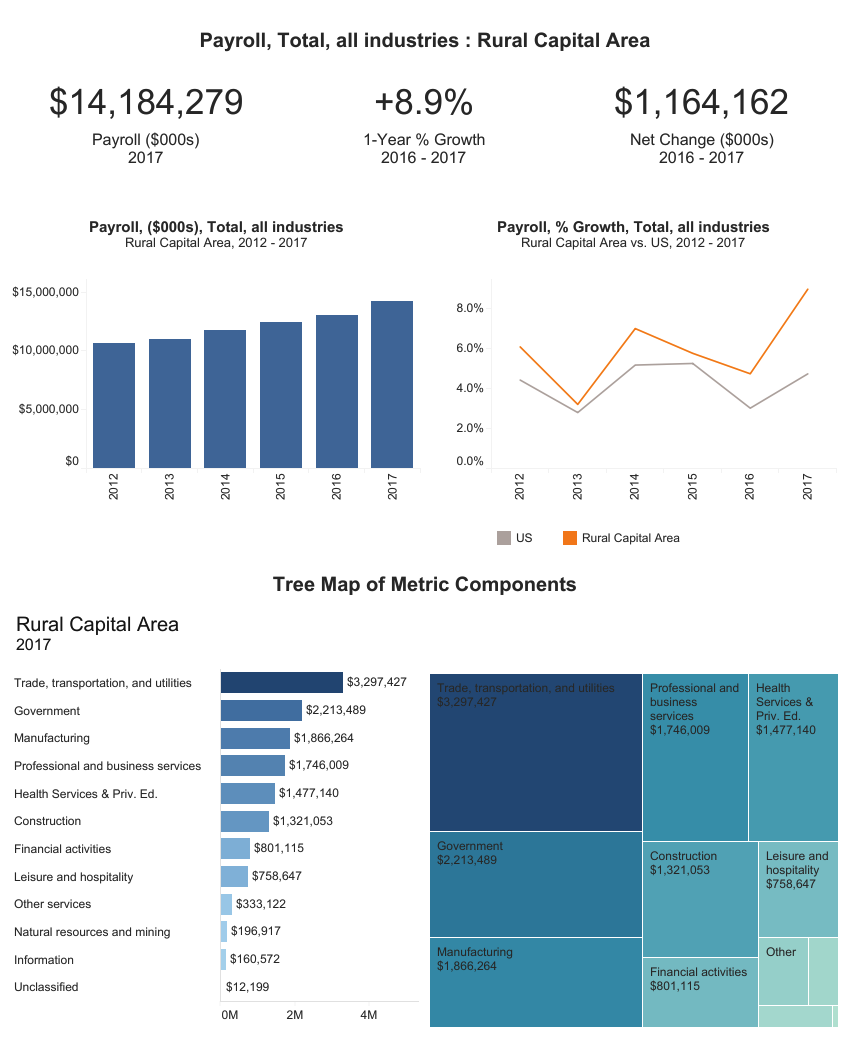
To view payroll for individual industries, visit the Snapshots page to use the interactive report.
Manufacturing Salary in the Rural Capital Area Surpasses $89,000 in 2017
article posted by Headlight on August 27, 2018 (edited August 31, 2018)
The average salary of workers in the manufacturing industry in the Rural Capital Area was $89,000, an increase of nearly 9% in 2017, the fastest growth in the last five years.
The manufacturing industry pays by far the most of any industry in the region. The next highest salaries are in Financial Activities ($62,000) and Professional and Business Services ($62,000).
Within the region, the highest salary is in Williamson County ($115,000), followed by Burnet ($62,300) and Hays ($55,000).
Manufacturing salaries grew the fastest in Williamson County (10%), Llano (8%), Caldwell (5%) and Lee (5%).
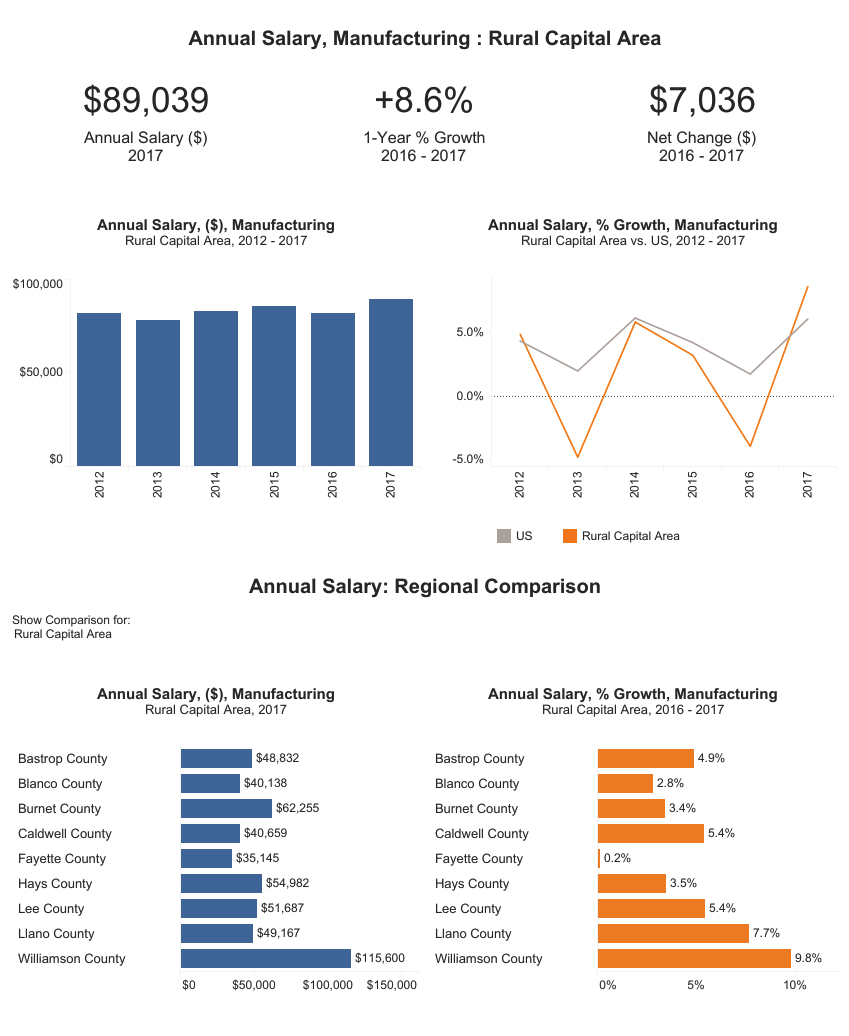
To view salaries for individual industries, visit the Snapshots page to use the interactive report.
Rural Capital Average Salary Reaches $48,000 in 2017, Fastest Growth in Five Years
article posted by Headlight on August 27, 2018 (edited August 31, 2018)
The average salary of workers in the Rural Capital Area was $47,800 in 2017, an increase of nearly 5% in one year, the fastest growth seen in the last five years.
Within the region, Blanco County experienced the highest growth in the last five years (27%), followed by Llano (15%) and Hays (14%).
Williamson County has the highest salaries within the region ($54,000), followed by Lee ($50,000) and Blanco ($47,000).
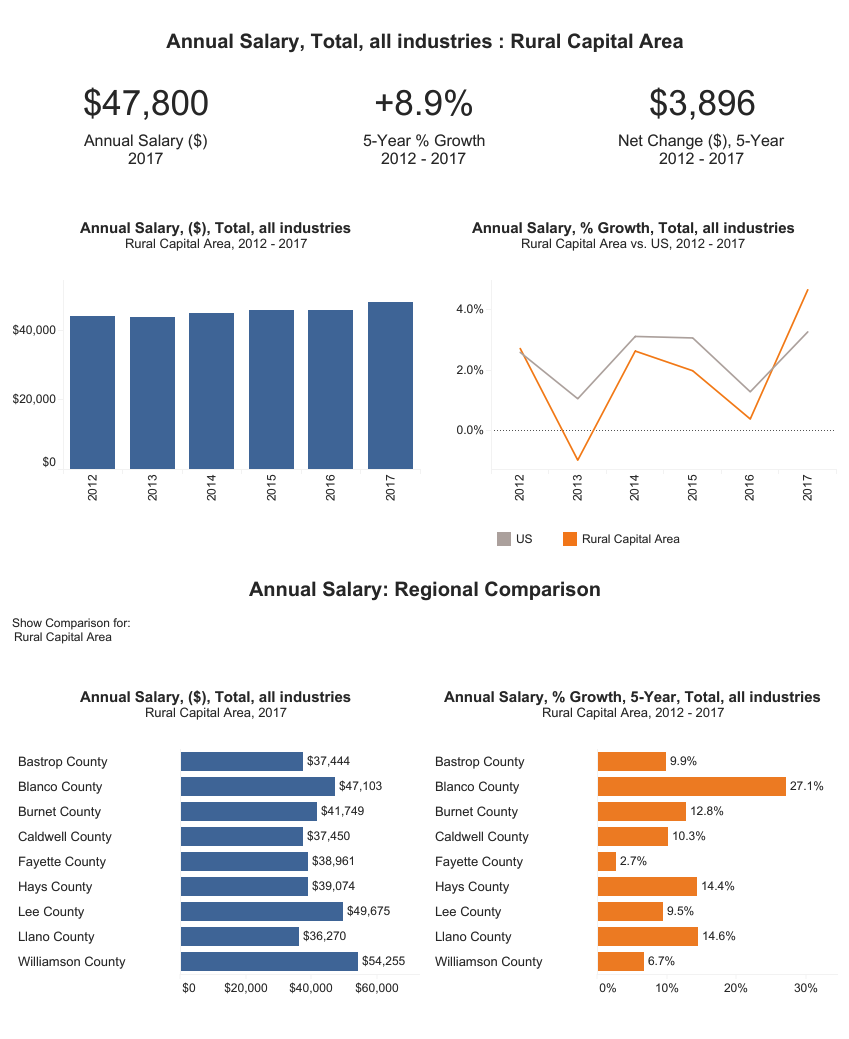
To view salaries for individual industries, visit the Snapshots page to use the interactive report.
Rural Capital Population Grows 3.5% in 2017, Adds 34,000 New People
article posted by Headlight on June 26, 2018 (edited June 26, 2018)
Newly released data shows that the Rural Capital Area population added 34,000 new people in 2017 to reach for the first time a population of over one million people. At a 3.5% growth rate, the Rural Capital Area population grew more than four times (4x) faster than the US population overall.
Within the region, Hays County grew its population the fastest last year (4.9%), followed by Llano County (4.2%), Williamson County (3.6%), and Caldwell County (2.9%). Five-year growth rates are led by Hays, Williamson, and Bastrop counties.
View the interactive dashboard for trends and comparisons in the Rural Capital Area and Austin metro.
Rural Capital Economy Grows 4.1% in 2017, Adds 12,000 New Jobs
article posted by Headlight on June 26, 2018 (edited June 26, 2018)
Newly released data shows that the Rural Capital Area employment base added 11,600 new jobs in 2017 to reach 297,000 total jobs. At a 4.1% growth rate, the Rural Capital Area economy grew three times (3x) faster than the US economy.
Within the region, Blanco County grew its job base the fastest last year (7.5%), followed by Bastrop County (5.2%), Hays County (4.8%), and Williamson County (4.2%). Five-year growth rates are led by Bastrop, Hays, and Williamson counties.
View the interactive dashboard below for trends and comparisons in the Rural Capital Area and Austin metro.
Updated Profile: Historical Industry Trends in the Rural Capital Area
article posted by Headlight on March 5, 2018 (edited April 5, 2018)
The Rural Capital Area employs 285,000 people in a diverse range of industries. The largest industries in the RCA are:
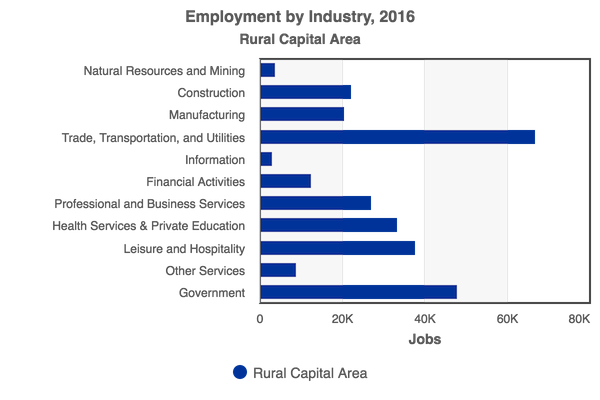
- Trade, Transportation, & Utilities – 23% of employment
- Government – 17%
- Leisure & Hospitality – 13%
- Health Services & Private Education – 12%
- Professional & Business Services – 10%
All industry sectors grew in the Rural Capital Area between 2006 and 2016. The fastest growing sectors during this period were Health Services & Private Education (79%), Professional and Business Services (+71% growth), and Leisure and Hospitality (+67%). These regional sectors all grew much faster than the national rates, which were 28%, 15% and 19% growth respectively.
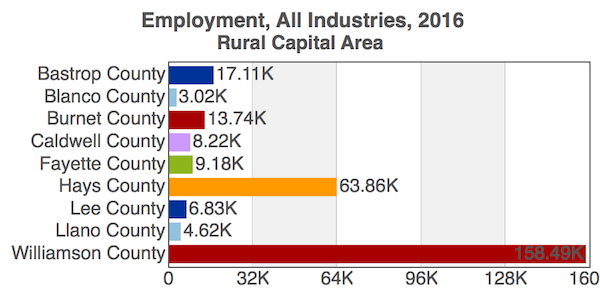
Employment is spread roughly proportional to residency across the Rural Capital Area. Williamson County hosts the greatest number of jobs with 158,000 and 56% of regional employment. The next largest employment counties are Hays County with 22% of regional jobs and Bastrop County with 6%. Employment has grown in all counties between 2006 and 2016, but growth was greatest in Williamson County (50%), Hays County (42%), Bastrop County (36%), and Caldwell County (27%).
Industry Forecasts shows Healthcare, Retail, Entertainment will be the Largest Job Creators in the Rural Capital Area over the Next Five Years
article posted by Headlight on March 5, 2018 (edited April 5, 2018)
The Rural Capital Area economy is expected to create nearly 48,000 new jobs over the next five years (forecast by EMSI). Most new jobs will be in Healthcare (7,400), followed by Retail (7,000) and Entertainment (6,700), which includes hotels, restaurants, bars, and entertainment. Only Industrial Machinery is expected to lose jobs (-1,300).
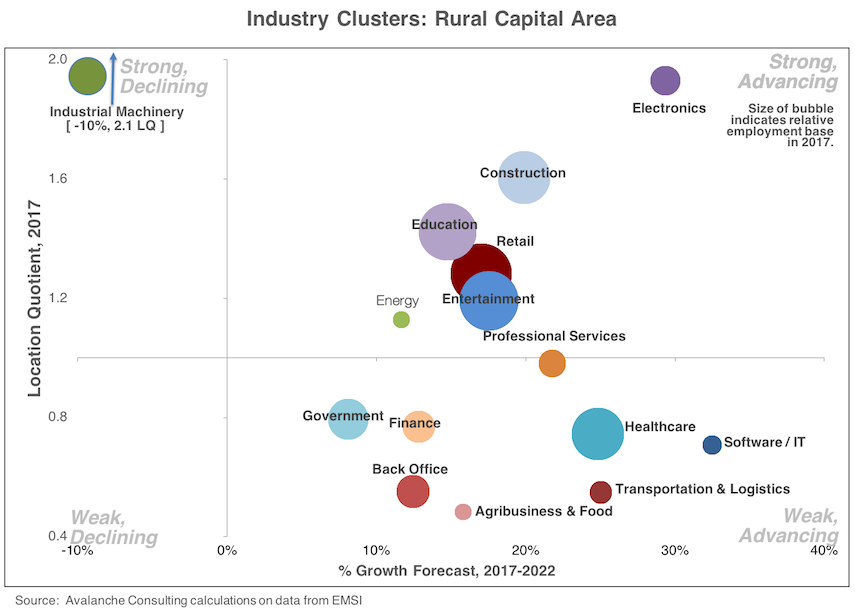
On a percentage basis, the Rural Capital Area will grow its job base by 16.6% over the next five years, which is more than twice as fast as the US' 6.3% growth rate. Software will be the fastest growing industry in the RCA (33%), followed by Electronics manufacturing (29%) and Automotive parts manufacturing (25%).
Manufacturing industries are the most concentrated in the region - those with a per capita density much higher than the US average. Industrial Machinery and Mining (too small to show on chart) are more than 2x the concentration found in the US. Construction and Electronics Manufacturing are more than 1.5x.
Click here to download data by county, for the Rural Capital Area, and for the "RCA+Travis County region".
Updated Profile: Bastrop County
article posted by Headlight on March 5, 2018 (edited April 5, 2018)
Bastrop County is a growing suburban county in central Texas, with a population of 82,730 people and 17,110 jobs. The county has grown faster than the U.S.: the county's population grew 18% from 2006-2016 and job base grew 36%.
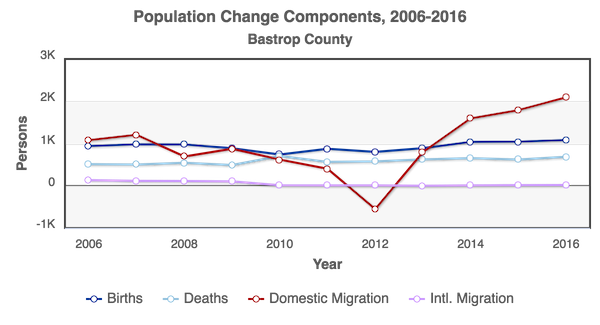
The county's population growth has historically been driven by migration of people into the county: from 2006 to 2016, 77% of new population was due to domestic migration. However, migration into the county turned negative in 2012, likely due to the out-migration of families after the Bastrop fires in late 2011. Positive migration resumed from 2013-2016, more than replacing the lost population during the 2011 fires. 2,093 of the 2,525 new migrants in 2016 were domestic migrants.
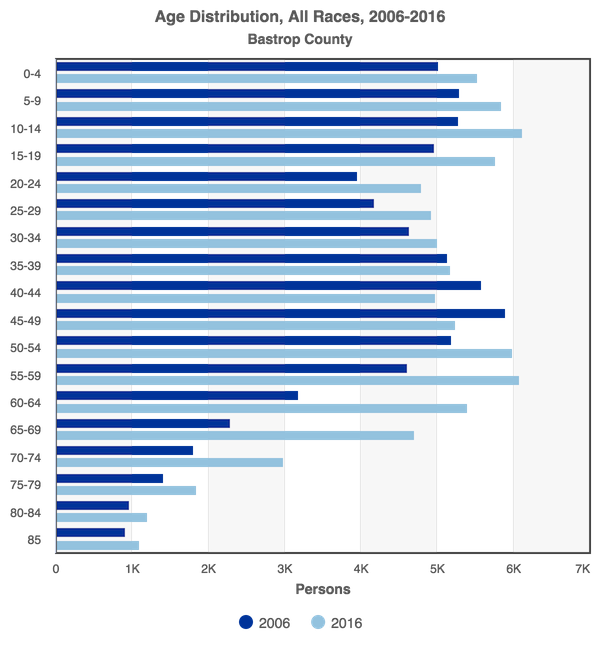
Bastrop County has a diverse age range of population and is home to a large concentration of families. According to the Census, 21% of Bastrop County's population are children under 15 years of age (versus 19% for the U.S.) and 27% of county residents are between 45 and 64 years old (versus 26% for the U.S.). As a result, the county has lower concentrations of both young adults and the elderly residents than the nation.
Of the total population, 89% were born in the United States, with 11% born abroad. Of the foreign-born population, 70% are not naturalized US citizens. Bastrop County's population is 54% White, 35% Hispanic, 8% Black, and 1% Asian. The three largest ancestral groups are German, English, and Irish.
According to the Census, Bastrop County education levels trail the U.S. average: 82% of residents in 2016 had at least a high school degree and only 20% had a Bachelor's degree or higher. These educational attainment statistics are significantly lower than the U.S. average (88% high school, 31% Bachelor's). (American Community Survey, Bastrop County)

Bastrop County's median household income remained just above the national average for many years, but fell to 97% of U.S. median household income in 2012. It rose to become 102% of the national average in 2016. The percent of overall population in poverty in Bastrop County has remained slightly under national trends for most of the past decade. Between 2005 and 2015 overall population in poverty in Bastrop County rose slightly from 11.7% to 12.7%. The percentage of children in poverty in Bastrop county rose from 17.8% in 2005 to 21.7% in 2015.

Bastrop County's economy has performed very well over the past decade, creating new jobs every year until 2011. Bastrop County has weathered the national recession well, adding 400 jobs in 2009 and 2010, despite losing 250 in 2011. 2013 showed a positive rebound of 1,000 jobs and job growth was twice as high as the U.S. average in 2015 and 2016.

Bastrop County unemployment rate has fallen from its recent high of 8.2% in 2010 to 3.7% in 2016. The county rate has been lower than the U.S. rate since 2006.

The largest industries in Bastrop County are:
- Government – 24% of county employment
- Trade, Transportation, and Utilities – 23%
- Leisure and Hospitality – 16%
- Health Services – 11%
- Construction – 7%
Employment in all major industries has grown over the past 5 years except in Manufacturing and Government. Significant growth occurred in Information (+174%), Leisure and Hospitality (+60%), Trade, Transportation, and Utilities (+42%), and Health Services (+43%). Manufacturing employment declined -8.5% from 2011-2016, while the U.S. gained 5.1%.

Most salaries in Bastrop remain below U.S. levels, but are gaining. Natural Resources and Mining has salaries above U.S. levels. The average salary in Bastrop County is 68% of the U.S. average and from 2011-2016 grew 8%, slower than the U.S. growth rate of 12%. The county's fastest growing salaries are in Leisure and Hospitality, Health Services & Private Education, and Manufacturing.
The Rural Capital Area Attracted Over 10,000 Net New Households in 2016 and Nearly $800 Million in Gross Income
article posted by Headlight on January 3, 2018
The Rural Capital Area attracted over 10,000 net new households in 2016 from other parts of the state and US. While most relocations were from Travis County (5,300 households), the RCA was a net gainer of households from other metros such as Houston (550), Los Angeles (310), and Dallas-Ft. Worth (250).
The RCA lost net households to very few metros, and in small numbers: San Antonio (-41 households), Ft. Collins (-36), and Charlotte (-23).
This data is from the IRS, which reports tax return flows from one county to another county, when there are 10 or more households flowing in one direction. “Households†is a proxy for tax returns. "Persons" is a proxy for reported exemptions.
Data also aggregates the impact of flows for Adjusted Gross Income. The Rural Capital Area gained nearly $800 million in net new gross income in 2016 due to household migrations.
Download a snapshot of per capita income in the Rural Capital Area by county, metro or region by clicking in the bottom-right corner below. Or, visit the Migration dashboard in Rural Capital Headlight to download individual charts.
New in 2018: Data Download Table
article posted by Headlight on January 3, 2018
Now in Rural Capital Headlight, we've provided the ability to download large spreadsheets of data. Visitors can configure the data shown in the table using the dynamic drop downs and then download data in Excel format.
Click here to visit the Data Download page, which can be found in the Other menu tab.
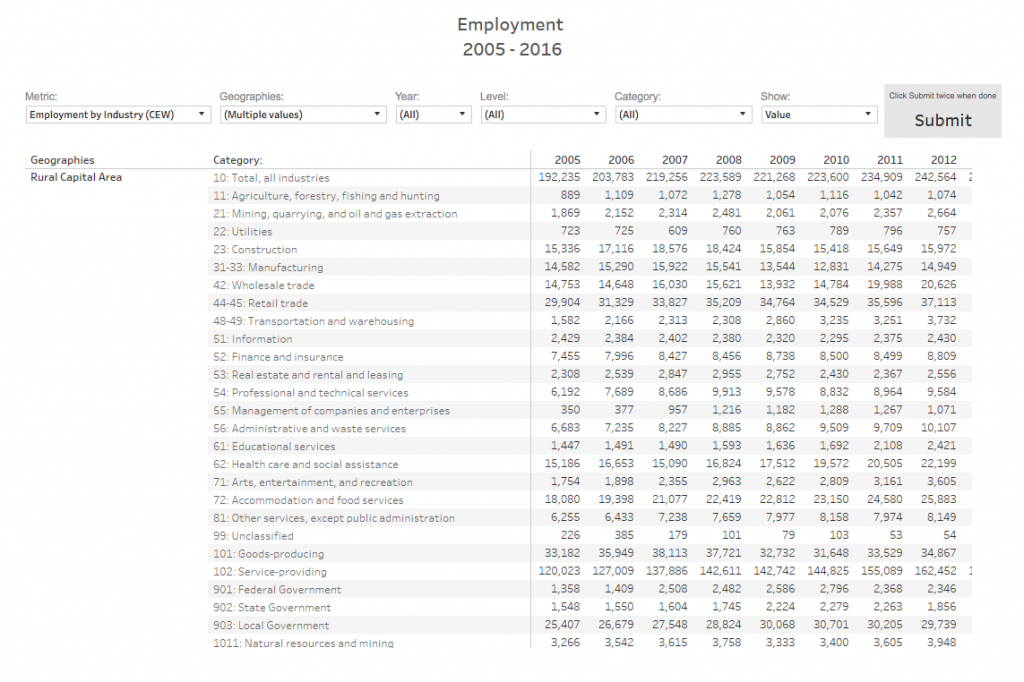
New in 2018: County Heat Maps
article posted by Headlight on January 3, 2018
Now in Rural Capital Headlight, we've provided the ability to create color-coded heat maps of data for Rural Capital Area counties. Visitors can configure the using the dynamic drop downs and then download data in Excel format.
Click here to visit the County Map page, which can be found in the Other menu tab.

Assessment and Identification of LEP Customers in the Rural Capital Workforce Development Area
article posted by Headlight on January 3, 2018
Download the full report: 2017-2018 Assessment and Identification of LEP Customers
This report provides a summary of the Limited English Proficiency (LEP) population distribution throughout the 9-county Rural Capital Workforce Development Area of Texas by using the most recently released US Census Data 1, 2, and PEIMS data for the 2016-2017 school year provided by the Texas Education Agency (TEA) 3, 4 which identifies the ‘Home Language' of school-going populations by county. The first data set from the US Census Bureau – 2011-2015 American Community Survey 5-Year Estimates – provides information for our smaller and midsize counties (Bastrop, Blanco, Burnet, Caldwell, Fayette, Hays, Lee, and Llano) while most of the data for our largest county (Williamson) is derived from the more recent 2016 American Community Survey 1-Year Estimates. This second data set contains more current population estimates for our most urban county (consisting of approximately 56.1% of the entire Rural Capital Area population) and, therefore, provides a more accurate view of the dynamic areas of population within the Rural Capital Area. The English Language Learner data from TEA is intended to provide a confirmation of the primary Census data by highlighting the percentage of children in our local school districts who have a ‘Home Language' other than English. However, several of the current TEA county data sets show large changes from previous years that are likely the result of changes in reporting procedures by local school districts rather than actually changes in the local LEP population.
Per Capita Income in the Rural Capital Area Surpasses $42,000, Grows 16% in 5 Years
article posted by Headlight on November 21, 2017
Recently released data from the U.S. Bureau of Economic Analysis shows that the per capita income of the Rural Capital Area reached $42,000 in 2016, a 16% increase from the previous 5 years (on par with US growth). Per capita income in the Rural Capital Area is 85% of the US average.
Within the Rural Capital Area, Fayette county has the highest per capita income ($48,200), followed by Blanco county ($47,400) and Llano county ($45,400). 5-year growth rates were the highest in Llano (27%), Lee (22%), and Fayette (19%) counties. Last year, per capita income grew the fastest in Williamson county (1.5%).
Download a snapshot of per capita income in the Rural Capital Area by county, metro or region by clicking in the bottom-right corner below. Or, visit the Per Capita Income dashboard in Rural Capital Headlight to download individual charts.
And, the dashboard above can be embedded in other websites. Click on the embed icon and paste the embed code into the HTML of your web page.
Unemployment Rate at 3.1% in the Rural Capital Area, a 16-year Low
article posted by Headlight on November 21, 2017
The unemployment rate in the Rural Capital Area has fallen steadily this decade and now stands at 3.1%. This rate is at its lowest point in 16 years (since December, 2000).
Unemployment is low across all counties in the Rural Capital Area. Blanco county has the lowest unemployment rate (2.6%) while Llano has the highest (3.5%). All unemployment rates across the region are far lower than the US average, 4.1%, which is at a 10-year low.
Download a snapshot of unemployment in the Rural Capital Area by county, metro or region by clicking in the bottom-right corner below. Or, visit the Unemployment dashboard in Rural Capital Headlight to download individual charts.
And, the dashboard above can be embedded in other websites. Click on the embed icon and paste the embed code into the HTML of your web page.
Texas Workforce Commission Announces Texas Operation Welcome and We Hire Vets Web Portal
article posted by Headlight on November 20, 2017
AUSTIN ⎯ The Texas Workforce Commission (TWC) recently launched its rebranded web portal Texas Operation Welcome Home to better meet the employment needs of transitioning service members, recently separated veterans and military spouses. The portal includes information and web links to several employment and training initiatives for veterans and employers.
“The service members transitioning back to the civilian workforce and our Texas veterans are an extremely valuable source of talent for Texas employers,†said TWC Chairman Andres Alcantar. “We are proud to provide information and resources to Texas veterans seeking opportunities in industries across Texas, as well as to the employers who benefit from their unmatched leadership and skills.â€
The web portal includes online registration for the “We Hire Vets†employer recognition program that recognizes Texas employers for their commitment to hiring veterans. Through the program, employers whose workforce is composed of at least 10 percent military veterans are eligible to receive a “We Hire Vets†employer recognition decal to display on the employer's storefront as well as an electronic decal to display on the employer's website.
“We've had tremendous response from employers inquiring about and registering for the We Hire Vets program,†said TWC Commissioner Representing Employers Ruth R. Hughs. “With our Texas Operation Welcome Home webpage, we will continue our efforts to connect employers with veterans and their family members who are seeking employment.â€
Employers interested in the “We Hire Vets†program can register online. Since the program's launch, 47 businesses have been nominated as “We Hire Vets†employers. JVIC Catalyst Services LLC is a “We Hire Vets†participant and recently extended 36 job offers to veterans. Starting wages for the jobs are $23 an hour.
“With veterans, you don't have to worry about the little things. They are on time, where they are supposed to be, and bring all necessary tools ready to work,†said JVIC Catalyst Services Health and Safety Member Kevin D. Palmer.†“It's ingrained within them in the military, and you generally don't get that right off the bat with the civilian population.â€
“Our veterans are ready to work, and it's important to ensure their access to readily available employment information on our websites,†said TWC Commissioner Representing Labor Julian Alvarez. “We're extremely grateful of our veterans and their service and welcome the opportunity to help them transfer their skills into the civilian workforce.â€
In addition to “We Hire Vets,†other programs and initiatives for veteran employment featured on the rebranded web portal include:
• Texas Skills to Work — Assists service members by translating military experience into civilian terms and skill sets. After translation, it matches the civilian skill set with online job postings requiring those same skills.
• Skills for Transition — Provides training opportunities to transitioning military service members who are preparing to separate from service within 180 days who will remain in Texas or who have been discharged within the past 180 days. The training is for employment in high-growth, high-demand occupations.
• Military Family Support Pilot Program — Provides $1 million in grants to fund employment assistance for military spouses including enhanced job search assistance, assessment of skills, labor market information, and résumé writing and interview skills assistance.
For more information on the Texas Operation Welcome Home web portal and the “We Hire Vets†program, visit www.texasoperationwelcomehome.com.
###
The Texas Workforce Commission is a state agency dedicated to helping Texas employers, workers and communities prosper economically. For details on TWC and the services it offers in coordination with its network of local workforce development boards, call 512-463-8942 or visit www.texasworkforce.org. To receive notifications about TWC programs and services subscribe to our email updates.
Texas Workforce Commission - Equal Opportunity Employer/Program
Auxiliary aids and services are available upon request to individuals with disabilities.
Relay Texas: 800-735-2988 (TDD) or 711 (Voice)
RuralCapitalCareers.com Now Updated for the New School Year
article posted by Headlight on September 8, 2017
Workforce Solutions–Rural Capital Area's career planning website has now been updated to reflect the latest forecasts and skills demand:
http://www.RuralCapitalCareers.com
This one-of-a-kind tool provides 24/7-access to career information for students, parents, career counselors and adult workers seeking new careers. It helps users identify careers in the Rural Capital Area, the skills required for those careers, and the available college and training programs for each career. An Interests Survey matches careers to users' abilities, desired work tasks, and planned educational attainment level. Employment data and forecasts show job demand by county and region.
Please visit http://www.RuralCapitalCareers.com and create your FREE account.

The Hottest Careers in the Rural Capital Area for Bachelor's Degree Holders are Managers, Engineers, and Analysts
article posted by Headlight on September 8, 2017
The just-released Hot Careers list for the Rural Capital Area highlight the high growth, high wage occupations for Bachelor's and Associate's degree holders.
At the top of the list for Bachelor's degree holders are Chief Executives, who earn over $80 per hour. These high-wage careers take many years climbing the corporate ladder and gaining the experience necessary to run a company. A formal education is just the tip of the iceberg – be prepared to work hard.
Architectural & Engineering Managers and Computer & Information System Managers are also top on the list. In fact, managerial positions dominate the Top 15 list, accounting for more than half of the highest paying jobs. Becoming a manager requires a diverse set of skills such as team building, public speaking, problem solving, strategy and even cross-cultural understanding. Being well-educated means also developing these important skills outside of the classroom.
Computer-related occupations and Engineers also feature prominently in the Top 15 list. Computer Hardware Engineer is the highest paying, non-managerial occupation on the list, while Software Developers will be in highest demand with 519 job openings in the Rural Capital Area.
Eight of the Top 15 occupations are STEM (Science, Engineering, Technology or Math) occupations. The rest belong to the Business, Finance, Back Office or Production sectors.
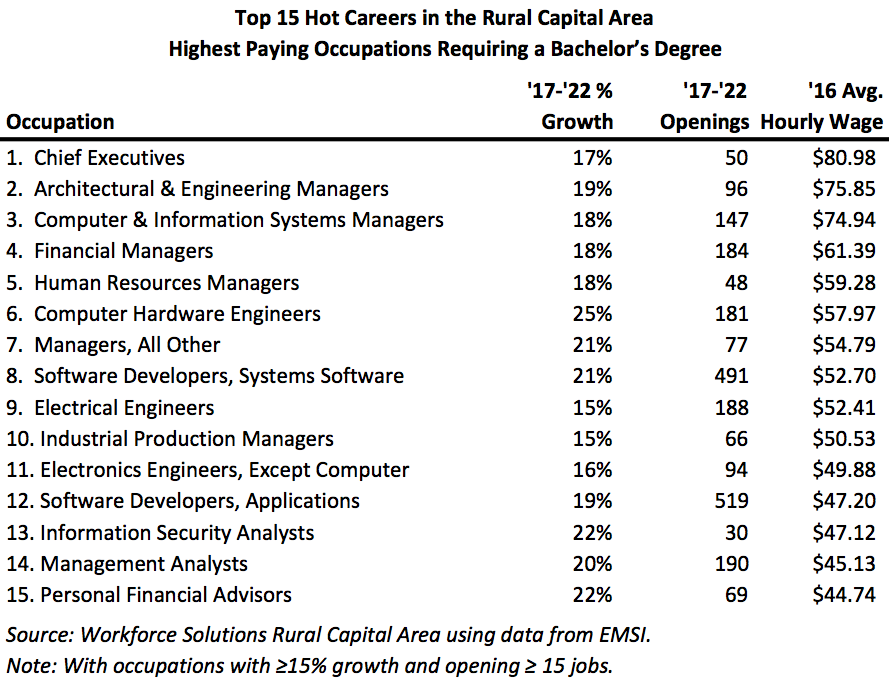
Health Care and Engineering are the Hottest Careers for Associate's Degree Holders in the Rural Capital Area
article posted by Headlight on September 8, 2017
At the Associate's degree level, the hottest careers in the Rural Capital Area are Drafters, Web Developers, and Dental Hygienists.
Drafters earn more than $35 per hour, will grow 20% from 2017-2022, but have limited job openings. Preschool Teachers will have the most job openings of any career on the Top 15 list.
Medical occupations make up eight of the Top 15 for Associate's degree holders. Engineering jobs account for three of the Top 15. Almost 90% of the Top 15 are STEM occupations.
Three hot careers outside of the Medical and Engineering sectors are Web Developers, Paralegals & Legal Assistants, and Preschool Teachers. These occupations are expecting strong growth over the next few years and have high earning potential.

Registered Nurses and Software Developers are the Hottest STEM Careers in the Rural Capital Area
article posted by Headlight on September 8, 2017
STEM: Science, Technology, Engineering and Math. In the age of information and technology, the demand for skilled STEM workers continues to increase. STEM occupations account for more than half of the Top 15 highest paying hot careers for Bachelor's degree holders and nearly 90% of the Top 15 highest paying hot careers for Associate's degree holders.
Registered Nurses are the hottest STEM occupation by a large margin. At 1,200 job openings, no other STEM occupation comes close to matching the level of demand for Registered Nurses in the Rural Capital Area. Computer-related occupations hold 5 of the Top 15 Hottest Career spots with Software Application Developers (519 jobs), Software Systems Developers (491 jobs), and Computer Analysts (427 jobs) having the highest demand.
The highest paying STEM occupation is Physicians & Surgeons, earning $113 per hour on average. However, this occupation requires a doctoral degree, so dedication and many years of studying are essential for this hot career. Seven of the Top 15 STEM occupations require at least a Bachelor's degree. Some notable exceptions are Pharmacy Technicians and Machinists which require only a High School Diploma, though some training is preferred. The average hourly wage for these occupations are $14.48 and $18.50, respectively.
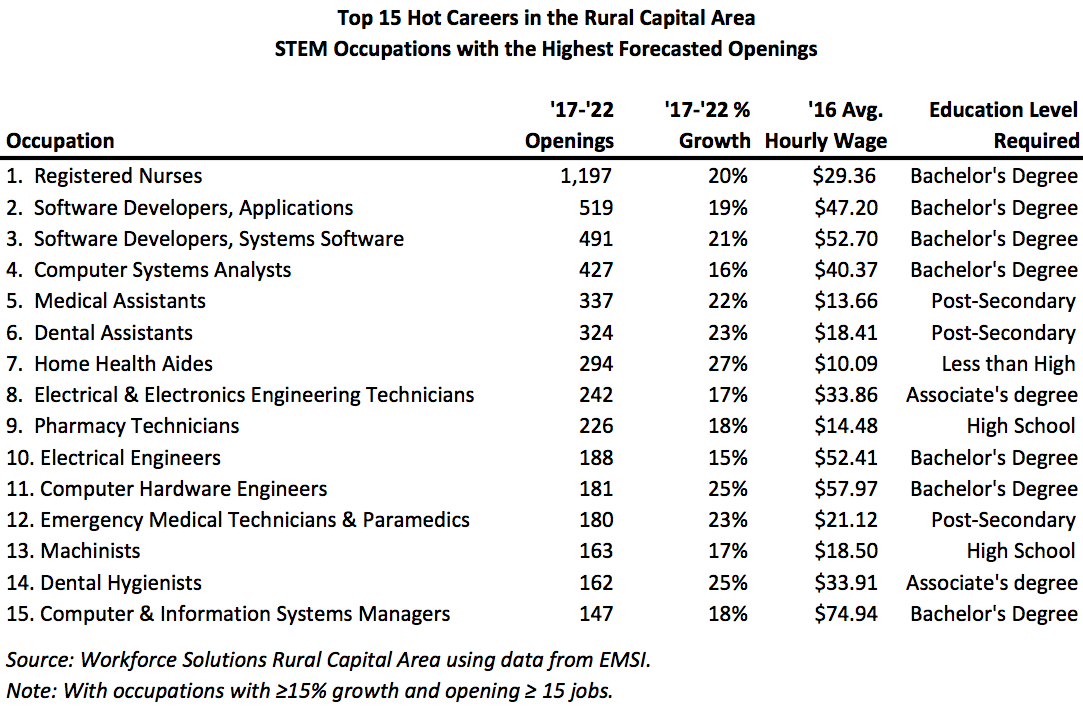
Mechanics and Construction hold the Hottest Careers in Trades Occupations for the Rural Capital Area
article posted by Headlight on September 8, 2017
The Mechanic and Construction sectors dominate the Top 15 list for Trades, Installers, & Repair Technicians with 14 of the Top 15 occupations. The hottest careers in Trades, based on the number of job openings, are Maintenance & Repair Workers, Automotive Techs and Equipment Operators. These three occupations will each have more than 350 job openings and 15% growth or higher over the next five years.
The highest paying Trade occupations in the Top 15 are Power-Line Installers ($26 per hour) and Industrial Machinery Mechanics ($25 per hour), with Power-Line Installers also the fastest growing at 26%.
Most Trades occupations require only a High School Diploma or Post-Secondary Certificate, which makes them great occupations for those looking to be in high demand without spending a lot of time or money in a classroom setting.

Texas Economy Adds 14,800 Jobs in May
article posted by Headlight on June 26, 2017
Texas Workforce Commission
AUSTIN ⎯ The Texas economy expanded in May with the addition of 14,800 seasonally adjusted nonfarm jobs. Texas' seasonally adjusted unemployment rate fell to 4.8 percent, down from 5.0 percent in April.
“Texas employers created 266,600 jobs over the past year and the Texas economy continues to provide competitive advantages to large and small business owners across the state,†said TWC Chairman Andres Alcantar. “TWC remains committed to fostering innovative partnerships that equip Texas students and workers with in-demand skills.â€
Mining and Logging recorded the largest private-industry gain over the month with 6,600 jobs added. Construction employment grew by 3,400 jobs in May and Financial Activities employment expanded by 3,200 jobs.
“Employers in Texas have created more than 233,200 private-sector jobs over the year, including 11,100 jobs in May,†said TWC Commissioner Representing Employers Ruth Hughs. “We want to ensure all Texas employers have the resources they need to continue to grow their businesses, and I encourage employers to take advantage of the TWC programs we offer to help them create jobs and train workers with the skills needed for today's job market.â€
The Amarillo Metropolitan Statistical Area (MSA) recorded the month's lowest unemployment rate among Texas MSAs with a non-seasonally adjusted rate of 3.1 percent, followed by the Austin-Round Rock, College Station-Bryan and Lubbock MSAs with a rate of 3.2 percent. The Midland MSA registered a rate of 3.4 percent for May.
“All Goods Producing industries showed positive employment growth in Texas, including Manufacturing, which expanded by 1,800 jobs in May,†said TWC Commissioner Representing Labor Julian Alvarez. “I encourage our labor force to tap into TWC's training resources like our apprenticeship training program that can help prepare them for a well-paying career.â€
An audio download with comments from Commissioner Alvarez on the latest labor market data is available on the TWC press release page. Employment estimates released by TWC are produced in cooperation with the U.S. Department of Labor's Bureau of Labor Statistics. All estimates are subject to revision. To access this and more employment data, visit tracer2.com.
Hays County Leads Job Growth in the Rural Capital Area in 2016, Williamson County and Bastrop County Follow
article posted by Headlight on June 26, 2017
According to recently released data from the Bureau of Labor Statistics, the Rural Capital Area's employment base grew 4.3% in 2016, creating 12,000 new jobs.
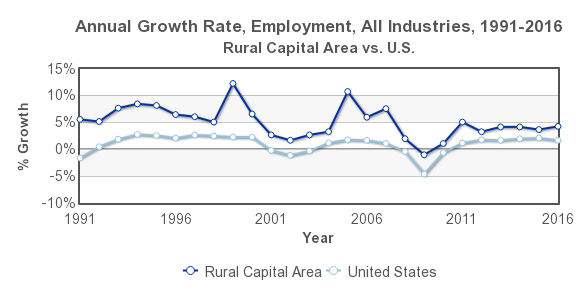 Within the Rural Capital Area, most new jobs were created in Williamson County (7,500 new jobs), followed by Hays County (3,200 new jobs). On a percentage basis, job growth was highest in Hays County (5.3%), Williamson County (5.0%) and Bastrop County (4.8%).
Within the Rural Capital Area, most new jobs were created in Williamson County (7,500 new jobs), followed by Hays County (3,200 new jobs). On a percentage basis, job growth was highest in Hays County (5.3%), Williamson County (5.0%) and Bastrop County (4.8%).

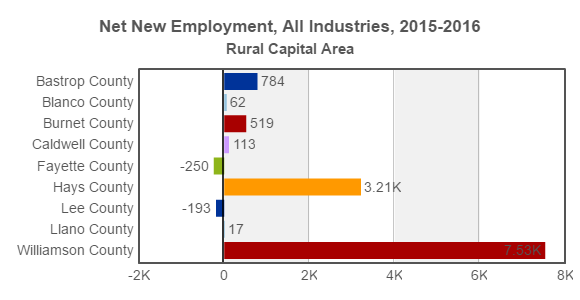
Information Industry Leads Job Growth in 2016 in the Rural Capital Area
article posted by Headlight on June 26, 2017
According to recently released data from the Bureau of Labor Statistics, Information Industry led growth in the Rural Capital Area last year. The Health Services & Priv. Education & Construction Industries followed.
Click here for a description of the industries.
Information grew fastest in Bastrop and Williamson counties. Health Services & Priv. Education led growth in Burnet and Lee Counties, while Construction grew fastest in Fayette and Hays counties. Professional and Business Services led growth in Blanco County. Leisure and Hospitality grew fastest in Caldwell county and Financial Activities led growth in Llano County.
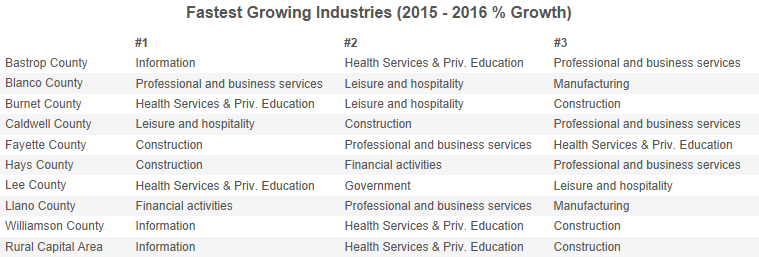
In terms of the new jobs created, Health Services & Priv. Education created the most jobs in the Rural Capital Area overall and in Bastrop, Burnet, Lee and Williamson counties individually. Construction created the most new jobs in Fayette and Hays Counties, while Other Services in Blanco county. Leisure & Hospitality created the most jobs in Caldwell county. Financial Activities led job creation in Llano County.
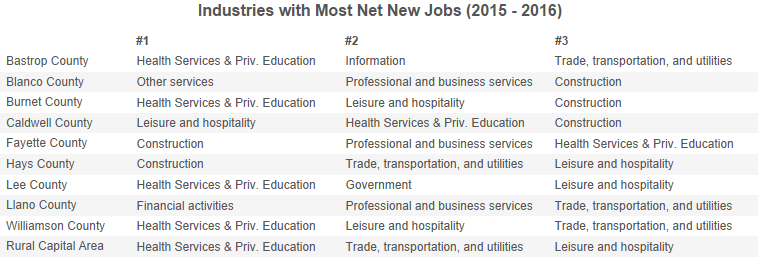
Interactive Table:
Most Newcomers to the Rural Capital Area are from Travis County and other Texas Counties; California, Illinois Counties also make the Top 10
article posted by Headlight on May 2, 2017
Data from the Internal Revenue Service reports which counties outside of the Rural Capital Area account for the highest number of household relocations to the region. The IRS-reported number of tax returns acts as a proxy for households.
Most of the households moving to the Rural Capital Area (net inflows and outflows) are from Travis County (2,700 households). Harris County-TX (140 households), Los Angeles County-CA (120) and Cook County-IL (90) follow.

The most popular destinations for households moving out of the Rural Capital Area are Tarrant County-TX (-34 households), Wake County-NC (-26), Brazos County-TX (-25) and Fort Bend County-TX (-22).

5,100 Households Relocated within the Rural Capital Area in 2015; Lee County had Highest Net Household Gain within Region
article posted by Headlight on May 2, 2017
In 2015, 5,100 households (tax returns) moved from one county to another county within the Rural Capital Area. The three counties that received the most households were Williamson County (603 new households), Hays County (598) and Bastrop County (372). The three counties that lost the most households were Williamson County (656), Hays County (604) and Bastrop County (367).

Generally speaking, the in- and out-flows balance out for most counties. But, some counties gain more than they lose. In terms of net migration (households relocating in minus those relocating out), Lee County gained the most new households (50), followed by Burnet County (22) and Caldwell County (8). Williamson County lost a net of 53 households to other counties in the Rural Capital Area.
In addition to Williamson County, Fayette, Hays, Llano and Blanco counties lost more households than they gained. The rest of the counties saw positive net migration from within the Rural Capital Area.

Wages & Income Profile of the RCA
article posted by Headlight on May 2, 2017
Salaries in the Rural Capital Area are below U.S. levels in all industries except Trade, Transportation, & Utilities and Manufacturing.
The average salary in the Rural Capital Area is 86% of the U.S. average and from 2010-2015 grew 17%, while the U.S. growth was 13%.
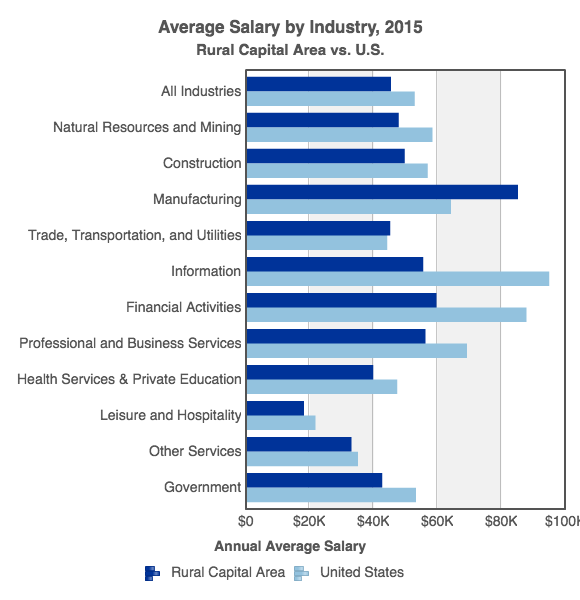
Salaries in seven sectors grew faster than the national rate during this period:
• Manufacturing – 81% growth
• Professional and Business Services – 32%
• Natural Resource and Mining – 21%
• Construction – 21%
• Financial Activities – 20%
• Leisure and Hospitality – 16%
• Health Services and Private Education – 10%
No salaries declined from 2010-2015 in either the United States or the Rural Capital Area. A significant portion of regional salary declines occurred between 2000 and 2003 during the tech bubble crunch. From 2005 to 2015, average salary growth has roughly matched U.S. growth with slight salary drops in 2009 and 2013 of 1.1% and 1.0% respectively.
Per Capita Income in the Rural Capital Area has remained below the U.S. average for the past 10 years, reaching 86% of U.S. Per Capita Income in 2015. As with Salary Levels, Per Capita Income saw regional declines in 2001 and 2002, but otherwise roughly matched U.S. growth trends between 2005 and 2015, including a decline of 4% in 2009.
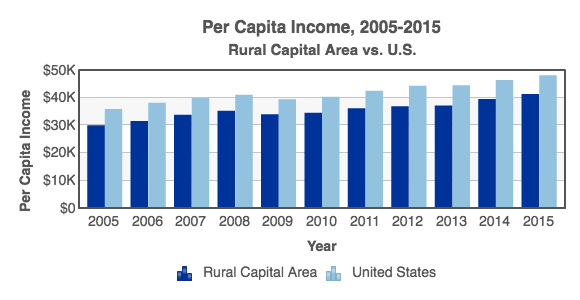
Median Household Income in the Rural Capital Area remained above U.S. levels during the past decade, reaching 123% of U.S. Median Household Income in 2015. Regional Median Household Income levels were not as greatly affected by the tech crunch in the early 2000s as Per Capita Income and have also grown at a similar rate to the U.S. as a whole. Rural Capital Area Median Household Income declined by 2.3% in 2009, less than the U.S. Median Household Income drop of 3.5%.

The Rural Capital Area has much lower poverty levels than the U.S. as a whole, particularly for those aged under 18. Between 2005 and 2015, poverty levels increased slightly in the Rural Capital Area for all ages, rising from 9.5% in poverty in 2005 to 9.8% in poverty in 2015, less than the U.S. level of 14.7% in 2015. The regional percentage of children in poverty also increased during this same period, rising from 12.5% of children in poverty in 2005 to 12.8% in poverty in 2015, compared to 20.7% of children in poverty in the U.S.
Rural Capital Area Population Grows 3.8% in 2016 to Reach 977,000 Residents; Hays and Williamson Counties Lead Growth
article posted by Headlight on March 29, 2017
Recently released data from the US Census Bureau reveals that the Rural Capital Area population grew 3.8% in 2016 (July 2015 to July 2016). The total population increased by 36,000 people to total 977,000.

Domestic migration was the primary source of growth last year. On a net basis, more than 29,000 people relocated to the region in 2016, around 1,000 more people than the year before. Every day, 75 people relocate to the Rural Capital Area.
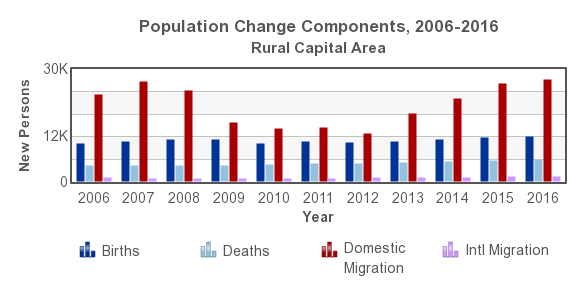
Within the region, Hays County experienced the fastest rate of growth (5.1%), followed by Williamson County (4.1%) and Bastrop County (3.1%). On an absolute basis, Williamson County added the most new residents (20,700) followed by Hays County (9,900).
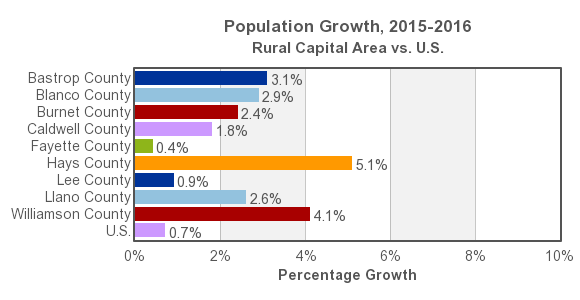
Texas Adds 51,300 Jobs in January
article posted by Headlight on March 29, 2017
The following article was written by the Texas Workforce Commission.
Click here to read the article on the Workforce Solutions website.
AUSTIN - Texas employers expanded their payrolls in January with the addition of 51,300 seasonally adjusted nonfarm jobs. Texas' seasonally adjusted unemployment rate remained unchanged at 4.8 percent.
“Texas employers and our talented workforce started 2017 on a high note with the addition of 51,300 jobs in January,†said Texas Workforce Commission (TWC) Chairman Andres Alcantar. “Employers in a diverse range of industries have added 225,300 jobs over the year, a reflection of the many competitive advantages Texas offers to employers, including a strong business climate and an expanding and highly skilled workforce.â€
The Professional and Business Services industry recorded the largest private-industry employment gain over the month with 14,000 jobs added. Trade, Transportation, and Utilities employment grew by 8,100 jobs in January, and Manufacturing employment expanded by 7,300 jobs.
“Private-sector employment was strong over the year with an increase in overall jobs of 183,100, and 45,900 jobs added in January,†said TWC Commissioner Representing Employers Ruth R. Hughs. “Texas employers continue to strengthen the job market by expanding employment and training opportunities.â€
The Amarillo and Lubbock Metropolitan Statistical Areas (MSA) recorded the month's lowest unemployment rate among Texas MSAs with a non-seasonally adjusted rate of 3.4 percent, followed by the Austin-Round Rock MSA with a rate of 3.5 percent for January.
“Our economy continues to offer many diverse opportunities to job seekers,†said TWC Commissioner Representing Labor Julian Alvarez. “I encourage all job seekers to contact their local Workforce Solutions office for assistance with job training, placement and other specialized employment services.â€
Rural Capital Area Records over 11,700 Births in 2016; Birth Rates Highest in Bastrop, Caldwell and Lee Counties
article posted by Headlight on March 29, 2017
Recently released data from the US Census Bureau reveals that the Rural Capital Area recorded 11,700 births in 2016 (July 2015 to July 2016), an increase of 2.8% over the previous year. The birth rate for the region is 12.3 births per 1,000 people.
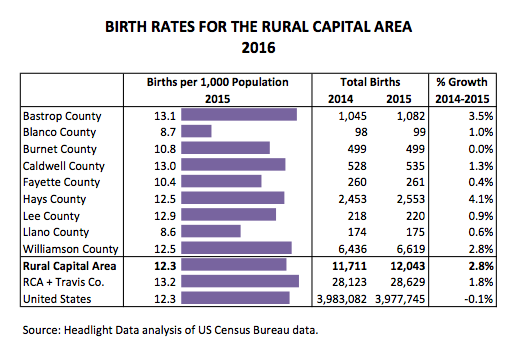
Within the Rural Capital Area, Bastrop County has the highest birth rate (13.1 births per 1,000 people). Caldwell County (13.0), Lee County (12.9), Williamson County (12.5) and Hays County (12.5) follow.
The counties with the lowest birth rates are Llano (8.6) and Blanco (8.7).
All counties saw an increase in births in 2016. The counties where births grew fastest were Hays County (4.1%), Bastrop County (3.5%) and Williamson County (2.8%).
The number of births is growing faster in the Rural Capital Area than in Travis County (2.8% vs. 1.1%), though, when combined, the RCA + Travis County region has a higher birth rate (13.2 vs. 12.3) – a result of Travis County's high birth rate (13.8).
Profile: Williamson County
article posted by Headlight on February 7, 2017
Williamson County is the most populous suburban county in the Austin metropolitan area, with a population of 508,500 people and 150,800 jobs. The county has grown much faster than the metro and U.S.: the population grew 53% from 2005-2015 and job base grew 49%.
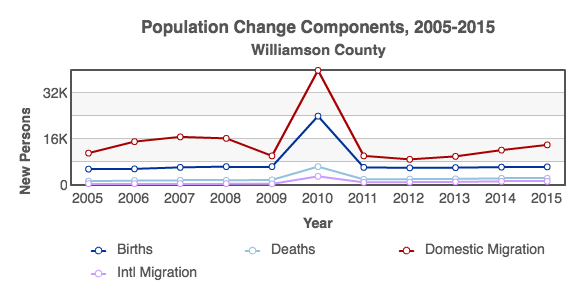
The county's population growth is primarily due to the migration of people into the county. Domestic migration increased over the past five years, rising to 13,950 people in 2015.

Williamson County has a diverse age range of population, and is home to a large concentration of families. According to the Census, 22% of Williamson County's population are children under 15 years of age (versus 19% for the U.S.) and 24% of county residents are between 45 and 64 years old (versus 26% for the U.S.).
As a result, the county has lower concentrations of both young adults and the elderly residents than the nation. Of the total population, 86% were born in the United States, with 14% born abroad. Of the foreign-born population, 51% are not naturalized US citizens.
Williamson County's population is 61% White, 24% Hispanic, 6% Black, and 6% Asian. The three largest ancestral groups are German, English, and Irish.
According to estimates from the Census, Williamson County is well-educated: 93% of residents have at least a high school degree and 40% have a Bachelor's degree or higher. These educational attainment statistics are significantly higher than the U.S. average (89% high school, 30% Bachelor's). (American Community Survey, Williamson County)
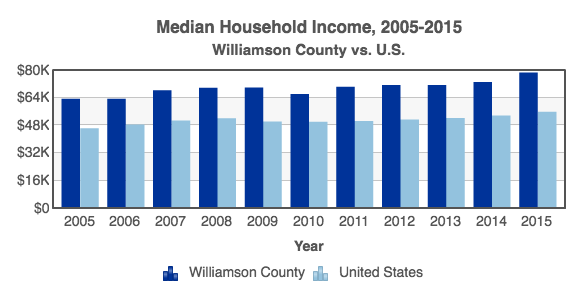
Williamson County's median household income has remained above the national average for many years, and was 141% of U.S. median household income in 2014.
The county weathered the recession well, losing jobs in 2009 but gaining 51,800 new jobs from 2010-2015.
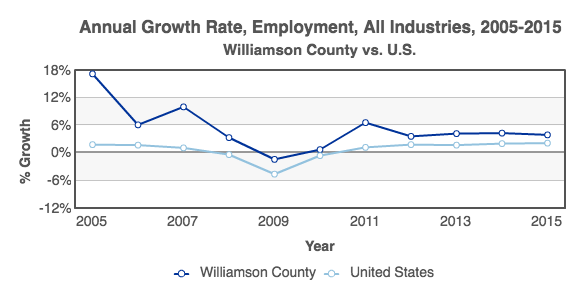
The percent of overall population in poverty in Williamson County has also remained significantly below national trends over the past decade. Between 2010 and 2015 overall population in poverty in Williamson County rose marginally from 6.0% to 6.6%. The percentage of children in poverty grew from 8.2% in 2010 to 8.7% in 2015.
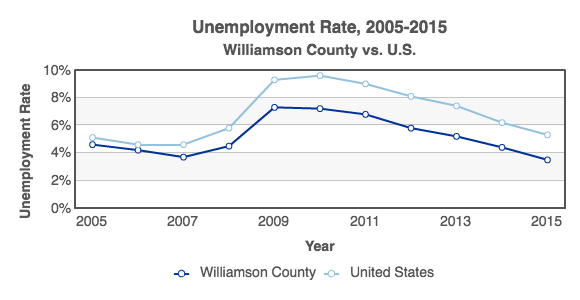
The Williamson County unemployment rate has fallen from its recent high of 7.3% in 2009 to 3.5% in 2015. The county rate has been consistently lower than the U.S. rate.
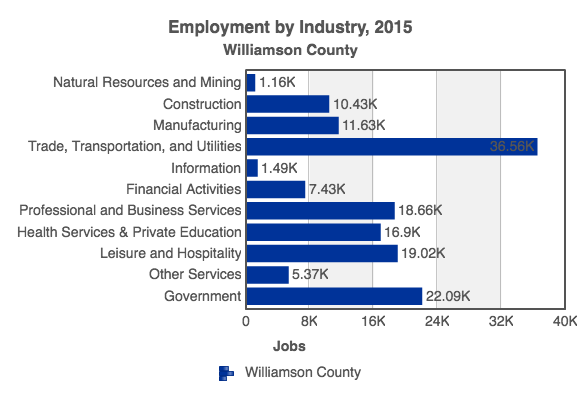
The largest industries in Williamson County are:
• Trade, Transportation, & Utilities – 24% of county employment
• Government – 15%
• Leisure & Hospitality -13%
• Professional & Business Services – 12%
• Health Services – 11%
Employment increased for all Williamson County industries between 2010 and 2015. The average increase was 25%, while the national average employment increase was 9%.

The average salary in Williamson County is 97% of the U.S. average and from 2010-2015 grew 18%, higher than the U.S. growth rate of 13%.
Two industries in the county have average salaries above the U.S. average: Trade, Transportation, and Utilities and Manufacturing. The county's fastest growing salaries are in Manufacturing and Professional and Business Services.
Profile: Demographic Trends
article posted by Headlight on February 7, 2017
The Rural Capital Area (RCA) is a nine county region with a population of 943,000 in central Texas surrounding Austin, the state capital.
The RCA has grown more rapidly than the U.S. for the past decade, growing 41%. The regional population growth rate reached its lowest level in 2012 at 2.4%, still over three times the U.S. rate of growth.
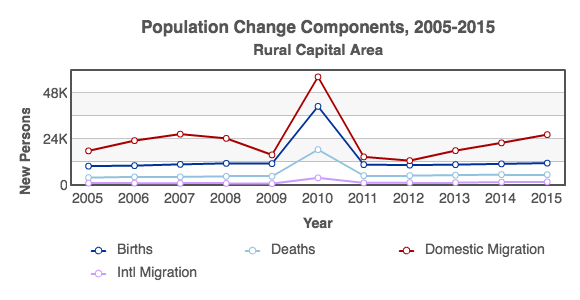
The RCA's population growth has historically been driven by migration of people from across the U.S.: in the last decade, 73% of new population was due to domestic migration. Migration has increased in recent years and outpaces births: in 2015 28,000 people moved to the Rural Capital Area and 11,400 births occurred.
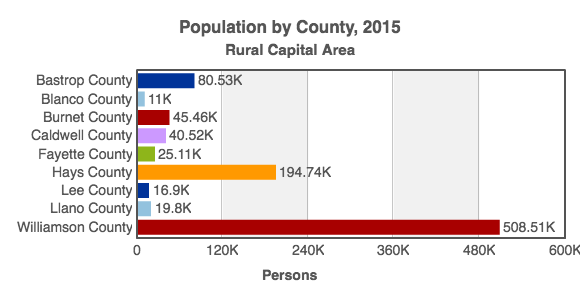
Williamson County is the most populous county in the Rural Capital Area with 54% of residents, followed by Hays County (21%), Bastrop County (9%), Burnet County (5%), and Caldwell County (4%). Population has grown in all regional counties over the past decade, but was highest in Williamson County and Hays County, where the number of residents grew 53% in both counties.

The Rural Capital Area population is spread fairly evenly across age groups and has seen significant growth in the past decade in the youth and middle-aged population. In 2015, 21% of the RCA's population were children under 15 years of age, 21% were youth aged 15 to 29, 21% were aged 30 to 44, and 19% were 45-59. Over the past decade, the 65-69 year age cohort was the fastest growing in the region, increasing 115% as the children and youth populations each grew about half as fast. The slowest relative regional growth was in those aged 0-4.
The Rural Capital Area's population is 60% White, 28% Hispanic, 5% Black, and 4% Asian.
Profile: Hays County
article posted by Headlight on February 7, 2017
Hays County is a populous suburban county in the Austin metropolitan area, with a population of 194,700 people and 60,700 jobs. The county has grown faster than the metro and the U.S.: the population grew 53% from 2005-2015 with the job base growing 48%.
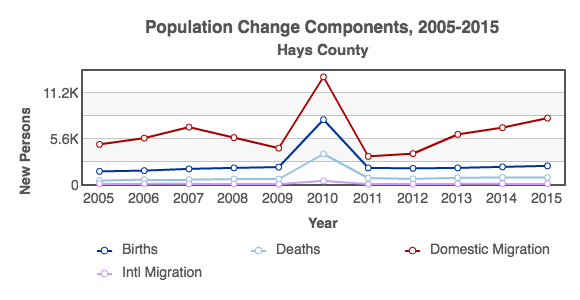
The county's population growth is primarily due to the migration of people into the county. Migration has increased in recent years going from 3,500 people in 2011 to over 8,100 in 2015.
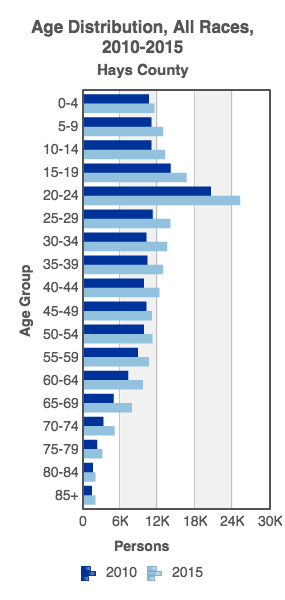
Hays County has a younger population with a high concentration of families and college students. According to the Census, 19% of Hays County's population are children under 15 years of age and 22% of county residents are young adults between the ages of 15 and 24 years old (versus 14% for the U.S.). As a result, the county has lower concentrations of adults between the ages of 45-64 and elderly residents. Of the total population, 90% were born in the United States, with 10% born abroad. Of the foreign-born population, 69% are not naturalized US citizens.
Hays County's population is 55% White, 38% Hispanic, 4% Black, and 1% Asian. The three largest ancestral groups are German, English, and Irish.
According to the Census, Hays County is well-educated: 90% of residents had at least a high school degree and 36% had a Bachelor's degree or higher. These educational attainment statistics are higher than the U.S. average (89% high school, 30% Bachelor's). (American Community Survey, Hays County)
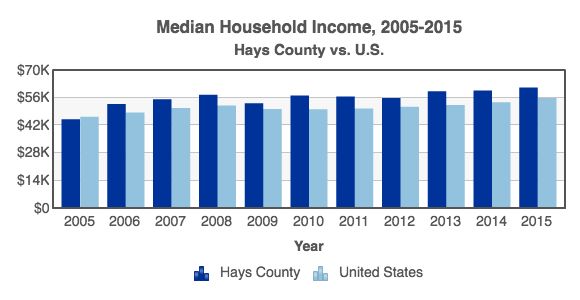
Hays County's median household income has remained above the national average for most of the past decade, and was 110% of U.S. median household income in 2014.
The percent of overall population in poverty in Hays County has fluctuated around the national level for the past decade but was 1% lower than the average in 2015. Between 2005 and 2015, poverty in Hays County rose to a peak of 19% in 2009 and then fell to 14% in 2015.
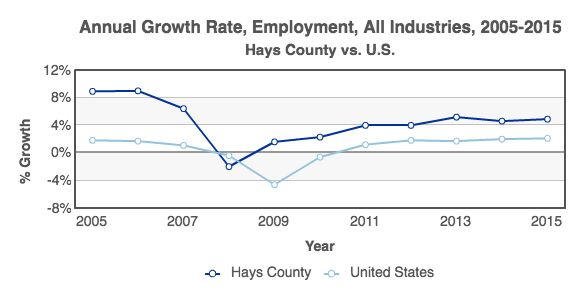
Hays County's economy has performed well over the past decade, creating new jobs every year except 2008. Hays County has weathered the national recession well, only losing 1000 jobs in 2008 and adding over 13,900 from 2009 to 2015.

The Hays County unemployment rate has fallen from its recent high of 7.0% in 2010 to 3.4% in 2015. The county rate has been consistently lower than the U.S. rate.

The largest industries in Hays County are:
• Trade, Transportation, and Utilities – 25% of county employment
• Government– 20%
• Leisure and Hospitality– 14%
• Health Services – 11%
• Professional and Business Services– 8%
Hays County industries have grown 25% on average over the last 5 years, the U.S. grew 9%. Employment has grown over the past 5 years in all Hays County industries except Natural Resources and Mining. Significant growth occurred in Construction (+67%), and Financial Activities (+42%).
Other Hays County industries that have grown significantly in comparison to the U.S. are Professional and Business Services, Health Services and Education, Leisure and Hospitality, Information and and Trade, Transportation and Utilities.
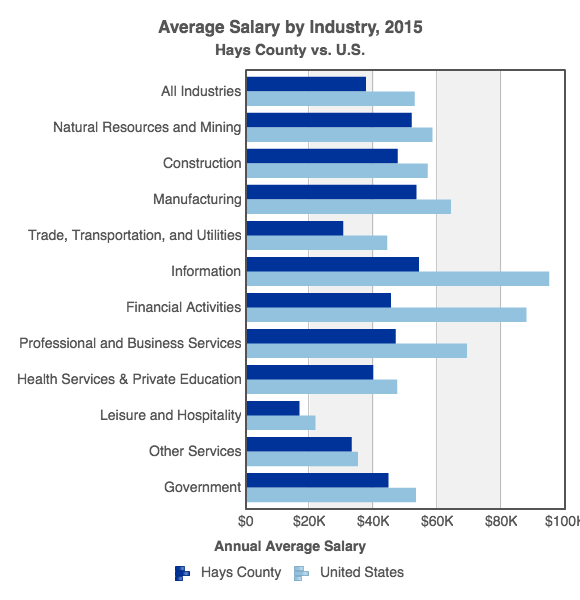
The average salary in Hays County is 71% of the U.S. average and from 2010 – 2015 grew 17%, which was more than the US growth of 13%.
No individual industry in the county had a larger salary than the U.S. average. The county's fastest growing salaries are in Natural Resources and Mining, Other Services, Professional and Business Services.
Profile: Industry Trends
article posted by Headlight on February 7, 2017
The Rural Capital Area employs 273,000 people in a diverse range of industries.
The largest industries in the RCA are:

• Trade, Transportation, & Utilities – 24% of employment
• Government – 17%
• Leisure & Hospitality – 13%
• Health Services – 11%
• Professional & Business Services – 10%
All industry sectors grew in the Rural Capital Area between 2005 and 2015. The fastest growing sectors during this period were Professional and Business Services (+87% growth), Leisure and Hospitality (+70%), and Health Services (+67%). These regional sectors all grew faster than the national rates, which were 17%, 19% and 28% growth respectively.
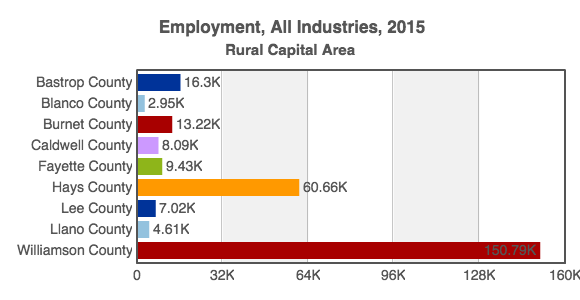
Employment is spread roughly proportional to residency across the Rural Capital Area. Williamson County hosts the greatest number of jobs with 151,000 and 55% of regional employment. The next largest employment counties are Hays County with 22% of regional jobs and Bastrop County with 6%. Employment has grown in all counties between 2005 and 2015, but growth was greatest in Williamson County (50%), Hays County (48%), Bastrop County (35%), and Lee County (35%).
Profile: Rural Capital Area
article posted by Headlight on January 11, 2017
In 2017, nearly all occupation clusters in the Rural Capital Area are projected to experience employment gains. Total employment is forecast to grow 4.3% this year, according to projections from national data provider EMSI. Social Sciences is expected to be the single fastest growing occupation cluster in the region, rising 5.5% in 2017. Engineering, Social Services and Computer & Math are also projected to support strong job growth at 5.4%, 5.4% and 5.3%, respectively. Additional sources of job growth include occupation clusters such as Education (5.2% growth), Legal (5.0%), Health Support (5.0%) and Health Care (5.0%).
 Due to their relatively large size, many slower growing occupation clusters are projected to create the largest number of new jobs within the Rural Capital Area in 2017. Office Administration employment is expected to increase by more than 1,600 jobs this year. Food Preparation & Serving and Sales are also expected to create a significant number of jobs within the Rural Capital Area, at 1,500 and 1,400, respectively. Both Education and Transport & Logistics clusters are projected to create more than 600 jobs each.
Due to their relatively large size, many slower growing occupation clusters are projected to create the largest number of new jobs within the Rural Capital Area in 2017. Office Administration employment is expected to increase by more than 1,600 jobs this year. Food Preparation & Serving and Sales are also expected to create a significant number of jobs within the Rural Capital Area, at 1,500 and 1,400, respectively. Both Education and Transport & Logistics clusters are projected to create more than 600 jobs each.

The Rural Capital Area can expect to see continued broad growth across a diverse set of occupations in 2017. The chart below shows the relative employment base, 5-year growth forecast and location quotient for the large occupation clusters in the region.
All clusters will post strong growth over the next 5 years with Geology (26% growth) and Education (20%) experiencing the highest growth. Occupation clusters with a high concentration (high location quotient) in comparison to the U.S. will also see strong growth. These strong, advancing occupations include; Geology, Construction, Computer and Personal Services.
 Looking at these occupations in more detail we can see that Software Engineers will grow the most at 27%. Home Health Aides (23%), Bus Drivers (23%) and Teacher Assistants (23%) follow.
Looking at these occupations in more detail we can see that Software Engineers will grow the most at 27%. Home Health Aides (23%), Bus Drivers (23%) and Teacher Assistants (23%) follow.

Retail and Food Services are expected to create the most new jobs between 2016 and 2021, with Retail Salespersons (2,200 jobs) at the top of the chart. Food Preparation & Serving (1,600 jobs) and Waiters and Waitresses (1,000 jobs) follow.

This strong growth indicates a bright economic future for the Rural Capital Area over the next five years and beyond.
Profile: Workforce Trends
article posted by Headlight on January 11, 2017
In the early 2000s, unemployment in the Rural Capital Area (RCA) matched national unemployment rates, but since 2007 and through the recession, unemployment in the RCA has remained significantly lower than the U.S. Regional unemployment peaked in 2010 at 7.3%, well below U.S. unemployment of 9.6% in the same year.
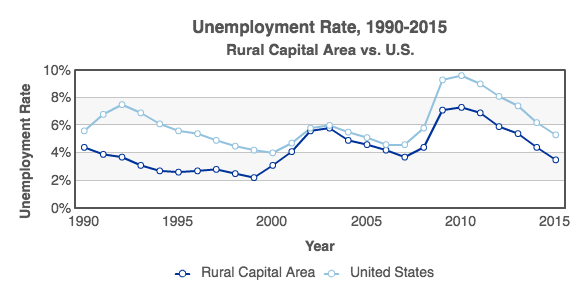
In addition to the existing educated workforce, the Rural Capital Area has a rising number of residents in the workforce pipeline through the community college system. Enrollment in the Austin Community College system grew consistently through 2012 to reach a graduation level of 2,600 students. Student graduation levels fell 5% in 2013 but rose again by 7% in 2014 and 8% in 2015 to reach a peak of 2,900.
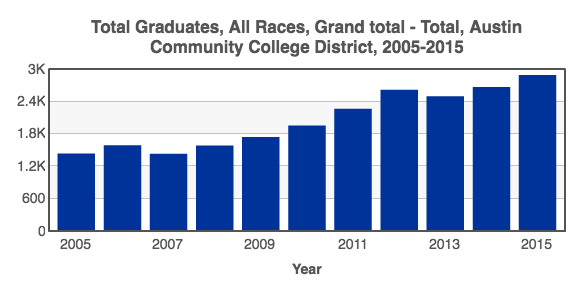
During the same period, enrollment at the University of Texas at Austin dropped from 55,000 in 2005 to 53,000 in 2009. Enrollment levels have rebounded to 55,000 students.
Graduation levels at the University of Texas are at an all-time high. In 2015, UT graduated 15,400 students, about 2,300 more than graduated ten years earlier. As one of the nation's top public schools producing thousands of graduates a year, the University of Texas remains a significant source of educated workers for Austin and the Rural Capital Area.

Where The Jobs Will Be: Rural Capital Area 2017 Industry Edition
article posted by Headlight on January 11, 2017
In 2017, nearly all industry clusters in the Rural Capital Area are projected to experience employment gains. Total employment is forecast to grow 4.3% this year, according to projections from national data provider EMSI. Transport & Logistics is expected to be the single fastest growing industry cluster in the region, rising 7.1% in 2017. Utilities, Educational Services and Manufacturing are also projected to support strong job growth at 6.8%, 6.5% and 6.2%, respectively. Additional sources of job growth include industries such as Professional Services (6.1% growth), Natural Resources (5.4%), and Health Care (5.1%).

Due to their relatively large size, many slower growing industry clusters are projected to create the largest number of new jobs within the Rural Capital Area in 2017. Government employment is expected to increase by more than 2,000 jobs this year. Retail and Food & Lodging are also expected to create a significant number of jobs within the Rural Capital Area, at 1,700 and 1,600, respectively. Both Health Care and Manufacturing clusters are projected to create more than 1,200 jobs each.
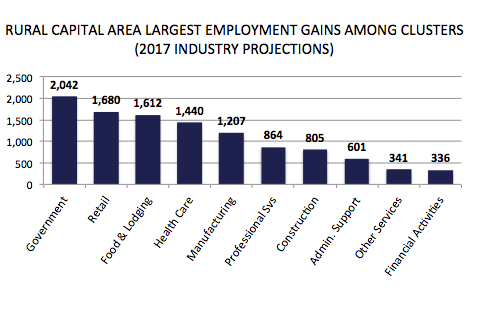
The Rural Capital Area can expect to see continued broad growth across a diverse set of industries in 2017. The chart below shows the relative employment base, 5-year growth forecast and location quotient for the large industry clusters in the region.
All clusters will post strong growth over the next 5 years with Electronics (32% growth) and Research (31%) experiencing the highest growth. Industry clusters with a high concentration (high location quotient) in comparison to the U.S. will also see strong growth. These strong, advancing industries include some of the industries with the most employment in the region; Industrial Machinery, Electronics, Construction and Retail.
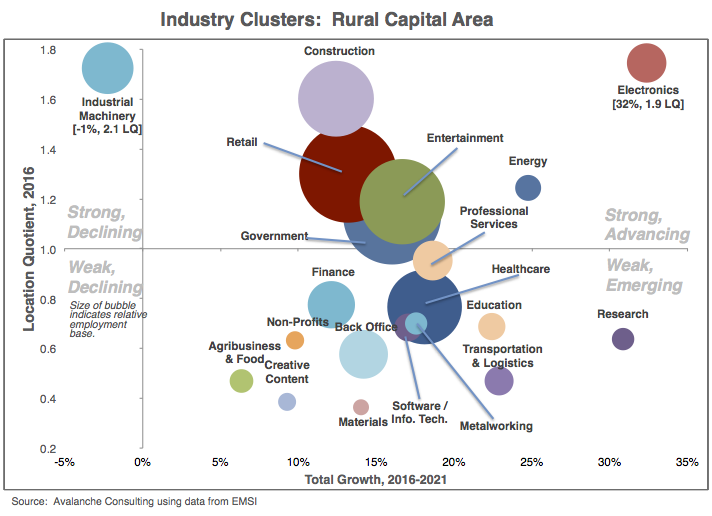
Looking at these industries in more detail we can see that Computer Manufacturing will grow the most at 50%. Mining Support (33%), School Transportation (32%) and Office Administration Services (31%) follow.
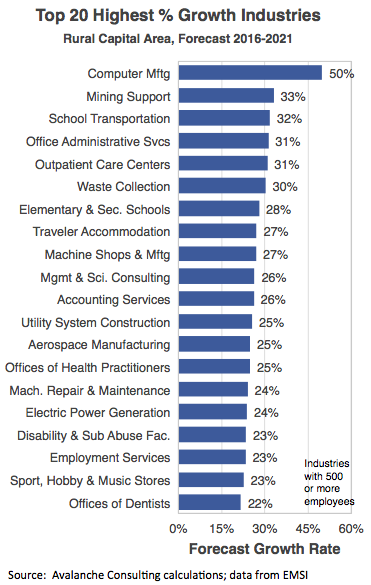
The Local Government is expected to create the most new jobs between 2016 and 2021, with Local Government Schools & Hospitals (4,800 jobs) at the top of the chart. Restaurants (4,500 jobs) and Computer Manufacturing (2,300 jobs) follow.
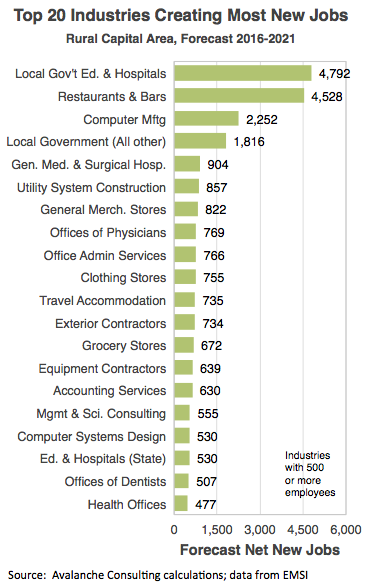
This strong growth indicates a bright economic future for the Rural Capital Area over the next five years and beyond.
Where The Jobs Will Be: Rural Capital Area 2017 Occupation Edition
article posted by Headlight on January 11, 2017
In 2017, nearly all occupation clusters in the Rural Capital Area are projected to experience employment gains. Total employment is forecast to grow 4.3% this year, according to projections from national data provider EMSI. Social Sciences is expected to be the single fastest growing occupation cluster in the region, rising 5.5% in 2017. Engineering, Social Services and Computer & Math are also projected to support strong job growth at 5.4%, 5.4% and 5.3%, respectively. Additional sources of job growth include occupation clusters such as Education (5.2% growth), Legal (5.0%), Health Support (5.0%) and Health Care (5.0%).
 Due to their relatively large size, many slower growing occupation clusters are projected to create the largest number of new jobs within the Rural Capital Area in 2017. Office Administration employment is expected to increase by more than 1,600 jobs this year. Food Preparation & Serving and Sales are also expected to create a significant number of jobs within the Rural Capital Area, at 1,500 and 1,400, respectively. Both Education and Transport & Logistics clusters are projected to create more than 600 jobs each.
Due to their relatively large size, many slower growing occupation clusters are projected to create the largest number of new jobs within the Rural Capital Area in 2017. Office Administration employment is expected to increase by more than 1,600 jobs this year. Food Preparation & Serving and Sales are also expected to create a significant number of jobs within the Rural Capital Area, at 1,500 and 1,400, respectively. Both Education and Transport & Logistics clusters are projected to create more than 600 jobs each.

The Rural Capital Area can expect to see continued broad growth across a diverse set of occupations in 2017. The chart below shows the relative employment base, 5-year growth forecast and location quotient for the large occupation clusters in the region.
All clusters will post strong growth over the next 5 years with Geology (26% growth) and Education (20%) experiencing the highest growth. Occupation clusters with a high concentration (high location quotient) in comparison to the U.S. will also see strong growth. These strong, advancing occupations include; Geology, Construction, Computer and Personal Services.
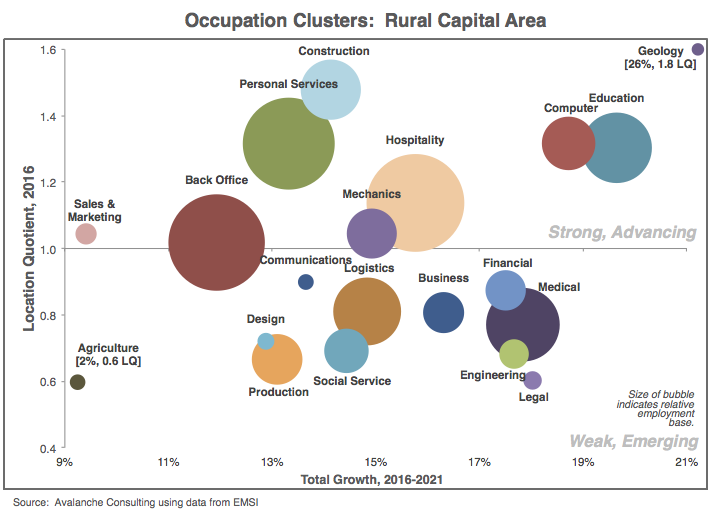 Looking at these occupations in more detail we can see that Software Engineers will grow the most at 27%. Home Health Aides (23%), Bus Drivers (23%) and Teacher Assistants (23%) follow.
Looking at these occupations in more detail we can see that Software Engineers will grow the most at 27%. Home Health Aides (23%), Bus Drivers (23%) and Teacher Assistants (23%) follow.
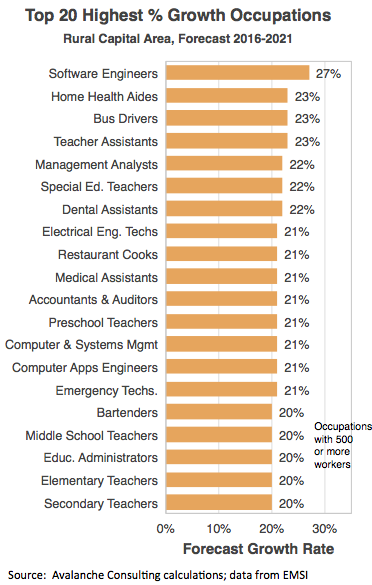
Retail and Food Services are expected to create the most new jobs between 2016 and 2021, with Retail Salespersons (2,200 jobs) at the top of the chart. Food Preparation & Serving (1,600 jobs) and Waiters and Waitresses (1,000 jobs) follow.
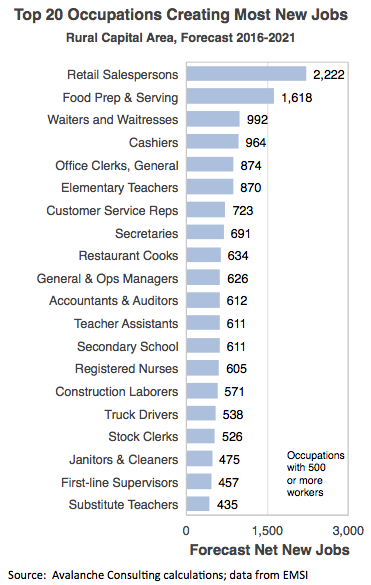
This strong growth indicates a bright economic future for the Rural Capital Area over the next five years and beyond.
The State of American Jobs
article posted by Headlight on November 16, 2016
The following article was written by Pew Research Center & The Markle Foundation.
Click here to read the article on the Workforce Solutions website.
A changing economic landscape is driving significant shifts in the American workplace. Employment opportunities increasingly lie in jobs requiring higher-level social or analytical skills, while physical or manual skills are fading in importance, according to a new Pew Research Center report issued in association with the Markle Foundation.
Not coincidentally, an analysis of government jobs data finds that employment is rising faster in jobs calling for greater preparation. The number of workers in occupations requiring average to above-average education, training and experience increased 68% from 1980 to 2015. This was more than double the 31% increase in employment in jobs requiring below-average education, training and experience.
For their part, the vast majority of U.S. workers say that new skills and training may hold the key to their future job success. New survey data find that 54% of adults in the labor force say it will be essential for them to get training and develop new skills throughout their work life in order to keep up with changes in the workplace, and another 33% say it will be important to do so. Workers are acting on this belief, with 45% saying they've taken a class or received training in the past year to learn, maintain or improve their work skills.
Americans believe the responsibility for preparing and succeeding in today's workforce starts with individuals themselves. Roughly seven-in-ten (72%) say that individuals have “a lot†of responsibility to make sure workers have the right skills and education to be successful, while 60% believe public K-12 schools should bear a lot of responsibility for this. Smaller shares say colleges and universities (52%), employers (49%), state governments (40%) and the federal government (35%) should have a lot of responsibility.
A majority of Americans (65%) say that good jobs are difficult to find where they live, but views of the situation have improved since the height of the Great Recession. However, on the whole, American workers are generally satisfied with their own jobs: 49% of American workers say they are very satisfied with their current job, while three-in-ten are somewhat satisfied. And most Americans overall feel their own jobs are secure; 60% of employed Americans say it is not at all likely that they will lose their job or be laid off in the next 12 months.
The earnings of workers overall have stagnated since 1980, lagging behind gains in labor productivity. Moreover, smaller shares of workers received health or retirement benefits from their employers in 2015 than did in 1980. More recently, alternative employment arrangements, such as contract work, on-call work and temporary help agencies, appear to be on the rise.
As they look at the future, large numbers of Americans believe the demands on workers will intensify and job security will diminish in the coming 20 to 30 years. Roughly seven-in-ten Americans (71%) say that workers will have to improve their skills more often in the future in order to keep up with job-related developments. About half (51%) think there will be less job security in 20 to 30 years, and a plurality (44%) believes employee benefits will not be as good in the future. When it comes to worker loyalty, 43% say employees will show less loyalty to their employers in the future, while an identical share believe the current levels of loyalty will prevail.
The new report, based on an analysis of Department of Labor and Current Population Survey data and a national survey conducted May 25-June 29, 2016, among 5,006 adults (including 3,096 employed adults), examines trends in the labor market and how they are playing out in the lives of American workers.
Among the findings:
• Americans see outsourcing jobs and imports of foreign goods as the greatest harms to U.S. workers, but they believe exporting more U.S. products abroad helps U.S. workers. As they assess the factors that may be hurting U.S. workers, 80% say outsourcing hurts American workers, and 77% say the same about more foreign-made products being sold in the U.S. Many also cite the increased use of contract and temporary workers (57%) and the decline of union membership (49%) as harmful factors. The impact of immigrants and automation draw more evenly divided verdicts. On the other end of the spectrum, majorities think exports of U.S.-made products (68%) and work-enhancing technology such as the internet and email (70%) help U.S. workers.
• Americans are less worried about immigrants' impact on jobs than they were a decade ago. Today, 45% of adults say that the growing number of immigrants working in the U.S. hurts workers, and 42% say having more immigrants helps workers. This is a noteworthy change from 2006, when there was a nearly two-to-one view that the growing number of immigrants hurts U.S. workers (55% vs. 28% who said immigrants help workers). Democrats, blacks and those with less than a high school diploma are all notably more likely now than in 2006 to think the growing number of immigrants helps workers.
• The shifting demand for skills in the modern workplace may be working to the benefit of women. Women, who represent 47% of the overall workforce, make up the majority of workers in jobs where social or analytical skills are relatively more important. Wages are rising much faster in those jobs, which has likely contributed to the shrinking of the gender pay gap from 1980 to 2015.
• People have been staying at their jobs longer in recent years. In 2014, about half of workers (51%) had worked for their current employer five years or more, compared with 46% of workers in 1996.
• Educational attainment is a clear and consistent marker when it comes to feelings about job security and future prospects. While 39% of those without a high school education say it is very or fairly likely they may be laid off in the next 12 months, only 7% of those with a bachelor's degree or more say the same. Those with lower levels of education also are more likely to feel their current skills are insufficient for career advancement and to think there are not good jobs locally.
• Americans have somewhat mixed attitudes about the effectiveness of traditional higher education institutions. While many college graduates describe their own experience as having a positive impact on their personal and professional development, just 16% of all Americans think that a four-year degree prepares students “very well†for a well-paying job in today's economy. An additional 51% say this type of degree prepares students “somewhat well†for the workplace.
You can read the report online at https://www.markle.org/stateofamericanjobs or http://www.pewsocialtrends.org/2016/10/06/the-state-of-american-jobs.
###
Pew Research Center is a nonpartisan fact tank that informs the public about the issues, attitudes and trends shaping America and the world. It does not take policy positions. The Center is a subsidiary of The Pew Charitable Trusts, its primary funder. Subscribe to the Center's daily and weekly email newsletters or follow its Fact Tank blog.
The Markle Foundation works to realize the potential of information technology as a breakthrough tool for some of the nation's most challenging problems. It leads a broad collaboration to Rework America to create good jobs and prepare people for today's rapidly changing digital economy. Markle's Skillful initiative is returning economic opportunities to Americans without a college diploma. For more information, visit markle.org, skillful.com and follow @MarkleFdn on Twitter.
Census' American Community Survey Reveals 2015 Educational Attainment Levels for Some RCA Counties; Williamson, Hays Exceed US Average
article posted by Headlight on November 16, 2016
The 2015 American Community Survey recently reported the distribution of educational attainment of the adult population (25+ years) in the larger Rural Capital Area counties: Bastrop, Hays and Williamson.
Williamson County has the highest educational attainment, with 93% of adults having graduated from high school, followed by Hays County (90%) and Bastrop County (81%). By comparison, the US high school attainment rate is 87% and the Austin metro is 89%.
Williamson County also leads educational attainment at the Bachelor's level. 40% of Williamson County's adult population has a Bachelor's degree or higher, followed by Hays (36%) and Bastrop (19%). The Bachelor's attainment rate is 31% in the US and 43% in the Austin metro.
Trends point to an overall increase in educational attainment last year. Bastrop's high school attainment rate grew 3 percentage points, Hays grew 2 points, and Williamson County remained the same. Improvements for the metro and US were marginal.
Bachelor's attainment levels fell slightly in Bastrop and increased slightly in Hays and Williamson. Attainment improved the most in Bastrop at the post-Bachelor's level, growing 4 percentage points to reach 8% of adults. Hays remained on par with the US average for Graduate attainment (11.5%) and Williamson and the metro reached 14% and 15% respectively.

Unemployment Rates in Bastrop, Hays, Williamson Counties are Lower for Better-Educated Residents
article posted by Headlight on November 16, 2016
Recently released data from the U.S. Census Bureau's 2015 American Community Survey reports the unemployment rate by education level for workers in large counties in the Rural Capital Area.
In Bastrop County, 5% of residents with a high school education are unemployed. The number drops to 1% for residents with a bachelor's degree or higher. Unemployment has decreased since 2014 when 5% of those with a bachelor's degree were unemployed (see table below).
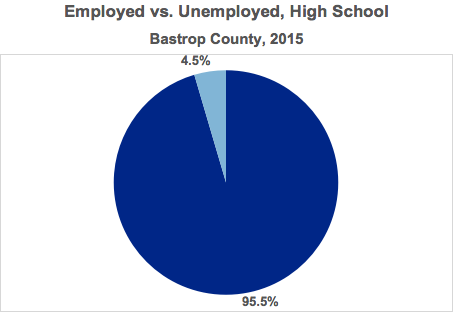

In Hays County, the unemployment rate is slightly higher for those with a high school diploma versus a Bachelor's+ degree (3.3% vs. 2.5%). Unemployment was also higher in 2014 (4% vs. 5% for high school graduates vs. Bachelor's+ holders).
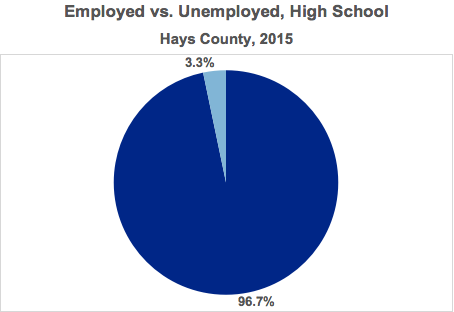
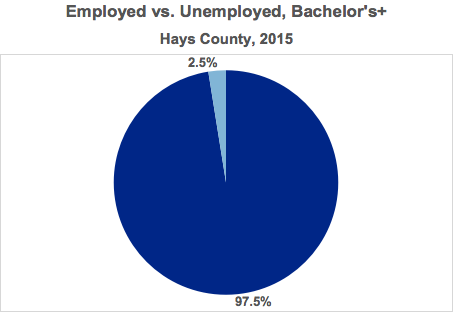
Williamson County has a 5% unemployment rate for high school graduates versus a 3% unemployment rate for Bachelor's+. Unlike Bastrop and Hays, the unemployment rate in Williamson rose slightly last year for these two groups. In 2014, 2% of high school graduates were unemployed and 3% of Bachelor's+ graduates were unemployed.
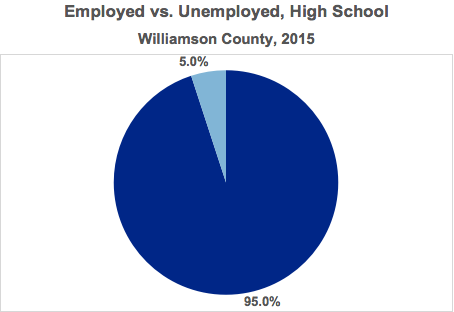

The table below provides a comparison of the unemployment rates for the three large RCA counties, the Austin metro and the U.S. in 2014 and 2015.
Bastrop and Hays counties have lower 2015 unemployment rates than the Austin metro for both high school graduates and those with a college degree.
The Rural Capital Area counties are below the national average for 2015 in all cases with the exception of Bachelor's+ holders in Williamson County. This group has 3.4% unemployment rate compared with the national average of 2.9%.

Texas Economy Adds 38,300 Jobs in September
article posted by Headlight on November 16, 2016
The following article was written by the Texas Workforce Commission.
Click here to read the article on the Workforce Solutions website.
AUSTIN ⎯ Texas grew by an estimated 38,300 nonfarm jobs in September. The state has added jobs in 17 of the last 18 months. Texas' seasonally adjusted unemployment rate increased to 4.8 percent in September, up slightly from 4.7 percent in August, and remained below the national rate of 5.0 percent.
“Texas employers continue demonstrating their competitiveness by adding 38,300 jobs in September, for a total of 206,800 jobs added over the year,†said TWC Chairman Andres Alcantar. “This continued growth in a diverse range of industries creates valuable opportunities for our state's world-class workforce and builds on Texas' continued success as a global economic leader.â€
The Leisure and Hospitality industry recorded the largest industry employment gain over the month with 17,900 jobs added. Professional and Business services employment grew by 6,000 jobs in September. Construction employment expanded for the third consecutive month with the addition of 3,400 jobs.
“Private-sector employment was strong over the year with the overall job growth of 162,600 and 31,600 jobs added in September,†said TWC Commissioner Representing Employers Ruth R. Hughs. “Texas is a state that continues to welcome new employers and work with our homegrown businesses, offering them the tools they need to grow and succeed.â€
The Amarillo and Austin-Round Rock Metropolitan Statistical Areas (MSA) recorded the month's lowest unemployment rate among Texas MSAs with a non-seasonally adjusted rate of 3.5 percent, followed by the Lubbock MSA with a rate of 3.6 percent and the College Station-Bryan MSA with a rate of 3.7 for September.
“Our economy continues to offer many diverse opportunities to job seekers†said TWC Commissioner Representing Labor Julian Alvarez. “I encourage those seeking these opportunities to take advantage of the workforce services available through their local Workforce Solutions office for help finding the job that's right for them.â€
An audio download with comments from Chairman Alcantar with the latest labor market data is available on the TWC website press release page. Employment estimates released by TWC are produced in cooperation with the U.S. Department of Labor's Bureau of Labor Statistics. All estimates are subject to revision. To access this and more employment data, visit tracer2.com.
###
The Texas Workforce Commission is a state agency dedicated to helping Texas employers, workers and communities prosper economically. For details on TWC and the services it offers in coordination with its network of local workforce development boards, call 512-463-8942 or visit www.texasworkforce.org. To receive notifications about TWC programs and services subscribe to our email updates.
New 2015 American Community Survey Data Released for Some Rural Capital Area Counties
article posted by Headlight on October 10, 2016
The Rural Capital Area's most populated counties have 2015 estimates available now from the US Census Bureau. Some key findings include:
- Bastrop County saw the biggest percentage decrease in its share of Millennials aged 25-34 years. The Austin metro still has a higher percentage of Millennials than the RCA counties.
- Bastrop, Hays and Williamson counties all saw a decrease in Millennials and an increase in the retiree population (65+ years) as a percent of total. This trend was reflected in the metro also.
- Despite an increase from 2014, Hays County has the lowest median age (31.5 years).

- Median household incomes increased in Bastrop County, Williamson County and the Austin metro, but incomes decreased slightly in Hays County.
- Hays County has the lowest unemployment rate (4.2%), down 3 percentage points from 2014.
- Williamson County has the highest median household income ($78,000).

- The percentage of the 25+ years population with an associate's degree decreased from 2014 to 2015 for Bastrop and Hays counties, but rose for Williamson County and the Austin metro.
- The share of people with bachelor's degrees fell in Bastrop County, but increased in Hays County, Williamson County and the Austin metro.
- The share of people with bachelor's degrees in Bastrop County is 17 percentage points lower than in the Austin metro - a wider margin than in 2014.

Click to access the new American Community Survey profiles for
Bastrop County,
Hays County,
Williamson County and the
Austin Metro.
Poverty Rates Fall Dramatically in the Rural Capital Area in 2015; Poverty Rates Are Lowest in Williamson and Fayette Counties, Highest in Hays County
article posted by Headlight on October 10, 2016
The American Community Survey just released its 2015 poverty rate estimates for the larger Rural Capital Area counties – the most recent estimates of poverty available.
Bastrop, Hays and Williamson County all saw poverty rates decrease significantly from 2014 to 2015. Bastrop fell to 8% from 14%; Hays fell to 15% from 22%; and Williamson fell to 7% from 8%. The Austin metro fell to 12% from 15%.
By comparison, the US poverty rate fell to 14.7% in 2015 from 15.5% the previous year.
Comparative data for all counties is available through 2014 from a different statistical survey, the US Census Bureau's Small Area Income & Poverty (SAIPE) program. The Rural Capital Area counties with the highest poverty rate in 2014 were Hays (18%), Caldwell (16%) and Llano (15%). The lowest poverty rates are found in Williamson (8%), Blanco (12%) and Lee (13%).
Poverty in the Rural Capital Area rose 0.8 percentage points from 2009-2014 while the national poverty rate rose 1.2 percentage points. The US rate has shown a slight decline since 2012 while the Rural Capital Area poverty rate has held constant in recent years. Trend data on poverty rates in the Rural Capital Area can be found here.

More information on how these two statistical surveys differ in their methodologies can be found here.
The Future is Bright in Career and Technical Education
article posted by Headlight on October 10, 2016
The following article was written by Representative John R. Carter for Workforce Solutions Rural Capital Area.
Click here to read the article on the Workforce Solutions website.
As Texas students tackle their first weeks of school, we are reminded that today's graduates are increasingly facing a future of unemployment, declining wages, and mounds of student loan debt. Recent graduates from traditional four year universities continue to find their employment options limited; yet, just this month, the Bureau of Labor Statistics reported 5.6 million job openings in America. This staggering number is a direct reflection of the skills gap that exists between the American workforce and the needs of many employers.
This lack in skilled workers is largely due to an underlying stigma surrounding Career and Technical Education (CTE). The academic goals of many students and educators fail to align with the needs of businesses looking to hire skilled workers for high-paying, fulfilling careers.
To put our Nation on a path of expanded economic growth, we must back away from the traditional “college for all†mindset. While many thrive in a four year university atmosphere, the reality is that college is not for everyone, and many students' career goals are best achieved with an associate's degree or a certificate in a skilled trade. As four year colleges and universities continue to veer further away from accessibility and affordability, the CTE route offers affordable, practical training designed to prepare students for a rewarding career.
Unfortunately, CTE has been unfairly branded as a disappointing alternative to a college degree, or reserved as a last resort for underprivileged students. Yet with rapid technological advancements and high employer demand, CTE has become more than just a backup plan – it is a path to a fulfilling and prosperous career. With jobs ranging from biotechnology to cybersecurity, and from culinary arts to robotics, CTE meets a variety of diverse interests.
It is time we as a nation reassess our educational priorities and work to reverse the stigma surrounding CTE. When asked about plans after high school, students should be filled with just as much pride when announcing they have chosen to attend the local trade school as if they were to answer with plans to enroll at Texas Tech or Harvard.
In order to bridge the gap between our workforce and employers, I believe promoting CTE and the many opportunities it presents should begin at the local level. This is why I hosted a roundtable discussion at the East Williamson County Higher Education Center in Hutto. Texas educators, local business owners, professional associations, and state policymakers met to brainstorm ways to best ensure students receive an education that will provide them with the skillset necessary to meet employers' needs.
When it comes to CTE, the discussion has just begun and the opportunities are expansive. Texas is a national leader for job opportunity and economic growth. In order to maintain this high standard, our talent pool must continue to meet the needs of our businesses and industries. Jobs in CTE are readily available, and our community must encourage students to pursue high-paying careers in technology, mechanics, and other highly skilled trades. I have confidence Texans will continue to lead the way in growing our economy, and CTE is a key to our economic prosperity.
Texas Economy Adds 21,400 Jobs in August
article posted by Headlight on October 10, 2016
The following articles was written by the Texas Workforce Commission.
Click here to read the article on the Workforce Solutions website.
AUSTIN ⎯ Texas grew by an estimated 21,400 nonfarm jobs in August. The state has added jobs in 16 of the last 17 months. Texas' seasonally adjusted unemployment rate increased to 4.7 percent in August, up slightly from 4.6 percent in July, and remained below the national rate of 4.9 percent.
“Texas employers added 190,600 jobs over the past year, with the diversity of our economy highlighted by nine out of eleven industries adding jobs,†said Texas Workforce Commission Chairman Andres Alcantar. “TWC will continue to build partnerships that provide workers with in-demand skills to boost job creation.â€
The Financial Activities industry recorded the largest industry employment gain over the month with 6,200 jobs added. Trade, Transportation and Utilities employment added 4,000 jobs in August. Construction employment expanded for the second consecutive month with the addition of 1,300 jobs.
“Private-sector employment was strong over the year with the overall job growth of 150,900 and 18,500 jobs added in August,†said TWC Commissioner Representing Employers Ruth R. Hughs. “The fact that our state has added jobs for 16 of the last 17 months is a credit to the diversity and resilience of employers in Texas.â€
The Amarillo Metropolitan Statistical Area (MSA) recorded the lowest unemployment rate for August with a 3.4 percent rate for the month. The Austin-Round Rock MSA had the second-lowest rate at 3.5 percent followed by the Lubbock MSA with a rate of 3.8 percent.
“Texas workers have much to offer and there are resources available to help them find the perfect occupational fit, I encourage all job seekers to contact their local Workforce Solutions office for assistance with job training and placement,†said TWC Commissioner Representing Labor Julian Alvarez.
Audio downloads with comments from Commissioner Hughs on the latest labor market data are available on the TWC website press release page. Employment estimates released by TWC are produced in cooperation with the U.S. Department of Labor's Bureau of Labor Statistics. All estimates are subject to revision. To access this and more employment data, visit tracer2.com.
Highest Salary in the Rural Capital Area is in Williamson County; Llano County Reports Strongest Salary Growth
article posted by Headlight on August 10, 2016
Recently released data from the U.S. Bureau of Labor Statistics reports average salaries and growth for the Rural Capital Area. The 2015 average salary for the RCA was $45,000 compared with a national average of $53,000.
Williamson County had the highest average salary ($51,000) followed by Lee County ($46,000), Blanco County ($40,000) and Burnet County ($39,000).
Salaries were lowest in Llano County ($34,000) and Bastrop County ($36,000).

Salaries rose 1.9% in the Rural Capital Area from 2014 to 2015, compared with 3.1% growth nationally. The highest growth was reported in Llano County where wages rose 4.0%.
Hays County (3.4%), Bastrop County (2.7%) and Williamson County (2.0%) also experienced above average growth.
Wage levels declined in Lee County (-3.4%), Fayette County (-2.3%) and Burnet County (-0.1%).
Visit RuralCapitalCareers.com for the latest Career Information from Workforce Solutions–Rural Capital Area
article posted by Headlight on August 10, 2016
RuralCapitalCareers.com is the new career planning website for Central Texas. It provides 24/7-access to career information for students, parents, career counselors and adult workers seeking new careers. Users can identify careers in our service area, the skills required for those careers, and the available college and training programs for each career. An Interests Survey matches careers to users' abilities, desired work tasks, and planned educational attainment level. Employment data and forecasts show job demand by county and region.
Visit http://ruralcapitalcareers.com/ and create your FREE account!
Highest Salaries in the Rural Capital Area are in Manufacturing; Salaries in the Information Industry Grow the Most
article posted by Headlight on August 10, 2016
In 2015, the average salary in the Rural Capital Area was $45,000 compared with a national average of $53,000.
The Rural Capital Area industry with the highest average salary was Manufacturing, where the 2015 average salary was $85,000. The U.S. average for manufacturing was $64,000. (A note of caution: Some of Dell's employment in Round Rock is classified as manufacturing.)
Financial Activities ($60,000), Professional & Business Services ($56,000) and Information ($56,000) also had high average salaries in 2015.
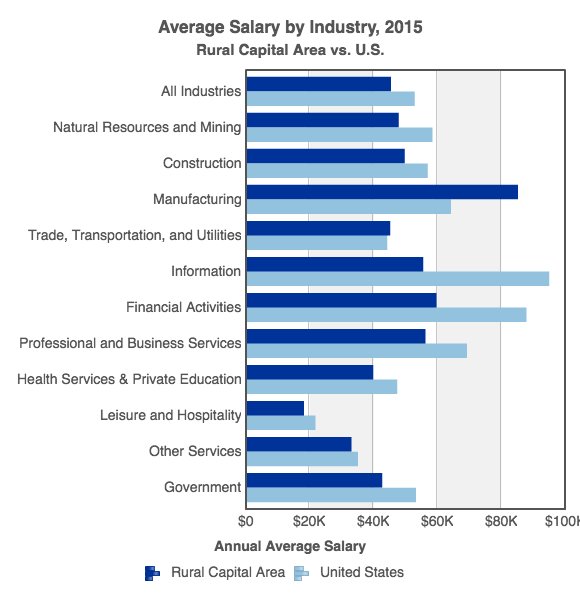
From 2014 to 2015, Rural Capital Area salaries grew 1.9%. The industry with the highest growth was Information where salaries rose 12.3% compared with 4.6% nationally.
Financial Activities (5.5%), Professional & Business Services (4.9%) and Manufacturing (3.2%) also reported higher salary growth than the national average.
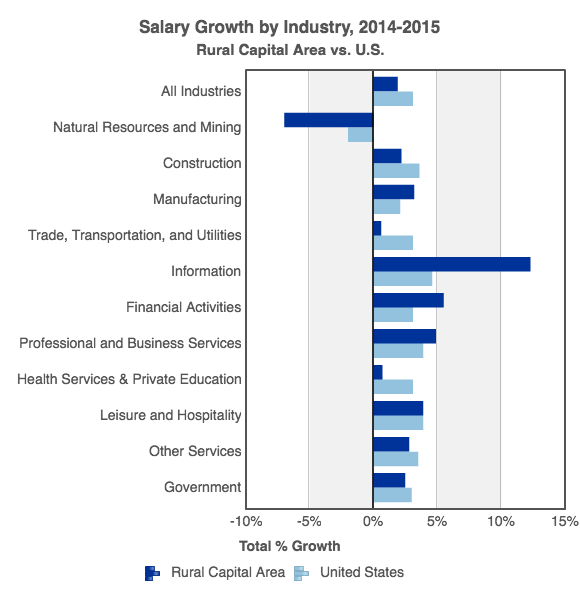
Texas Economy Adds 7,200 Jobs in June
article posted by Headlight on August 10, 2016
Source: Texas Workforce Commission
Click here to see the original article.
Austin, Texas has added an estimated 171,100 seasonally adjusted jobs over the past year with the addition of 7,200 nonfarm jobs in June. The state has added jobs in 14 of the last 15 months. Texas' seasonally adjusted unemployment rate increased to 4.5 percent in June, up slightly from 4.4 percent in May, and remained below the national average of 4.9 percent.
“I am encouraged by our state's continued job growth, with Texas employers adding jobs in nine of 11 industries over the past year,†said Texas Workforce Commissioner (TWC) Chairman Andres Alcantar. “Texas Workforce Solutions is committed to advancing partnerships and providing innovative solutions to our employers and workforce to keep our state the best place to work and do business.â€
The Leisure and Hospitality industry added 5,200 jobs in June. Over the year, Leisure and Hospitality gained 53,800 jobs. Trade, Transportation, and Utilities employment added 3,900 jobs in June. Manufacturing employment expanded by 1,000 jobs in June.
“Texas' economic growth over the year is due to the resilience of our employers who have added 123,000 private-sector jobs over the past year,†said TWC Commissioner Representing Employers Ruth R. Hughs. “The evolution of services provided by the Texas Workforce Solutions network over the past twenty years has played a critical role in job creation and the economic prosperity of our state and we can take pride in all that this agency and our Workforce Solutions partners have accomplished.â€
The Amarillo and Austin-Round Rock Metropolitan Statistical Areas (MSA) recorded the month's lowest unemployment rate among Texas MSAs with a non-seasonally adjusted rate of 3.3 percent, followed by the Sherman-Denison and Lubbock MSAs each with rates of 3.9 percent in June.
“The Texas labor force has much to offer and there are resources available to find the perfect occupational fit,†said TWC Commissioner Representing Labor Julian Alvarez. “I encourage all job seekers to contact their local Workforce Solutions office for assistance with job training and placement.â€
Audio downloads with comments from Commissioner Hughs on the latest labor market data are available on the TWC website press release page. Employment estimates released by TWC are produced in cooperation with the U.S. Department of Labor's Bureau of Labor Statistics. All estimates are subject to revision. To access this and more employment data, visit tracer2.com.
Bastrop County Leads Job Growth in the Rural Capital Area in 2015, Hays County and Llano County Follow.
article posted by Headlight on June 30, 2016
According to recently released data from the Bureau of Labor Statistics, the Rural Capital Area's employment base grew 3.6% in 2015, creating 9,500 new jobs.

Within the Rural Capital Area, most new jobs were created in Williamson County (5,700 new jobs), followed by Hays County (2,800 new jobs). On a percentage basis, job growth was highest in Bastrop County (5.0%), Hays County (4.9%) and Llano County (4.8%).

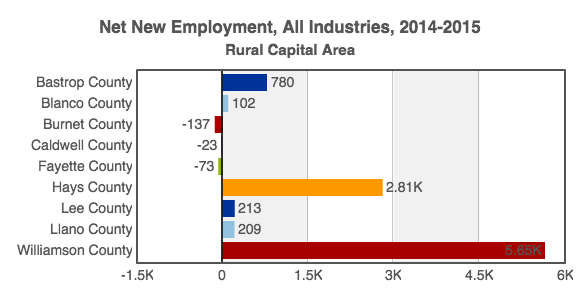
Education & Health Services Lead Growth in 2015 in the Rural Capital Area
article posted by Headlight on June 30, 2016
According to recently released data from the Bureau of Labor Statistics, Education & Health Services lead growth in the Rural Capital Area last year. The Construction and Professional & Business Services Industries followed.
Education & Health Services grew fastest in Hays, Llano and Williamson counties. Construction led growth in Bastrop County, while Leisure & Hospitality grew fastest in Caldwell and Fayette counties. Information led growth in Blanco County, Natural Resources & Mining led growth in Burnet County, and Government led growth in Lee County.
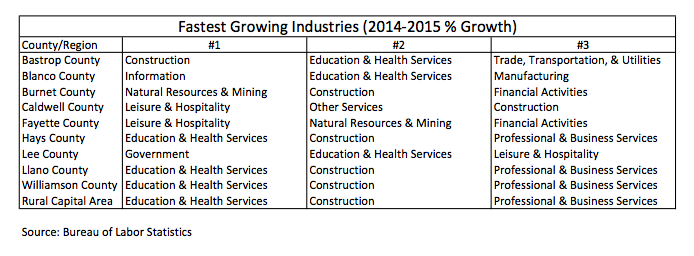
In terms of the new jobs created, Education & Health Services created the most jobs in the Rural Capital Area overall and in Blanco, Hays and Lee counties individually. Trade, Transportation & Utilities created the most new jobs in Bastrop County, while Construction led in Burnet and Llano counties. Leisure & Hospitality created the most jobs in Caldwell and Fayette counties. Professional & Business Services led job creation in Williamson County.

RuralCapitalCareers.com is the New Career Planning Website for Central Texas from Workforce Solutions - Rural Capital Area
article posted by Headlight on June 1, 2016
Workforce Solutions – Rural Capital Area proudly announces a one-of-a-kind career planning website for the Rural Capital Area and Central Texas:
http://www.RuralCapitalCareers.com
This website provides 24/7-access to career information for students, parents, career counselors and adult workers seeking new careers. It helps users identify careers in our service area, the skills required for those careers, and the available college and training programs for each career. An Interests Survey matches careers to users' abilities, desired work tasks, and planned educational attainment level. Employment data and forecasts show job demand by county and region.
Empowering Visualizations
Learn about careers that are available in the Rural Capital Area, pay well, and are a good fit for you and your life goals.
See career information in visual, interactive, and easy-to-understand dashboards.
Easy to Use
Browse careers that match your interests and save your favorite careers.
Find out which of your favorites will grow fastest, pay the most, or get the best ROI on your education investment.
Find the right education programs for you at institutions in the Rural Capital Area and large institutions in Travis County.
Tailor Made
Take our 20-question personality quiz to quickly learn which careers match your interests and education goals.
No other tool makes career planning so quick, easy, and meaningful.
Sign Up Today!
Please visit
http://www.RuralCapitalCareers.com and create an account. If you run into problems getting started, please contact Chris Engle at help@headlightdata.com
3,200 Households Relocated within the Rural Capital Area in 2014; Burnet County has Highest Net Household Gain within Region
article posted by Headlight on June 1, 2016
In 2014, 3,200 households (tax returns) moved from one county to another county within the Rural Capital Area. The three counties that received the most households were Williamson County (790 households), Hays County (780) and Burnet County (440). The three counties that lost the most households were Williamson County (930), Hays County (780) and Caldwell County (400).

In terms of net migration (in- less out-), Burnet County gained the most new households (48), followed by Blanco County (45) and Bastrop County (40). Williamson County lost a net of 140 households to other counties in the Rural Capital Area.
In addition to Williamson County, Caldwell and Hays counties lost more households than they gained. The rest of the counties saw positive net migration from within the Rural Capital Area.
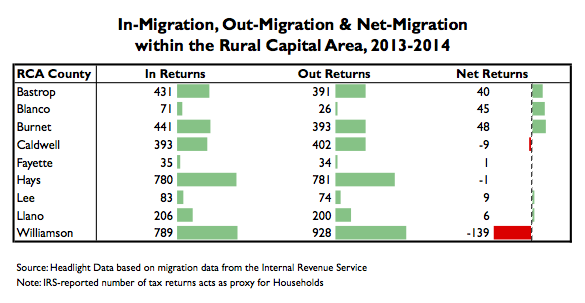
Most Newcomers to the Rural Capital Area are from Travis County and other Texas Counties; California, Illinois Counties also Make Top 10
article posted by Headlight on June 1, 2016
Recently released data from the Internal Revenue Service reports which counties outside of the Rural Capital Area account for the highest number of household relocations to the region.
The IRS-reported number of tax returns acts as a proxy for households.
Most of the households moving to the Rural Capital Area are from Travis County (3,800 households). Harris County-TX (170 households), San Diego County-CA (150) and Los Angeles County-CA (140) follow.

The most popular destinations for households moving out of the Rural Capital Area are Comal County-TX (-150 households), Milan County-TX (-40), Wake County-NC (-30) and Guadalupe County-TX (-30).

Revolutionary New Career Planning Website Launches Today: RuralCapitalCareers.com
article posted by Headlight on May 5, 2016
Workforce Solutions – Rural Capital Area proudly announces a one-of-a-kind career planning website for the Rural Capital Area and Central Texas:
http://www.RuralCapitalCareers.com
This website provides 24/7-access to career information for students, parents, career counselors and adult workers seeking new careers. It helps users identify careers in our service area, the skills required for those careers, and the available college and training programs for each career. An Interests Survey matches careers to users' abilities, desired work tasks, and planned educational attainment level. Employment data and forecasts show job demand by county and region.
Please visit http://www.RuralCapitalCareers.com and create an account. If you run into problems getting started, please contact Chris Engle at help@headlightdata.com
We are offering a 30-minute training session next week at Wednesday, May 11 from 10:30-11:00. To participate, log into GoToMeeting 5-10 minutes before we start:
Career Headlight Demo and Q&A: Put us in your calendar!
May 11, 2016 at 10:30-11:00 AM central
https://global.gotomeeting.com/join/114927733
Dial +1 (224) 501-3312
Access Code: 114-927-733
Audio PIN: Shown after joining the meeting
Meeting ID: 114-927-733

Rural Capital Area Population Grows 3.7% in 2015 to Reach 943,000 Residents; Hays and Williamson Counties Lead Growth
article posted by Headlight on May 3, 2016
Recently released data from the US Census Bureau reveals that the Rural Capital Area population grew 3.7% in 2015 (July 2014 to July 2015). The total population increased by 34,000 people to total 943,000.

Domestic migration was the primary source of growth last year. On a net basis, 26,000 people relocated to the region in 2015, around 4,000 more people than the year before.

Within the region, Hays County experienced the fastest rate of growth (5.2%), followed by Williamson County (3.9%) and Bastrop County (3.0%). On an absolute basis, Williamson County added the most new residents (19,100) followed by Hays County (9,700).
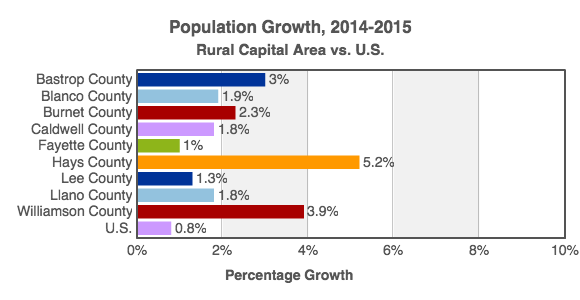
Rural Capital Area Records over 11,400 Births in 2015; Birth Rates Highest in Bastrop, Williamson and Caldwell Counties
article posted by Headlight on May 3, 2016
Recently released data from the US Census Bureau reveals that the Rural Capital Area recorded 11,400 births in 2015 (July 2014 to July 2015), an increase of 2.8% over the previous year. The birth rate for the region is 12.1 births per 1,000 people.

Within the Rural Capital Area, Bastrop County has the highest birth rate (13.0 births per 1,000 people). Williamson County (12.5), Caldwell County (12.1) and Hays County (12.0) follow. Travis County has a birth rate of 13.9, higher than any RCA county.
The counties with the lowest birth rates are Blanco (6.4) and Llano (8.6).
All counties saw an increase in births in 2015 with the exception of Llano County where births declined 0.6%. The counties where births grew fastest were Lee County (11.6%), Fayette County (5.3%) and Hays County (4.7%).
The number of births is growing faster in the Rural Capital Area than Travis County.
The Hottest Careers in Trades in the Rural Capital Area in Health Care and Construction
article posted by Headlight on March 23, 2016
The majority of trade occupations in the Rural Capital Area will see high growth over the next five years. The hottest careers in Trades based on the number of job openings are Medical Secretaries, Medical Assistants and Dental Assistants. These occupations will have more than 200 job openings and 20% growth from 2015-2020.
While the top three occupations are medical occupations, construction also has a strong presence on the Top 15 list for Trades careers. Cement Mason & Concrete Finishers, Carpenters and Plumbers, Pipefitters & Steamfitters will have 200 jobs openings.
The highest paying trade occupations are Commercial Pilots ($46 per hour) and Dental Hygienists ($34 per hour). The fastest growing occupation is Brickmasons & Blockmasons with a 42% increase.
Most Trades occupations require only a High School Diploma or Post-Secondary Certificate, which makes them great occupations for those looking to be in high demand without paying for more schooling.
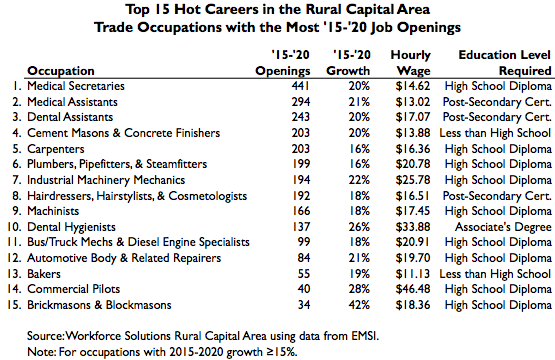
Click here to see the all the Hot Careers Lists.
The Hottest Careers in the Rural Capital Area for Associate's Degree Holders are in Health Care and Engineering
article posted by Headlight on March 23, 2016
At the Associate's degree level, the hottest careers in the Rural Capital Area are Dental Hygienist, Web Developer and Diagnostic Medical Sonographer.
Dental Hygienists earn $34 per hour, will grow 26% from 2015-2020, and have a lot of jobs openings. Registered nurses will have the most job openings of any career on the Top 15 list.
Medical occupations make up eight of the Top 15 for Associate's holders. Engineering jobs account for three of the Top 15. Almost 75% of the Top 15 are STEM occupations.
Two hot careers outside of the Medical and Engineering sectors are Web Developers and Paralegals & Legal Assistants. These occupations are expecting strong growth over the next few years and have high earning potential. Paralegals & Legal Assistants will have 112 job openings.

Click here to see the all the Hot Careers Lists.
Coming Soon: A New Career Planning Website To Be Unveiled to Help Students and Career Counselors Match Career Goals with Local Education Programs
article posted by Headlight on March 23, 2016
Next month, Workforce Solutions – Rural Capital Area will launch a one-of-a-kind career planning website that will vastly improve career planning for students in the Rural Capital Area and central Texas. The website will provide 24-access to career information student, parents, career counselors and the general public. It will help users identify careers in our service area, the skills required for those careers, and the available college and training programs for each career. The website will have an Interests survey for students to match careers to their abilities, desired work tasks, and planned educational attainment level. Employment data and forecasts will be available by county or region.
Once students finish with their career and education search, they can save and print a copy of their work. The website will also include information on the 20 Top Careers in the service area and other useful LMI data.
For a preview of career data, visit our Hot Careers page on RuralCapitalHeadlight.com, our “LMI and more†data website.
Stay tuned for the announcement of our new career planning website!
The Hottest Careers in the Rural Capital Area for Bachelor's Degree Holders are Managers, Engineers, and Analysts
article posted by Headlight on March 23, 2016
The just-released Hot Careers list for the Rural Capital Area highlight high growth, high wage occupations for Bachelor's and Associate's degree holders.
At the top of the list for Bachelor's holders are Chief Executives, who earn over $80 per hour. Many CEOs are also business owners, and these high-wage careers take many years climbing the corporate ladder – students get educated but plan to work hard after college.
Architectural & Engineering Managers and Marketing Managers also top the list. In fact, managerial positions dominate the Top 15 list, accounting for over half of the highest paying jobs. Becoming a manager requires diverse skills on team building, public speaking, financial planning, strategy and even writing. Being well educated means also learning these important skills outside of the classroom.
Engineers also feature prominently in the Top 15 list. Petroleum Engineers is the highest paying, non-managerial occupation on the list, while Computer Hardware Engineers will be in highest demand with 168 job openings in the Rural Capital Area.
Eight of the Top 15 occupations are STEM (Science, Engineering, Technology or Math) occupations. The rest belong to the Business, Finance, Marketing or Back Office sectors.

Click here to see the all the Hot Careers Lists.
The Hottest STEM Careers in the Rural Capital Area are Registered Nurses, Software Developers and Computer Analysts
article posted by Headlight on March 23, 2016
STEM: Science, Technology, Engineering and Math. In the age of information and technology the demand for skilled STEM workers continues to increase. STEM occupations account for over half of the Top 15 highest paying hot careers for Bachelor's holders. Almost 75% of the Top 15 highest paying hot careers for Associate's degree holders are STEM occupations. With such prominence in these Top 15 lists we wanted to take a closer look at the hottest STEM occupations in the Rural Capital Area.
Registered Nurses are the hottest STEM occupation by a large margin. At 963 job openings, no other STEM occupation comes close to matching that level of demand for Registered Nurses in the Rural Capital Area. Software Developers (381 jobs) and Computer Systems Analysts (332 jobs) follow.
The highest paying STEM occupation is Physicians & Surgeons, earning $108 per hour on average. However, this occupation requires a Doctoral degree, so dedication and many years of studying are essential for this hot career. Eleven of the Top 15 STEM occupations require at least a Bachelor's degree. One notable exception is Pharmacy Technicians, which requires only a High School Diploma, though some training is preferred. The average hourly wage for a Pharmacy Technician is $14.
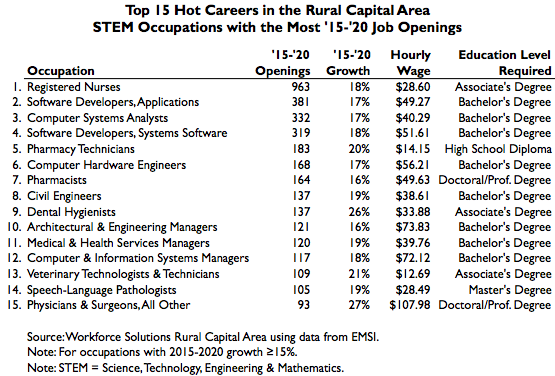
Click here to see the all the Hot Careers Lists.
Education and Medical Occupations Growing Fastest in the Rural Capital Area; Most Net New Jobs in Hospitality Occupations
article posted by Headlight on February 22, 2016
In 2016, nearly all occupation clusters in the Rural Capital Area are projected to experience employment gains. Total employment is forecast to grow 4.3% this year, according to projections from national data provider EMSI. Education is expected to be the single fastest growing occupation cluster in the region, rising 5.5% in 2016. Medical, Hospitality and Computer occupations are also projected to support strong job growth at 4.8%, 4.6% and 4.2%, respectively. Additional sources of job growth include occupations in Logistics (4.1% growth), Personal Services (4.1%), and Back Office (3.8%).
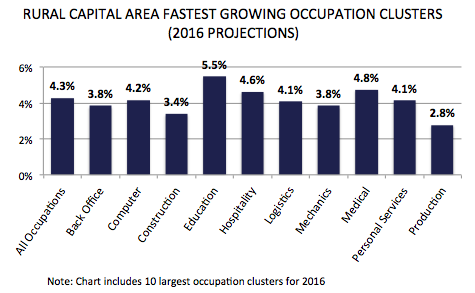
Due to their relatively large size, many slower growing occupation clusters are projected to create the largest number of new jobs within the Rural Capital Area in 2016. Hospitality employment is expected to increase by more than 2,000 jobs this year. Back Office and Personal Services are also expected to create a significant number of jobs within the Rural Capital Area, at 1,600 and 1,500, respectively. The Education and Medical clusters are projected to create more than 1,000 jobs each. Logistics will create 800 jobs.
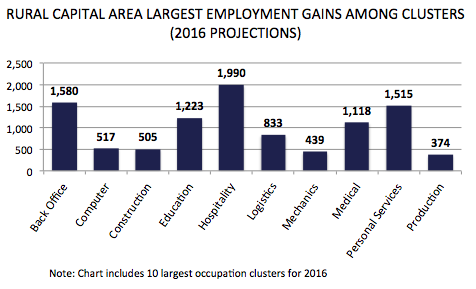
The Rural Capital Area can expect to see continued broad growth across a diverse set of occupations in 2016. The chart below shows the relative employment base, 5-year growth forecast and location quotient for the largest occupation clusters in the region.
Click here for a guide on how to read a bubble chart.

All clusters will post strong growth over the next 5 years with Education (21% growth) and Medical (18%) experiencing the highest growth. Occupation clusters with a high concentration (high location quotient) in comparison to the U.S. will also see strong growth. These strong, advancing industries include the occupation clusters with the most employment in the region: Construction, Education and Computer.
Looking inside these occupation clusters in more detail, Home Health Aides will grow the most at 28%. Dental Hygienists (26%), Teacher Assistants (25%) and Management Analysts (24%) follow.
Retail Salespersons (2,159 new jobs) are at the top of the chart for net new jobs between 2015 and 2020. Food Preparers & Servers (1,722 new jobs) and Elementary Teachers (1,065 new jobs) follow.
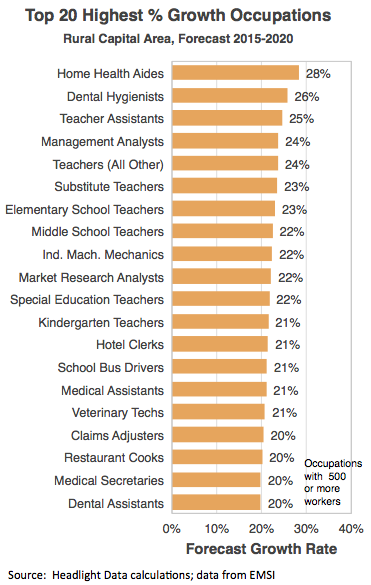

This strong growth indicates a bright economic future for the Rural Capital Area over the next five years and beyond.
Rural Capital Area Exports Surpass $3 Billion; Semiconductors and Precision Instruments Lead
article posted by Headlight on February 22, 2016
In 2014, the Rural Capital Area exported $3.3 billion of goods and services. Williamson County exported the most ($1.8B) followed by Hays County ($540M), Burnet County ($230M) and Bastrop County ($210M).
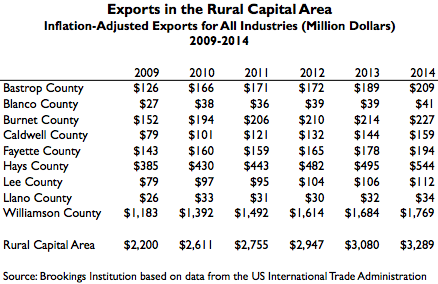
From 2009 – 2014, export revenue in the RCA increased the most for Caldwell County (102%). Bastrop (66%), Williamson (50%) and Burnet (50%) followed. Export revenue grew more than the national average (30%) in all the RCA counties.
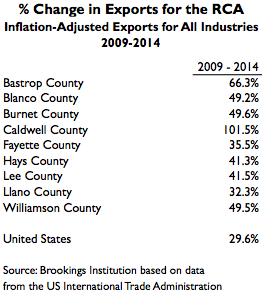
The largest exported commodities in the Rural Capital Area are Semiconductors and Precision Instruments. In 2014 these two commodities generated over $560 million. Agriculture, Aircraft Products & Parts and Agriculture, Construction & Mining Machinery generated more than $150 million.
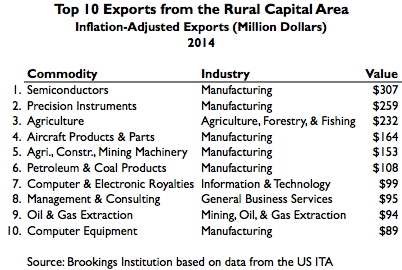
Click here to see all Exports by Commodity data for the Rural Capital Area.
2015 Year in Review and 2016 Forecast for the Rural Capital Area
article posted by Headlight on January 21, 2016
With the new year upon us, we'd like to examine how 2016 will compare with last year in the Rural Capital Area. Overall, economic growth is expected to remain strong in 2016, but 2017 will see a more tempered growth rate.
Historically, the Rural Capital Area (RCA) has seen higher employment growth than the U.S. average. This trend is forecast to continue, however employment projections from national data provider EMSI anticipate that the gap between U.S. and RCA growth will narrow over the next five years. In 2015, RCA employment grew 4.1%, twice the U.S. rate. 2016 is expected to see a slight increase in RCA growth – 4.3%. By 2021, the growth rate will be 2.2% for the RCA and 1.3% for the U.S.
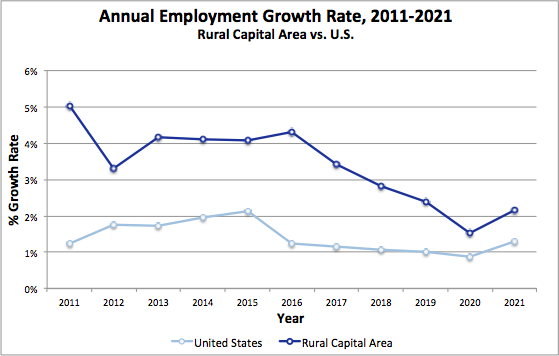
All Rural Capital Area counties will experience higher employment growth in 2016 than in 2015, with the exception of Williamson county. The county with the highest forecasted growth rate in 2016 will be Blanco (5.1%). Caldwell (4.7%), Llano (4.6%) and Williamson (4.5%) follow. Fayette (2.6%) and Burnet (2.8%) are forecast to have the lowest growth. Lee County will experience the greatest change in growth, rising from -0.1% in 2015 to 4.4% in 2016.
All nine counties are expected to have slightly lower growth in 2017 than in 2016. On average, growth will fall from 4.3% to 3.4%. In comparison, U.S. employment will stay nominally flat; with a decline of just 0.1 percentage points in 2017 after a more significant drop this year. Blanco (4.1%) and Caldwell (3.7%) have the highest 2017 growth rates, Fayette (2.0%) and Burnet (2.2%), the lowest.
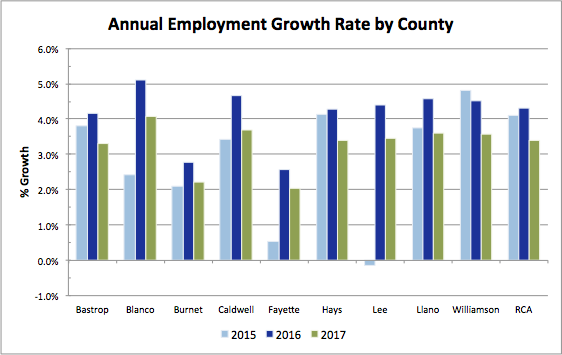
In addition to reviewing 2015, we can examine a decade worth of historical growth for the region. New updates illuminate that the Rural Capital Area population growth has outpaced that of the U.S. and has seen strong percentage increases in the last few years. In 2014, the population grew 3.4% while the U.S. population increased 0.7%.

As the population has grown, unemployment in the region has shrunk. The Rural Capital Area has remained below the U.S. unemployment rate for over a decade. In the years following the recession, unemployment has fallen from 7.3% in 2010 to 4.3% in 2014.
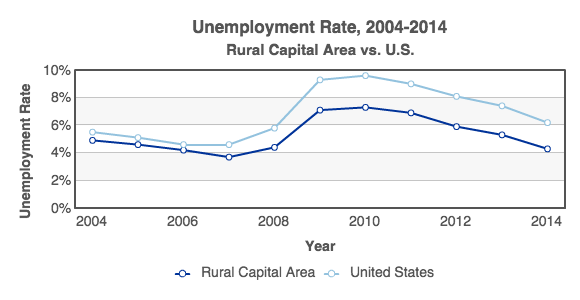
Average salaries have increased at a rate that closely mirrors U.S. growth, with the exception of 2011, when Rural Capital Area growth was 7% higher than the U.S.. In 2014, average salary growth was 2.6%, while the national average was 3.1%.
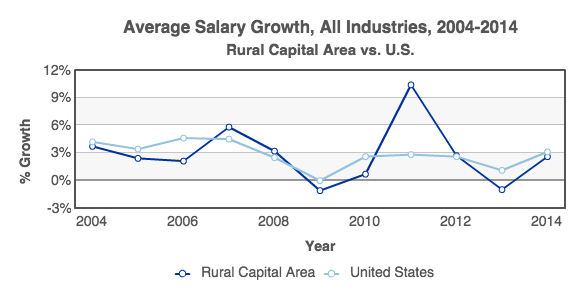
Lastly, we can look at the rise in median household income from 2004-2014. For over a decade the Rural Capital Area has boasted higher median income figures than the U.S.. In 2014, the median household income for the region was 121% of the national average.

With over a decade of strong growth behind us and more growth expected in the next few years, the future remains bright for the Rural Capital Area.
Where The Jobs Will Be: Rural Capital Area 2016 Edition
article posted by Headlight on January 21, 2016
In 2016, nearly all employment clusters in the Rural Capital Area are projected to experience employment gains. Total employment is forecast to grow 4.3% this year, according to projections from national data provider EMSI. Educational Services is expected to be the single fastest growing employment cluster in the region, rising 8.7% in 2016. Transport & Logistics, Entertainment and Professional Services are also projected to support strong job growth at 5.9%, 5.7% and 5.7%, respectively. Additional sources of job growth include industries such as Administration Support (5.1% growth), Health Care (4.9%), and Real Estate (4.8%).
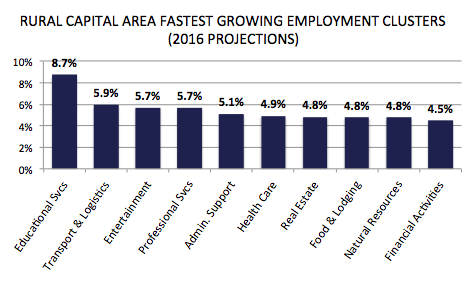
Due to their relatively large size, many slower growing employment clusters are projected to create the largest number of new jobs within the Rural Capital Area in 2016. Government employment is expected to increase by more than 2,000 jobs this year. Retail and Food & Lodging are also expected to create a significant number of jobs within the Rural Capital Area, at 1,700 and 1,500, respectively. Both Health Care and Professional Services clusters are projected to create more than 750 jobs each. Manufacturing will create 700 jobs.
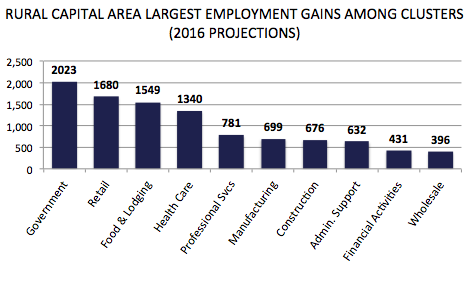
Examining growth for more detailed industry clusters, the Rural Capital Area can expect to see continued broad growth across a clusters both large and small. The chart below shows the relative employment base, 5-year growth forecast and location quotient for the large industry clusters in the region.
Click here for a guide on how to read a bubble chart.
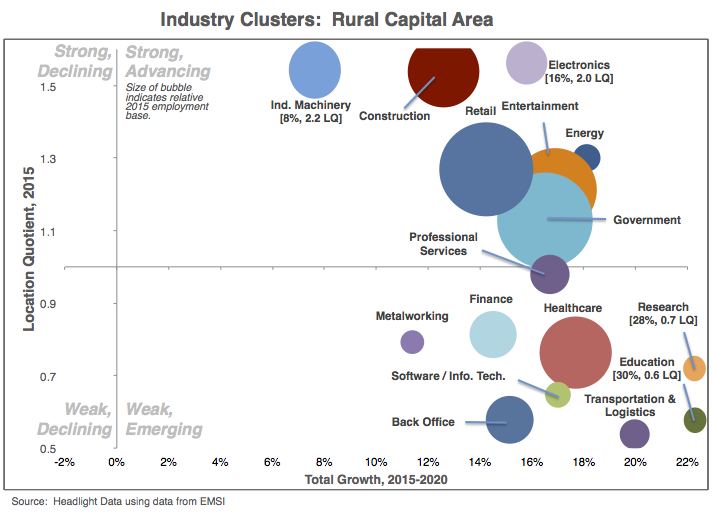
All clusters will post strong growth over the next 5 years with Education (30% growth) and Research (28%) experiencing the highest growth. Industry clusters with a high per capita concentration in comparison to the U.S. (high location quotient) will also see strong growth. These concentrated, advancing industries have the most employment in the region; Government, Retail, Entertainment, and Construction.
Looking at an even deeper level (4-digit NAICS), we can see that specialized sector Elementary & Secondary Schools will grow the most at 34%. Scientific R&D Services (32%), Private Bus Transport (29%) and Office Administration Services (29%) follow. The specialized sector Local Government is expected to create the most new jobs between 2015 and 2020, with Local Government Schools & Hospitals (5,214 jobs) at the top of the chart.
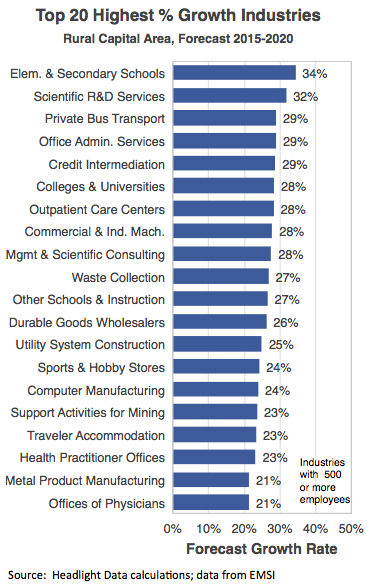
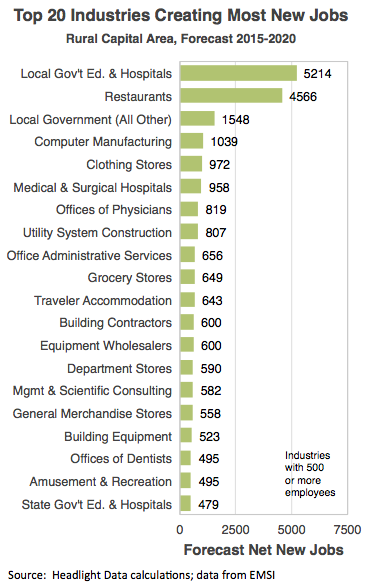
This strong industry growth and job creation indicates a bright economic future for the Rural Capital Area over the next five years and beyond.
Workforce Solutions-Rural Capital Area Releases Updated Target Occupations List
article posted by Headlight on December 17, 2015
Workforce Solutions Rural Capital Area has identified the industries and occupations most in demand in our nine-county area that also pay a self-sufficient wage of at least $18.00 per hour. If employment in our region is your primary goal, this list can help focus your career development efforts in occupations that are expected to have the highest growth in job and wage opportunities. Formula WIA training funds can only be provided to customers who are seeking a full time job in a regional occupation that appears on the Board's Target Occupations List.
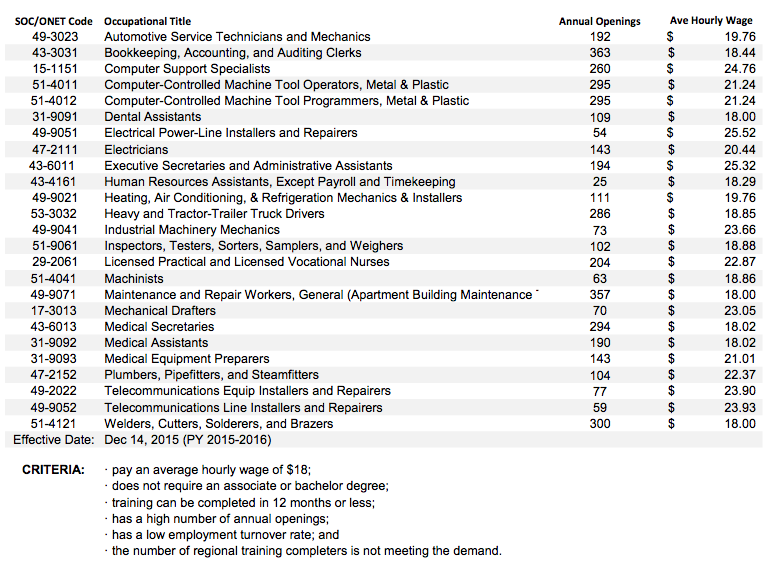
Click here to download a PDF of this Target Occupations List.Williamson And Hays Counties Are Better Educated Than U.S. Average; Bastrop County Lags
article posted by Headlight on December 16, 2015
Recently released data from the U.S. Census Bureau's American Community Survey show educational attainment for larger Rural Capital Area (RCA) counties.
Eighty-seven percent of the U.S. population holds at least a high school diploma. Of the three RCA counties for which data is available, Williamson has the highest percentage of high school graduates at 93%. Hays (87%) is also above the U.S. average but Bastrop (78%) is below average.
And, at the bachelor's level both Williamson (40%) and Hays (35%) are above the U.S. average (30%). However, Bastrop trails behind at 20%, over 10 percentage points lower than the average.
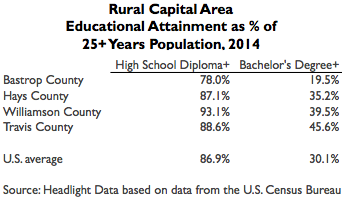
From 2009 to 2014, the number of high school graduates as a percentage of the U.S. population rose 1.6 percentage points. The RCA county with the greatest 5-year increase was Williamson (+2.4 pts.) Hays (-0.4 pts.) and Bastrop (-6.1 pts.) both decreased.
The U.S. average for bachelor's degree holders increased 2.2 percentage points in 5 years. All three RCA counties outpaced U.S. growth. Williamson (+4.7 pts.) increased the most, followed by Bastrop (+3.9 pts.) and Hays (+2.7 pts.).

Bastrop And Williamson Counties Have Higher Share of Affordable Housing Than U.S. Average; Hays County Less Affordable
article posted by Headlight on December 16, 2015
Recently released data from the U.S. Census Bureau's American Community Survey details housing costs for larger Rural Capital Area (RCA) counties. Housing is considered affordable if it costs less than 30% of monthly household income.
Thirty-nine percent of the U.S. population lives in unaffordable housing. Of the three RCA counties for which data is available, Hays has the highest percentage of unaffordable housing at 41%. Bastrop (30%) and Williamson (31%) are both below the U.S. average and more than 10 percentage points below Hays County.
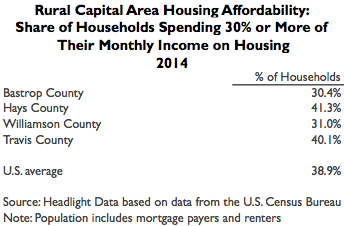
From 2009 to 2014, the share of unaffordable housing in the U.S. fell by 3 percentage points. In the Rural Capital Area, Williamson County had the greatest 5-year decrease of almost 5 percentage points. Bastrop (-3.5 pts.) and Hays (-1.4 pts.) followed. In comparison, Travis County decreased only 0.6 percentage points.
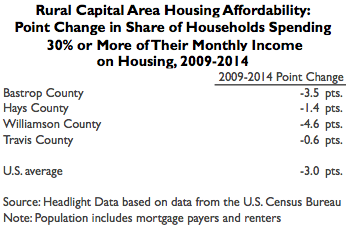
Top 5 Most Popular Rural Capital Headlight Articles of 2015
article posted by Headlight on December 16, 2015
Rural Capital Area's Unemployment Rate Reaches 3.4%; Lowest Rate in Blanco County, Highest in Llano
article posted by Headlight on November 18, 2015
The September 2015 unemployment rate for the Rural Capital Area (3.4%) registered 1.5 percentage points lower than the U.S. rate of 4.9%. Blanco County had the lowest unemployment rate (3.0%), followed by Lee County (3.2%) and Fayette County (3.3%).
The county with the highest unemployment in September 2015 was Llano (4.3%). Caldwell and Bastrop County followed Llano with unemployment rates of 4.1% and 3.7% respectively.
All the Rural Capital Area counties had unemployment rates that were lower than the U.S. average for September 2015.
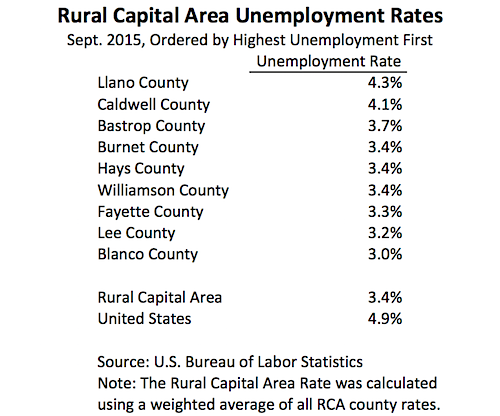
Today's unemployment rate in all Rural Capital Area counties is lower than 10 years ago. From September 2005 to September 2015, the unemployment rate decreased in the Rural Capital Area by 1.0 percentage point versus a 0.1 point increase in the U.S.
Bastrop County and Caldwell County saw the greatest decrease (1.1 pts.), followed by Blanco (1.0 pts.), Lee (1.0 pts.) and Williamson (1.0 pts.)
Fayette County had the smallest decrease over the 10-year period with a 0.5 percentage point decrease.

Telecommuting Across the Metro Rises to 6.9% of Workers; Higher Than US' 4.5%
article posted by Headlight on November 18, 2015
In 2014, the U.S. Census Bureau released commuting mode estimates for two Rural Capital Area counties - Hays County and Williamson County. The tables below show the share each commuting mode had of the total commuters in 2009 and 2014. The estimates for Travis County, the Austin-Round Rock Metro and the United States are included for comparison.
The number of people that worked from home increased from 2009 to 2014. The Austin metro saw its telecommuter share increase from 5.9% in 2009 to 6.9% in 2014. The U.S. telecommuter share grew from 4.3% to 4.5%.
In Travis County, the percentage of telecommuters grew from 6.0% to 7.3% over the 5-year period. Hays saw a slight decline in telecommuting and Williamson County saw a 1.1 percentage point increase.

Still, the vast majority of workers commute by car. 89% of Hays County workers used a car to get to work in 2014. Most Hays residents traveled alone, but 12% carpooled, 3 percentage points more than the U.S. average. The number of single occupant cars decreased by 3 percentage points in Hays from 2009 to 2014. The number of carpoolers increased by 3 percentage points.
In Williamson County, 90% of residents commuted by car. The change was less pronounced for Williamson County with a 1.1 point decrease in single occupant cars and 0.3 point increase in carpools.
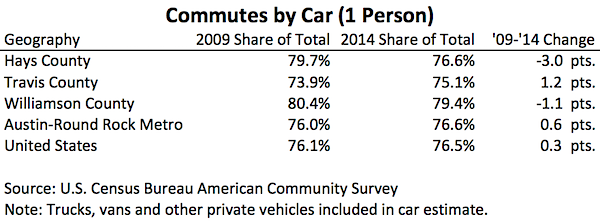
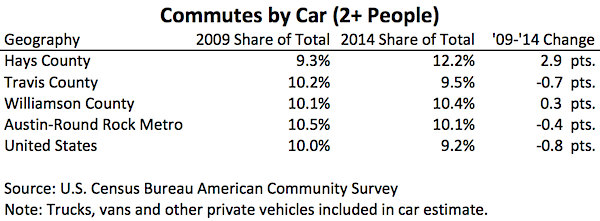
Other transport modes had a much smaller share of the total commuters. Public transport was used by 5.2% of U.S. commuters in 2014. The percentage was less for Hays (1.2%), Williamson (0.8%) and Travis (3.6%). The share of commuters using public transport changed less than 1 percentage point for all three counties between 2009 and 2014.

The share of people that walked to work in 2014 was 2.2% for Hays County but only 0.8% for Williamson County. Both counties saw a decrease in walkers from 2009 to 2014. Travis County saw a slight increase from 1.9% to 2.0%.
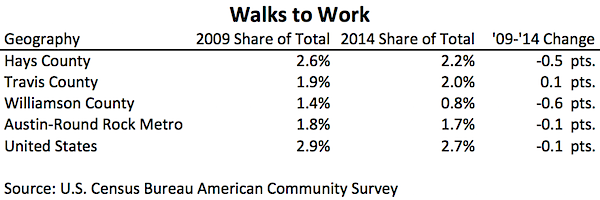
Older Workers Are More Likely to be Telecommuters or Work from Home in the Austin Metro
article posted by Headlight on November 18, 2015
In 2014, almost 70,000 Austin Metro workers telecommuted, which includes people who work at home or run home-based businesses. This number represents 7% of Austin Metro workers and is a 1 percentage point increase on the number of telecommuters in 2009.
Workers 65 years or older in the Austin metro have the highest rates of telecommuters – 10% – a trend that mirrors the U.S. But, young professionals aged 25-44 are twice as likely to be telecommuters (7.2%) than the average U.S. young professional (3.8%).


From 2009 to 2014, the Austin Metro saw a greater change in the percentage of telecommuters than the U.S. across all age brackets. The percentage of telecommuters increased the most for 25-44 years olds (1.45 pts.), followed by 45-54 year olds (1.34 points) and 16-19 year olds (0.99 points). The percentage of Austin Metro telecommuters decreased for the rest of the age brackets with the greatest decrease for 65+ year olds.

New Data Maps Available on Counties in the Rural Capital Area: Population Growth, Race, Income, Age, Unemployment Rates
article posted by Headlight on October 15, 2015
Maps on each county in the Rural Capital Area show variations by census tracts within the county. The following metrics are available as heat maps:
- Population Growth, 2010-2015
- Population Forecast, 2015-2020
- Total Population, 2015
- Percent White, 2015
- Percent Hispanic, 2015
- Median Household Income, 2015
- Median Age, 2015
- Unemployment Rate, 2015
Heat maps use shaded colors to show the variation of a metric within the county as shown here:
Population Growth, 2010-2015, Bastrop County
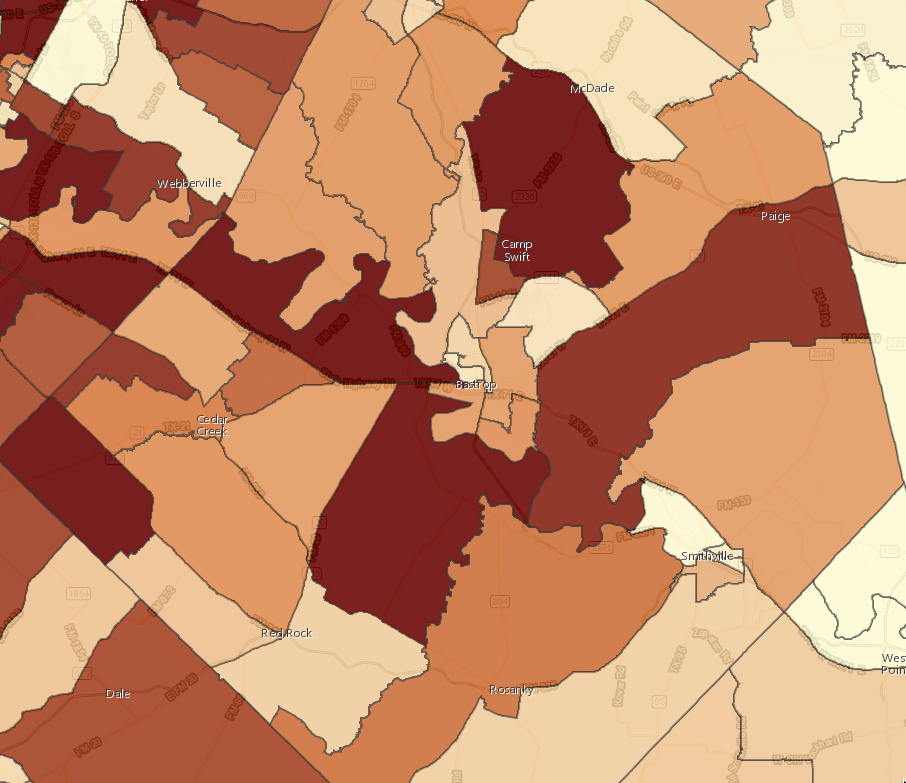
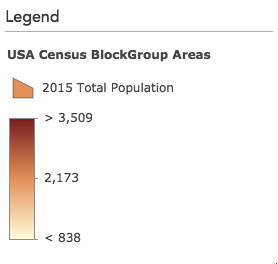
Click here to see maps on the Rural Capital Area.
5,400 Inventors Living in the Rural Capital Area Received Patents in 2013, Led by Williamson County and Hays County
article posted by Headlight on October 15, 2015
In 2013, 5,350 residents in the Rural Capital Area (RCA) were granted patents by the US Patent and Trademark Office. Williamson County had the most inventors (3,184) followed by Hays County (2,081). Multiple inventors can be attributed to a single patent.
The number of inventors in the Rural Capital Area increased 40% from 2008 to 2013. The number of inventors in Bastrop and Burnet counties more than doubled. Growth in Hays County outpaced Williamson County.
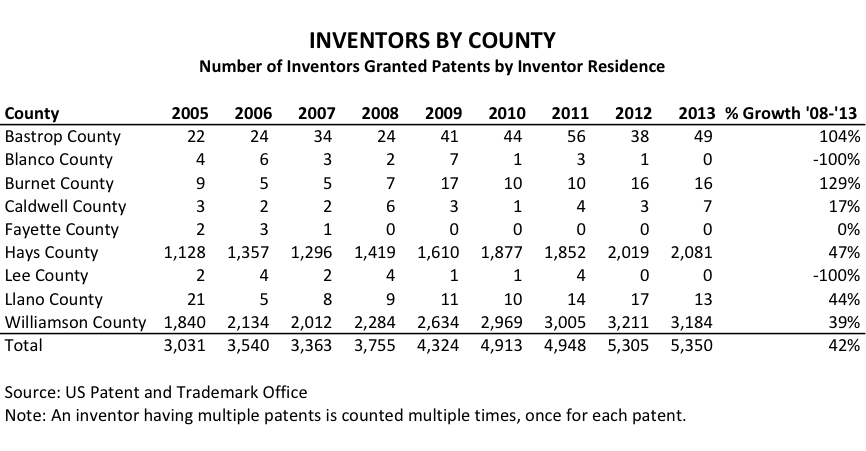
Only Blanco, Fayette and Lee County saw a decrease in the number of inventors granted patents. All three counties were granted 0 patents in 2013.
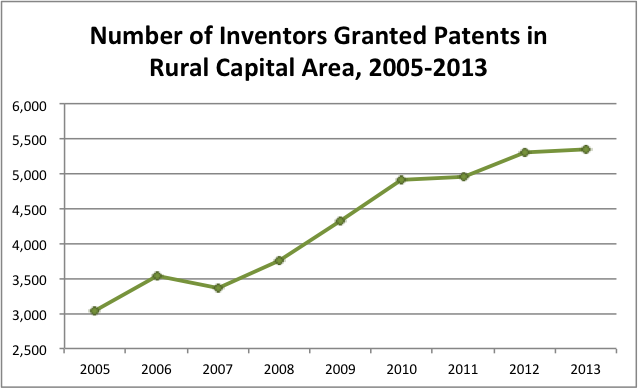
Of the 5,300 inventors that received patents in 2013, 1,873 inventors were named as the first person on the patent. When counting a patent only once for the first person named, Williamson County had the most patents (1,109) followed by Hays County (738). The number of patents awarded increased 35% in the Rural Capital Area from 2008 to 2013. The number of patents awarded in Bastrop and Burnet counties more than doubled. The percentage growth in Hays was greater than that in Williamson. This mirrors the trends seen in the number of inventors in the Rural Capital Area.

Austin Metro Inventors Granted 2,700 Patents in 2013, Led by Data Processing and Electrical Computers & Digital Processing Systems
article posted by Headlight on October 15, 2015
In 2013, the Austin metro was awarded 2,700 patents accounting for 2% of all US patents awarded. Patents increased 38% from 2008-2013, a slower pace than the US' 72%. During the previous five years, Austin patents grew 9% while total US patents fell 12%.
The US Patent and Trademark Office classify patents according to their technology type. There were 64 of approximately 475 technology classes represented in Austin patents in 2013. The technology class with the most patents granted was Multicomputer Data Transferring. Eight of the top 15 technology classes belonged to the broader categories of Electric Computers & Digital Processing Systems or Data Processing.

The Virtual Machine Task or Process Management class had the largest increase in patents awarded from 2008-2013 (224% increase). Information Security patents increased by 203%. Seven of the 15 technology classes with the highest growth in patents were from the Electrical Computers & Digital Processing Systems or Data Processing classification groups.
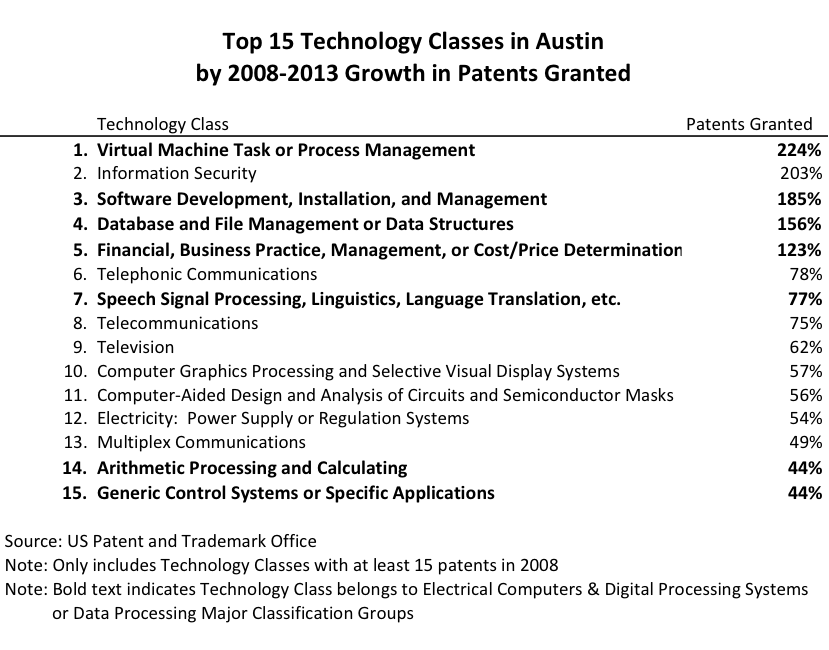
New 2014 American Community Survey Data Released for Some Rural Capital Area Counties.
article posted by Headlight on October 15, 2015
The Rural Capital Area's most populated counties have 2014 estimates available now from the US Census. Some key findings include:
- Bastrop County saw the biggest percentage increase in its share of Millennials aged 25-34 years, but the Austin metro still has a higher percentage than the RCA counties.
- Bastrop's retiree population (65+ years) shrunk as a percent of total, but Hays, Williamson and Austin saw an increase.
- Hays County has the lowest median age (30.7 years).

Median household incomes increased in Bastrop County, Williamson County, and the Austin metro, but incomes decreased slightly in Hays County. Williamson County has the lowest unemployment rate (4.3%) and the highest median household income ($72,453).

The percentage of the 25+ years population with an associate's degree remained constant from 2013 to 2014 for Bastrop, Hays and Austin. Williamson County saw a 0.3% decrease in associate's degrees. The share of people with bachelor's degrees fell slightly in Bastrop County, Hays County, and the Austin metro, but increased in Williamson County.

More 2014 demographic, social and economic data for the RCA counties can be found here:
Bastrop County 2014 Data
Hays County 2014 Data
Williamson County 2014 Data
Net Migration into Rural Capital Area Was Positive for All Counties in 2013; Over 7,300 Tax-Paying Households Added
article posted by Headlight on September 16, 2015
In 2013, the Rural Capital Area attracted 7,300 net new households (tax returns), representing approximately 17,000 new people (exemptions) and $565 million in new taxpayer gross income.
Williamson County attracted the most: 4,300 households and $280 million in gross income. Hays County captured the second most households and income. Bastrop County attracted the third-most returns, but Burnet County attracted the third highest new gross income, $85 million.
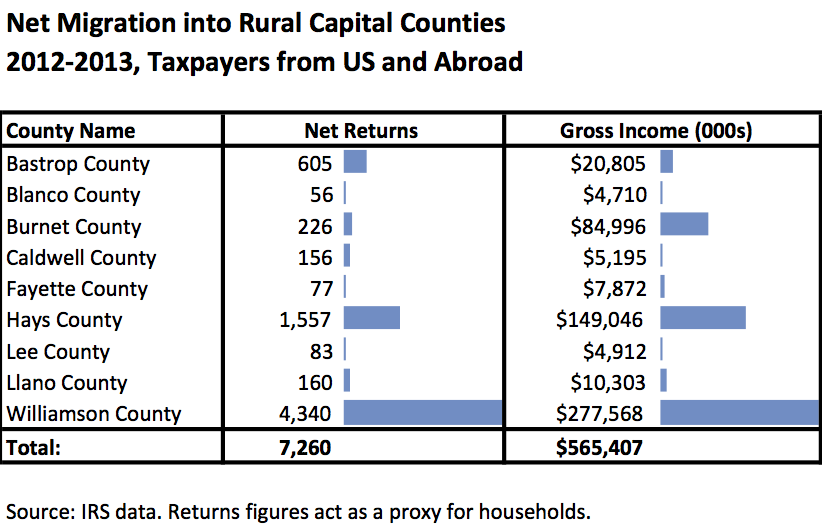
Travis County was a major contributor to flows into the Rural Capital Area, accounting for 40% of net migration. 3,000 households (returns) relocated from Travis County, bringing $160 million of total gross income with them. Williamson County captured the most households from Travis County (1,500), but Hays County captured the most tax payer gross income ($76 million into Hays versus $69 million into Williamson). Bastrop County and Lee County had positive net migration (300 and 8 households respectively) but a negative impact to gross income (-$1.6 million and -$0.1 million respectively).
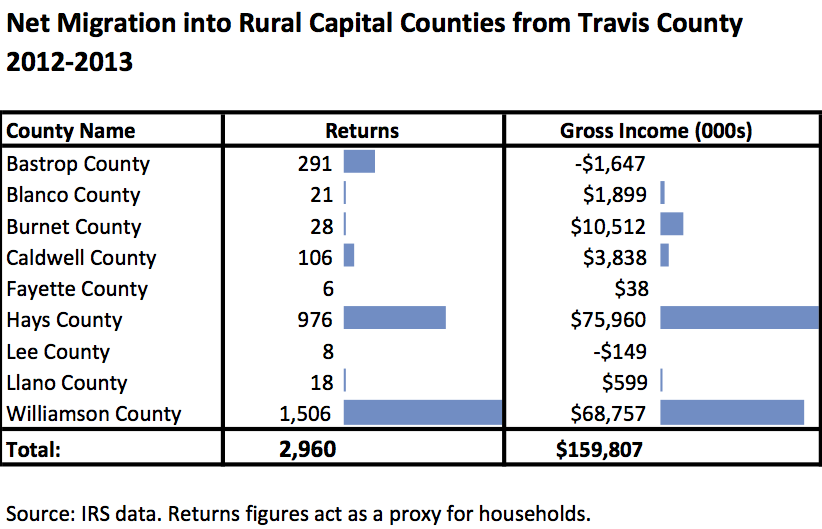
Click here to download a spreadsheet of the data.
3,400 Households Relocated within the Rural Capital Area in 2013; Williamson County Loses Most Households within the Region; Burnet County Gains Most
article posted by Headlight on September 16, 2015
In 2013, 3,400 households (tax returns) moved from one county to another county within the Rural Capital Area. The three counties that received the most households were Hays County (790 households), Williamson County (750) and Burnet County (470). The three counties that lost the most households were Williamson County (950), Hays County (820) and Bastrop County (390).
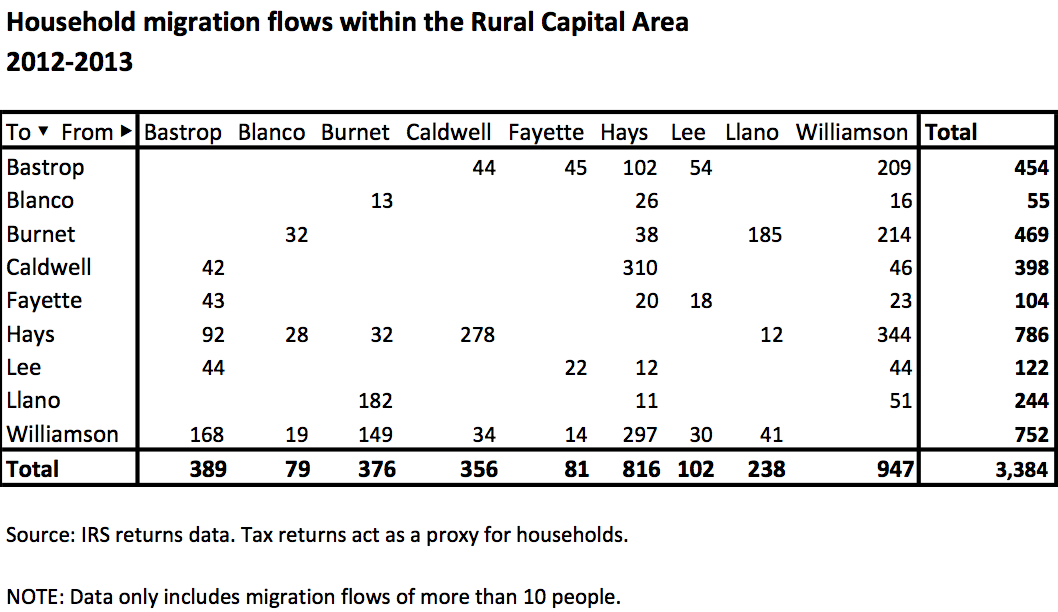
In terms of net migration (in- less out-), Burnet County gained the most new households (93), followed by Bastrop County (65) and Caldwell County (42). Williamson County lost a net of 200 households to other counties in the Rural Capital Area.
In addition to Williamson County, Blanco County lost more households than it gained. The rest of the counties saw positive net migration from within the Rural Capital Area.
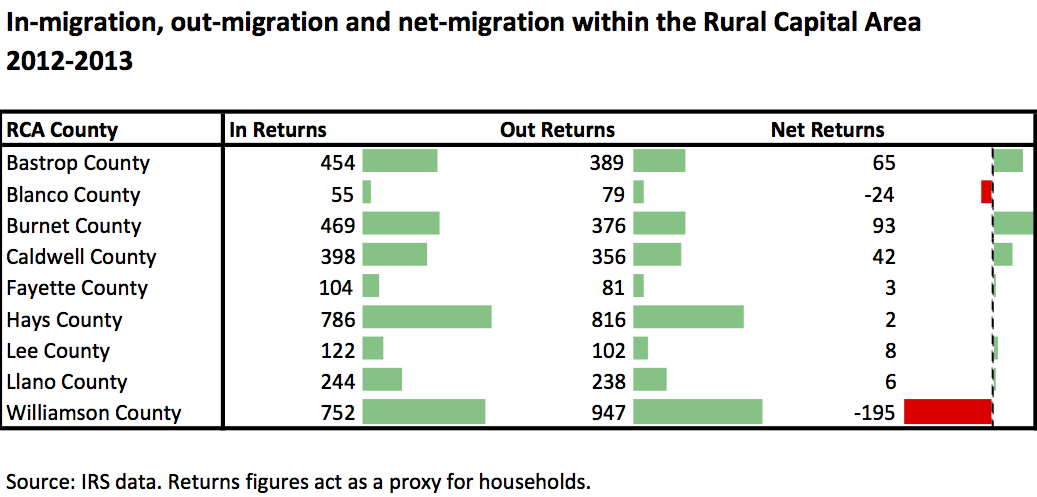
Click here to download a spreadsheet of the data.
Counties Attracting Most Newcomers in 2013 Are in Austin-TX, Houston-TX, Phoenix-AZ, Las Vegas-NV, and Seattle-WA; Los Angeles, Miami, Chicago Lose Most
article posted by Headlight on September 16, 2015
Recently released data from the Internal Revenue Service shows that county-to-county net migration (total in-migrants minus out-migrants) is the highest in Travis County, TX (Austin), which gained 24,000 households in 2013 from outside the Austin metro. Travis County gained a remarkable 10,000 more returns than the county in second place.
“Households†is a proxy for the IRS-reported number of tax returns. Intra-metro relocations were excluded from this analysis.
Harris County, TX (in Houston) attracted 14,000 new households, followed by Maricopa County, AZ (7,400), Clark County, NV (6,100) and King County, WA (5,100).

Households relocating out of the metro were highest in Los Angeles County, CA (-13,600), Miami-Dade County, FL (-12,400), and Cook County, IL (-7,700) in Chicago.
Click here to download a spreadsheet of data for all counties.
Newcomers to the Rural Capital Area are Primarily from Travis County and Texas, with Some In-Migrants Coming from Florida, Arizona, and California
article posted by Headlight on August 19, 2015
Population growth in the Rural Capital Area is heavily influenced by out-migration from Travis County. In 2012 (the latest year available from the Internal Revenue Service), 26,000 people left Travis County for the Rural Capital Area. By comparison, 19,500 people left the Rural Capital Area to move to Travis County, for a net flow of 5,600 people (as measured by the exemptions on tax returns – a fair proxy for headcount). Harris County (Houston), Bell County (Killeen/Belton), and Los Angeles County were the top sources for net migration to the Rural Capital Area.

Other cities outside of Texas that send population to the Rural Capital Area include Chicago, Orange-CA, San Jose, Las Vegas, Phoenix, Miami, and San Francisco. All of these cities send more people to the Rural Capital Area than they attract back.
Travis County also attracts a large number of people from outside of the state: Miami, Tampa Bay, the Bronx, Chicago, Los Angeles, Manhattan, Seattle, Philadelphia, and Phoenix all send more population to Austin than they attract.
In total the Rural Capital Area enjoys positive net migration from 94 counties and Travis County enjoys positive net migration from 259 counties.
Manufacturing and Information Services Lead Industry Growth in the Rural Capital Area
article posted by Headlight on August 19, 2015
According to recently released data from the Texas Workforce Commission, the Rural Capital Area enjoyed a diverse mix of high-performing industries. Manufacturing grew fastest in Blanco, Llano, and Williamson counties, while Information Services grew fastest in Caldwell, Hays, and Lee counties. (Information Services includes Publishers, Film/TV, Telecom Services and Data Centers.) Financial Activities led growth in Bastrop County, Natural Resource led growth in Burnet County, and Government led growth in Fayette County.
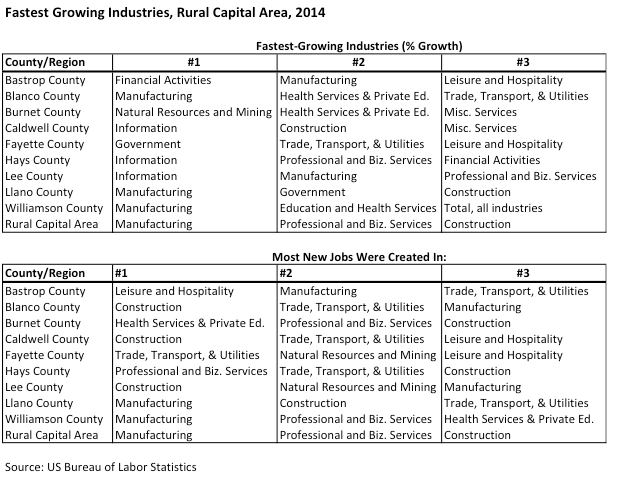
In terms of total new jobs created, Construction created the most jobs in Blanco, Caldwell, and Lee counties. Manufacturing created the most jobs in Llano and Williamson counties. Bastrop County's job creation was led by Leisure & Hospitality, Burnet was led by Health Services, Fayette was led by Trade/Transport/Utilities, and Hays was led by Professional Services.
Click here to explore job growth data by county in the Rural Capital Area.
Intel's diversity hiring doubles in six months
article posted by Headlight on August 19, 2015
This is an article from USA Today originally posted on the Workforce Solutions Rural Capital Area News Archive.
SAN FRANCISCO — Chip-making giant Intel doubled the number of women and under-represented minorities it hired in the United States over the past six months, after its CEO announced a plan to reach full representation of those groups by 2020.
Intel on Wednesday published its first mid-year diversity report, offering one of the most detailed looks available from a technology company of its hiring.
The lack of women, African Americans and Hispanics in tech has been an issue of growing concern in Silicon Valley. Many big tech companies have instituted programs to diversify their workforce, but progress has been modest.
Over the past six months, 43.3% of the people Intel hired in the United States were either female, African American, Hispanic or Native American.
That's in contrast to a year ago, when roughly 20% of Intel's hires were from one of those groups, said CEO Brian Krzanich.
One thing that surprised staffers he said, was that the number of people with the necessary education — the much-discussed "pipeline" issue — wasn't as big a problem as they had feared.
"I think we started this process thinking that the pipeline was empty and we'd have to start at the very beginning," said Krzanich. "But we were all pleasantly surprised that there's actually a pretty good pipeline going."
Recruiters found that "if you go to the right colleges, the pipeline is there. I won't say it's easy, but it's certainly something that can be done," Krzanich said.
That fits with USA TODAY research published last year that found there were twice the number of under-represented graduates in technical fields than were hired by tech companies.
Intel found technical programs at colleges and universities with large populations of women, African Americans and Hispanics, Krzanich said.
The company also sent recruiters who were in the same groups they were trying to hire. Students "want to talk to people who understand what it's like to be at Intel as a woman, as an African American," said Krzanich.
The hiring period was roughly January to July, 2015.
The company's goal was that 40% of new hires would be women or under-represented minorities, so "we're actually very pleased with the progress we've made in the first six months," Krzanich said.
Of the 1,669 people the company hired since January, 1,035 were women, 139 were African American, 222 were Hispanic and nine were Native American, Intel reported.
Breaking out the workers in technical jobs (which encompass 85% of the workforce), the numbers were 19.4% female, 3.3% African American, 8.0% Hispanic and 0.5% Native American.
Even with increased diversity in hiring, the overall make-up of the workforce remained largely the same.
At the end of 2014, women made up 23.5% of Intel's total workforce, African Americans were 3.4%, Hispanics 8.3% and Native Americans 0.5%.
In July, women made up 24.1% of Intel's total workforce, African Americans 3.5%, Hispanics 8.3% and Native Americans 0.5%.
For workers in technical jobs, the percentages were 19.4% female, 3.3% African American, 8.0% Hispanic and 0.5% Native American.
The fact that the overall percentage of Hispanic and Native American staffers stayed steady shows Intel's honesty in releasing its numbers quickly even when they weren't totally in line with what the company was looking to achieve, said Laura Weidman Powers. She is co-founder of Code 2040, a non-profit that finds top Hispanic and African-American engineers and gets them internships with tech companies.
"It's not super surprising," said Powers. Her organization has long recognized that it's not possible to craft a one-size-fits-all solution in hiring when dealing with disparate groups.
Intel goals
Because 85% of its workforce is made up of technical staff, Intel has calculated what it calls the "market availability" of people in each group who have the necessary education and skills.
The numbers it arrived at for its technical staff are that 22.7% of women have the necessary technical skills, 4.5% of African Americans and 8.4% of Hispanics, said Rosalind Hudnell, the company's chief diversity officer.
It is those numbers, rather than the actual population, the company is trying to achieve parity with.
That's a smart way to do it, said Powers. Other tech companies sometimes throw up their hands and say, "It's a pipeline problem, there isn't enough talent," she said.
Intel is calling their bluff. "They're saying, 'Let's focus on the actual people coming out of the actual pipeline. And if we're not hitting those numbers, it's not on the schools, it's on us,'" Powers said.
The company has had to pay a slight premium to get the desired talent "because there are fewer people who have these diverse backgrounds," Krzanich said. However it hasn't been so much that it's "put our compensation out of whack."
The benefits, however, will be large, he believes.
He gives the example of a wearable designed for women that a group of male engineers was working on. They were trying to fit a small charging node into the clasp of the device, but it wasn't going in easily.
"Then a woman engineer came in and said, 'Why don't we just build a charging bowl, like the one I throw all my other jewelry in?'"
In many ways Intel has been at the forefront of the diversity issue for over a decade. It was one of the first tech companies to release its EEO1 report for the U.S. Equal Employment Opportunity Commission detailing its staffing in 2002.
"If everybody gets ahead of us, I think that would be a great thing for the world. We're okay with that," said Krzanich.
The new normal: Smaller workforce, sluggish pay
article posted by Headlight on August 19, 2015
This is an article from the Associated Press originally posted on the Workforce Solutions Rural Capital Area News Archive.
WASHINGTON — Even after another month of strong hiring in June and a sinking unemployment rate, the U.S. job market just isn't what it used to be.
Pay is sluggish. Many part-timers can't find full-time work. And a diminished share of Americans either have a job or are looking for one.
Yet in the face of global and demographic shifts, this may be what a nearly healthy U.S. job market now looks like.
An outsize proportion of Americans is retiring as the leading edge of the baby boom generation moves past age 65. Many younger adults, bruised by the Great Recession, are postponing work to remain in school to try to become more marketable. Global competition and increasing automation are holding down pay.
Many economists think these trends will persist for years despite steady job growth. It helps explain why the Federal Reserve is widely expected to start raising interest rates from record lows later this year even though many job measures remain far below their pre-recession peaks.
“The Fed may recognize that this is a new labor-market normal, and it will begin to normalize monetary policy,†said Patrick O'Keefe, an economist at accounting and consulting firm CohnReznick.
Thursday's monthly jobs report from the government showed that employers added a solid 223,000 jobs in June and that the unemployment rate fell to 5.3 percent from 5.5 percent in May. Even so, the generally improving job market still bears traits that have long been regarded as weaknesses. Among them:
• A shrunken labor force.
The unemployment rate didn't fall in June because more people were hired. The unemployment rate fell solely because the number of people who had become dispirited and stopped looking for work far exceeded the number who found jobs.
The percentage of Americans in the workforce — defined as those who either have a job or are actively seeking one— dropped to 62.6 percent, a 38-year low, from 62.9 percent. (The figure was 66 percent when the recession began in 2007.)
Fewer job holders typically mean weaker growth for the economy. The growth of the labor force slowed to just 0.3 percent in 2014, compared with 1.1 percent in 2007.
“It is highly unlikely that we are going to see our (workforce) participation rate move anywhere near where it was in 2007,†O'Keefe said.
This marks a striking reversal. The share of Americans in the workforce had been steadily climbing through early 2000, and a big reason was that more women were working. But that influx plateaued in the late 1990s and has drifted downward since.
• The retirement of the vast baby boom generation.
The aging population is restraining the growth of the workforce. The pace of retirements accelerated in 2008, when the oldest boomers turned 62, the age at which workers can start claiming early Social Security benefits. Economists estimate that retirements account for about half the decline in the share of Americans in the workforce since 2000.
From that perspective, the nation as a whole is beginning to resemble retirement havens such as Florida. Just 59.3 percent of Floridians are in the workforce.
• Younger workers are starting their careers later.
Employers are demanding college degrees and even postgraduate degrees for a higher proportion of jobs. Mindful of this trend, teens and young people in their 20s are still reading textbooks at an age when previous generations were punching time clocks.
The recession “basically told everybody that they need an education to get better jobs,†said John Silvia, chief economist at Wells Fargo. “So how would young people respond? They stayed in school.â€
Fewer than 39 percent of 18- and 19-year-olds are employed, down from 56 percent in 2000. For people ages 20 to 24, the proportion has fallen to 64 percent from 72 percent.
• The number of part-timers who would prefer full-time work remains high.
About 6.5 million workers are working part time but want full-time jobs, up from 4.6 million before the recession began. This is partly a reflection of tepid economic growth. But economists also point to long-term factors: Industries such as hotels and restaurants that hire many part-timers are driving an increasing share of job growth, researchers at the Federal Reserve Bank of San Francisco have found.
As more young adults put off working, some employers are turning to older workers to fill part-time jobs. Older workers are more likely to want full-time work, raising the level of so-called involuntary part-time employment.
Many economists also point to the Obama administration's health care reforms as a cause for increased part-time employment. The law requires companies with more than 100 employees to provide health insurance to those who work more than 30 hours.
Michael Feroli, an economist at JPMorgan Chase, said this could account for as much as one-third of the increase in part-time jobs.
• Weak pay growth.
The average hourly U.S. wage was flat in June at $24.95 and has risen just 2 percent over the past year. The stagnant June figure dispelled hopes that strong job growth in May heralded a trend of steadily rising incomes.
In theory, steady hiring is supposed to reduce the number of qualified workers who are still seeking jobs. And a tight supply of workers tends to force wages up.
Yet a host of factors has complicated that theory. U.S. workers are competing against lower-paid foreigners. And automation has threatened everyone from assembly line workers to executive secretaries.
Still, economists at Goldman Sachs forecast that average hourly pay will grow at an annual pace of about 3.5 percent by the end of 2016. That is a healthy pace. But it will have taken much longer to reach than in previous recoveries.
Job seekers fill out applications at a June job fair in Sunrise, Fla. Even with steady hiring and a falling unemployment rate, the U.S. job market is not what it used to be. A diminished share of Americans either have a job or are looking for one.
Burnet County Leads Job Growth in the Rural Capital Area in 2014, Followed by Fayette County and Hays County
article posted by Headlight on July 14, 2015
According to recently released data from the Texas Workforce Commission, the Rural Capital Area's employment base grew 4.2% in 2014, creating 10,700 new jobs. Job growth is high, but has yet to reach its pre-recession levels.
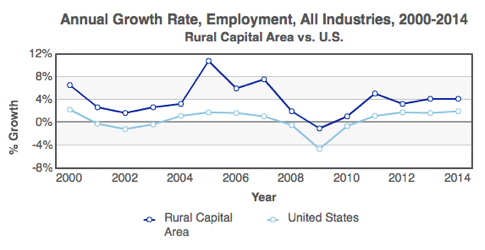
Within the Rural Capital Area, most new jobs were created in Williamson County (6,000 new jobs), followed by Hays County (2,600 jobs). But on a percentage basis, job growth was highest in Burnet County (6%), Fayette County (5%) and Hays County (4.6%).
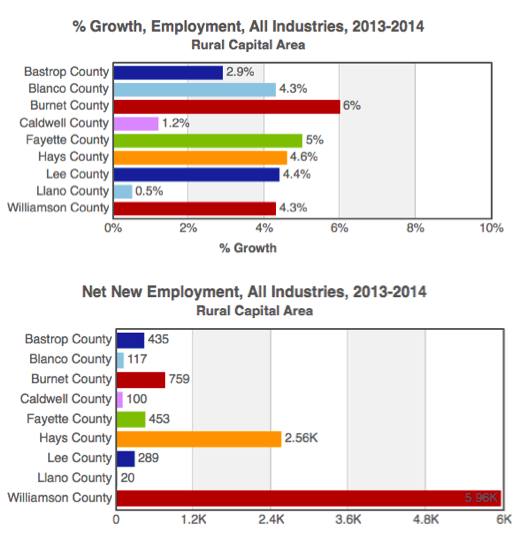
Click here to explore job growth by industry for individual counties in the Rural Capital Area.
Retiree Population Grows 9% in Hays County in 2014 and 8% in Williamson County, Topping Mid-Sized Counties; Austin Metro Fastest Among Large Metros, Growing 7%
article posted by Headlight on July 14, 2015
According to new data from the US Census, the Rural Capital Area's retiree population is the fastest growing of any age group. Retirees aged 65 years or older grew 7% in the region versus 3.4% for the US population overall. The 70-74 year old age group grew the fastest at 8.7%.

This high growth puts some counties at the top of the rankings: Hays and Williamson counties rank in the top 1% of all medium-sized counties and all other counties rank within the top 10% for growth with the exception of Fayette and Llano counties.
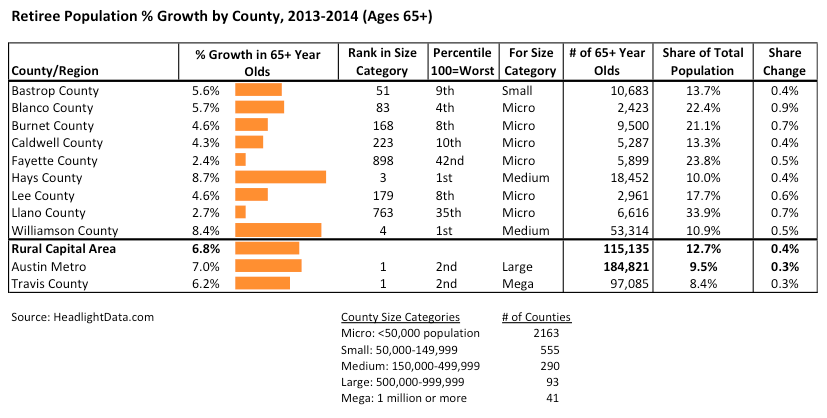
Retirees' share of the total population varies dramatically across counties, with retirees accounting for one-third of the population in Llano County but just 8% in Travis County.
Millennial Population Grows 7% in Hays County in 2014, Fastest Among Mid-Sized Counties; Austin Metro Also Fastest Among Large Metros, Growing 3.8%
article posted by Headlight on July 14, 2015
According to new data from the US Census, the growth of Millennials (age 25-34) is high across many counties in the Rural Capital Area. Hays County's 25-34 year old population grew faster in 2014 than any other mid-sized county in the US. Blanco, Caldwell, and Hays counties ranked in the top 10 percent of their size category. Overall, the Rural Capital Area saw its Millennial population grow 3.7%, faster than the rest of the population.

Still, Millennials still prefer the urban living offered by Travis County: Millennials account for 20% of Travis County's population, but just 13% of the Rural Capital Area's population.
Highest Wage Growth in 2014 in Lee, Hays, and Burnet Counties; Information Services, Financial Services and Professional Services Lead Growth
article posted by Headlight on June 17, 2015
Wage growth in the Austin metro matched US growth at 2.9% in 2014 (Q3 to Q3). High wage growth was experienced in rural Lee, Burnet, and Fayette counties. In more urban counties, Hays experienced strong growth, but Williamson County saw its average wage fall in 2014.
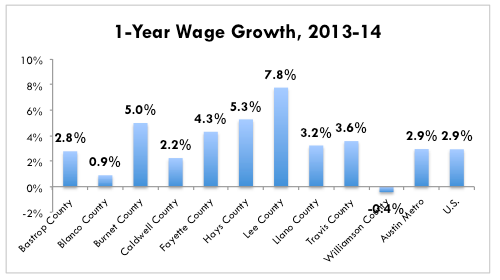
Wage growth varied by industry across the Rural Capital Area:
- Information Services wages grew 22% and 18% in Bastrop and Fayette counties, respectively.
- Financial Activities wages grew by double-digits in Bastrop, Fayette, Lee and Llano counties.
- Professional Services wages grew by double-digits across a majority of counties in the Rural Capital Area: Bastrop, Burnet, Fayette, Lee and Williamson.
- Manufacturing wages grew 17% in Llano County and 8% Burnet County.
- Natural Resources & Mining grew by double digits in Hays, Travis and Williamson counties.
Five-year growth trends showed some similarities: Lee County experienced the fastest wage growth again (40%), but Williamson County grew its wages faster than the Austin metro and US. Blanco County experienced the third fastest growing wages, but Bastrop County wages grew the slowest over the five-year period.
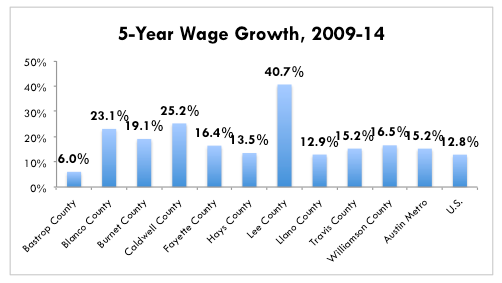
Many industries boosted their wages by more than 40% in 5 years:
- Natural Resources & Mining in Caldwell, Hays, Lee and Williamson counties;
- Construction in Caldwell and Lee counties;
- Manufacturing in Llano and Williamson counties;
- Trade, Transportation & Utilities in Blanco, Caldwell, and Lee counties;
- Information Services in Fayette County;
- Professional & Business Services in Fayette and Lee counties;
- Health Care in Llano County; and
- Leisure and Hospitality in Bastrop County.
Government wages grew the fastest in Travis County over 5 years; least in Williamson County.
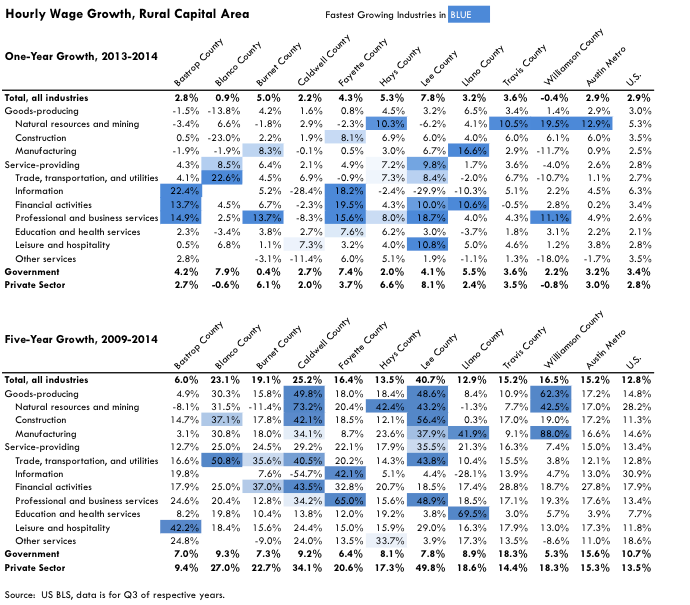
Austin is #3 Best Job Market for Women
article posted by Headlight on June 17, 2015
In 85% of large US metros, the unemployment rate of women exceeds the unemployment rate of men. But, data from the US Census shows that 8 of 52 large metros had a lower unemployment rate for women than men in 2013. This unemployment disparity was the lowest in Oklahoma City, where the female unemployment rate was 0.4 percentage points lower than that of men. Nashville, Austin, San Antonio, and Dallas rounded out the top 5 metros.
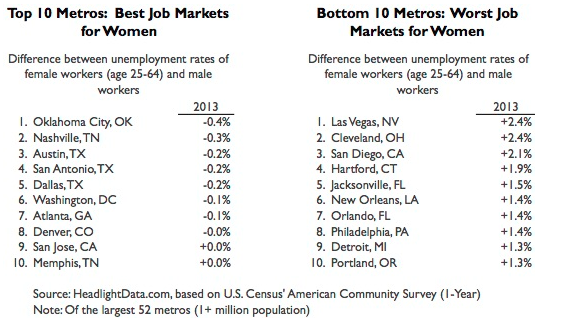
Gender equity is worst in Las Vegas, Cleveland, and San Diego, where the unemployment rate in 2013 was more than 2 percentage points higher for women than men.
From 2009-2013, many metros saw this disparity decrease. The largest decrease occurred in Detroit, where the gender difference fell by 3 percentage points. Milwaukee, Portland, Grand Rapids, and Nashville also experienced large declines in the gender gap. The least improved metro from 2009-2013 was San Francisco, which saw its gender gap increase by 1.3%. Hartford, San Diego, and New Orleans also saw large increases.

Youth Unemployment in Central Texas Remains High at 29%; Highest Youth Unemployment Rate Found in Williamson County at 37%
article posted by Headlight on June 17, 2015
The youth unemployment rate measures the portion of youth aged 16-19 years that seek work (full- or part-time) but cannot find work. Data from the US Census shows that youth unemployment rates remain higher than their pre-recession averages.
The Austin metro, despite having one of the fastest growing economies in the US, has a higher youth unemployment rate (29%) than the US average (28%). Williamson County, also one of the fastest growing counties in the US, has the highest youth unemployment rate (37%) within the Austin metro.
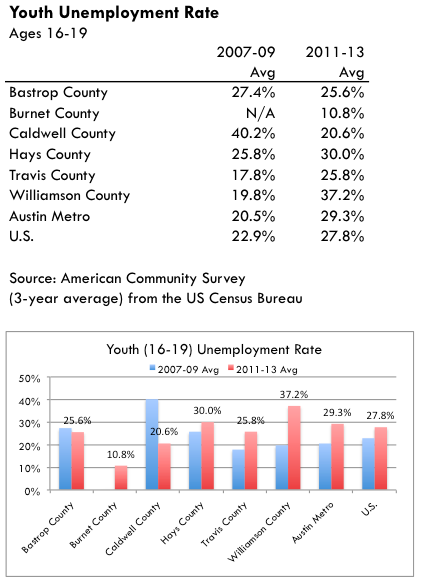
Unemployment rates are affected by job availability and the level of interest in a population in finding job, also known as the labor force participation rate. Within the Austin metro, 16-17% of youth aged 16-19 years seek employment. This participation rate is slightly lower than the US average. With lower levels of job seekers in the region's youth population, above-average rates of unemployment indicate that jobs are even harder to find for area youth than they were pre-recession.
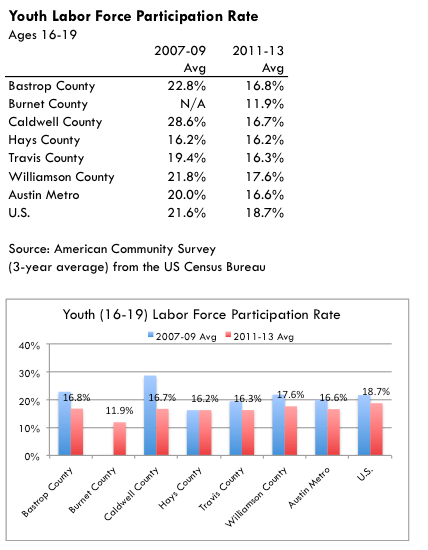
What is causing high unemployment for youth in this region? The most likely culprit is the competition for jobs from millennials relocating to the region. As more and more young adults move here, the lowest-end jobs, particularly in retail, are being taken by newcomers settling into their new life. And, with labor force participation rates down across the US, there is a latent supply of labor that is ready to re-enter the labor force when more jobs become available.
The good news is that the unemployment rate for the Rural Capital Area has been cut in half in the last 18 months and now stands at 3.5%. When more recent data for youth unemployment is released in December, we should start to see an improvement.
Economically Disadvantaged Students Account for 41% of All K-12 Students, Increasing from 34% in 2004; Largest Increase Seen in Bastrop
article posted by Headlight on June 17, 2015
Economically disadvantaged students are accounting for a large share of the Rural Capital Area region's K-12 public school population. Economically disadvantaged students are eligible for free or reduced-price lunch or other public assistance. In the 2013-2014 school year, 41% of all students were economically disadvantaged, an increase of 7 percentage points in 10 years.

Two-thirds of counties in the Rural Capital Area have more than 50% of their students in the disadvantaged category: Caldwell (71%), Bastrop (68%), Lee (61%), Burnet (60%), Llano (59%), and Fayette (52%).
Bastrop County had the highest point increase, with 19% more of the student body classified as disadvantaged in 10 years. Lee and Llano counties also saw large increases.
Williamson County has the lowest share and the lowest increase, with 30% of students categorized as economically disadvantaged students, an increase of just 5 percentage points in 10 years.

Hays and Williamson Counties Have the 1st and 5th Highest Rates of In-Migration Among 290 Medium-sized Counties in the US; All RCA Counties Are Within the Top 20% of Their Size Category
article posted by Headlight on May 13, 2015
According to new data from the US Census, the rate of net migration into RCA counties ranks high when compared to other counties in the US. Net migration measures the number of people moving into a county in a year less the people moving out.
Hays County registered the #1 highest net migration rate across all 290 medium counties in the US, attracting 37.8 new residents per 1000 existing population. Williamson County registered the 5th highest net migration for medium counties. Travis County registered the #1 highest net migration rate across mega counties with 1+ million population.
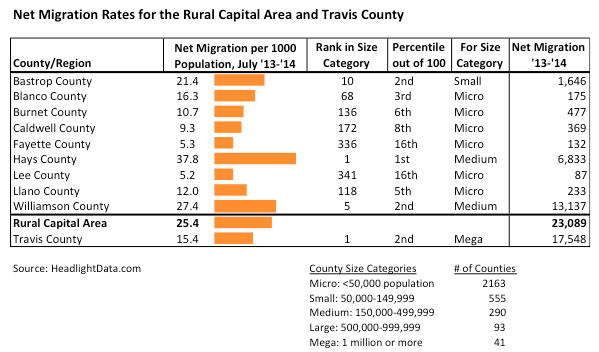
Several small counties also top the rankings: Bastrop ranks 10 out of 555 small counties, and Blanco and Llano counties are in the top 5% of micro counties.
High net migration rates across all RCA counties are clear proof of the region's attractiveness to people of all kinds. Hill Country counties such as Llano, Burnet, and Blanco are boosted by relocating retirees, Williamson and Hays counties are attracting families, and Travis county attracts a younger demographic. All RCA counties rank within the Top 20% of US counties.
Population Growth Exceeds 30,000 New People in 2014 in the Rural Capital Area; Growth Has Accelerated Since 2012
article posted by Headlight on May 13, 2015
New data released by the US Census shows that the population in the 9-county Rural Capital Area grew by 30,000 people in 2014 at a 3.4% annual growth rate (July 2013 to July 2014). The RCA growth rate is far higher than the US growth rate (0.7%) and higher than the Travis County growth rate (2.5%). High population growth boosts the Rural Capital Area economy, as new people spend money locally and employers locate to find an available workforce.
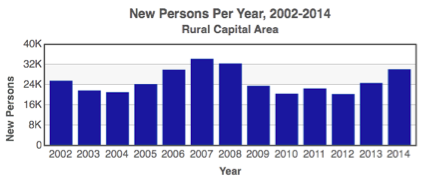
High population growth in the Rural Capital Area was driven primarily by higher levels of net in-migration, or more people moving into the region than moving out. Domestic in-migration reached nearly 22,000 people in 2014, the highest level seen in 6 years.
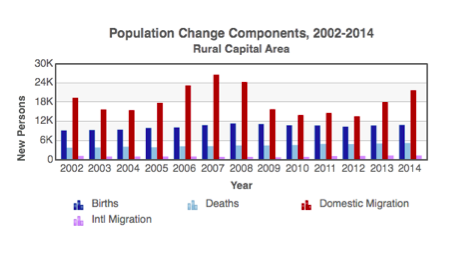
The US Census Bureau estimates that 909,000 people live in the Rural Capital Area as of July 2014, 40% more people than 10 years ago (263,000 more people).
Births Reached Nearly 11,000 in the Rural Capital Area in 2014; Birth Rates Vary from 7.3 per 1000 Population in Blanco County to 12.9 in Williamson County
article posted by Headlight on May 13, 2015
Williamson County witnessed 6,100 births in 2014 (July 2013 to July 2014), an increase of 2% over the previous year. Williamson County's birth rate ranks within the top 30% of all counties of medium size – the highest ranking of all counties in the Rural Capital Area. The birth rate measures the number of births in a county per 1000 population.
The region's micro counties, with less than 50,000 population, show a wide range of birth rates. Caldwell and Lee Counties have birth rates near 12 per 1000, which puts them in the top 40% of all micro counties. Blanco, Fayette, and Llano counties have some of the smallest birth rates in the region and US, ranking in the bottom 10% of counties of similar size. Blanco ranks toward the middle.
Bastrop and Hays counties rank slightly better than average against other small counties, with birth rates of 11.8 and 12.1, respectively. Travis County's birth rate ranked better than any RCA county, reaching 14.1 and ranking in the 27th percentile of all mega-sized counties with 1 million or more population.
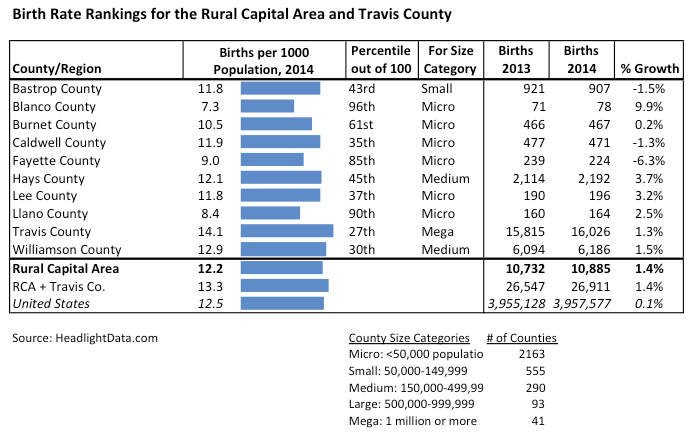
All counties witnessed more births in 2014 than the previous year with the exception of Fayette (-6% growth), Bastrop (-2%), and Caldwell (-1%). Blanco experienced the highest growth in births (10%), though levels are relatively low.
On average, the growth in births in the Rural Capital Area was slightly higher (+0.06%) than Travis County's for a rounded average of 1.4%. The US birth rate was negligibly higher, just 0.1%.
Austin Metro is #1 Growth Market for Machinery Mechanics, Electrical Engineers, Nursing Assistants, and Electronics Engineers
article posted by Headlight on April 1, 2015
Among large metros with a population of 1 million or more, the Austin 5-county metro is the fastest growing employment market for the following occupations: biochemists, machine operators and maintenance, mechanical drafters, electrical engineers, and nursing assistants. The Austin metro's ability to drive job in these occupations is further testament to the continued attractiveness to talent; all of these occupations require post-secondary educations.
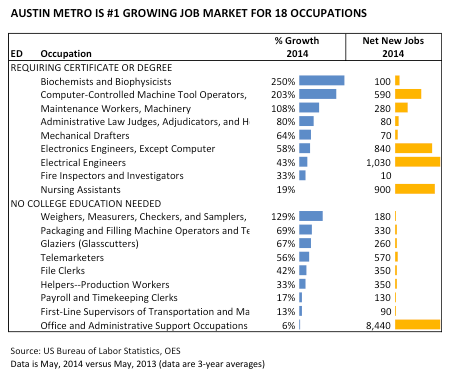
The Austin metro is also the fastest growing job market for many occupations that don't require post-secondary education. These occupations fall in the packaging/distribution industry (weighers, packaging machine operators, production helpers, transportation supervisors), construction (glaziers), and office administration (telemarketers, file clerks, payroll clerks, and office support positions).
Click here to find detailed statistics on growth by occupation.
Technical, Artistic, and Legal Professions Lead Job Growth in the Austin Metro
article posted by Headlight on April 1, 2015
New data released by the US Bureau of Labor Statistics shows a diverse mix of occupations leading local employment growth. The Biochemists and Biophysicists occupation group grew the fastest in 2014 (250%), followed by Machine Tool Operators (203%) and Geological & Petroleum Technicians (200%).
Among the 20 fastest-growing occupations in 2014, two were legal professions: Law Clerks and Judges. Two were creative: Advertising Managers and Art Directors, who likely work in the software industry. Many are production- or construction-related: Machine Tool Operators, Machinery Maintenance, Glaziers (Glasscutters), Paving Equipment Operators, Packaging Machine Operators, Metal Fabricators, and Mechanical Preparers.
Many of these production occupations not only grew at a high percentage rate, but also created hundreds of jobs throughout the region.
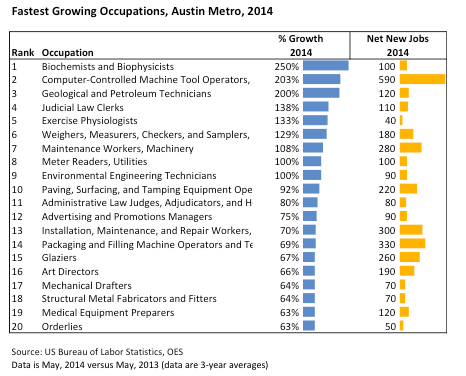
Click here to find detailed statistics on growth by occupation.
Population Growth in the Rural Capital Area Accelerates in 2014, Reaches 909,000; Hays and Williamson Counties Lead Growth
article posted by Headlight on April 1, 2015
New data released by the US Census last week reveals that population growth in the 9-county Rural Capital Area reached 3.4% in 2014 (July 2013 to July 2014). The total population increased by more than 30,000 people to total 909,000. Domestic migration was the primary driver of this growth. On a net basis, 22,000 people relocated to the region in 2014.
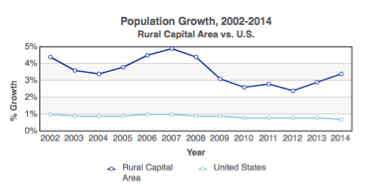
Within the region, Hays County experienced the fastest rate of growth (4.8%), followed by Williamson County (3.8%) and Bastrop County (2.6%). On an absolute basis, Williamson County added the greatest number of residents (18,000), followed by Hays County (8,500).
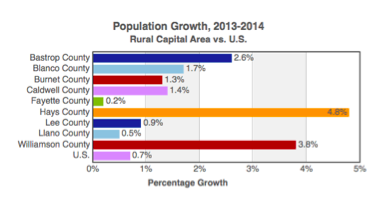
According to the US Census, Hays County's population growth was 2nd-fastest among all counties with 100,000 population or more. Williamson County's population growth was 8th fastest.
Click here to find detailed statistics on the Rural Capital Area's population growth.
The Unemployment Rate in the Rural Capital Area Falls Below 3.5%, Now at Pre-Recession Lows
article posted by Headlight on March 11, 2015
Strong job growth throughout the Rural Capital Area has led to a tightening labor market as employers struggle to find workers. Today, at 3.5%, the unemployment rate is just 0.1% higher than the lows reached in 2007-2008 before the recession hit.
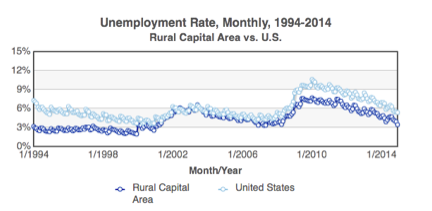
The lowest unemployment rates in the region are found in Fayette and Lee counties – both at 2.9% in December. The Austin 5-county metro has a slightly lower unemployment rate than the Rural Capital Area, but the US rate is nearly 2 percentage points higher.
The largest drops in unemployment rates since the recession (in percentage point change) were in Bastrop and Caldwell counties. These two counties, along with Lee and Williamson counties, have cut their unemployment rates by more than half in the past five years.
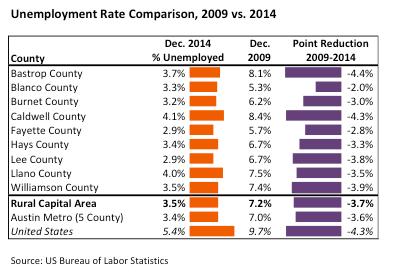
Click here to explore unemployment rate trends for the region.
The Rural Capital Area's Entrepreneurial Spirit is Strong
article posted by Headlight on March 11, 2015
While major metropolitan areas such as San Francisco and Seattle are widely celebrated for their strong entrepreneurial culture, smaller communities such as the Rural Capital Area are also home to numerous small businesses. More than 10% of Rural Capital Area residents are self-employed. This rate is higher than the Texas average and nearly equal to that of the Austin metropolitan area.
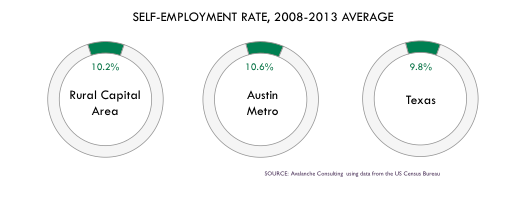
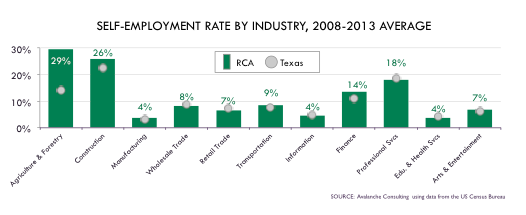
The Rural Capital Area is home to entrepreneurs in every industry imaginable. Agriculture & Forestry, Construction, and Professional Services are especially well represented. Nearly one in three farmers in the Rural Capital Area is self-employed, double the statewide average. More than a quarter of all Rural Capital Area residents working in Construction are self-employed, also higher than the Texas average. 18.2% of residents working in Professional Services such as accounting, architecture, and engineering are self-employed.
44% Of Rural Capital Area College Graduates Have Science & Engineering Degrees, Led by Williamson and Bastrop Counties
article posted by Headlight on February 10, 2015
The US Census Bureau has recently begun publishing data on the fields of study for college graduates through the American Community Survey (data below are 5-year averages through 2013). The new information provides a more granular look at educational attainment levels among communities throughout the US, including the Rural Capital Area.
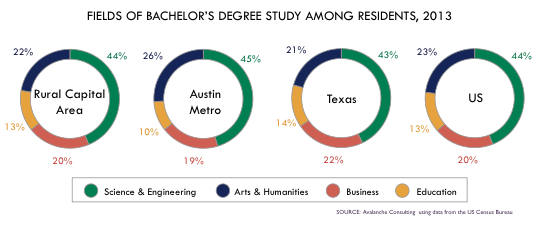
The popularity of individual fields of study among college graduates in the Rural Capital Area is virtually identical to US averages. Science & Engineering is the most widespread area of study among bachelor's degree recipients in the Rural Capital Area. Among the region's college graduates, 44% possess a degree in a Science & Engineering field. Arts & Humanities is the second most popular field of study among Rural Capital Area residents. 22% of local college graduates have an Arts & Humanities degree. 20% of Rural Capital Area residents pursued Business degrees while in college, making it the third most prevalent field of undergraduate study. 13% of college graduates living in the Rural Capital Area possess an Education bachelor's degree.
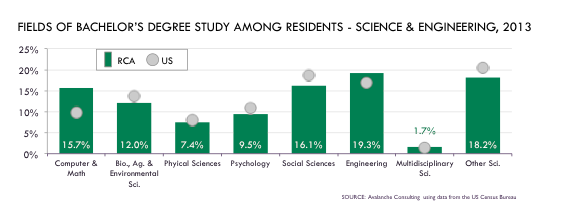
Although the overall proportion of Rural Capital Area college graduates with Science & Engineering degrees is nearly identical to the US average, there remain slight differences in areas of specialty. Rural Capital Area Science & Engineering graduates are 50% more likely to possess Computer & Math degrees. Nearly 16% of Rural Capital Area Science & Engineering graduates have a Computer & Math degree, compared to less than 10% in the US. Conversely, Rural Capital Area Science & Engineering graduates are less likely to possess a Social Sciences Science & Engineering degree. In 2013, approximately 16% of Science & Engineering college graduates in the Rural Capital Area held a Social Sciences degree, compared to nearly 20% in the US.
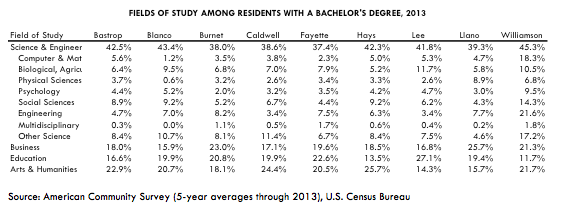
Medical, Hospitality & Retail Occupations Projected to Grow Fastest in the Next Five Years; Back Office Projected to Create the Most Jobs
article posted by Headlight on February 10, 2015
If college degree information provides a glimpse into the educational pursuits of Rural Capital Area residents, an examination of the occupations held by residents delivers an even more nuanced understanding of skills available among the local workforce.
Three occupational clusters dominate employment within the Rural Capital Area and Travis County. Back Office Services, Hospitality & Retail, and Personal Services collectively employ approximately 395,000 individuals, representing nearly 43% of all workers in the region. All three occupational clusters are 10% more concentrated within the Rural Capital Area and Travis County relative to the US average.
Other leading occupations clusters with the region include Medical (79,000 workers), Computer (65,000), and Education (60,000). Computer occupations are more than twice as concentrated in the Rural Capital Area and Travis County compared to the US average. Education employment is approximately 10% more concentrated among Rural Capital Area and Travis County workers relative to the US average.
The occupations forecast to experience the greatest level of growth within the Rural Capital Area and Travis County include both large and small clusters. Medical occupations are projected to be the fastest growing cluster in the region. Between 2014 and 2015, the number of workers in the Rural Capital Area and Travis County employed in Medical occupations is expected to increase 17%. Although it is one of the smallest clusters in the region, Architecture employment is forecast to rise 15% during the next five years. Rural Capital Area and Travis County employment in the much larger Hospitality cluster is expected to grow 14% through 2019. While other clusters are projected to post more modest growth rates, every single occupation is projected to experience an increase in employment between 2014 and 2019.

Not sure how to read a bubble chart? Click here for a how-to.
Click here to see the numbers behind the chart and a breakdown by county.
Profile: Williamson County
article posted by Headlight on February 10, 2015
 Williamson County is the most populous suburban county in the Austin metropolitan area, with a population of 471,000 people and 139,000 jobs. The county has grown much faster than the metro and U.S.: the population grew 56% from 2003-2013 and job base grew 69%.
Williamson County is the most populous suburban county in the Austin metropolitan area, with a population of 471,000 people and 139,000 jobs. The county has grown much faster than the metro and U.S.: the population grew 56% from 2003-2013 and job base grew 69%.
According to estimates from the Census, Williamson County is well-educated: 93% of residents have at least a high school degree and 38% have a Bachelor's degree or higher. These educational attainment statistics are significantly higher than both the State of Texas (81% high school, 26% Bachelor's) and the U.S. average (86% high school, 29% Bachelor's). (American Community Survey, Williamson County)
Williamson County's median household income has remained above the national average for many years, and was 139% of U.S. median household income in 2012.
The Williamson County unemployment rate has fallen from its recent high of 7.3% in 2009 to 5.9% in 2012. The county rate has been consistently lower than the U.S. rate.
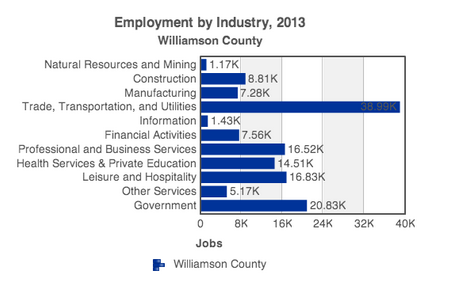 The largest industries in Williamson County are:
The largest industries in Williamson County are:
• Trade, Transportation, & Utilities – 28% of county employment
• Government – 15%
• Leisure & Hospitality -12%
• Professional & Business Services – 12%
• Health Services – 10%
Read Williamson County's full profile here.
Where the Jobs Will Be: Rural Capital Area Edition
article posted by Headlight on January 14, 2015
A new year brings new employment projections. Although 2015 has barely begun, we can already begin looking ahead and identifying employment sectors that will support additional job growth throughout the Rural Capital Area.
Over the next five years, nearly all employment clusters in the Rural Capital Area are projected to experience employment gains. Private Education is expected to be the single fastest growing employment cluster in the region (most education employment is accounted for in Government). Between 2014 and 2019, the number of Private Education jobs in the Rural Capital Area is expected to rise more than 27%. Two manufacturing clusters, Automotive and Furniture, are also projected to support strong job growth at 23% and 22%, respectively. Additional sources of job growth include traditional areas of strength in the Rural Capital Area such as Research (20% growth), Health Care (20%), and Transportation & Logistics (20%).
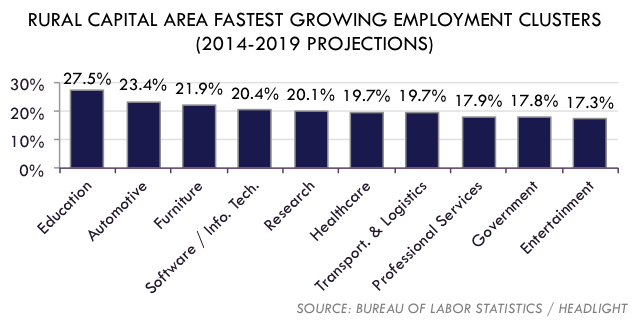
Due to their relatively large size, many slower growing employment clusters are projected to create the largest number of new jobs within the Rural Capital Area through 2019. Retail employment is expected to increase by more than 8,750 jobs during the next five years. Industrial Machinery Manufacturing and Health Care are also expected to create a significant number of jobs within the Rural Capital Area, at 6,100 and 5,500, respectively. Both Construction and Back Office Support clusters are projected to create more than 2,000 jobs each.

Strong job growth among some of the leading employment clusters within the Rural Capital Area will further solidify existing strengths. With an LQ of 3.1, Industrial Machinery Manufacturing is already one of the most relatively concentrated employment sectors within the Rural Capital Area. With an LQ of 1.3, Retail employment in the region is 30% more concentrated compared to the US average. Furniture Manufacturing, which is also expected to enjoy strong growth through 2019, is 20% more concentrated compared to the US average. Other relatively concentrated employment clusters include Mining & Logging (3.3 LQ) and Construction (1.5 LQ). Government, Energy, Aerospace, & Electronics Manufacturing are also more concentrated in the Rural Capital Area compared to the US average.
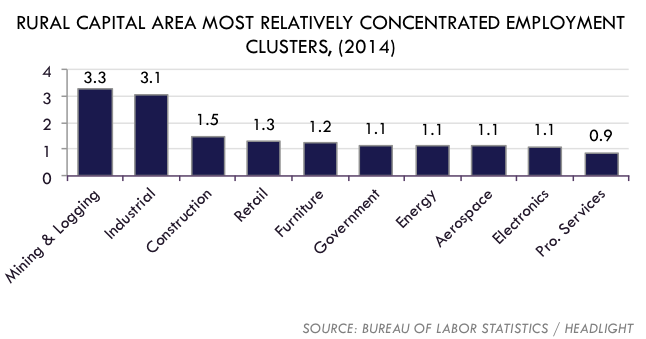
Click here to see the industry cluster bubble charts or tables on detailed industries.
Education Pays in the Rural Capital Area
article posted by Headlight on January 14, 2015
With the cost of higher education continuing to soar, some observers have begun to question the value of a college degree. The average cost of attending a private college now exceeds $30,000 annually. Is it worth it?
Recently published data from the US Census Bureau clearly demonstrates the value of a college education. This is especially true in the Rural Capital Area. Without exception, unemployment rates for college graduates in Rural Capital Area counties are lower than the unemployment rates for individuals with a high school diploma. In Bastrop County, for example, the unemployment rate for college graduates is less than half that of high school graduates (10.1% versus 3.8%). In Caldwell County, the unemployment rate for high school graduates is nearly three times higher than those with a high school diploma. Even in Hays County, which has a proportionally large population of recently graduated students, college graduates outperform their less educated peers in the job market.
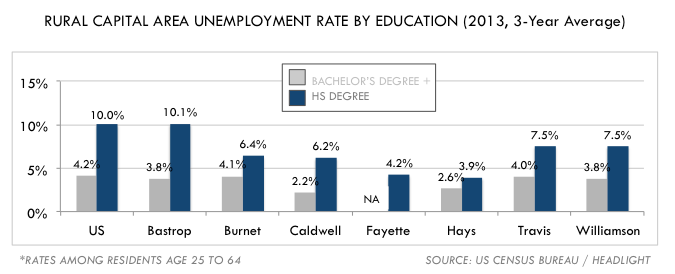
Since the recession, the unemployment rate for individuals with only a high school degree has fallen farther than the rate for college graduates – primarily due to the higher starting unemployment rate for high school graduates. In Caldwell County, for example, the unemployment rate of high school graduates declined more than 7 percentage points between 2011 and 2013 (years are trailing 3-year averages). Travis County witnessed the second-largest point drop for high school grads. Bastrop County saw its unemployment rise for both education levels.
Even at the height of the recession, college graduates fared well. There wasn't a single county in the Rural Capital Area where the unemployment rate of college graduates surpassed 4.5%. Additionally, many college educated individuals in the Rural Capital Area must compete with the continual influx of talent that migrates to the region each year. Still, there can be no doubt that education pays in the Rural Capital Area.

The Rural Capital Area's Limited English Proficiency Population
article posted by Headlight on January 14, 2015
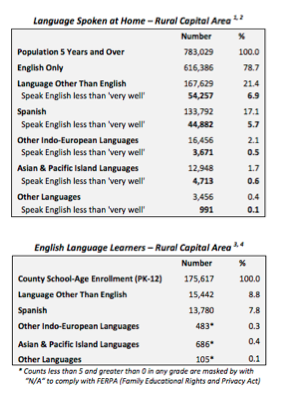 Newly published data by the US Census Bureau provides new insight on the size of the limited English proficiency (LEP) population living in the Rural Capita Area.
Newly published data by the US Census Bureau provides new insight on the size of the limited English proficiency (LEP) population living in the Rural Capita Area.
English is the only language spoken at home for nearly 80% of individuals age 5 and older living in the Rural Capital Area. Approximately 17% of the area's population resides in homes where Spanish is spoken. Contrary to many stereotypes, Spanish speaking households are typically home to people with excellent English speaking abilities. In the Rural Capita Area, for example, nearly 95% of individuals living in Spanish speaking homes speak English “very well.â€
While Spanish remains the predominant second language in the Rural Capital Area, Asian languages are growing in importance. According to the report, “Chinese and Vietnamese LEP speakers in Williamson County have passed the critical ‘1,000 LEP speaker' threshold signifying a significant LEP population.â€
For more information on the Rural Capital Area's limited English proficiency population, click here to see the full report from Workforce Solutions.
Profile: Lee County
article posted by Headlight on January 14, 2015
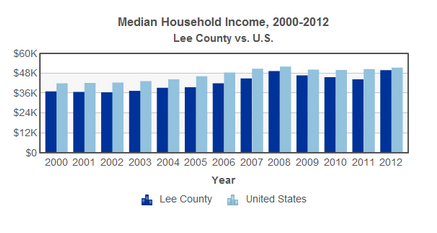 Lee County is a small county in central Texas, with a population of 16,600 people and 6,500 jobs. The county's population grew just 3% from 2003-2013 and job base grew 28%.
Lee County is a small county in central Texas, with a population of 16,600 people and 6,500 jobs. The county's population grew just 3% from 2003-2013 and job base grew 28%.
Lee County's median household income was below the national average from 2002-2012, and was 97% of U.S. median household income in 2012.
Lee County has had average economic growth over the past decade, generally mirroring U.S. growth rates. Lee County struggled slightly with the recession, losing 240 jobs in 2009, enjoyed a sizable job creation rate from 2010 to 2012, and lost 14 jobs in 2013.
The Lee County unemployment rate has fallen from its recent high of 6.6% in 2010 to 4.7% in 2013. The county rate has been consistently lower tha n the U.S. rate.
n the U.S. rate.
The largest industries in Lee County are:
- Construction– 24% of county employment
- Government – 19%
- Trade, Transportation, and Utilities – 18%
- Natural Resources and Mining – 10%
- Manufacturing – 7%
Read Lee County's full profile here. Poverty Rates in the Rural Capital Area are Highest and Increasing for Children; Retiree Poverty Rate is Falling; Poverty for Females is Higher
article posted by Headlight on December 10, 2014
Poverty rates in the Rural Capital Area have been historically lower than the US average: latest available figures for all 9 counties show that the RCA poverty rate of 11.4% in 2012 was 4.5 percentage points lower than the US rate of 15.9%. Child poverty in the RCA is 33% higher than the overall rate, while the US child poverty rate is 42% higher than the US average for all ages.
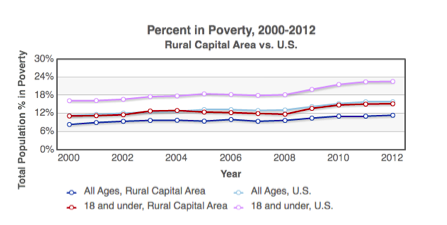
New data from the American Community Survey provides a deeper examination of poverty trends in the Rural Capital Area. While only 6 of 9 counties have data published by the Census Bureau (small populations in some counties limit the availability of granular statistics), clear trends emerge:
- Children have the highest poverty rate of all age groups: Child poverty stands at 14% in 2013, an increase from 12.9% in 2010.
- Poverty for retirees is quite low and falling: Just 5.9% of residents 65 or older are in poverty, a slight decline from 6.4% in 2010.
- Poverty rates are growing fastest for the working-age population: Residents 18-64 years of age saw poverty rates increase 11% over three years, while children saw poverty rates increase 9%; retiree poverty rates fell 1%.
Poverty rates between genders show some variation. The male poverty rate is 10.9%, while female poverty is 12.2%. The increase in poverty was comparable for each gender over the last three years.
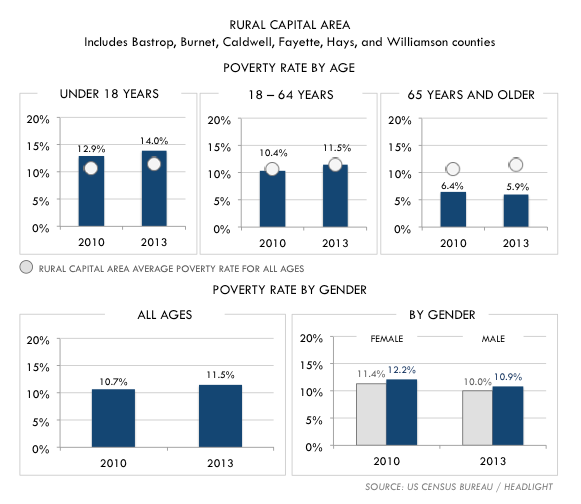
Affordability in the Rural Capital Area Is Increasingly Affected by Longer Commutes, Rising Housing Costs
article posted by Headlight on December 10, 2014
Affordability is a complex issue with many influencing variables – from education levels, to access to jobs, to cost of living. In the Rural Capital Area, several trends point to a slight worsening in affordability:
- Rental costs are rising. The number of renters that spend 30% or more of their income on housing (a federal affordability threshold) is growing. 65% of Hays County renters now spend above this threshold (which is driven in part by the large student population), versus 48% for the US on average. Change in affordability since 2010 varies by county, with some counties worsening (including Hays) and others improving, such as Bastrop.
- Longer commute times represent a hidden cost to affordability. As congestion worsens, workers spend more time in traffic and spend more money on gasoline and car maintenance. 47% of Hays County workers commute 30 minutes or more each day, versus 35% for the typical US worker. 41% of Williamson County residents commute 30 minutes or more, an increase from 38% in 2010.
Some trends point to improvements in affordability:
- Health insurance coverage is improving. With the Affordable Care Act and falling unemployment rates, more and more residents are enjoying health care coverage. Variations across counties continue: While 85% of Williamson County residents have insurance coverage, just 77% have coverage in Bastrop County.
- Education levels are improving. Residents are becoming more educated across all counties with few exceptions, which should lead toward higher paying jobs, better affordability, and lower poverty rates.
We will continue to monitor metrics that influence the affordability of our region as our economic growth continues.
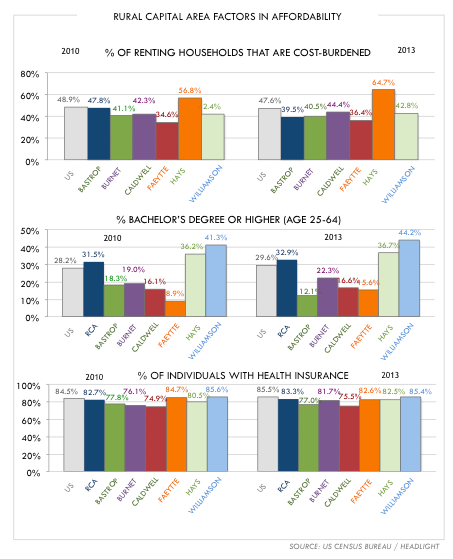
Rural Capital Headlight's Top 10 Articles of 2014
article posted by Headlight on December 10, 2014
Profile: Rural Capital Area
article posted by Headlight on November 4, 2014
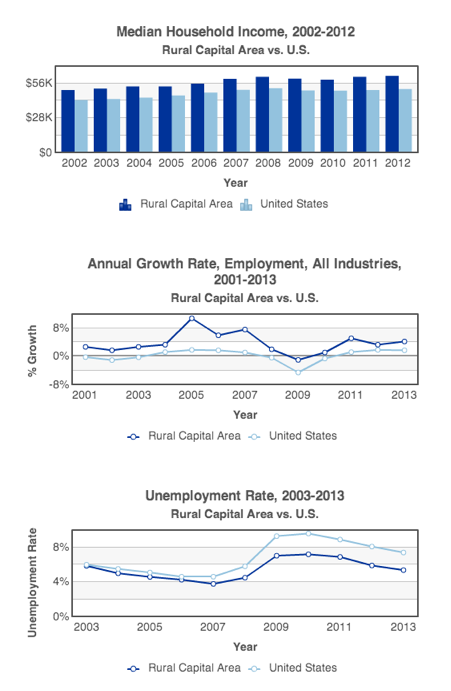 The Rural Capital Area has an overall population of 878,000 people and 253,000 jobs. The area has grown faster than the U.S.: the population grew 40% from 2003-2013 and job base grew 51%.
The Rural Capital Area has an overall population of 878,000 people and 253,000 jobs. The area has grown faster than the U.S.: the population grew 40% from 2003-2013 and job base grew 51%.
The Rural Capital Area's economy has performed very well over the past decade, creating new jobs every year except one. The Rural Capital Area has weathered the recession well, losing just 2,300 jobs in 2009 and adding 29,000 jobs from 2011 to 2013.
The Rural Capital Area unemployment rate has fallen from a peak of 7.2% in 2010 to 5.2% in 2013. The area rate has been consistently lower than the U.S. rate.
The largest industries in the Rural Capital Area are:
• Trade, Transportation, and Utilities – 26% of area employment
• Government– 18%
• Leisure and Hospitality – 13%
• Health Services – 11%
• Professional and Business Services– 9%
Read Rural Capital Area's full profile here.
Unemployment Insurance Compensation, Earned Income Tax Credit Payments Decline as the Rural Capital Area's Economy Continues to Gain Momentum
article posted by Headlight on November 4, 2014
The Rural Capital Area's economy proved relatively resilient during the recession. Even at the height of the economic downturn, job losses in the Rural Capital Area proved relatively small compared to the nation as a whole. Throughout the recession, the Rural Capital Area's unemployment rate remained lower than the US average.
Despite the relative strength of the Rural Capital Area, however, thousands of workers within the region either lost their jobs or suffered significant reductions in income during the recession. In 2007, prior to the recession, unemployment insurance payments within the Rural Capital Area were less than $35 million. By 2010, such payments exceeded $185 million. Earned income tax payments experienced a similar increase. The program, which is available to employed workers with low to moderate incomes, disbursed approximately $75 million in 2007. In 2010, Rural Capital Area residents received more than $115 million in earned income tax credits.
Since the recession, growth throughout the Rural Capital Area has helped create new job opportunities for unemployed residents and allowed low- to moderate-income workers to increase their earnings. In 2012, earned income tax credit payments within the Rural Capital Area declined for the first time in five years. Unemployment insurance payments in the Rural Capital Area fell 16.5% between 2011 and 2012, the second consecutive decline. As the Rural Capital Area's economy continues to gather steam, further declines in unemployment insurance payments and earned income tax credits will likely be even more pronounced.
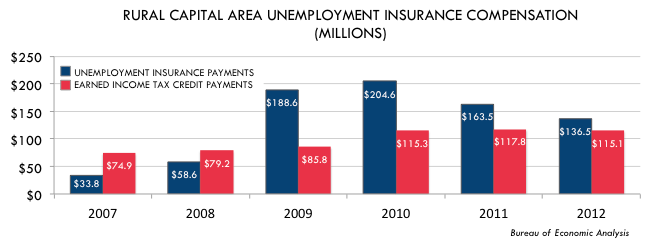
TWC Launches Veteran and Industry Partnership
article posted by Headlight on November 4, 2014
The Veteran and Industry Partnership (VIP) program is a new training initiative designed to help veterans and their spouses get the advanced training they need for employment in an information technology occupation. Austin Community College (ACC) will administer the VIP training for the information technology occupations and the training will be provided on an accelerated basis, with an emphasis on immediate job placement upon completion and at no cost to the veteran or spouse.
Training programs offered include: Computer User Support Specialists, Network Administrators, Web Developers, and Information Security Analysts. For more information, contact:
Heather Bonham, Austin Community College
512-223-0128
hbonham@austincc.edu
TWC Awards More Than $60 million for Adult Education and Literacy Programs
article posted by Headlight on November 4, 2014
This press release is from the Texas Workforce Commission.
AUSTIN – The Texas Workforce Commission (TWC) awarded more than $60 million in state and federal funding to a network of 35 education, workforce and non-profit entities to deliver enhanced Adult Education and Literacy (AEL) services across the state. Funding these programs marks the final phase of the AEL program's transition from the Texas Education Agency to TWC.
“Education and skills attainment are key to the continued success of the Texas workforce and economy,†said TWC Chairman Andres Alcantar. “At TWC we are committed to building partnerships that continue to provide high quality adult education opportunities along with implementing innovative and integrated learning and skills training models. I congratulate these new grantees.â€
The programs funded will include adult basic education, high school equivalency preparation, English as a Second Language services, and a family and financial literacy curriculum, as well as distance learning options to increase access to the programs. These programs must provide transition and career pathway programs in collaboration with community colleges, employers or other training providers.
“These programs will allow hard working Texans to improve their skills and their careers,†said TWC Commissioner Representing Labor Ronny Congleton. “I urge Texans interested in accessing these programs to contact their local Workforce Solutions office for more information.â€
TWC allocated an additional $2.1 million across the provider network to support system integration and quality of services for local professional development services.
“Employers need educated, skilled workers to ensure success in their ventures and Adult Education and Literacy efforts throughout the state are preparing skilled and work-ready individuals for the workforce,†said TWC Commissioner Representing Employers Hope Andrade. “TWC is proud to work with our local partners as we move forward with these integrated and enhanced programs.â€
Hiring Red, White & You! Statewide Hiring Fair
article posted by Headlight on November 4, 2014
Veterans and spouses, join the Texas Workforce Commission, Workforce Solutions Rural Capital Area and their partners for the Hiring Red, White & You! statewide hiring fair. The fair is designed to connect Texas veterans and spouses with area employers looking for qualified candidates to fill a variety of positions.
The event will take place at the United Heritage Center at the Dell Diamond, 3400 E. Valley Blvd. in Round Rock, Texas on November 13, 2014 from 9 am to Noon.
This event is hosted by Workforce Solutions Rural Capital Area. For more information, call (512) 244-2207, ext 1049.
Manufacturing Boom Propels Rural Capital Area Employment to New Heights
article posted by Headlight on November 4, 2014
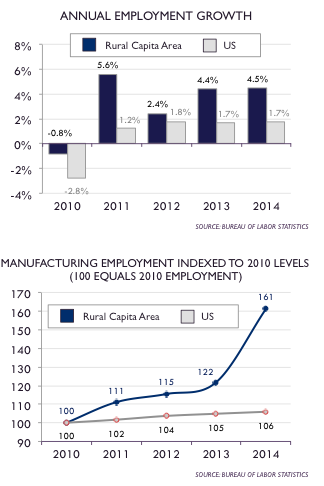 Employment in the Rural Capital Area totaled nearly 260,000 in the first quarter of 2014. On a year-over-year basis, job growth in the Rural Capital Area reached 4.5%, more than twice the rate of overall employment growth in the US. The Rural Capital's rate of job creation has exceeded the US average every year since 2011.
Employment in the Rural Capital Area totaled nearly 260,000 in the first quarter of 2014. On a year-over-year basis, job growth in the Rural Capital Area reached 4.5%, more than twice the rate of overall employment growth in the US. The Rural Capital's rate of job creation has exceeded the US average every year since 2011.
Employment gains within the Rural Capital Area have been broad-based, with job creation occurring in virtually every industry. The performance of the Rural Capital Area's Manufacturing sector, however, has been especially remarkable.
Between Q1 2013 and Q1 2014, Rural Capital Area manufacturing created nearly 5,000 jobs, an increase of more than 30%. Manufacturing employment in the Rural Capital Area is now 60% higher than in 2010. The growth of manufacturing in the Rural Capital Area was 10 times greater than the national average between Q1 2010 and Q1 2014.
Texas Labor Force Exceeds 13 Million in September 2014
article posted by Headlight on November 4, 2014
This press release is from the Texas Workforce Commission.
AUSTIN – Labor market figures released by the Texas Workforce Commission (TWC) today showed that in September 2014, the seasonally adjusted civilian labor force in Texas exceeded 13 million individuals for the first time ever, at 13,005,600. The civilian labor force comprises those individuals in Texas either working or looking for work.
“This milestone is the latest positive news for the Texas economy,†said TWC Chairman Andres Alcantar. “Our skilled, diverse, and growing civilian labor force is key to the successful business climate that makes Texas the best place to live, work, and grow a business. I'm proud of the Texas workforce.â€
Texas' unemployment rate, which is the percentage of the civilian labor force that is unemployed, was 5.2 percent in September, down from 6.3 percent over the year and below the national unemployment rate of 5.9 percent. The civilian labor force first exceeded 12 million individuals in July of 2009.
“There is no limit to what we can accomplish with a labor force of 13 million hardworking Texans,†said TWC Commissioner Representing Labor Ronny Congleton. “Our mission is to ensure that every one of them either has a good job or can find one. With a strong economy and local partners committed to helping job seekers, we can make that happen.â€
The growth in Texas' civilian labor force has coincided with growth in businesses and jobs. Over the last year, every major industry in the state has shown positive growth, with seven major industries growing at or above 3.0 percent. There are currently nearly 485,000 employers in Texas.
“A milestone civilian labor force in Texas is a tremendous economic asset as we expand our pipeline of skilled, work-ready individuals for Texas employers as they continue to grow and create jobs here in the Lone Star State,†said TWC Commissioner Representing Employers Hope Andrade.
Job seekers can visit www.WorkInTexas.com, the premier job search engine for Texas, and can also visit their local Workforce Solutions office (which can be found on the Locations page at www.texasworkforce.org).
Employment estimates released by TWC are produced in cooperation with the U.S. Department of Labor's Bureau of Labor Statistics. All estimates are subject to revision. To access this and more employment data, visit www.tracer2.com.
Texas Adds 20,100 Jobs in August
article posted by Headlight on October 8, 2014
This press release is from the Texas Workforce Commission.
AUSTIN – The Texas labor market added 20,100 seasonally adjusted total nonfarm jobs in August. Over the year, employers expanded their payrolls by 395,200 total non-farm jobs.
The unemployment rate was 5.3 percent in August, up slightly from 5.1 percent in July. It remained below the national unemployment rate of 6.1 percent.
“Texas added 20,100 jobs in August, with the private sector showing steady monthly growth for well over four years,†said Texas Workforce Commission (TWC) Chairman Andres Alcantar. “We encourage Texas veterans to visit their local Workforce Solutions office to take advantage of the many tools and services that allow them to translate their military skills and experience into good-paying civilian jobs.â€
Goods Producing industries in Texas accounted for a majority of the growth in August. Construction added 6,900 jobs over the month. Manufacturing employers added 1,800 jobs in August. Mining and Logging increased by 4,500 jobs, and notably grew by 9.1 percent over the last 12 months.
“We're seeing growth in several service industries including Education and Health Services, which increased by 7,500 positions in August,†said TWC Commissioner Representing Labor Ronny Congleton. “Texas boasts a quality skilled labor force, and I encourage those looking for new opportunities to visit WorkInTexas.com.â€
Professional and Business Services industries led the way in jobs added over the month, expanding by 8,700 positions. Annual growth in this industry was up to 5.0 percent in August.
“Every major industry in Texas showed positive annual growth and Texas employers added 395,200 jobs over the year, achieving an annual growth rate of 3.5 percent,†said TWC Commissioner Representing Employers Hope Andrade. “I commend Texas employers for continuing to grow their investments in the Lone Star State.â€
The Midland Metropolitan Statistical Area (MSA) had the lowest August unemployment rate in the state at 2.8 percent. The Odessa MSA came in second at 3.4 percent and the Amarillo MSA ranked third at 4.0 percent (not seasonally adjusted).
Profile: Hays County
article posted by Headlight on October 8, 2014
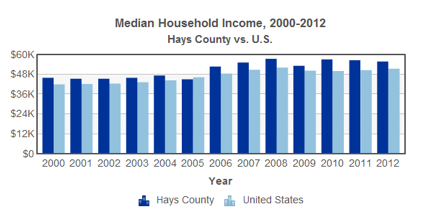 Hays County is a populous suburban county in the Austin metropolitan area, with a population of 176,000 people and 55,000 jobs. The county has grown faster than the metro and the U.S.: the population grew 51% from 2003-2013 with the job base growing 49%.
Hays County is a populous suburban county in the Austin metropolitan area, with a population of 176,000 people and 55,000 jobs. The county has grown faster than the metro and the U.S.: the population grew 51% from 2003-2013 with the job base growing 49%.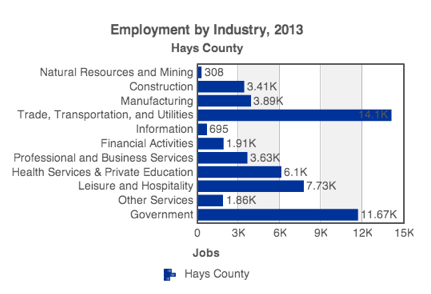
According to the Census, Hays County is well-educated: 90% of residents had at least a high school degree and 38% had a Bachelor's degree or higher. These educational attainment statistics are higher than both Texas' average (81% High School, 26% Bachelor's) and the U.S. average (86% high school, 29% Bachelor's). (American Community Survey, Hays County)
Hays County's median household income remained just above the national average for many years, and was 109% of U.S. median household income in 2012.
The largest industries in Hays County are:
• Trade, Transportation, and Utilities – 26% of county employment
• Government– 21%
• Leisure and Hospitality– 14%
• Health Services – 11%
• Manufacturing– 7%
Read Hays County's full profile here.
Labor Force Participation Rates Rebound Since Recession, Exceed US Levels
article posted by Headlight on October 8, 2014
One measure of an economy's strength is its ratio of workers to population. The more income-generating workers live in an area, the higher the consumer spending levels and tax revenue. The labor force participation rate (workers/population) in the Rural Capital Area in 2013 stood at 48.4%, or 48 workers (either employed or unemployed) per 100 residents. By comparison, the US rate was much lower: 45.5%.
The labor force participation rate is affected by the number of people who choose to be in the workforce, as well as the demographics of the population. The rate is lower when an area has higher numbers of stay-at-home spouses, children, and retirees, but also by the number of “discouraged†workers – those that drop out of the labor force when they can't find a job.

Trends in the participation rate point towards a steady decline over the last 10 years for both the Rural Capital Area and US. When the recession hit, the US witnessed a significant drop in its participation rate, from 48.5% in 2007 to 45% three years later. The Rural Capital Area experienced only a modest drop – an indication that the economy remained relatively strong and few discouraged workers left the workforce.
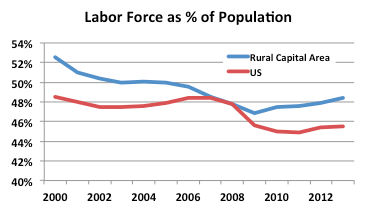
Much of the decline in the participation rate in the Rural Capital Area can be attributed to the growth in the child, youth, and retiree populations. As shown in the table below, the retiree population grew fastest over the last five years in Williamson County (119%), Hays County (96%), and Blanco County (88%). Several counties have surprisingly low growth in children and youth (less than 25 years of age): Blanco (0%), Fayette (2%), and Llano (4%).
Overall in the Rural Capital Area, the retiree population grew more than twice as fast as the children and youth demographic (71% versus 32%). The overall size of the working age population is growing faster than the children and youth population – a good sign that productivity in the Rural Capital Area will continue to grow.
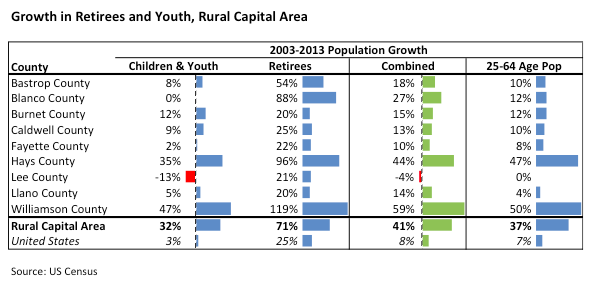
Regional Trends: Monthly Unemployment
article posted by Headlight on October 8, 2014
Recent headlines point to a sizable drop in the US unemployment rate this year. How has the Rural Capital Area performed? The Bureau of Labor Statistics (BLS) releases monthly unemployment estimates that tell how many people are looking for jobs and how many people are actively participating in the workforce. The unemployment rate in the Rural Capital Area in August 2014 was 4.7%, much lower than the US rate of 6.3%.

The unemployment rate has slowly declined in the Rural Capital Area from a peak of 7.7% (when 30,000 were unemployed) in January 2010. Currently 21,500 workers are unemployed in the Rural Capital Area.
Unemployment rates show some variation within the Rural Capital Area. The counties with highest unemployment rates are Caldwell County (5.6%), Bastrop County (5.4%), and Llano County (5.1%). Rates are lowest in Fayette County (3.8%) and Lee County (4.0%). These low unemployment rates are reflective of the strong employment growth seen across the region and tightening labor markets.
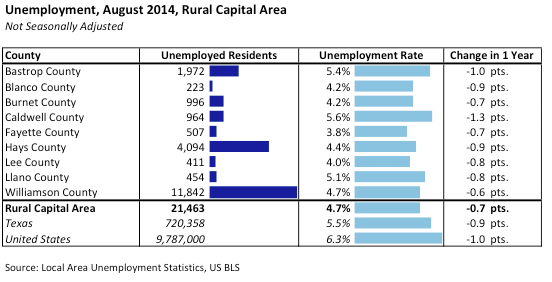
Rural Capital Child Care Services has Open Enrollment for Subsidized Child Care
article posted by Headlight on September 9, 2014
Rural Capital Child Care Services has OPEN ENROLLMENT for Subsidized Child Care for children 0-12 years old. The Rural Capital Board provides access to long term, full year, child care assistance to parents who meet the federal and state eligibility requirements found on the Board's website: http://www.workforcesolutionsrca.com/child-care/parents/
Unfortunately we do not reach every parent who may be eligible for these important services. So, we need your help. Please help us get the word out to the parents who may be eligible in your communities.

Growth in Bachelor's Degrees Led by Health Care and Science & Engineering in the Rural Capital Area & Travis County; Associate Degree Growth Led by Transferrable Liberal Arts Degrees and Health & Social Work
article posted by Headlight on September 9, 2014
From 2008 to 2013, 4-year bachelor's degree output in the region increased by:
- 410 Health Care additional graduates (46% growth)
- 390 Engineering graduates (27%)
- 180 Family Development graduates (31%), and
- 160 Software graduates (26%)
Health Care was the #1 fastest-growing bachelor's degree cluster in both total increase in graduates and percentage growth. Several small degree clusters led growth on a percentage basis:
- Agriculture: 195 bachelor's graduates in 2013 and 36% growth in 5 years
- Mathematics: 318 graduates, 34% growth
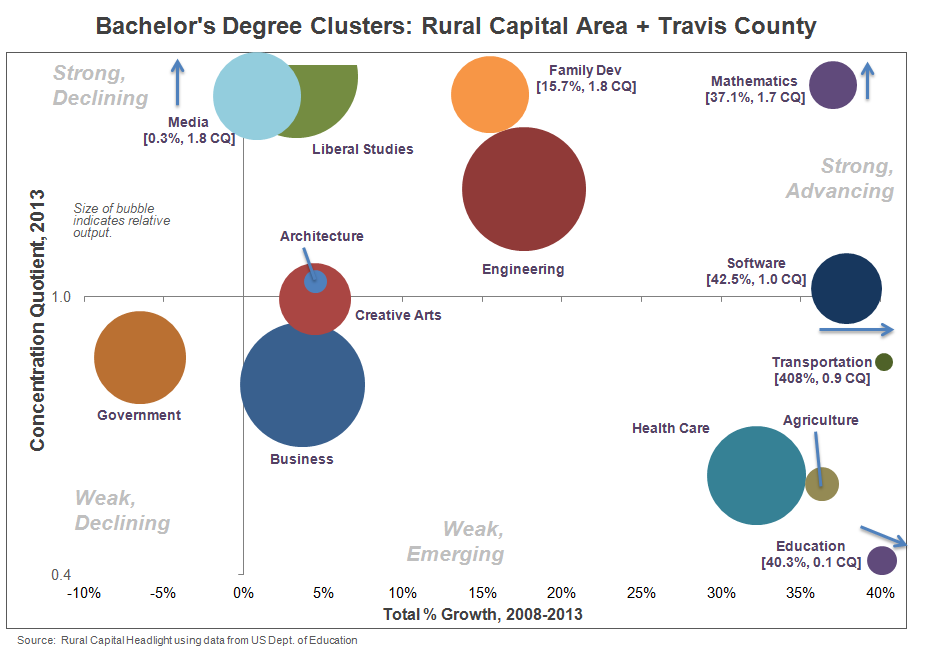
For 2-year associate degrees, topline increases were led by Liberal Arts (728 additional graduates for 32% growth), a sign that more students are receiving an associate degree and plan to transfer to complete a 4-year degree. Other high-growth associate degree clusters are:
- Health Care, with 300 additional graduates (33% growth)
- Government & Social Work, with 160 additional graduates (61% growth)
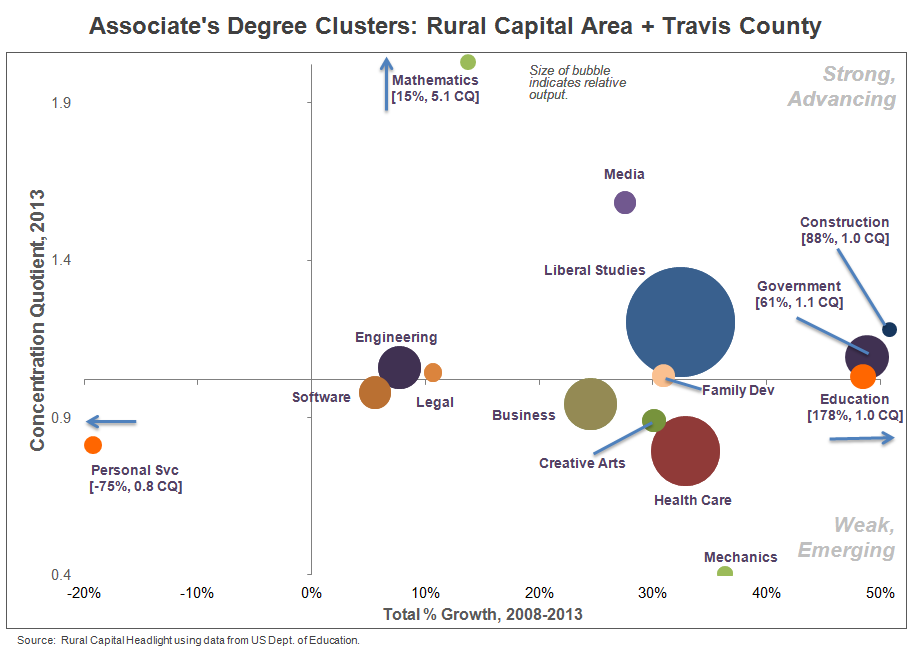
See the full data in the table below:
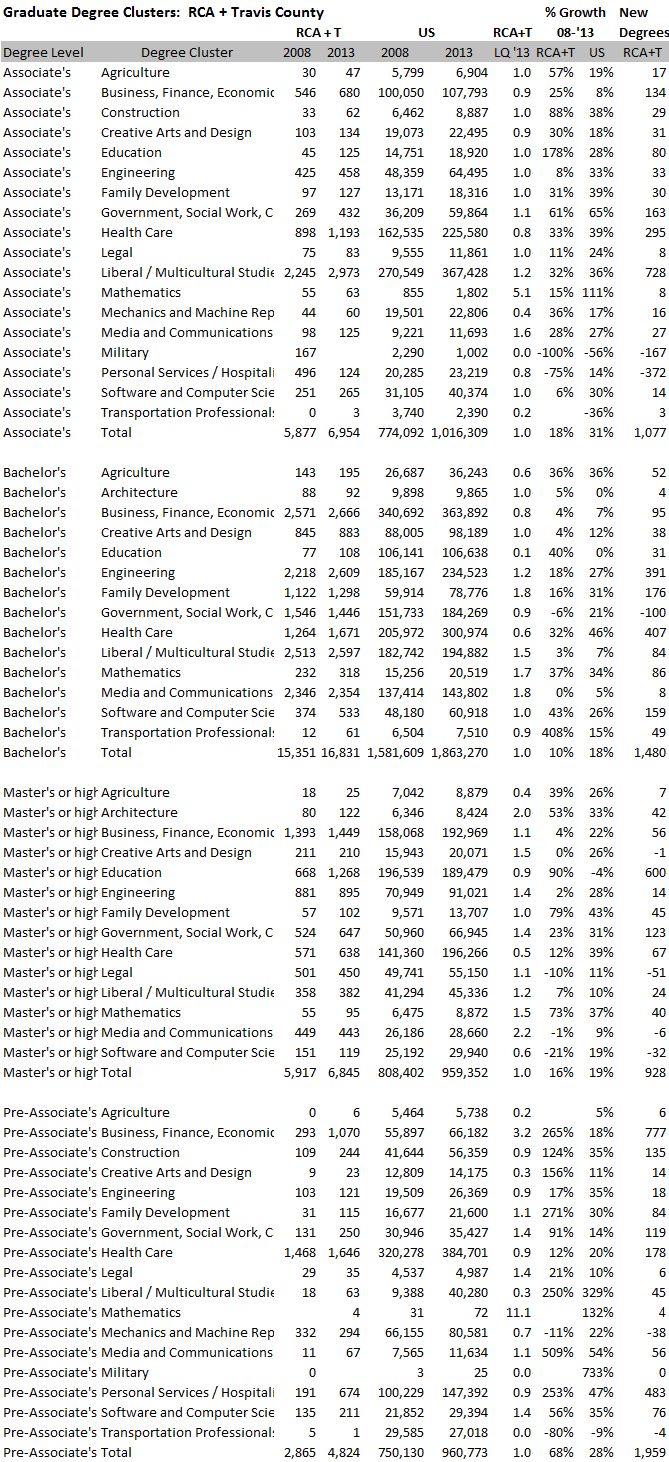
View additional charts on clusters by degree level in the Rural Capital Area here.
College Graduate Output at Institutions in the Rural Capital Area and Travis County Reaches Nearly 36,000 Graduates in 2013, Grows 2.7%
article posted by Headlight on September 9, 2014
Across institutions serving the 9-county Rural Capital Area and Travis County, the output of graduating students reached an all-time high in 2013 at 35,700 graduates. Growth in graduate output has slowed somewhat in recent years, increasing by nearly 1,000 graduates in 2013, a 2.7% growth rate.
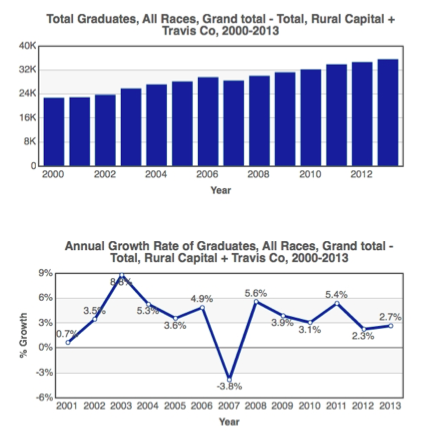
In the last 10 years, the output of graduates has increased 40%, delivering 10,000 new graduates into the central Texas economy. At the award level, certificates of 1-2 years grew the fastest in 2013 (8%), followed by bachelor's degrees (5%) and master's degrees (3%). The number of short-term certificates fell the most, by 16% over 2012, and associate degrees fell 1%.
Over a 10 year period, most growth in topline degree output has been driven by expansion of bachelor's programs. However, certificates of 1-2 years grew by 126% over ten years, followed by associate degrees (59%) and certificates of less than 1 year (44%).

Visit Rural Capital Headlight to see degree trends by individual institution, major, and award level.
Note: The 10-county regional aggregation includes the following institutions that serve the Rural Capital Area and Travis County: The University of Texas at Austin, Austin Community College District, Southwestern University, Texas State University-San Marcos, Concordia University Texas, Huston-Tillotson University, Saint Edward's University, Blinn College, Central Texas College, Temple College, Victoria College, Allied Health Careers, ITT Technical Institute-Austin, Southern Careers Institute Inc, Southwest Institute of Technology, Virginia College-Austin, Capitol City Careers, Capitol City Trade and Technical School, Everest Institute-Austin.
Profile: Burnet County
article posted by Headlight on September 9, 2014
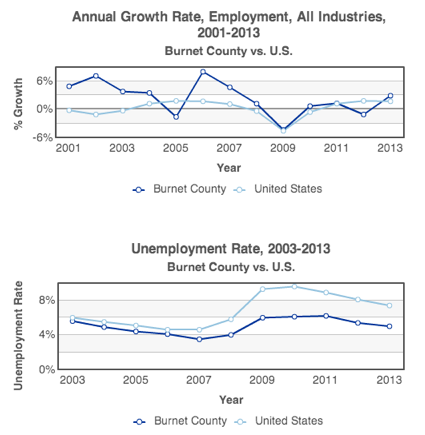 Burnet County is a mid-sized suburban county in central Texas, with a population of 43,800 people and 12,600 jobs. The county's population grew 14% from 2003-2013 and job base grew 16%.
Burnet County is a mid-sized suburban county in central Texas, with a population of 43,800 people and 12,600 jobs. The county's population grew 14% from 2003-2013 and job base grew 16%.
According to the Census, 85% of Burnet County residents had at least a high school degree and only 22% had a bachelor's degree or higher. These educational attainment statistics are slightly lower than the U.S. average (86% high school, 29% bachelor's). (American Community Survey, Burnet County)
Burnet County's median household income has remained slightly under national averages for the past decade, and was 97% of the US level in 2012.
Burnet County's economy has performed well over the past decade, creating new jobs every year except three. Burnet County has weathered the recession moderately well, losing 560 jobs in 2009 but gaining jobs the following two years.
The Burnet County unemployment rate has fallen from its recent high of 6.2% in 2010 and 2011 to 5% in 2013. The county rate has been consistently lower than the U.S. rate.
The largest industries in Burnet County are:
• Trade, Transportation, and Utilities – 21% of county employment
• Government– 19%
• Leisure and Hospitality – 14%
• Health Services – 11%
• Professional and Business Services– 9%
Read Burnet County's full profile here.
Profile: Wage & Income Trends
article posted by Headlight on September 9, 2014
 Salaries in the Rural Capital Area are below U.S. levels in all industries except Trade, Transportation, & Utilities, Manufacturing, and Other Services.
Salaries in the Rural Capital Area are below U.S. levels in all industries except Trade, Transportation, & Utilities, Manufacturing, and Other Services.
The average salary in the RCA is 87% of the U.S. average and from 2003-2013 grew 32%, the same as the U.S. growth rate.
Salaries in seven sectors grew faster than the national rate during this period:
• Manufacturing – 101% growth
• Other Services – 64%
• Professional and Business Services – 50%
• Health Services – 42%
• Leisure and Hospitality – 40%
• Government – 37%
• Construction – 37%
No salaries declined from 2003-2013 in either the United States or the Rural Capital Area. A significant portion of regional salary declines occurred between 2000 and 2003 during the tech bubble crunch. From 2003 to 2010, average salary growth has roughly matched U.S. growth until slight salary drops in 2009 and 2013 of 1.1% and 1.0%, respectively.
Per Capita Income in the Rural Capital Area has remained below the U.S. average for the past 10 years, reaching 88% of U.S. Per Capita Income in 2012. As with Salary Levels, Per Capita Income saw regional declines in 2001 and 2002, but otherwise roughly matched U.S. growth trends between 2001 and 2011, including a decline of 3% in 2009.
Read Rural Capital Area's full Wage & Income Trends Profile here.
Trades Occupations with the Most Job Openings
article posted by Headlight on August 7, 2014
Trades occupations are great career options, as they require short-term training that immediately provides better, higher paying job opportunities. Often a 1-year certificate is sufficient, while some trades occupations require a 2-year associate's degree. Trades occupations are in high-demand due to our region's fast growth.
The trades occupations in the Rural Capital Area with the most anticipated job openings include:
- Automotive Service Technicians and Mechanics
- Electricians
- Plumbers, Pipefitters and Steamfitters
- Heating, Air Conditioning, and Refrigeration Mechanics
- Industrial Machinery Mechanics
- Machinists
- Electrical Power-Line Installers and Repairers
These jobs all pay between $18 and $24 per hour.
Click here to learn more about Hot Careers in the Rural Capital Area.
Back to School: Highest Paying Occupations for Students Getting a Bachelor's Degree
article posted by Headlight on August 7, 2014
Bachelor's degrees prepare students for careers that have a wide range of earning potential. Many management positions in Engineering, Computers, and Marketing don't require more than a bachelor's degree, but managers usually require 5 or more years of work experience.
The highest paying jobs for recent bachelor's degree graduates are in technology fields:
- Software Developers
- Computer Network Architects
- Biomedical Engineers
- Petroleum Engineers
- Computer Hardware Engineers
- Sales Engineers
Non-technology occupations that pay well include:
- Actuaries
- Management Analysts
- Financial Analysts
- Logisticians (Supply Chain)
- Market Research Analysts and Marketing Specialists
What bachelor's degree occupations pay the least? Primarily, those in social work:
- Recreation Workers
- Psychiatric Technicians
- Library Technicians
- Education Administrators for Preschool
- Fitness Trainers and Aerobics Instructors
- Social and Human Service Assistants
- Coaches and Scouts
Click here to learn more about Hot Careers in the Rural Capital Area.Back to School Special: Check out our new lists of Hot Careers in the Rural Capital Area
article posted by Headlight on August 7, 2014
Update: Demographic Trends
article posted by Headlight on August 7, 2014

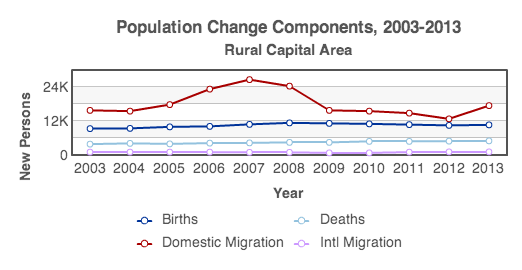 The Rural Capital Area (RCA) is a nine county region with a population of 878,000 in central Texas surrounding Austin, the state capital.
The Rural Capital Area (RCA) is a nine county region with a population of 878,000 in central Texas surrounding Austin, the state capital.
The RCA has grown more rapidly than the U.S. for the past decade, growing 40%. The regional population growth rate reached its lowest level in 2012 at 2.3%, still over three times the U.S. rate of growth.
The RCA's population growth has historically been driven by migration of people from across the 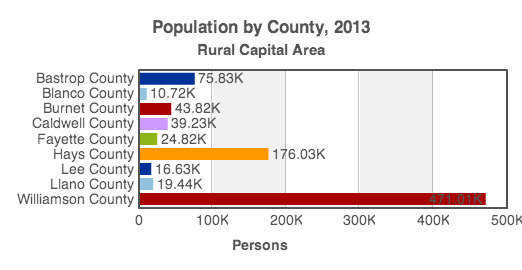 U.S.: in the last decade, 72% of new population was due to domestic migration. Migration has declined in recent years but still outpaces births: in 2013 17,500 people moved to the Rural Capital Area and 10,700 births occurred.
U.S.: in the last decade, 72% of new population was due to domestic migration. Migration has declined in recent years but still outpaces births: in 2013 17,500 people moved to the Rural Capital Area and 10,700 births occurred.
Williamson County is the most populous county in the Rural Capital Area with 54% of residents, followed by Hays County (20%), Bastrop County (9%), Burnet County (5%), and Caldwell County (4%). Population has grown in all regional counties over the past decade, but was highest in Williamson County and Hays County, where the number of residents grew 56% and 51% respectively.
Read the full Demographic Trends Profile here.
Update: Rural Capital Area
article posted by Headlight on August 7, 2014
 The Rural Capital Area has an overall population of 878,000 people and 253,000 jobs. The area has grown faster than the U.S.: the population grew 40% from 2003-2013 and job base grew 51%.
The Rural Capital Area has an overall population of 878,000 people and 253,000 jobs. The area has grown faster than the U.S.: the population grew 40% from 2003-2013 and job base grew 51%.
The Rural Capital Area's median household income has consistently been higher than the national average for the past decade and was 121% of the U.S. level in 2012.
The Rural Capital Area's economy has performed very well over the past decade, creating new jobs every year except one. The Rural Capital Area has weathered the recession well, losing just 2,300 jobs in 2009 and adding 29,000 jobs from 2011 to 2013.
The Rural Capital Area unemployment rate has fallen from a peak of 7.2% in 2010 to 5.2% in 2013. The area rate has been consistently lower than the U.S. rate.
The largest industries in the Rural Capital Area are:
• Trade, Transportation, and Utilities – 26% of area employment
• Government– 18%
• Leisure and Hospitality – 13%
• Health Services – 11%
• Professional and Business Services– 9%
View Rural Capital Area's full profile here.
The Final Numbers Are In: The Rural Capital Area Employment Base Grew 4.2% in 2013, with Tourism Industry Creating Most Jobs
article posted by Headlight on July 7, 2014
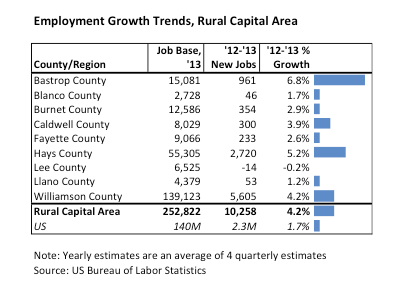
Recently released data from the US Bureau of Labor Statistics, shows that 8 out 9 counties increased their employment base in 2013. The counties that grew the fastest (on a percentage basis, in order) were Bastrop, Hays, Williamson, Caldwell, and Burnet counties.
Williamson County continues to create the most new jobs (5,600 in 2013), followed by Hays (2,700) and Bastrop (960).
Economic drivers of growth varied greatly across the Rural Capital Area. Financial Services was the fastest-growing industry (on a percentage basis) in Caldwell, Lee, and Llano counties. Mining was the fastest-growing industry in Fayette and Williamson counties. Construction led growth in Burnet and Hays counties. Blanco County's fastest-growing industry was Health Care. Leisure & Hospitality led growth in Bastrop County.
Still, the large size of some industries means that most jobs across Rural Capital Area counties were created in Leisure & Hospitality and Retail Trade. However, Williamson County's growth is now being led by Professional & Business Services (which includes software and some Dell functions).
Overall, the Rural Capital Area economy continues its strong recovery from the recession and most counties (7 of 9) are enjoying economic growth that is higher or on par with the US.
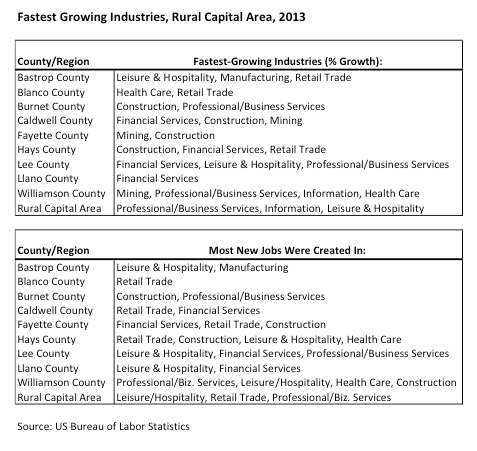
Retiree Population Growing Faster Than All Other Age Groups in 7 of 9 Rural Capital Area Counties
article posted by Headlight on July 7, 2014
The retiree population (ages 65 years or more) grew 7% in 2013 in the Rural Capital Area. Growth in this age group was faster than all other age groups in all 9 counties except two: Burnet and Fayette, where ages 15-24 grew fastest. This trend is similar to growth seen across the US, with retiree population growing the fastest, followed by the 15-24 age group.
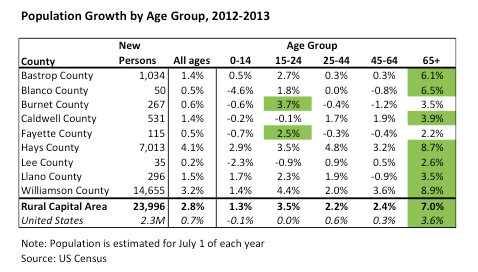
Five counties experienced drops in the youngest demographic, ages 0-14: Blanco, Burnet, Caldwell, Fayette, and Lee counties. The US followed a similar pattern, losing 0.1% of population in this demographic as well.
The young professional demographic, ages 25-44, grew fastest in Hays, Williamson, Llano, and Caldwell counties. Only Burnet and Fayette counties experienced a drop in their overall working-age population, ages 25-64.
Population growth in Hays County continues to outpace all other counties on a percentage basis (4.1%), while Williamson County attracted the most new residents (nearly 15,000).
Profile: Fayette County
article posted by Headlight on July 7, 2014
 Fayette County is a small, rural county in Central Texas with a population of 25,000 people and 8,600 jobs. The county's population grew 11% from 2002 to 2012 and job base grew just 4%.
Fayette County is a small, rural county in Central Texas with a population of 25,000 people and 8,600 jobs. The county's population grew 11% from 2002 to 2012 and job base grew just 4%.
Fayette County's median household income has remained below the U.S. average for the past decade, and was 91% of the U.S. level in 2012.
Fayette County's economy has performed on par with the U.S. over the past decade, creating new jobs every year except three. Fayette County has struggled with the recession, losing 440 jobs in 2009 and another 110 jobs in 2010 but gaining 200 in 2012.
The Fayette County unemployment rate has fallen from its recent high of 6.0% in 2010 to 4.8% in 2012. The county rate has been consistently lower than the U.S. rate.
The largest industries in Fayette County are:
• Trade, Transportation, and Utilities – 24% of county employment
• Government– 18%
• Health Services– 12%
• Leisure and Hospitality – 12%
• Manufacturing – 10%
Read Fayette County's full profile here.
Profile: Caldwell County
article posted by Headlight on July 7, 2014
 Caldwell County is a small county in Central Texas with a population of 38,000 people and 7,800 jobs. The county's population grew 12% from 2002- 2012 and job base grew 22%.
Caldwell County is a small county in Central Texas with a population of 38,000 people and 7,800 jobs. The county's population grew 12% from 2002- 2012 and job base grew 22%.
Caldwell County's median household income has remained under national averages for the past decade and was 84% of the U.S. level in 2012.
Caldwell County's economy has enjoyed sporadic growth over the past decade, creating new jobs every year except three and generally outpacing U.S. growth. Caldwell County has struggled slightly with the recession, losing jobs in 2006 and 2009, but returning to positive growth from 2010-2012.
The Caldwell County unemployment rate has fallen from its recent high of 8.8% in 2010 to 7.0% in 2012. The county rate has been slightly lower than the U.S. rate since 2007.
The largest industries in Caldwell County are:
• Trade, Transportation, and Utilities – 23% of county employment
• Government– 22%
• Health Services – 18%
• Leisure and Hospitality – 9%
• Manufacturing– 8%
Read Caldwell County's full profile here.
Profile: Llano County
article posted by Headlight on June 2, 2014
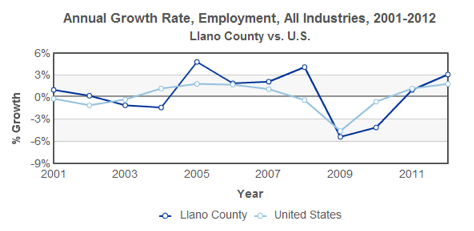 Llano County is a small rural county in central Texas, with a population of 19,000 people and 4,000 jobs. The county's population grew 8% from 2002-2012 and job base grew 5%.
Llano County is a small rural county in central Texas, with a population of 19,000 people and 4,000 jobs. The county's population grew 8% from 2002-2012 and job base grew 5%.
The county's modest population growth is due to the migration of people into the county: from 2002 to 2012, 1400 net new residents entered the county. Llano County has a significantly older population. According to the Census, 31% of Llano County's population are residents between 45 and 64 years of age (versus 27% for the U.S.) and 30% of county residents are 65 years or older (versus 13% for the U.S.).
Llano County's median household income remained below the national average for many years, and was 86% of U.S. median household income in 2012. The Llano County unemployment rate has fallen from its recent high of 7.6% in 2010 to 6.5% in 2012. The county rate has been lower than the U.S. rate since 2006.
The largest industries in Llano County are:
• Leisure and Hospitality– 28% of county employment
• Government – 19%
• Trade, Transportation, and Utilities – 18%
• Health Services – 12%
• Construction– 7%
Read Llano County's full profile here.
Profile: Industry Trends
article posted by Headlight on June 2, 2014
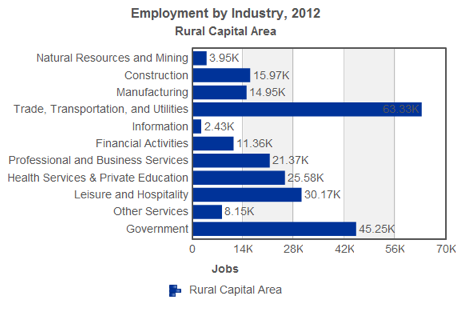 The Rural Capital Area employs 243,000 people in a diverse range of industries. The largest industries in the RCA are:
The Rural Capital Area employs 243,000 people in a diverse range of industries. The largest industries in the RCA are:
• Trade, Transportation, & Utilities – 26% of employment
• Government – 19%
• Leisure & Hospitality – 12%
• Health Services – 11%
• Professional & Business Services – 9%
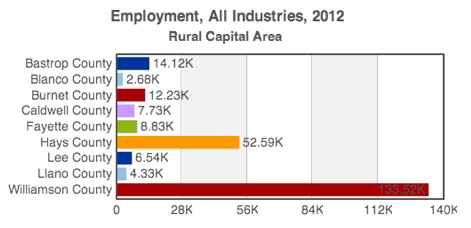 All industry sectors grew in the Rural Capital Area between 2002 and 2012.The fastest growing sectors during this period were Professional and Business Services (+91% growth), Leisure and Hospitality (+77%), and Other Services (+76%). These regional sectors all grew faster than the national rates, which were 12%, 15% and 7% growth respectively.
All industry sectors grew in the Rural Capital Area between 2002 and 2012.The fastest growing sectors during this period were Professional and Business Services (+91% growth), Leisure and Hospitality (+77%), and Other Services (+76%). These regional sectors all grew faster than the national rates, which were 12%, 15% and 7% growth respectively.
Employment is spread roughly proportional to residency across the Rural Capital Area. Williamson County hosts the greatest number of jobs with 134,000 and 55% of regional employment. The next largest employment counties are Hays County with 22% of regional jobs and Bastrop County with 6%. Employment has grown in all counties between 2002 and 2012, but growth was greatest in Williamson County (69%), Hays County (44%), Lee County (28%), and Bastrop County (27%).
Read the full Industry Trends Profile here.
Government Transfer Payments Play Larger Role in Personal Income in the Rural Capital Area
article posted by Headlight on June 2, 2014
Government transfer payments to Rural Capital Area residents reached $4.4 billion in 2012 and represent a growing source of personal income in the region. Between 2007 and 2012, government transfers of funds to individuals increased 42% on an inflation-adjusted basis compared to less than 20% for all other forms of income.
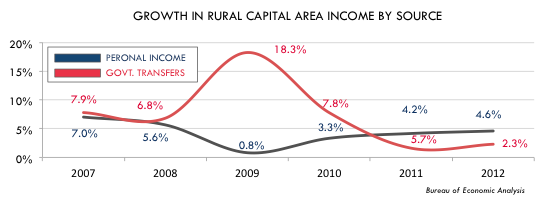
Demographic factors are the primary driver in the growth of government payments to individuals living in the Rural Capital Area. A growing elderly population, for example, has resulted in the sustained growth in Social Security and Medicare payments. These two programs, which represent more than 80% of government transfers to individuals, rose nearly 35% between 2007 and 2012.

Economic forces as well as US military engagements have also contributed to the rise in government payments to individuals. Unemployment income, for example, soared 265% between 2007 and 2012. Veterans' benefits increased nearly 60%. They now represent the third-largest category of government payments after Social Security and Medicare.
Despite these increases, government transfer payments only provide less than 14% of the region's total income, which includes wages, benefits, and investment income.
Per Capita Income in the Rural Capital Area Reaches All-Time High
article posted by Headlight on June 2, 2014
Per capita personal income in the Rural Capital Area hit an all-time record in 2012 according to recently released data from the US Bureau of Economic Analysis. Per capita personal income for people living in the region reached nearly $38,500, growing by $850 over 2011. Previously, per capita personal income peaked in 2008 and then declined.
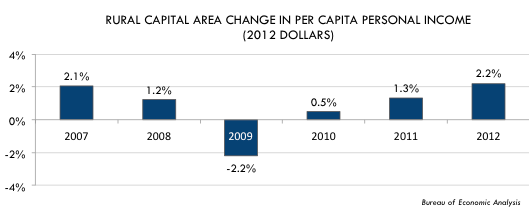
Increases in income, combined with continued population growth, have fueled significant growth in the Rural Capita Area's total personal income. In 2012, personal income in the region reached $32.8 billion. On an inflation-adjusted basis, this represents an infusion of an additional $5.4 billion annually into the Rural Capita Area compared to 2007.
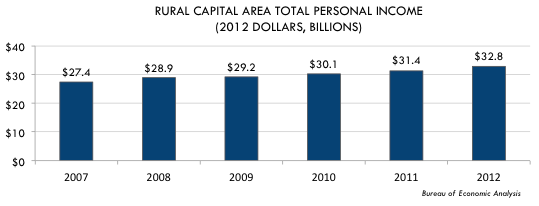
The Rural Capital Area's economic resiliency and sustained population increases will likely drive further growth in personal income in the years ahead.
Older Workers Now Comprise 17% of the Rural Capital Workforce, Up From 11% a Decade Ago
article posted by Headlight on May 7, 2014
Older residents are increasingly continuing to work past the traditional age of retirement. During the past five years, the proportion of workers age 65 and older increased at both the national and regional level. In 2012, nearly one in four residents in the region age 65 and older worked at some point during the previous 12 months.
Rising rates of employment, combined with the growing population of individuals age 65 and older, has resulted in a significant increase in the actual number of older workers. Between 2007 and 2012, the number of workers age 65 and older rose nearly 60% in the Austin region. The increase was just 14% in the US.
The growing population of older workers is changing the composition of the local workforce. In 2002, barely 11% of workers in the Rural Capital Area were 55 years or older. By 2011, the figure had increased to more than 17%.
While some of the increase in older workers may be the result of diminished income associated with the recession, local evidence suggest many individuals willingly choose to continue their careers past the age of 65. Since 2007, the region has enjoyed one of the country's strongest economies. During this period, the local increase in the proportion of older residents continuing to work was more than double the US average.
Furthermore, the region is home to one of the country's fastest growing populations of individuals between the ages of 55 and 64, so called “pre-seniors.†As a result, the importance of older residents within the workforce is likely to continue to grow in the years ahead.

US Employment Approaching Pre-Recession Levels; Rural Capital Area Surpassed Pre-Recession Peak 5 Years Ago
article posted by Headlight on May 7, 2014
The US is close to marking an important milestone on the long road to economic recovery. April's strong job numbers put the country within striking distance of surpassing pre-recessionary peak employment levels.
In January 2008, total employment in the US reached 138.4 million. During the next two years, the US lost 8.7 million jobs. Since 2010, US employment has slowly rebounded. In April, total employment reached 138.3 million. Barring a calamitous jobs report, May's employment figures should mark a new record.
As psychologically encouraging as the milestone may be at the national level, the Rural Capital Area blew past its pre-recessionary peak employment level years ago. Year-over-year employment in the region has increased for 44 consecutive months; the Rural Capital Area hasn't suffered a year-over-year employment decline since August 2010.
Total employment in the Rural Capital Area is currently 20% higher than in January 2008. If only the US could be so resilient.
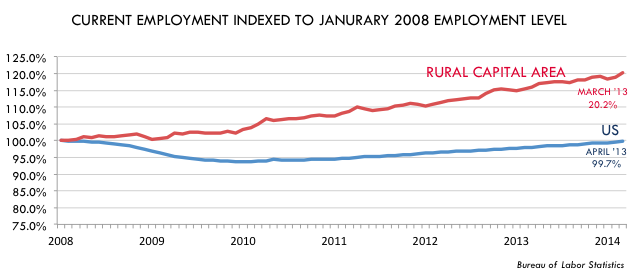
Rural Capital Area Trades Occupations Projected to Experience Growth Through 2018
article posted by Headlight on April 2, 2014
Communities throughout the US, including the Rural Capital Area, are embracing the growing importance of trades occupations in the economy. Trades occupations typically provide workers with living wages and require short-term technical certifications and/or on-the-job training. Additionally, many trades occupations provide workers with job security. Plumbers and electricians, for example, can't be offshored.
Currently, the State of Texas and the 9-county Rural Capital Area region are targeting more than two dozen trades occupations. Representative jobs include engineering technicians, industrial machinists, electricians, and plumbers. Such workers are employed in industries such as construction, manufacturing, and logistics.
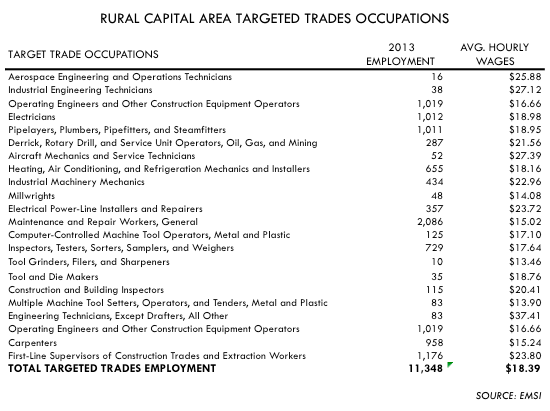
Wages among trades workers average nearly $18.50 an hour, slightly below the regional average. The most skilled workers, however, can earn significantly higher wages. Average hourly wages among the top 10% of trades workers in the Rural Capital Area, for example, earn more than $26 an hour.
Between 2013 and 2018, targeted trades occupations in the Rural Capital Area are forecast to grow 2.8% annually, comparable to growth in the rest of the economy. The region is projected to increase employment in targeted trades occupations by more than 1,650. Growth is expected in every targeted occupation.
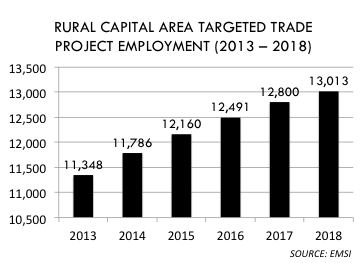
However, these projections underestimate the true number of actual job openings that will exist in the coming years. Simply put, many trades occupations are currently filled by older workers that are set to retire soon. Two-thirds of tool grinders in the US, for example, are older than 55. Nearly half of tool and die makers are older than 55, as are 42% of construction & building inspectors. These large outflows of workers due to retirement will create sizeable opportunities for individuals that seek a new career in trades occupations.
Profile: Williamson County
article posted by Headlight on April 2, 2014
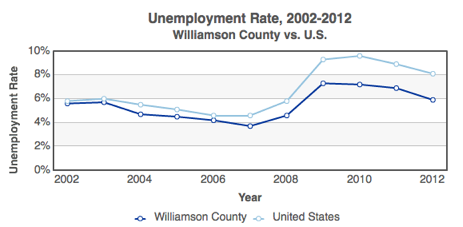 Williamson County is the most populous suburban county in the Austin metropolitan area, with a population of 456,000 people and 134,000 jobs. The county has grown much faster than the metro and U.S.: the population grew 57% from 2002-2012 and job base grew 69%.
Williamson County is the most populous suburban county in the Austin metropolitan area, with a population of 456,000 people and 134,000 jobs. The county has grown much faster than the metro and U.S.: the population grew 57% from 2002-2012 and job base grew 69%.
The county's population growth is primarily due to the migration of people into the county: from 2002 to 2012, 71% of new population was due to domestic migration. Over the 10 year period, 108,000 net new migrants moved to the county.
Williamson County's median household income has remained above the national average for many years, and was 139% of U.S. median household income in 2012.
The Williamson County unemployment rate has fallen from its recent high of 7.3% in 2009 to 5.9% in 2012. The county rate has been consistently lower than the U.S. rate.
The largest industries in Williamson County are:
• Trade, Transportation, & Utilities – 29% of county employment
• Government – 16%
• Leisure & Hospitality -12%
• Professional & Business Services – 11%
• Health Services – 10%
Read Williamson County's full profile here.
Profile: Wage & Income Trends
article posted by Headlight on April 2, 2014
Salaries in the Rural Capital Area are below U.S. levels in all industries except Trade, Transportation, & Utilities, Manufacturing and Other Services.

The average salary in the RCA is 89% of the U.S. average and from 2002-2012 grew 39%, more than the U.S. growth rate of 34%. Salaries in eight sectors grew faster than the national rate during this period:
• Manufacturing – 120% growth
• Other Services – 63%
• Financial Activities – 48%
• Professional and Business Services – 48%
• Health Services – 46%
• Leisure and Hospitality – 41%
• Government – 39%
• Construction – 35%
No salaries declined from 2002-2012 in either the United States or the Rural Capital Area. A significant portion of regional salary declines occurred between 2000 and 2003 during the tech bubble crunch. From 2003 to 2010, average salary growth has roughly matched U.S. growth until slight salary drops in 2009 and 2010 of 1.1% and 1.6% respectively.
Per Capita Income in the Rural Capital Area has remained below the U.S. average for the past 10 years, reaching 89% of U.S. Per Capita Income in 2012. As with Salary Levels, Per Capita Income saw regional declines in 2001 and 2002, but otherwise roughly matched U.S. growth trends between 2001 and 2011, including a decline of 3% in 2009.
Read the full Wage & Income Trends Profile here.
Profile: Blanco County
article posted by Headlight on April 2, 2014
 Blanco County is a small, rural county in central Texas, with a population of 11,000 people and 3,000 jobs. The county has grown slower than the U.S.: the population grew 22% from 2002-2012 and job base grew 15%.
Blanco County is a small, rural county in central Texas, with a population of 11,000 people and 3,000 jobs. The county has grown slower than the U.S.: the population grew 22% from 2002-2012 and job base grew 15%.
Blanco County's population growth is primarily due to the migration of people into the county: from 2002 to 2012, 78% of new population was due to domestic migration. Births slightly outpaced deaths over the period. Migration into the county has risen in recent years, accounting for 44% of growth from 2010 to 2012.
Blanco County's median household income has remained slightly under national averages for the past decade but grew to 103% of the U.S. level in 2012.
The Blanco County unemployment rate has fallen from its decade-high of 6.2% in 2010 to 5.2% in 2012. The county rate has been consistently much lower than the U.S. rate.
The largest industries in Blanco County are:
• Government – 21% of county employment
• Professional and Business Services– 16%
• Trade, Transportation, and Utilities – 14%
• Leisure and Hospitality – 13%
• Construction– 12%
Read Blanco County's full profile here.
Profile: Demographic Trends
article posted by Headlight on March 5, 2014
The Rural Capital Area (RCA) is a nine county region with a population of 853,000 in central Texas surrounding Austin, the state capital.
 The RCA has grown more rapidly than the U.S. for the past decade, growing 46%. The regional population growth rate reached its lowest level in 2012 at 2.3%, still over three times the U.S. rate of growth.
The RCA has grown more rapidly than the U.S. for the past decade, growing 46%. The regional population growth rate reached its lowest level in 2012 at 2.3%, still over three times the U.S. rate of growth.
The RCA's population growth has historically been driven by migration of people from across the U.S.: in the last decade, 72% of new population was due to domestic migration. Migration has declined in recent years but still outpaces b irths: in 2012 12,300 people moved to the Rural Capital Area and 10,800 births occurred.
irths: in 2012 12,300 people moved to the Rural Capital Area and 10,800 births occurred.
Williamson County is the most populous county in the Rural Capital Area with 53% of residents, followed by Hays County (20%), Bastrop County (9%), Burnet County (5%), and Caldwell County (5%). Population has grown in all regional counties over the past decade, but was highest in Williamson County and Hays County, where the number of residents grew 57% and 51% respectively.
Read the full Demographic Trends Profile here.
Fastest Growing Occupations in the Rural Capital Area Found in Medical, Construction, and Education Fields
article posted by Headlight on March 5, 2014
The Rural Capital Area will continue to see growth over the next five years, as the needs of a growing population require more work in occupations such as Medical Equipment Repairs, Home Health Aides, Construction Trades, Education, and Personal Services.
An analysis of the Rural Capital economic forecast for 2013-2018 points to a diverse mix of high-growth occupations (a minimum employment threshold was set to 50 employees):
- Medical Equipment Repairers top the list of fastest-growing occupations (on a % basis), with 55% growth over the next five years
- Various construction trades such as Brick Masons, Drywall Installers, Stonemasons, and Insulation Installers are in the Top 20 and will grow 28%-48%
- Home Health Aides and Nurse Practitioners are in the Top 10 and will grow 40% and 32%, respectively
- Photographer employment is expected to grow 32%
- Education and Social Service occupations that made the Top 20 list include Rehabilitation Counselors (31%), Special Education Teachers (29%-31%), and Coaches & Scouts (29%)
The following two charts show which occupations will grow the fastest both in terms of percentage and net new jobs created.
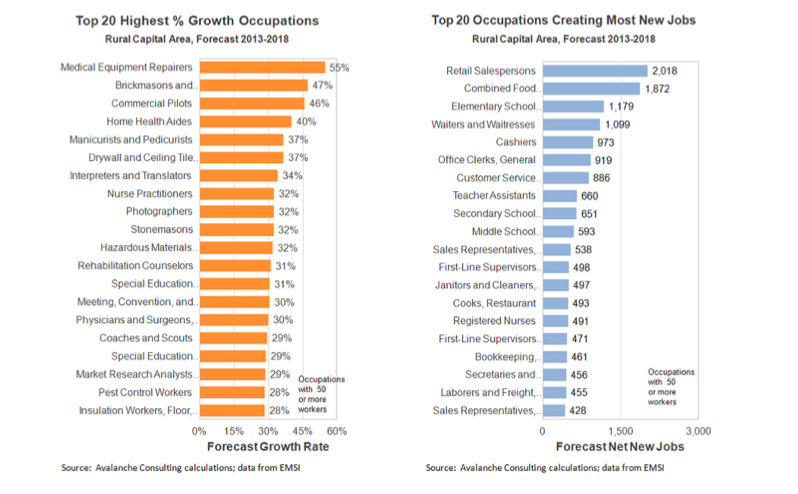
Click here to explore more data on occupation forecasts by county for the Rural Capital Area.
Profile: Bastrop County
article posted by Headlight on March 5, 2014
Bastrop County is a growing suburban county in central Texas, with a population of 75,000 people and 14,000 jobs. The county has grown slightly slower than the metro and the U.S.: the county's population grew 17% from 2002-2012 and job base grew 27%.
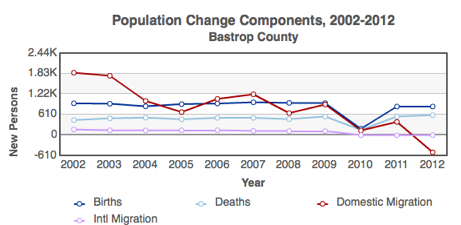 The county's population growth has historically been driven by migration of people into the county: from 2002 to 2012, 62% of new population was due to domestic migration. However, migration into the county has declined and even turned negative in 2012, likely due to the out-migration of families after the Bastrop fires in late 2011.
The county's population growth has historically been driven by migration of people into the county: from 2002 to 2012, 62% of new population was due to domestic migration. However, migration into the county has declined and even turned negative in 2012, likely due to the out-migration of families after the Bastrop fires in late 2011.
Bastrop County has a diverse age range of population and is home to a large concentration of families. According to the Census, 21% of Bastrop County's population are children under 15 years of age (versus 20% for the U.S.) and 29% of county residents are between 45 and 64 years old (versus 27% for the U.S.). As a result, the county has higher concentrations of both young adults and the elderly residents than the nation. Of the total population, 90% were born in the United States, with 10% born abroad. Of the foreign-born population, 86% are not naturalized US citizens.
Bastrop County's population is 60% White, 30% Hispanic, 8% Black, and 1% Asian. The three largest ancestral groups are German, English, and Irish.
According to the Census, Bastrop County education levels trail the U.S. average: 82% of residents in 2012 had at least a high school degree and only 14% had a Bachelor's degree or higher. These educational attainment statistics are significantly lower than the U.S. average (86% high school, 29% Bachelor's). (American Community Survey, Bastrop County)
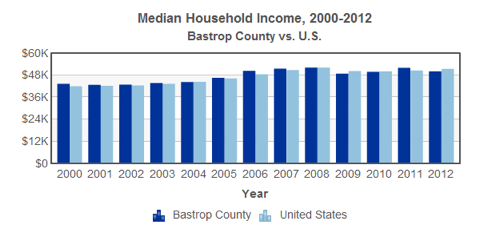 Bastrop County's median household income has remained just above the national average for many years, but fell to 97% of U.S. median household income in 2012.
Bastrop County's median household income has remained just above the national average for many years, but fell to 97% of U.S. median household income in 2012.
The percent of overall population in poverty in Bastrop County has remained slightly under national trends over the past decade. Between 2002 and 2012 overall population in poverty in Bastrop County rose slightly from 12.3% to 14.3%. The percentage of children in poverty in Bastrop county rose faster than the county as a whole, rising from 15.9% in 2002 to 23% in 2012.
Bastrop County's economy has performed very well over the past decade, creating new jobs every year until 2011. Bastrop County has weathered the national recession well, adding 400 jobs in 2009 and 2010, despite losing 250 in 2011. The most recent year of complete data, 2012, showed a positive rebound.
The Bastrop County unemployment rate has fallen from its recent high of 8.3% in 2010 to 6.4% in 2012. The county rate has been lower than the U.S. rate since 2006.
Read Bastrop County's full profile here.
Large Occupation Clusters Leading Growth in the Rural Capital Area Include Education, Medical, and Hospitality
article posted by Headlight on March 5, 2014
Which occupation clusters are growing the fastest and which are most concentrated in the Rural Capital Area? We can examine clusters along a new dimension: the location quotient, which describes the per capita density of a cluster in a local economy. Looking at the 25 major clusters in the following bubble chart, we see that large clusters with high location quotients include Education, Hospitality, Computer, Construction, and Personal Services. These clusters have much higher density in the Rural Capital Area and are growing quickly. Some under-represented clusters such as Medical, Financial, and Social Services are catching up to serve a commuter population that now demands these services closer to home (in particular, the Williamson County population that commutes into Travis County). Other under-represented but high-potential clusters include Logistics, Engineering, Production, and Manufacturing, which continue to seek lower-cost locations in high-growth population areas. Performance (Entertainment) occupations are extremely high growth and reflect a growing set of entertainment options across the Rural Capital Area.
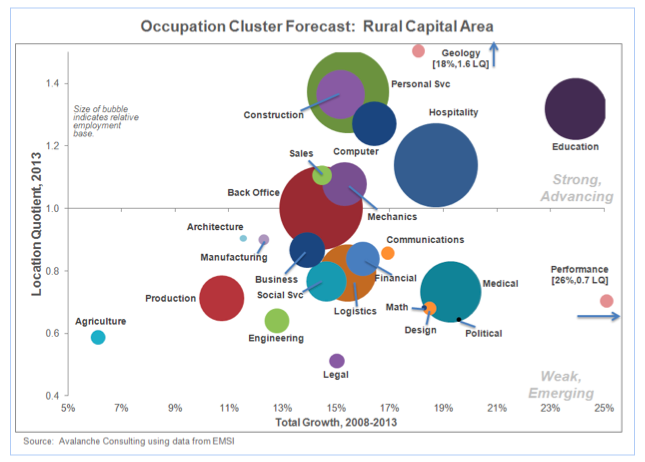
Click here to explore more data on occupation cluster forecasts by county for the Rural Capital Area.
High Growth Forecasts Expected for Diverse Clusters in the Rural Capital Area, Led By Education, Health, Construction, and Technology
article posted by Headlight on February 3, 2014
The future of the Rural Capital economy will be characterized by a much more diversified set of high growth industries than in past years. The Rural Capital Area of today now enjoys more developed support industries in Health Care, Construction, Education, and Retail.
An analysis of 122 sub-clusters in the RCA economy points to a diverse mix of high-growth industries (a minimum employment threshold was set to 250 employees):
- Private education at the K-12 level tops the list of fastest-growing sub-clusters (on a % basis); public education is in the Top 20.
- Computer Manufacturing, Electronics Sales, and Data Centers are in the Top 5 and will grow 27%-32% over the next five years.
- Warehousing and Public Transit are in the Top 10 and will both grow 26%.
- Software is expected to grow 25%.
- Other manufacturing clusters that joined the Top 20 list and will experience high growth: Commercial Equipment (24%) and Packaged Foods (22%)
- Employment at Physician's Offices will grow 22%.
- Two cultural industries, Performing Arts and Sports, will see employment grow by more than 20%.
The following
two charts show which sub-clusters will grow the fastest both in terms of a percentage and net new jobs created.
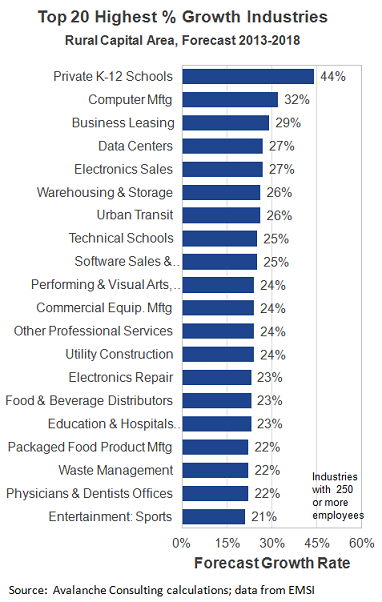
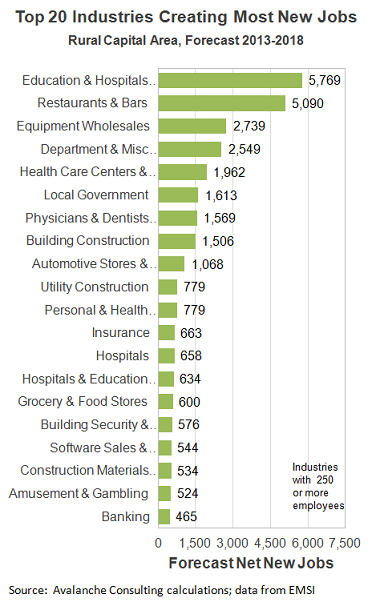
Which clusters are the most competitive in the Rural Capital Area? We can examine clusters along a new dimension: the location quotient, which describes the per capita density of a cluster in a local economy. Looking at the 25 major clusters in the following bubble chart, we see the Industrial Equipment (which includes Dell) has a location quotient of 3.3, which means 3 times the number of employees in the industry is found in the Rural Capital Area compared to the US average. Building Construction, Retail, Culture/Hospitality, and Education round out the top 5 most concentrated in the Rural Capital Area economy.

Explore more forecast data for the Rural Capital Area and its counties.
Employment in the Rural Capital Area Forecasted to Grow Three Times Faster Than US, High Growth Expected Across Most RCA Counties
article posted by Headlight on February 3, 2014
Recent forecasts from EMSI, a national data provider, suggest the next five years will bring extremely high employment growth across most of the Rural Capital Area. The region is expected to grow 17% from 2013 to 2018, nearly three times faster than US growth of 6%.
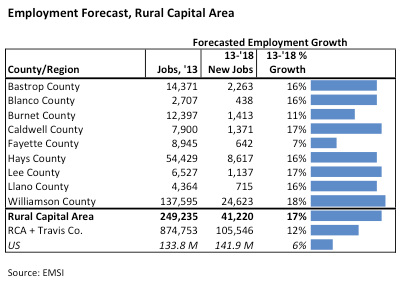
Williamson County will continue to lead the pack with 18% growth, but will be followed closely by Caldwell County and Lee County (17% growth for both). Bastrop, Blanco, Hays, and Llano will all grow at 16%. Laggards in the region will still outpace US growth – Burnet (11%) and Fayette (7%).
Still, a majority of new jobs will be created in Williamson County. Of the 41,000 new jobs to be created across the Rural Capital Area, nearly 25,000 of the jobs will be in Williamson County.
At the national level, EMSI forecasts 8.2 million new jobs in the US over the next five years.
Explore more forecast data for the Rural Capital Area and its counties.
Time for the US to Reskill?
article posted by Headlight on December 3, 2013
The OECD released a shocking report comparing the literacy and math skills of adults in the US versus other countries. They found that "One in six adults have low literacy skills – in Japan the comparable figure is one in 20. Nearly one in three have weak numeracy skills against a cross country average of one in five." The report pointed to a weak education system that succeeds in providing high levels of educational achievement (the US has one of the highest percentage of adults with post-secondary education), but weaknesses in basic skills.
Read the full report from OECD here.
Changing Roles of Women in the American Labor Force
article posted by Headlight on December 3, 2013
The changing role of women has reshaped the landscape of the American labor force. Fifty-eight percent of women in the US age 16 and over participate in the labor force (working or looking for work). This includes 57 percent of White women, 60 percent of Black women, 57 percent of Hispanic women, and 57 percent of Asian women.
Our nation's 67 million working women hold nearly half of today's jobs. Of these 67 million working women, about 52.8 million are White, 8.6 million are Black, and 3.6 million are Asian. Women of Hispanic or Latino ethnicity (who may be of any race) make up 9.2 million of the 67 million women workers.
Read the full report from the US Bureau of Labor Statistics here.
Investing in Our Future: 2013 State of Texas Children
article posted by Headlight on December 3, 2013
The Center for Public Policy Priorities released Investing in Our Future: 2013 State of Texas Children, Texas KIDS COUNT Annual Data Book, which takes a decade-long look at the effects our public policy choices have had on the well-being of the 6.9 million kids who live in Texas. This year's analysis shows that child poverty continues to increase despite economic recovery, underscoring the need for Texas to make greater investments that move children and their families into the middle class. The report finds that outcomes for kids in health, education, nutrition, and safety often hinge on whether or not they live in poverty.
The State of Texas Children annual data book is part of the KIDS COUNT Project, a national and state-by-state effort to track the well-being of children. Texas KIDS COUNT provides data on more than 70 measures of child well being and is a resource to help create, implement, and encourage good policy and effective services to better the lives of Texas children.
Read the full report from The Center for Public Policy Priorities here.
Pay Gap Grows for Texas Women
article posted by Headlight on December 3, 2013
For the first time in more than 15 years, the gender pay gap for Texas women has dipped below the national average gender pay gap.
The average working woman in Texas earned only 79 percent of her male counterparts in 2012, according to a report issued Monday by the U.S. Department of Labor's Bureau of Labor Statistics.
That's a decline in gender-pay-equality of more than a 5 percentage points compared to the previous year, and its lowest level since 2001. Over the last two years, the ratio of women's to men's earnings has dropped by 6 percentage points in Texas.
Read the full article in the Austin Business Journal.
Why Do Some Americans Leave the Bottom of the Economic Ladder, but Not Others?
article posted by Headlight on December 3, 2013
Rags-to-riches stories are more prevalent in Hollywood than in reality according to a recent report by the Pew Charitable Trusts that examines the common traits of those who are able to escape poverty.
The "Moving On Up" study concludes that 43 percent of Americans raised at the bottom of the income ladder remain there as adults and 70 percent never completely make it to the middle class.
Fortunately, graduating from college, living in a dual-income household and being continuously employed significantly reduce the chances people have of remaining poor, according to the study.
By contrast, only 55 percent of non-college graduates, 49 percent of single-earner families, and 34 percent of people who experienced unemployment move up from the bottom quintile.
Read the full brief from The Pew Charitable Trusts here.
Diverse Industry Clusters Found Across Rural Capital Counties
article posted by Headlight on November 6, 2013
New analysis by Rural Capital Headlight shows much diversity across the Rural Capital Area, with each county registering unique high-concentration industry clusters. The analysis pulled the top 5 industries for each of the 9 Rural Capital counties with the highest location quotient (LQ), which measures the per capita density in the county versus the US average. Typically, industries with a high LQ are viewed as clusters that are highly competitive in the county. Industries that employed relatively few people but had a high LQ were removed (employment limits were 50 workers for the industry in micro counties; 100 in small counties; and 250 in medium counties). The tables below show each county's list along with the industry's LQ, employment, and ranking for the LQ against all other US counties in that population size range (see previous article to see which size group each county is in).
Rankings of #1 versus peer counties were found in Hays County (Clothing Stores) and Williamson County (Merchant Wholesales, Durable Goods, i.e., Dell).
Other notable high rankings include:
- Beverage Manufacturing in Blanco County
- Mineral Manufacturing (Clay Products) and Building Materials Stores in Bastrop County
- Waste Management Services in Burnet County
- Oil/Gas Pipelines in Caldwell County
- Telecommunications Services in Fayette County
- Rental Services in Lee County
- Food and Beverage Stores (Retailers) in Llano County

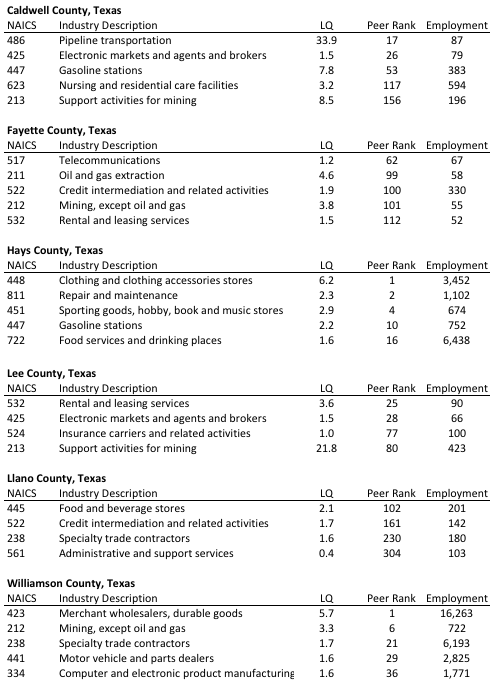
Hays and Lee Counties Rank in the Top 10% of Counties for Employment Growth in 2012; Williamson and Caldwell Counties Rank in the Top 15%
article posted by Headlight on November 6, 2013
New analysis by Rural Capital Headlight shows remarkable swings in economic performance across counties in the Rural Capital Area. This analysis ranks each county against its peers based on population size, with lower numbers indicating higher rankings.
Fast-growing Hays and Williamson counties have typically seen rankings within the Top 5% over the past 10 years. Williamson achieved a #1 ranking in 2011 after falling to the 20th percentile in 2010. Last year, Williamson stood at the 11th percentile. Hays has consistently been in the Top 10% over the last 7 years, with the exception of 2008 when its ranking fell dramatically to the 86th percentile.
Lee County has experienced remarkable improvement in recent years, rising from the 57th percentile in 2009 to the 8th percentile in 2010 and 2nd percentile in 2011. Lee stood at the 8th percentile in 2012.
Caldwell County ranked third highest among Rural Capital counties in 2012, followed by Llano County, Fayette County, and Blanco County. Bastrop and Burnet counties are the only two counties ranking in the bottom half of their size categories.
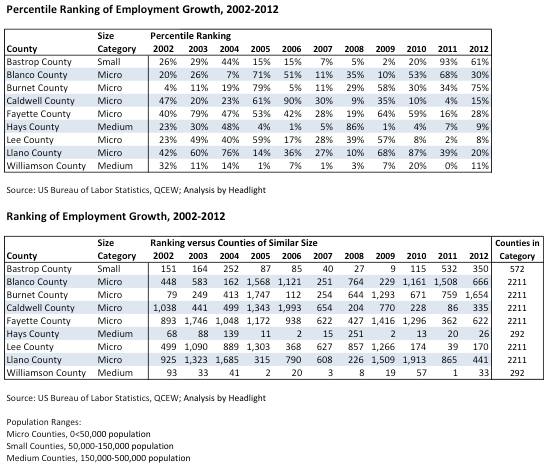
The Rural Capital Area Sales Reach $30 Billion; Grows 10% in 2012
article posted by Headlight on September 30, 2013
The 9-county Rural Capital Area registered gross sales of $30 billion in 2012 according to the Texas Comptroller's Office. Sales grew by $2.7 billion in 2012, registering a 10% growth rate.

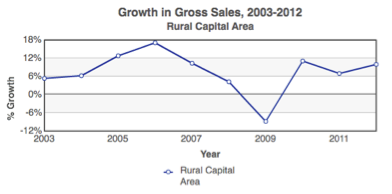
The Rural Capital Area economy has more than doubled in just the last 10 years, growing from $14.7 billion in 2002.
Gross Sales is a measure that is reported by the Texas Comptroller's Office and includes entities with sales permits, whether or not they are taxable. While it does not include all businesses, it reflects a good measure of the overall economy.
Population in the Rural Capital Area Surpasses 850,000; Hays and Williamson Counties Lead Growth
article posted by Headlight on September 30, 2013
Recently released data from the US Census shows that the population of the 9-county Rural Capital Area reached 853,200 on July 1, 2012. Williamson County remains the largest community, with 456,000 persons. Hays is the second-largest county, with 169,000 persons, followed by Bastrop with 75,000.

Two counties registered as the fastest growing in the region from 2011-2012: both Hays and Williamson grew 3.2%. Three other counties registered growth at or above the US average: Blanco, Caldwell, and Llano counties. Three counties lost population: Bastrop, Fayette, and Lee.

Overall, population growth in the Rural Capital Area has slowed slightly. The region grew 2.3% from 2011-2012, its slowest growth rate in decades. Just 19,400 new people were added to the region in 2012. The primary cause of this slowdown is a slight decline in people moving into the region.

Asian and Hispanic Populations Represent Fastest Growing Demographic in the Rural Capital Area; Hispanics Now Reach 25% of Regional Population
article posted by Headlight on September 30, 2013
The Rural Capital Area's Asian population grew 5.6% in 2012, the fastest of all races. The Hispanic population came in a close second, with 5% growth.


Overall, Hispanics now account for 25% of total population, with Whites accounting for 65%. The Black population registers at just under 6% and the Asian population is approaching 3%.
Varying levels of diversity are seen across the region. The largest Hispanic populations – as a percent of total – are found in Caldwell County (45%), Hays County (33%), and Bastrop County (30%). The largest Black populations are in Lee County (11%), Bastrop County (8%) and Caldwell and Fayette counties (both 7%). Williamson County has the far largest Asian population (4%), with Bastrop and Hays counties registering 1%.

Texas Economy Grows by 19,900 Jobs in July
article posted by Headlight on September 5, 2013
Texas Workforce Commission
AUSTIN — The Texas economy added 19,900 seasonally adjusted total nonfarm jobs in July for a total of 293,000 jobs added since July 2012. Texas' seasonally adjusted unemployment rate held steady in July at 6.5 percent. Texas' unemployment rate remained below the nation's July unemployment rate of 7.4 percent.
“As of July, Texas has maintained a positive annual growth rate for 39 straight months,†said Texas Workforce Commission (TWC) Chairman Andres Alcantar. “Financial Activities led the way in July with 9,000 added jobs; the largest monthly increase in that major industry since 1998. We encourage job seekers to visit their local Workforce Solutions office to find current employment opportunities.â€
This was the sixth monthly gain in the past seven months for Financial Activities. The monthly growth brings the over-the-year total jobs added in the industry to 19,000.
“It's good to see growth across several different fields—in particular Mining and Logging, which includes jobs in the oil and gas industries,†said TWC Commissioner Representing Labor Ronny Congleton. “That industry grew by 8,000 jobs in July alone and has grown by almost 6 percent in the last year.â€
Information employment surged in July with the addition of 4,800 positions. This industry has grown by 6,300 jobs over the last year for an annual growth rate of 3.2 percent. Trade, Transportation, and Utilities also saw positive job gains over the month in Texas, adding 3,200 jobs for a total of 53,000 jobs added over the year.
“The private sector continues to lead the way for our state's economy, adding more than 278,000 jobs over the last year,†said TWC Commissioner Representing Employers Hope Andrade. “Our 3.1 percent annual growth rate compares favorably to 2.1 percent for the private sector nationally.â€
The Midland Metropolitan Statistical Area (MSA) had the lowest July unemployment rate in the state at 3.5 percent. The Odessa MSA came in second at 4.2 percent and the Amarillo MSA third at 5.1 percent (not seasonally adjusted).
Audio downloads from TWC Chairman Andres Alcantar on the latest labor market data are available at: www.texasworkforce.org/news/press/2013/press-releases-2013.html#pressReleaseAudio.
The Texas Workforce Commission is a state agency dedicated to helping Texas employers, workers and communities prosper economically. For details on TWC and the services it offers in coordination with its network of local workforce development boards, call 512-463-8942 or visit www.texasworkforce.org.
This article is from Workforce Solutions Rural Capital Area Recent News.
Unemployment Rate in the Rural Capital Area Continues to Fall
article posted by Headlight on September 5, 2013
The Bureau of Labor Statistics (BLS) releases monthly unemployment estimates that help track the state of the economy. The latest data appears to show a continued slow and steady recovery in the Rural Capital Area and nationally. The unemployment rate in the Rural Capital Area fell to 5.7% in July of 2013, down from 6.4% in July of 2012 - a drop of 0.7 percentage points. Although it remains well above Rural Capital Area levels, the national unemployment rate declined at a slightly faster rate, falling 0.9 percentage points over the past year from 8.6% to 7.7%. Currently, 25,500 workers are unemployed in the Rural Capital Area.
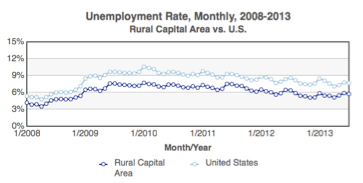
Unemployment rates show variation between counties in the Rural Capital Area, but no counties have rates higher than the national average and all counties have seen declines over the past year. The counties with unemployment rates above the regional average are Caldwell County (7.7%), Bastrop County (6.9%), and Llano County (6.5%). Counties with well below average unemployment rates include Fayette County (4.7%) and Lee County (4.8%).
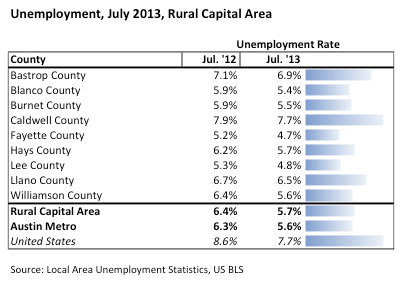
63,00 Sole Proprietorships are Active in the Rural Capital Area; Revenue Grew 3.8% in 2011
article posted by Headlight on September 5, 2013
Recently released data show that more than 63,000 sole proprietorships in the Rural Capital Area earned nearly $2.7 billion in 2011. According to the US Bureau of Labor Statistics, most firms that don't have salaried staff are self-employed individuals operating unincorporated businesses (known as sole proprietorships), which may or may not be the owner's principal source of income. The majority of all business establishments in the United States are nonemployers, yet these firms average less than 4 percent of all sales and receipts nationally.
Growth in sole proprietorships in the Rural Capital Area is currently on par with US growth, rebounding more quickly after the recession. Within the region, Williamson County is growing the fastest at 2.7% in 2011, followed by Burnet and Caldwell counties at 1.5%. Bastrop and Llano counties experienced negative growth in 2011.

Revenues per sole proprietorship in the Rural Capital Area vary between $40-$50,000/year, with some retailers such as gas stations, household appliances, and farm supplies making between $150-$200,000/year. The industry with the most sole proprietorship revenue is Construction ($609 million in 2011), led by residential building. Professional Services ranks #2, followed by Specialty Trade Contractors, Real Estate Leasing companies, and Facilities Maintenance.

Liberal Arts and Business Degrees Lead Region's College Output; Technical Degrees Show Flat to Negative Growth
article posted by Headlight on August 6, 2013
The degree output of colleges serving the Capital Area Region (Rural Capital Area plus Travis County) reached nearly 35,000 completions in the 2011-12 school year. Liberal Arts** led with 6,000 degree completions, Business with 5,600, and Health Care with 5,200.
Technical degrees in Engineering, Software and Math amounted to a combined total of 5,500 completions, but growth in these fields was flat to negative from the previous year. More importantly, these technical fields experienced significant positive growth at the US level. This is an indication that the Capital Area Region's supply of technical workers may grow even tighter in the near term.
Strong growth in college output was seen in Agriculture, Architecture, Legal and Business fields.
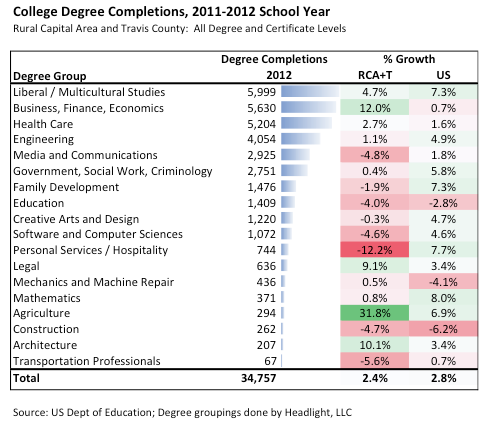
Note: Some institution data include campuses outside the Capital Area Region (as in the case of Victoria College) or include large numbers of online degrees, which are not reported separately.
**Liberal Arts includes studies not classified elsewhere, primarily General Studies, Multi-Interdisciplinary Studies, History, Spanish, and Anthropology.
274,000 People Now Enrolled in the Capital Area Region as College Degree Completions Reach 35,000 in 2011-12 School Year
article posted by Headlight on August 6, 2013
Enrollment of college students in the Rural Capital Area and Travis County (schools serving these areas) dipped slightly in 2012 after steady growth since 2006. The recent recession led to a surge in enrollment as students eyed education as a means to a better job and delayed graduation to wait for the economy improve. Graduations (degree completions) have seen steady growth since dipping in 2007 due to recession fears.
Nearly 35,000 students finished degrees at institutions serving the Capital Area. This was led by the University of Texas and Texas State University, which graduated 14,000 and 7,100 students, respectively, in 2012. Of the top 5 institutions, only ACC saw double-digit growth in graduations in 2012.
Graduation rates vary widely, with 4 students per degree completion at the University of Texas versus 27 for ACC. Technical schools, with their shorter degrees of 1 - 2 years, have the lowest ratios of enrollment to completions.
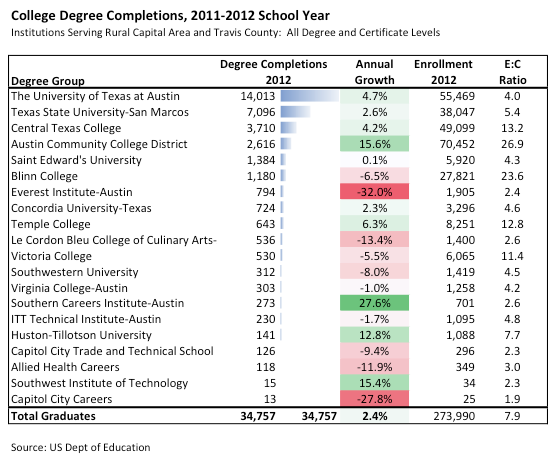
Note: Some institution data include campuses outside the Rural Capital Area (as in the case of Victoria College) or include large numbers of online degrees, which are not reported separately.
Rural Capital Area Growing Twice as Fast as the US
article posted by Headlight on July 2, 2013
Last week, the US Bureau of Labor Statistics released employment data for the 4th Quarter and annual average of 2012, revealing strong growth across the Rural Capital Area, particularly at the end of the year. From 2011 to 2012, annual employment in the Rural Capital Area grew nearly double the US rate: 3.3% in the RCA compared to 1.8% nationally. When comparing end of year employment from Q4-2011 to Q4-2012, growth was even stronger, with RCA employment growing 4.3% over the year – over double the US rate of 1.8%.
When comparing 4th quarter employment gains from 2011 to 2012, all counties in the Rural Capital Area performed stronger than their annual averages. The fastest growing counties in the region over this period were Lee County (7.9% growth), Hays County (5.8%), Caldwell County (5.3%), Llano County (4.1%) and Williamson County (3.9%). Bastrop County and Burnet County particularly finished strong at the end of 2012, growing 3.8% and 1.6% year-to-year in the 4th quarter compared to only 0.7% and -1.1%, respectively in the yearly average.
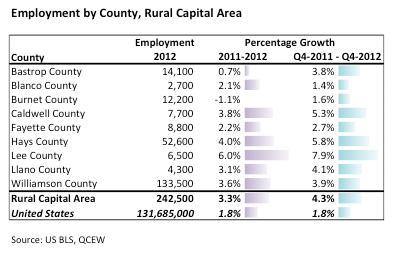
Strong Growth Across All Industries in the Rural Capital Area Except Government
article posted by Headlight on July 2, 2013
Complete 2012 employment data released last week shows the Rural Capital Area continuing to create jobs nearly twice as quickly as the US over the past year, with growth occurring in all industries except Government. In 2012, employment in the Rural Capital Area grew 3.3%, creating over 7,600 jobs. The fastest growing industries all outpaced their US equivalents: Health Services & Private Education (8.4% RCA vs. 1.9% US), Leisure & Hospitality (4.8% RCA vs. 3.3% US) and Manufacturing (4.7% RCA vs. 1.7% US).
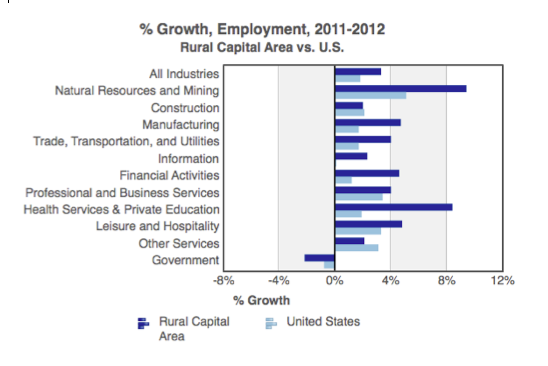
Trade, Transportation & Utilities, the largest industry in the Rural Capital Area, picked up speed in the 4th quarter of 2012, leading to overall growth of 4.0% for the year. Government, the second largest industry in the Rural Capital Area, was the only industry to lose jobs from 2011 to 2012, with employment dropping by 2.2% - a greater decline than the US average of 0.8%. Construction was the only industry in the Rural Capital Area that did not outpace US average growth over this period. Construction employment grew 2.0% in the RCA compared to 2.1% nationally. Construction and Manufacturing are the only industries in the Rural Capital Area with employment still below 2007 Pre-Recession levels, so positive growth in both industries is highly encouraging.
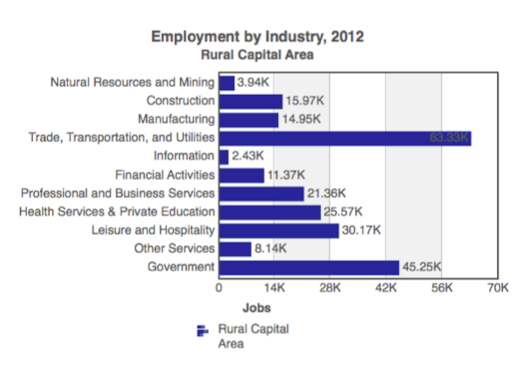
These are the 100 highest-paying jobs in Austin
article posted by Headlight on June 4, 2013
Austin Business Journal / US Bureau of Labor Statistics
The U.S. Bureau of Labor Statistics (BLS) produces annual wage estimates for 22 major employment sectors and more than 800 individual occupations. Below are two lists of newly released 2012 figures for the Austin market (officially known as the Austin-Round Rock-San Marcos, TX, metropolitan area).
The first list shows the average annual pay for all employees within each of the market's 22 major sectors. The second list shows the area's 100 highest-paying individual occupations, again based on average annual pay.
Each sector and occupation is followed by its six-digit NAICS code in brackets. All sector and occupation titles are the bureau's official designations.
22 major sectors (ranked by average annual pay) in Austin
1. Management Occupations [11-0000], $108,330
2. Legal Occupations [23-0000], $85,770
3. Computer and Mathematical Occupations [15-0000], $84,120
4. Architecture and Engineering Occupations [17-0000], $76,580
5. Healthcare Practitioners and Technical Occupations [29-0000], $71,990
6. Business and Financial Operations Occupations [13-0000], $67,180
7. Life, Physical, and Social Science Occupations [19-0000], $59,470
8. Arts, Design, Entertainment, Sports, and Media Occupations [27-0000], $52,530
9. Education, Training, and Library Occupations [25-0000], $50,190
10. Community and Social Service Occupations [21-0000], $42,870
11. Protective Service Occupations [33-0000], $42,410
12. Installation, Maintenance, and Repair Occupations [49-0000], $41,670
13. Sales and Related Occupations [41-0000], $41,530
14. Construction and Extraction Occupations [47-0000], $35,400
15. Office and Administrative Support Occupations [43-0000], $34,950
16. Production Occupations [51-0000], $32,960
17. Transportation and Material Moving Occupations [53-0000], $30,000
18. Healthcare Support Occupations [31-0000], $29,380
19. Farming, Fishing, and Forestry Occupations [45-0000], $24,080
20. Personal Care and Service Occupations [39-0000], $23,710
21. Building and Grounds Cleaning and Maintenance Occupations [37-0000], $23,030
22. Food Preparation and Serving Related Occupations [35-0000], $20,780
100 highest-paying occupations (ranked by average annual pay) in Austin
1. Pediatricians, General [29-1065], $211,210
2. Dentists, General [29-1021], $202,850
3. Obstetricians and Gynecologists [29-1064], $191,140
4. Family and General Practitioners [29-1062], $188,870
5. Chief Executives [11-1011], $188,360
6. Physicians and Surgeons, All Other [29-1069], $173,850
7. Nurse Anesthetists [29-1151], $150,540
8. Petroleum Engineers [17-2171], $144,040
9. Actuaries [15-2011], $139,270
10. Sales Managers [11-2022], $136,630
11. Architectural and Engineering Managers [11-9041], $136,600
12. Psychiatrists [29-1066], $134,860
13. Purchasing Managers [11-3061], $133,050
14. Computer and Information Systems Managers [11-3021], $132,910
15. Compensation and Benefits Managers [11-3111], $132,860
16. Economics Teachers, Postsecondary [25-1063], $129,210
17. Marketing Managers [11-2021], $128,210
18. Financial Managers [11-3031], $126,260
19. Podiatrists [29-1081], $124,770
20. Natural Sciences Managers [11-9121], $122,800
21. Business Teachers, Postsecondary [25-1011], $121,920
22. Education Administrators, Postsecondary [11-9033], $119,030
23. Pharmacists [29-1051], $116,560
24. Public Relations and Fundraising Managers [11-2031], $115,770
25. General and Operations Managers [11-1021], $114,680
26. Managers, All Other [11-9199], $114,670
27. Engineering Teachers, Postsecondary [25-1032], $112,830
28. Veterinarians [29-1131], $111,950
29. Human Resources Managers [11-3121], $111,900
30. Physics Teachers, Postsecondary [25-1054], $108,690
31. Lawyers [23-1011], $106,780
32. Political Science Teachers, Postsecondary [25-1065], $106,750
33. Computer Network Architects [15-1143], $105,940
34. Computer and Information Research Scientists [15-1111], $104,940
35. Physician Assistants [29-1071], $104,370
36. Biomedical Engineers [17-2031], $104,130
37. Training and Development Managers [11-3131], $102,000
38. Software Developers, Systems Software [15-1133], $101,250
39. Industrial Production Managers [11-3051], $100,780
40. Administrative Law Judges, Adjudicators, and Hearing Officers [23-1021], $100,070
41. Engineers, All Other [17-2199], $99,810
42. Computer Hardware Engineers [17-2061], $99,150
43. Sales Engineers [41-9031], $98,710
44. Software Developers, Applications [15-1132], $98,540
45. Materials Scientists [19-2032], $98,050
46. Administrative Services Managers [11-3011], $97,680
47. Chemistry Teachers, Postsecondary [25-1052], $96,060
48. Transportation, Storage, and Distribution Managers [11-3071], $95,930
49. Electronics Engineers, Except Computer [17-2072], $94,640
50. First-Line Supervisors of Police and Detectives [33-1012], $93,650
51. Information Security Analysts [15-1122], $93,430
52. Environmental Engineers [17-2081], $93,230
53. Physicists [19-2012], $92,620
54. Civil Engineers [17-2051], $92,150
55. Chemical Engineers [17-2041], $92,060
56. Financial Analysts [13-2051], $91,890
57. Management Analysts [13-1111], $91,530
58. Optometrists [29-1041], $91,260
59. Electrical Engineers [17-2071], $90,940
60. Psychologists, All Other [19-3039], $90,870
61. Commercial Pilots [53-2012], $88,910
62. Medical and Health Services Managers [11-9111], $88,540
63. Health and Safety Engineers, Except Mining Safety Engineers and Inspectors [17-2111], $88,050
64. Biochemists and Biophysicists [19-1021], $87,310
65. Judges, Magistrate Judges, and Magistrates [23-1023], $86,490
66. Operations Research Analysts [15-2031], $85,890
67. Industrial Engineers [17-2112], $85,510
68. First-Line Supervisors of Non-Retail Sales Workers [41-1012], $85,040
69. Computer Programmers [15-1131], $84,310
70. Media and Communication Equipment Workers, All Other [27-4099], $84,040
71. Computer Occupations, All Other [15-1199], $83,640
72. Education Administrators, All Other [11-9039], $83,580
73. Sales Representatives, Wholesale and Manufacturing, Technical and Scientific Products [41-4011], $82,940
74. Computer Systems Analysts [15-1121], $82,420
75. Occupational Therapists [29-1122], $82,410
76. Logisticians [13-1081], $82,000
77. Dental Hygienists [29-2021], $81,670
78. Physical Therapists [29-1123], $81,380
79. Personal Financial Advisors [13-2052], $80,300
80. Mechanical Engineers [17-2141], $79,590
81. Construction Managers [11-9021], $79,450
82. Geography Teachers, Postsecondary [25-1064], $79,420
83. Cost Estimators [13-1051], $78,830
84. Medical Scientists, Except Epidemiologists [19-1042], $78,190
85. Database Administrators [15-1141], $78,130
86. First-Line Supervisors of Fire Fighting and Prevention Workers [33-1021], $77,020
87. Court Reporters [23-2091], $76,760
88. Geoscientists, Except Hydrologists and Geographers [19-2042], $76,670
89. Financial Examiners [13-2061], $76,610
90. Nurse Practitioners [29-1171], $76,490
91. Engineering Technicians, Except Drafters, All Other [17-3029], $75,810
92. Electrical and Electronics Drafters [17-3012], $75,060
93. Occupational Health and Safety Specialists [29-9011], $74,960
94. Business Operations Specialists, All Other [13-1199], $74,050
95. Postmasters and Mail Superintendents [11-9131], $74,030
96. Advertising and Promotions Managers [11-2011], $73,940
97. Media and Communication Workers, All Other [27-3099], $73,930
98. Education Administrators, Elementary and Secondary School [11-9032], $73,300
99. Securities, Commodities, and Financial Services Sales Agents [41-3031], $72,750
100. Market Research Analysts and Marketing Specialists [13-1161], $71,940
This article is from Workforce Solutions Rural Capital Area Recent News
75% of Firms in the Rural Capital Area Employ Less Than 10 Workers; Most Microfirms Found in Professional Services
article posted by Headlight on June 4, 2013
Microfirms (companies with less than ten employees) represent the core of American industry, comprising over 74% of all firms in the country. Microfirm concentration serves as a strong reflection of a community's entrepreneurial and startup strength.
The Rural Capital Area has a slightly higher share of microfirms than the US average, and the number of microfirms in the Rural Capital Area is growing as they shrink nationally. The Rural Capital Area has 11,800 microfirms, approximately 75% of all firms in the region. The number of microfirms in the Rural Capital Area grew 0.9% from 2010 to 2011, slower than overall firms, which grew 2.3%, but still above the US microfirm decline of 0.7%.
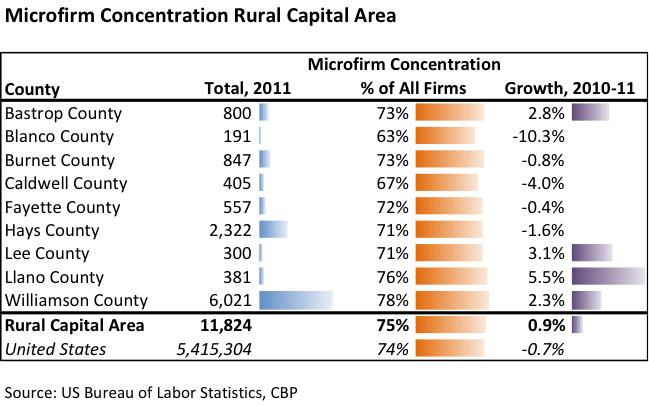
Within the Rural Capital Area, Williamson County has the highest share of microfirms (78% of all firms), followed by Llano County (76%), Bastrop County (73%) and Burnet County (73%). The number of microfirms in the Rural Capital Area grew most quickly in Llano County (5.5% growth), followed by Lee County (3.1%), Bastrop County (2.8%) and Williamson County (2.3%).
Microfirms in the Rural Capital Area are spread across many industries, but a significant share of microfirms are engaged in various professional, financial, and administrative industries; construction and trades; and personal and food services.
The Top 10 Rural Capital Area Industries by Microfirm Employment in 2011
- Professional & Technical Services (1,570 firms; 5% growth)
- Specialty Trade Contractors (900; -4%)
- Ambulatory Health Care Services (810; 0%)
- Real Estate (570; -2%)
- Administrative & Support Services (550; 3%)
- Food Services & Drinking Places (540; 5%)
- Membership Associations & Organizations (490; 1%)
- Construction of Buildings (410; -8%)
- Repair & Maintenance (400; -3%)
- Personal & Laundry Services (380; 5%)
Texas Employers Add 33,100 jobs in April
article posted by Headlight on June 4, 2013
Texas Workforce Commission
AUSTIN — Texas' seasonally adjusted total nonfarm employment expanded by 33,100 jobs in April. Texas added 326,100 jobs from April 2012 to April 2013. The state's annual growth rate in April stood at 3.0 percent, and has been above 2.5 percent since the beginning of 2012. Texas' seasonally adjusted unemployment rate was unchanged in April at 6.4 percent. It remains well below the nation's April unemployment rate of 7.5 percent.
“All major industries in Texas added jobs over the last 12 months and our civilian labor force is at an all-time high with more than 12.7 million workers,†said Texas Workforce Commission (TWC) Chairman Andres Alcantar. “This is an encouraging period of growth for our state and we will work with our partners to keep Texas the top choice for business in the country.â€
Over the month, eight of the 11 major industries in Texas saw positive growth. Trade, Transportation, and Utilities added 16,000 jobs in April. The state's largest industry, it has grown by 58,400 jobs over the year.
“We're continuing to see strong growth in the Construction industry, which is driven in part by our state's growing population and expanding businesses,†said TWC Commissioner Representing Labor Ronny Congleton. “Over the year, Construction has been the state's fastest growing major industry, with a 7.1 percent annual growth rate.â€
Mining and Logging, which includes oil and gas related jobs, has added 16,800 jobs over the year, including 2,500 in April. Professional and Business Services increased employment by 8,000 jobs in April, for a total of 62,000 jobs added over the year. Education and Health Services expanded for the ninth month in a row with 1,900 positions added, while Information employment rose by 1,400 jobs. Financial Activities expanded by 1,300 payroll jobs.
“The private sector continues to drive job growth here in Texas, adding more than 28,000 jobs in April, for a boost of more than 300,000 positions over the year,†said TWC Commissioner Representing Employers Hope Andrade. “I applaud the efforts of private sector employers to expand opportunities for Texas workers and encourage them to utilize TWC as a resource.â€
The Midland Metropolitan Statistical Area (MSA) had the lowest April unemployment rate in the state at 3.0 percent. The Odessa MSA came in second at 3.7 percent and the Amarillo MSA third at 4.4 percent (not seasonally adjusted).
Audio downloads from TWC Chairman Andres Alcantar on the latest labor market data are available at: www.texasworkforce.org/news/press/2013/press-releases-2013.html#pressReleaseAudio.
The Texas Workforce Commission is a state agency dedicated to helping Texas employers, workers and communities prosper economically. For details on TWC and the services it offers in coordination with its network of local workforce development boards, call 512-463-8942 or visit www.texasworkforce.org.
This article is from Workforce Solutions Rural Capital Area Recent News.







































































































































































































































































































































































































































 Williamson County is the most populous suburban county in the Austin metropolitan area, with a population of 471,000 people and 139,000 jobs. The county has grown much faster than the metro and U.S.: the population grew 56% from 2003-2013 and job base grew 69%.
Williamson County is the most populous suburban county in the Austin metropolitan area, with a population of 471,000 people and 139,000 jobs. The county has grown much faster than the metro and U.S.: the population grew 56% from 2003-2013 and job base grew 69%. The largest industries in Williamson County are:
The largest industries in Williamson County are:




 Newly published data by the US Census Bureau provides new insight on the size of the limited English proficiency (LEP) population living in the Rural Capita Area.
Newly published data by the US Census Bureau provides new insight on the size of the limited English proficiency (LEP) population living in the Rural Capita Area. Lee County is a small county in central Texas, with a population of 16,600 people and 6,500 jobs. The county's population grew just 3% from 2003-2013 and job base grew 28%.
Lee County is a small county in central Texas, with a population of 16,600 people and 6,500 jobs. The county's population grew just 3% from 2003-2013 and job base grew 28%. n the U.S. rate.
n the U.S. rate.


 The Rural Capital Area has an overall population of 878,000 people and 253,000 jobs. The area has grown faster than the U.S.: the population grew 40% from 2003-2013 and job base grew 51%.
The Rural Capital Area has an overall population of 878,000 people and 253,000 jobs. The area has grown faster than the U.S.: the population grew 40% from 2003-2013 and job base grew 51%.
 Employment in the Rural Capital Area totaled nearly 260,000 in the first quarter of 2014. On a year-over-year basis, job growth in the Rural Capital Area reached 4.5%, more than twice the rate of overall employment growth in the US. The Rural Capital's rate of job creation has exceeded the US average every year since 2011.
Employment in the Rural Capital Area totaled nearly 260,000 in the first quarter of 2014. On a year-over-year basis, job growth in the Rural Capital Area reached 4.5%, more than twice the rate of overall employment growth in the US. The Rural Capital's rate of job creation has exceeded the US average every year since 2011. Hays County is a populous suburban county in the Austin metropolitan area, with a population of 176,000 people and 55,000 jobs. The county has grown faster than the metro and the U.S.: the population grew 51% from 2003-2013 with the job base growing 49%.
Hays County is a populous suburban county in the Austin metropolitan area, with a population of 176,000 people and 55,000 jobs. The county has grown faster than the metro and the U.S.: the population grew 51% from 2003-2013 with the job base growing 49%.











 Burnet County is a mid-sized suburban county in central Texas, with a population of 43,800 people and 12,600 jobs. The county's population grew 14% from 2003-2013 and job base grew 16%.
Burnet County is a mid-sized suburban county in central Texas, with a population of 43,800 people and 12,600 jobs. The county's population grew 14% from 2003-2013 and job base grew 16%. Salaries in the Rural Capital Area are below U.S. levels in all industries except Trade, Transportation, & Utilities, Manufacturing, and Other Services.
Salaries in the Rural Capital Area are below U.S. levels in all industries except Trade, Transportation, & Utilities, Manufacturing, and Other Services.
 The Rural Capital Area (RCA) is a nine county region with a population of 878,000 in central Texas surrounding Austin, the state capital.
The Rural Capital Area (RCA) is a nine county region with a population of 878,000 in central Texas surrounding Austin, the state capital. U.S.: in the last decade, 72% of new population was due to domestic migration. Migration has declined in recent years but still outpaces births: in 2013 17,500 people moved to the Rural Capital Area and 10,700 births occurred.
U.S.: in the last decade, 72% of new population was due to domestic migration. Migration has declined in recent years but still outpaces births: in 2013 17,500 people moved to the Rural Capital Area and 10,700 births occurred. The Rural Capital Area has an overall population of 878,000 people and 253,000 jobs. The area has grown faster than the U.S.: the population grew 40% from 2003-2013 and job base grew 51%.
The Rural Capital Area has an overall population of 878,000 people and 253,000 jobs. The area has grown faster than the U.S.: the population grew 40% from 2003-2013 and job base grew 51%.


 Fayette County is a small, rural county in Central Texas with a population of 25,000 people and 8,600 jobs. The county's population grew 11% from 2002 to 2012 and job base grew just 4%.
Fayette County is a small, rural county in Central Texas with a population of 25,000 people and 8,600 jobs. The county's population grew 11% from 2002 to 2012 and job base grew just 4%. Caldwell County is a small county in Central Texas with a population of 38,000 people and 7,800 jobs. The county's population grew 12% from 2002- 2012 and job base grew 22%.
Caldwell County is a small county in Central Texas with a population of 38,000 people and 7,800 jobs. The county's population grew 12% from 2002- 2012 and job base grew 22%.
 The Rural Capital Area employs 243,000 people in a diverse range of industries. The largest industries in the RCA are:
The Rural Capital Area employs 243,000 people in a diverse range of industries. The largest industries in the RCA are: All industry sectors grew in the Rural Capital Area between 2002 and 2012.The fastest growing sectors during this period were Professional and Business Services (+91% growth), Leisure and Hospitality (+77%), and Other Services (+76%). These regional sectors all grew faster than the national rates, which were 12%, 15% and 7% growth respectively.
All industry sectors grew in the Rural Capital Area between 2002 and 2012.The fastest growing sectors during this period were Professional and Business Services (+91% growth), Leisure and Hospitality (+77%), and Other Services (+76%). These regional sectors all grew faster than the national rates, which were 12%, 15% and 7% growth respectively.







 Williamson County is the most populous suburban county in the Austin metropolitan area, with a population of 456,000 people and 134,000 jobs. The county has grown much faster than the metro and U.S.: the population grew 57% from 2002-2012 and job base grew 69%.
Williamson County is the most populous suburban county in the Austin metropolitan area, with a population of 456,000 people and 134,000 jobs. The county has grown much faster than the metro and U.S.: the population grew 57% from 2002-2012 and job base grew 69%.
 Blanco County is a small, rural county in central Texas, with a population of 11,000 people and 3,000 jobs. The county has grown slower than the U.S.: the population grew 22% from 2002-2012 and job base grew 15%.
Blanco County is a small, rural county in central Texas, with a population of 11,000 people and 3,000 jobs. The county has grown slower than the U.S.: the population grew 22% from 2002-2012 and job base grew 15%. The RCA has grown more rapidly than the U.S. for the past decade, growing 46%. The regional population growth rate reached its lowest level in 2012 at 2.3%, still over three times the U.S. rate of growth.
The RCA has grown more rapidly than the U.S. for the past decade, growing 46%. The regional population growth rate reached its lowest level in 2012 at 2.3%, still over three times the U.S. rate of growth.

 The county's population growth has historically been driven by migration of people into the county: from 2002 to 2012, 62% of new population was due to domestic migration. However, migration into the county has declined and even turned negative in 2012, likely due to the out-migration of families after the Bastrop fires in late 2011.
The county's population growth has historically been driven by migration of people into the county: from 2002 to 2012, 62% of new population was due to domestic migration. However, migration into the county has declined and even turned negative in 2012, likely due to the out-migration of families after the Bastrop fires in late 2011. Bastrop County's median household income has remained just above the national average for many years, but fell to 97% of U.S. median household income in 2012.
Bastrop County's median household income has remained just above the national average for many years, but fell to 97% of U.S. median household income in 2012.
















